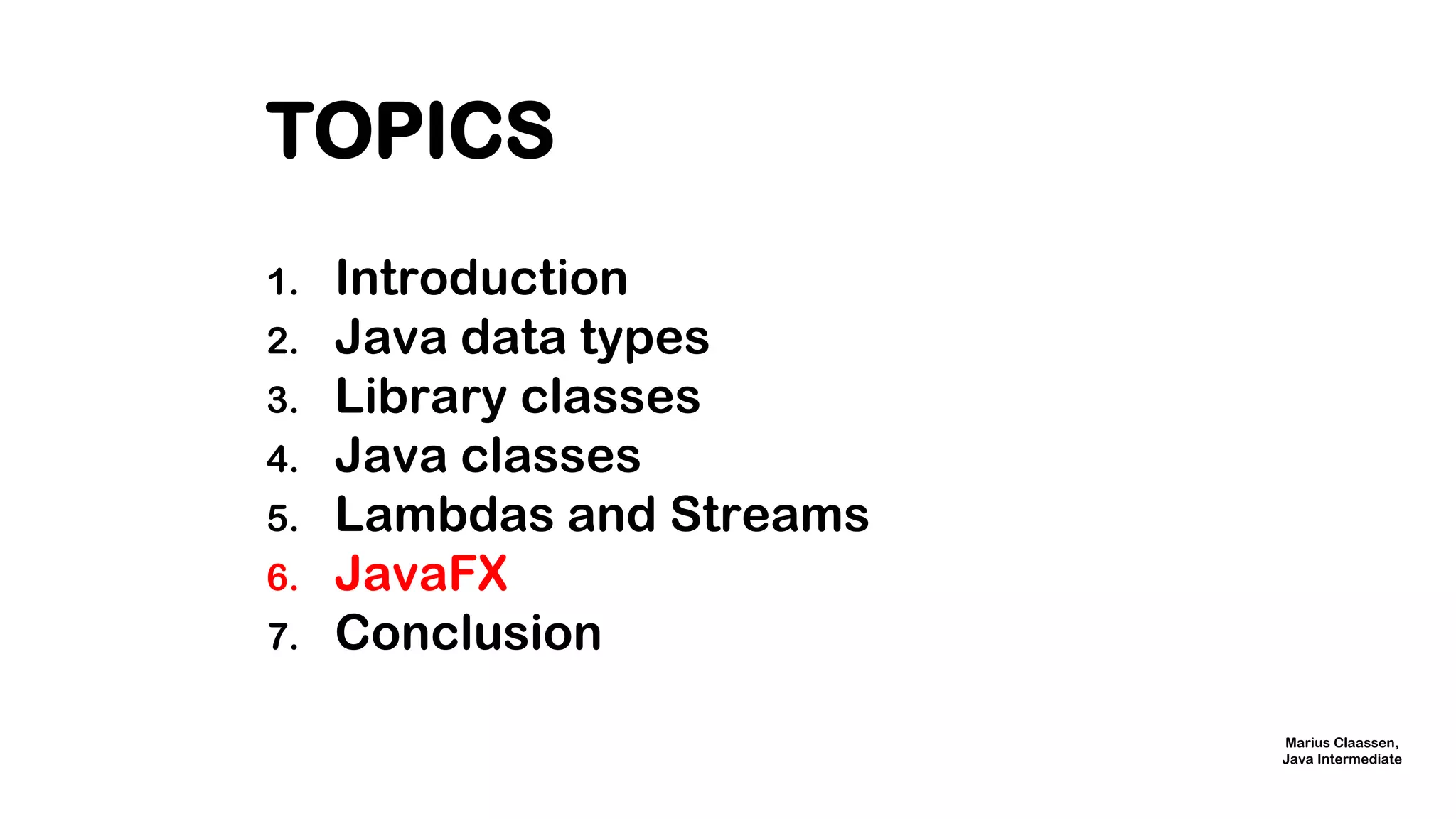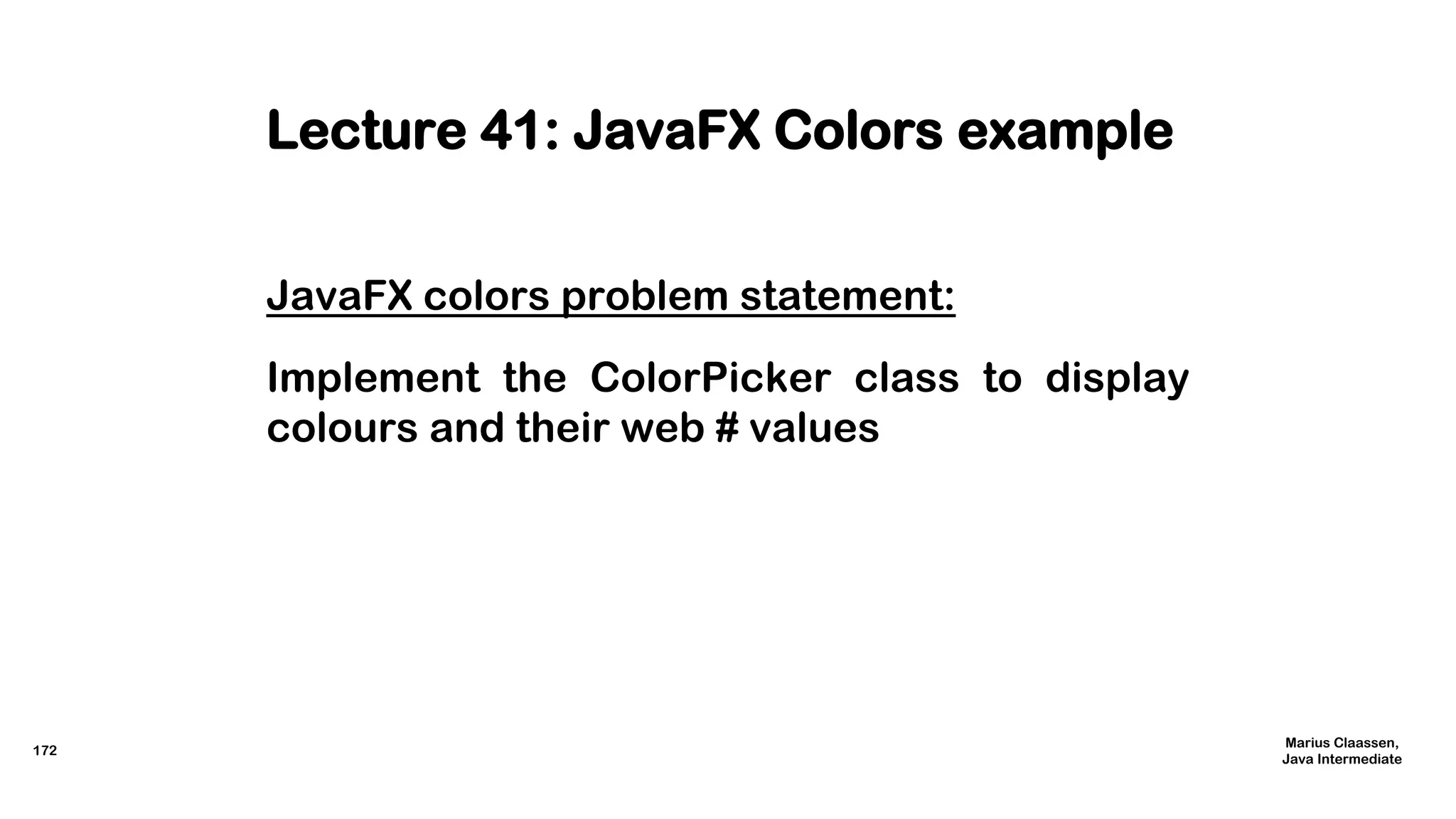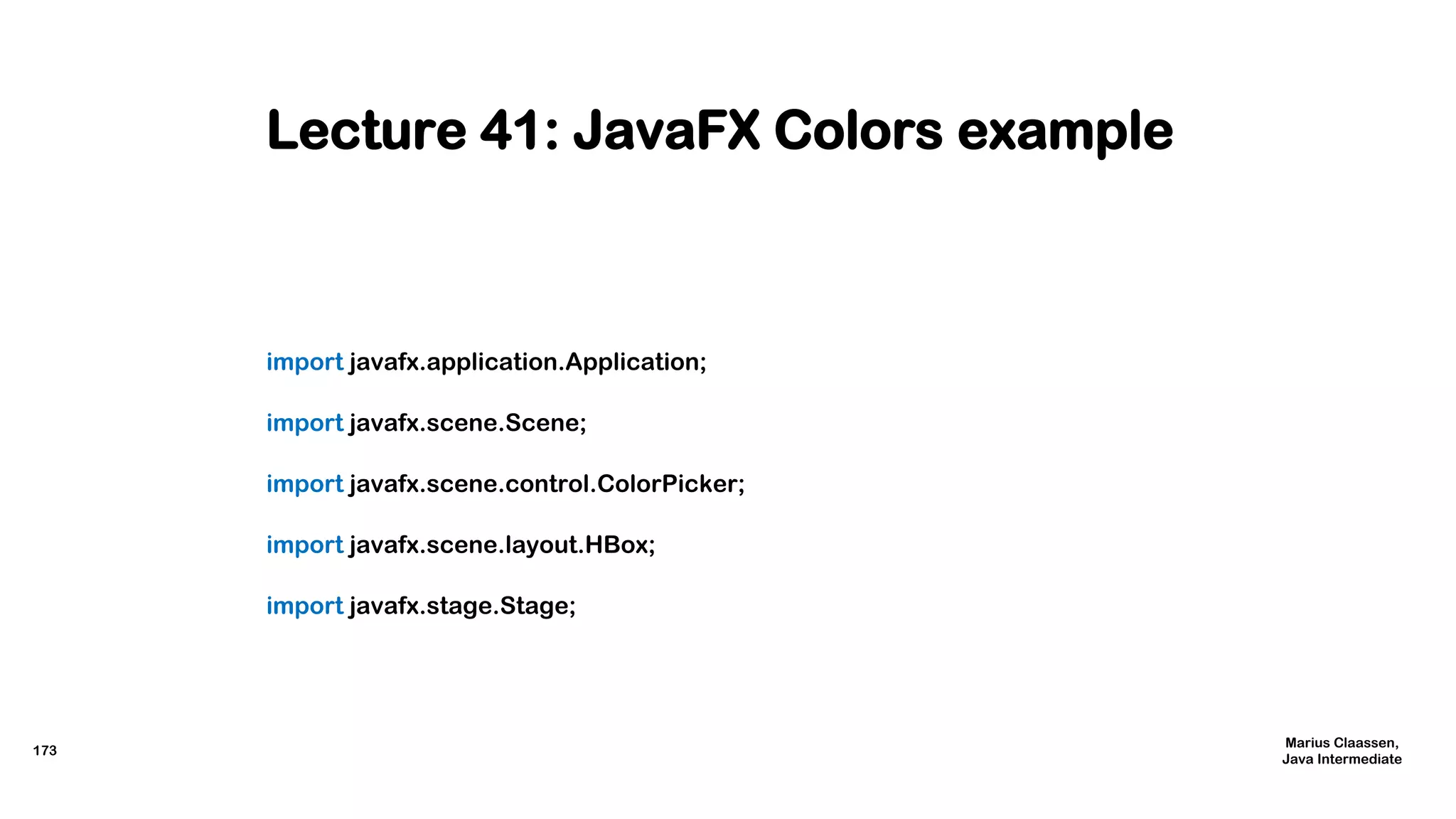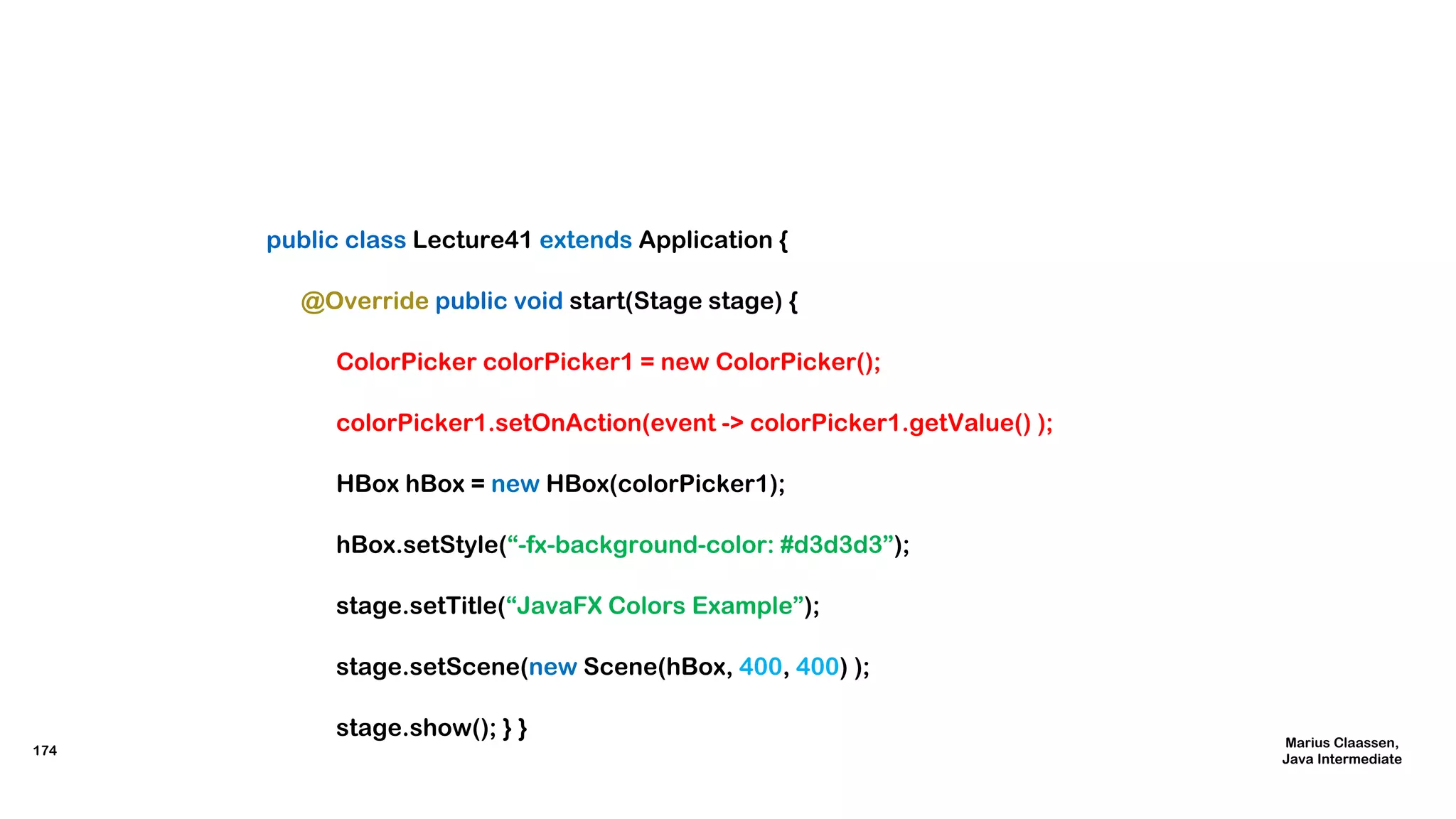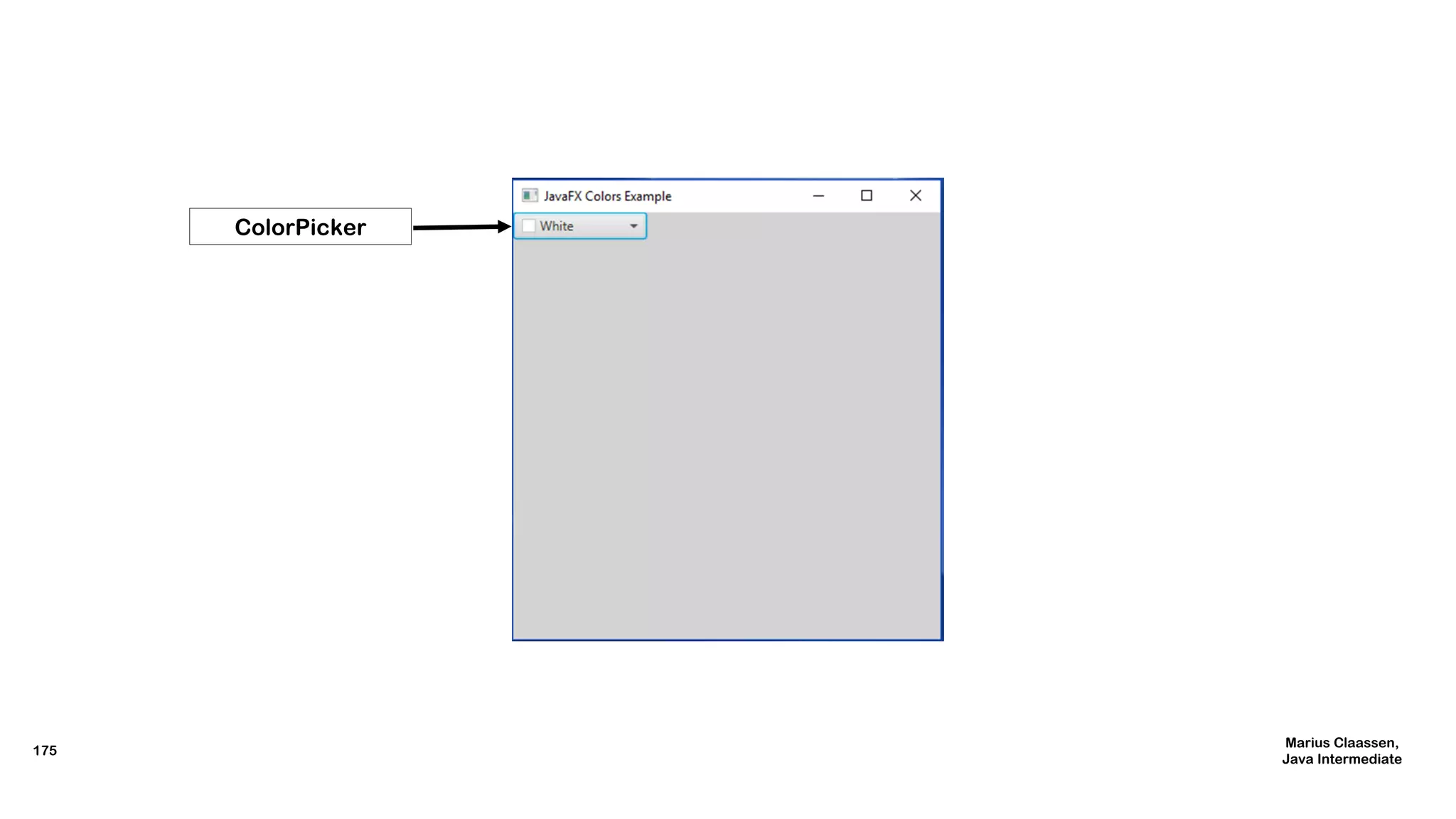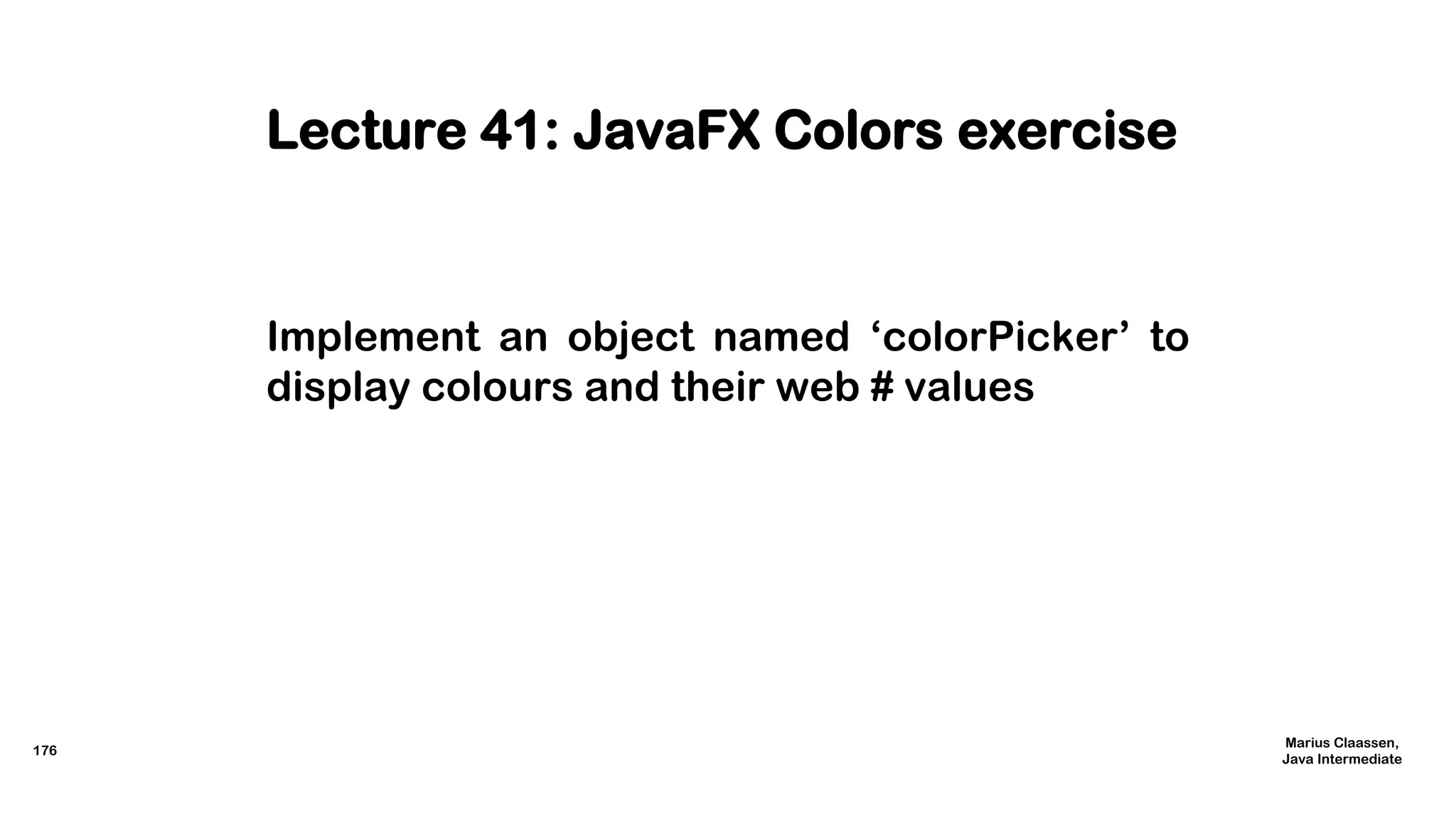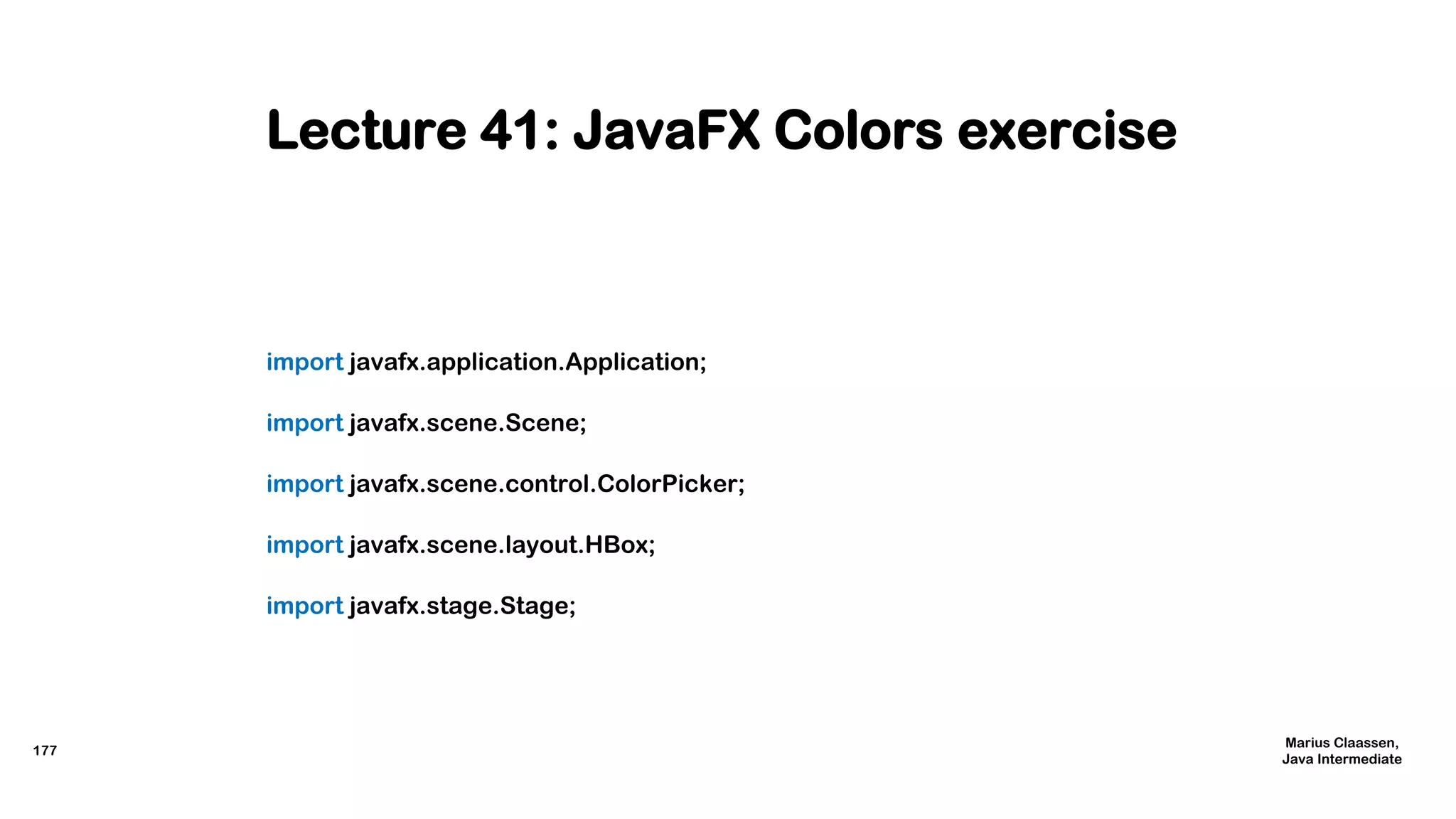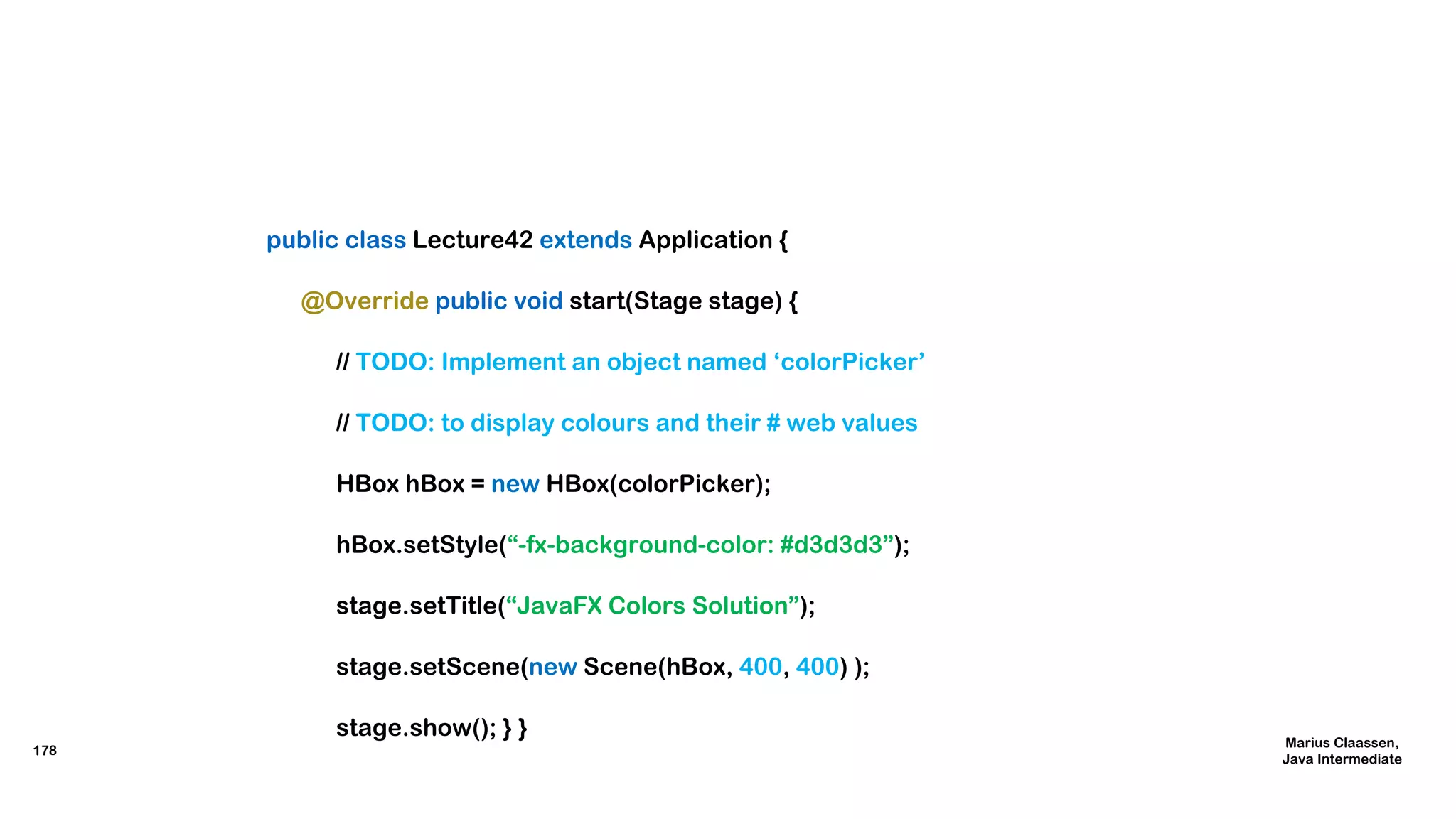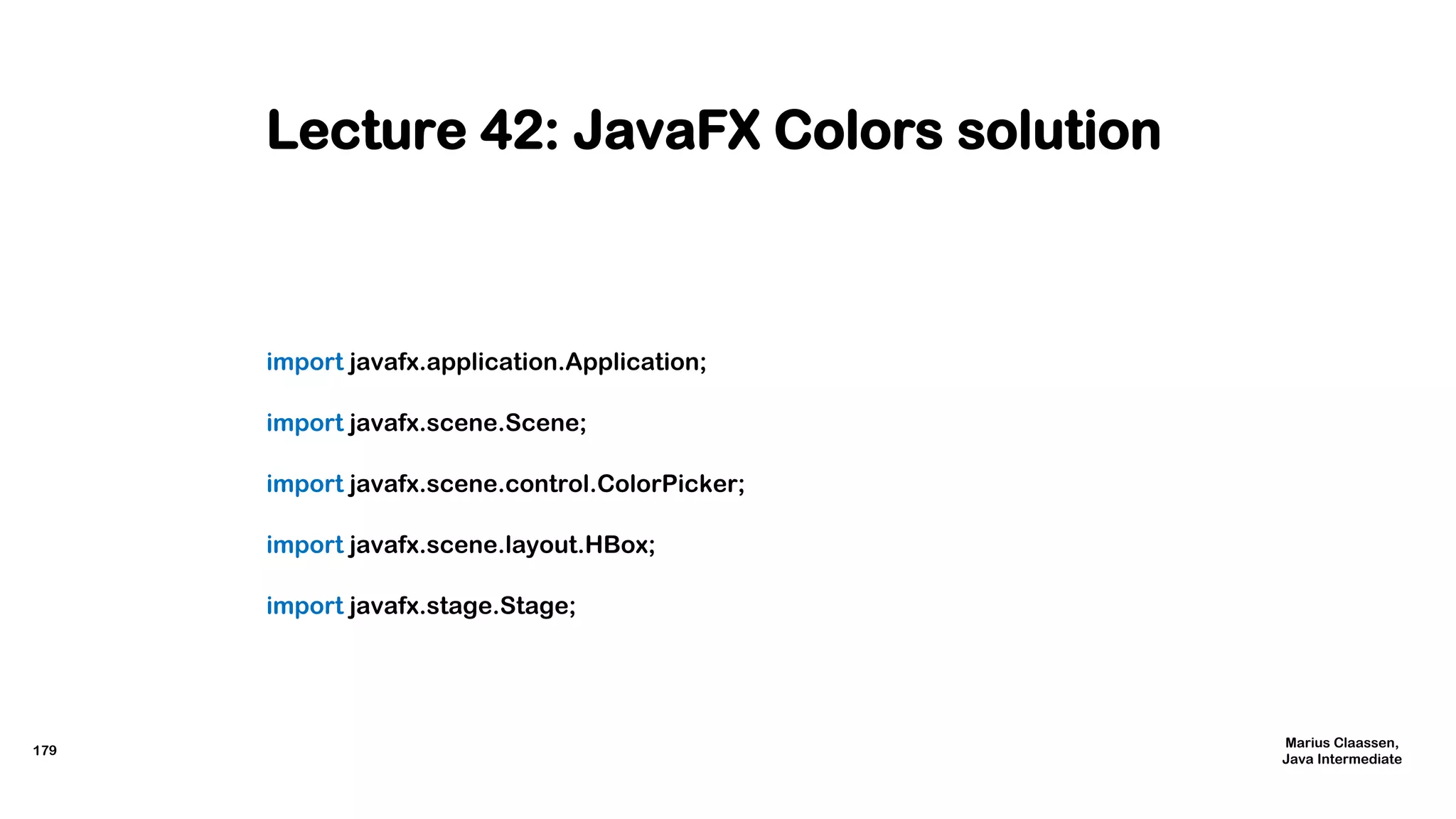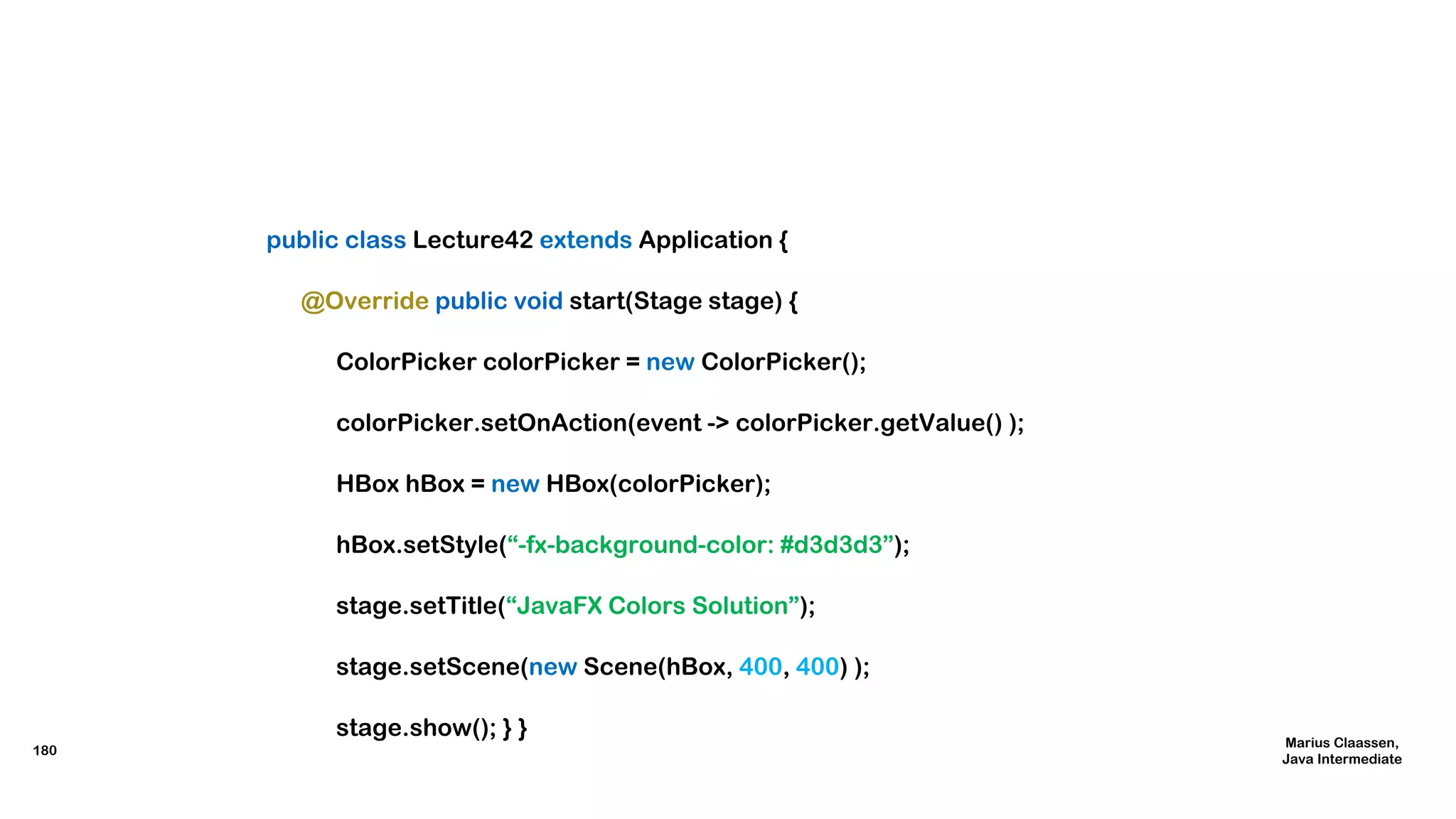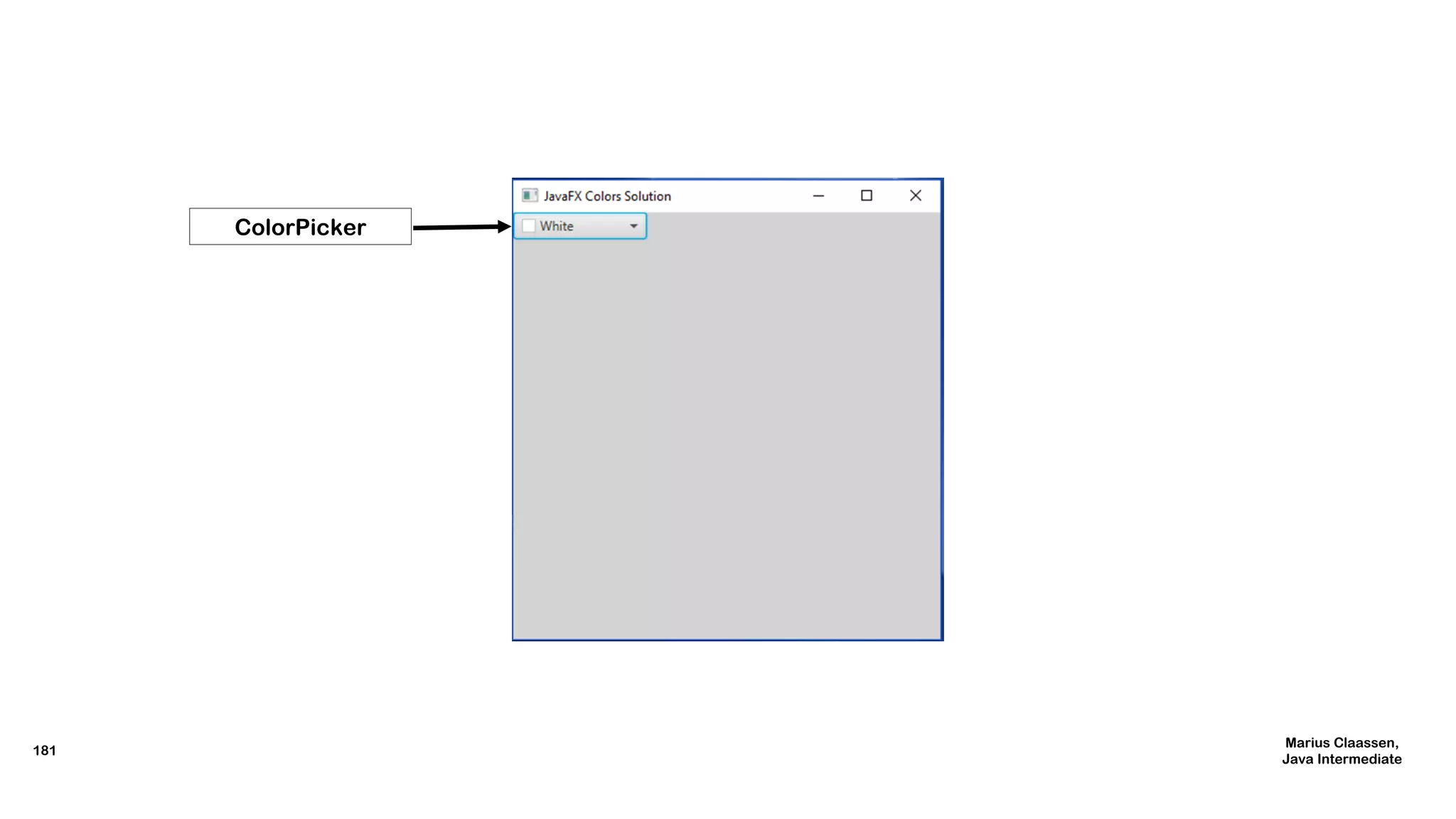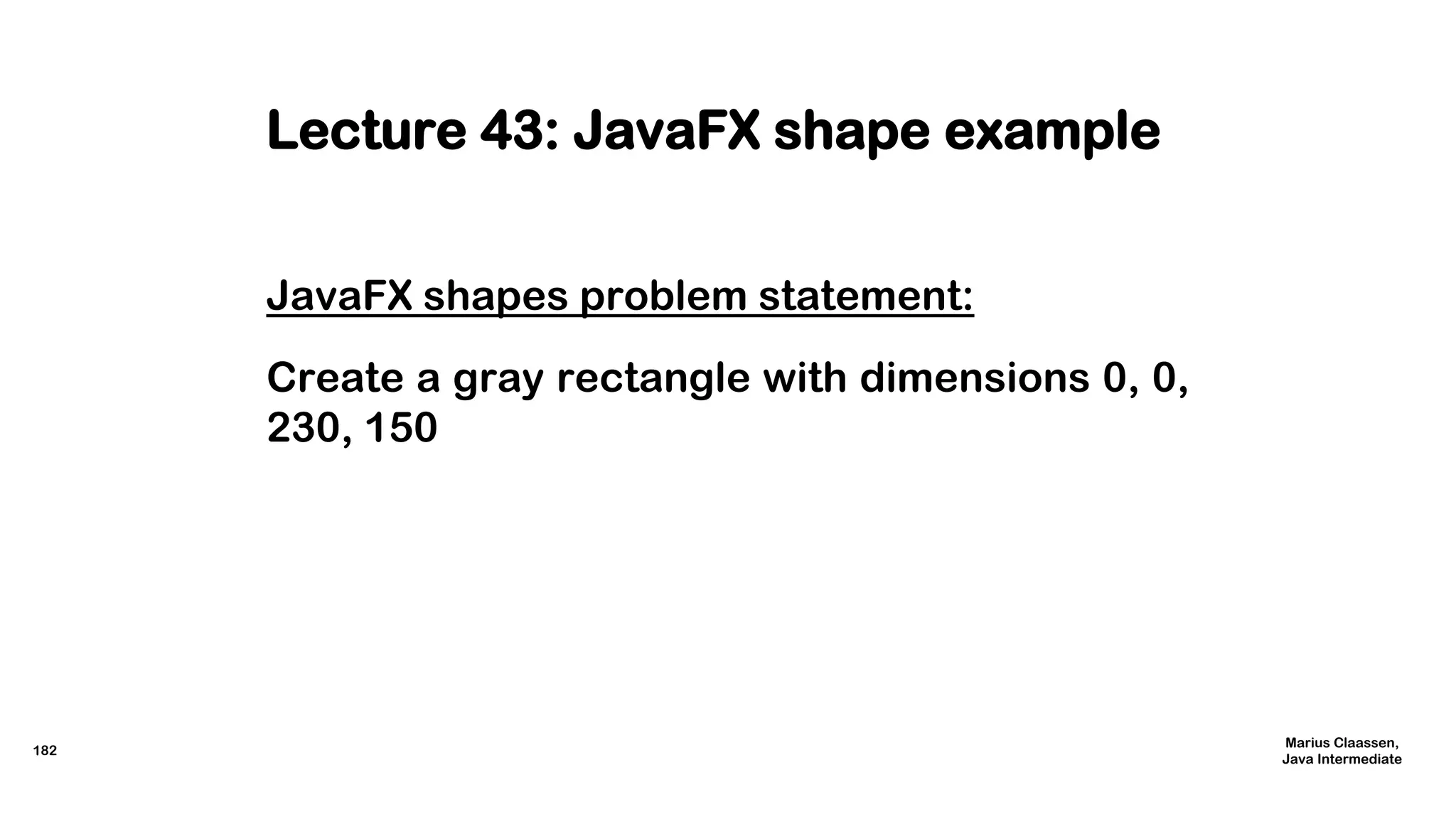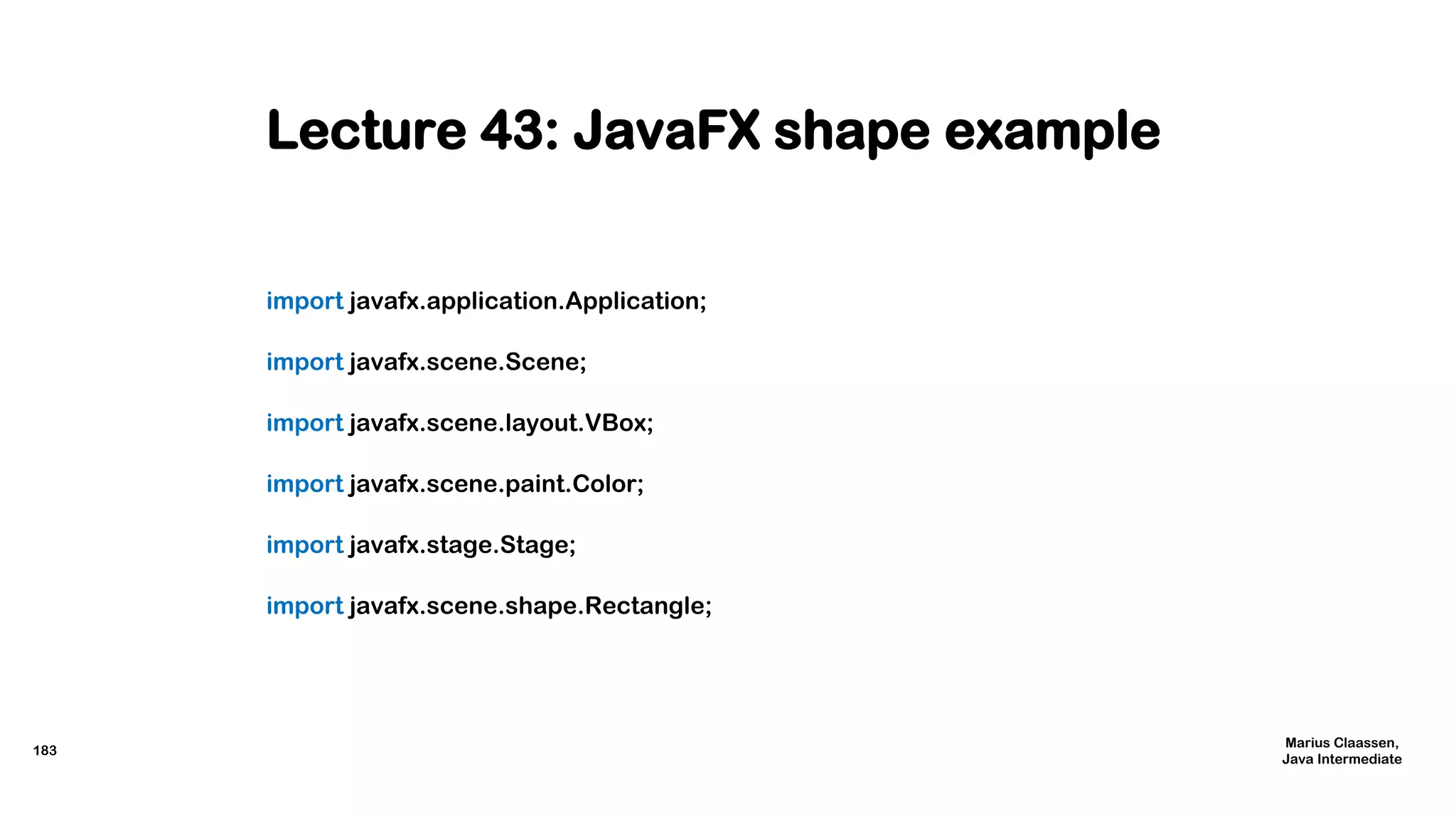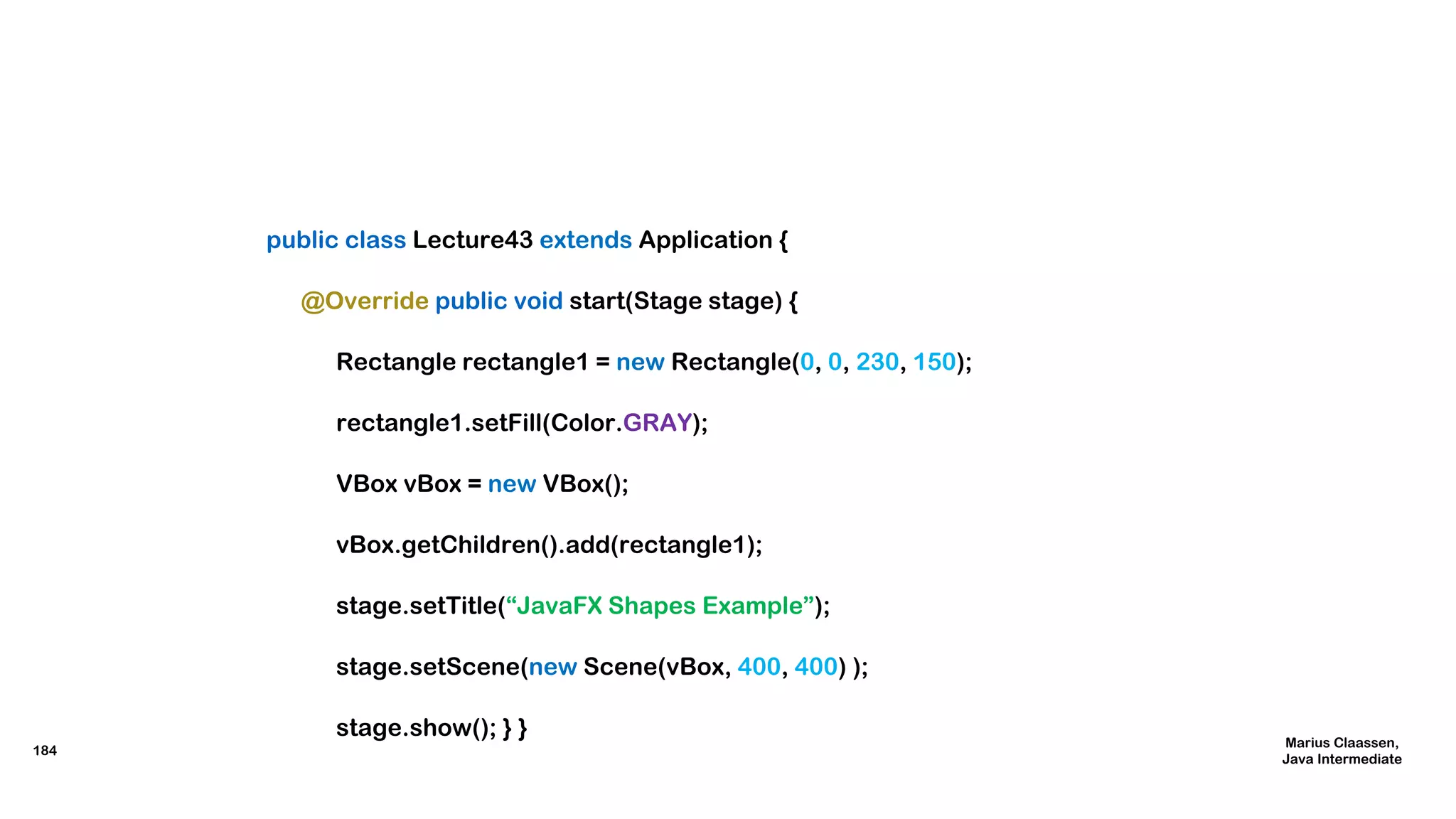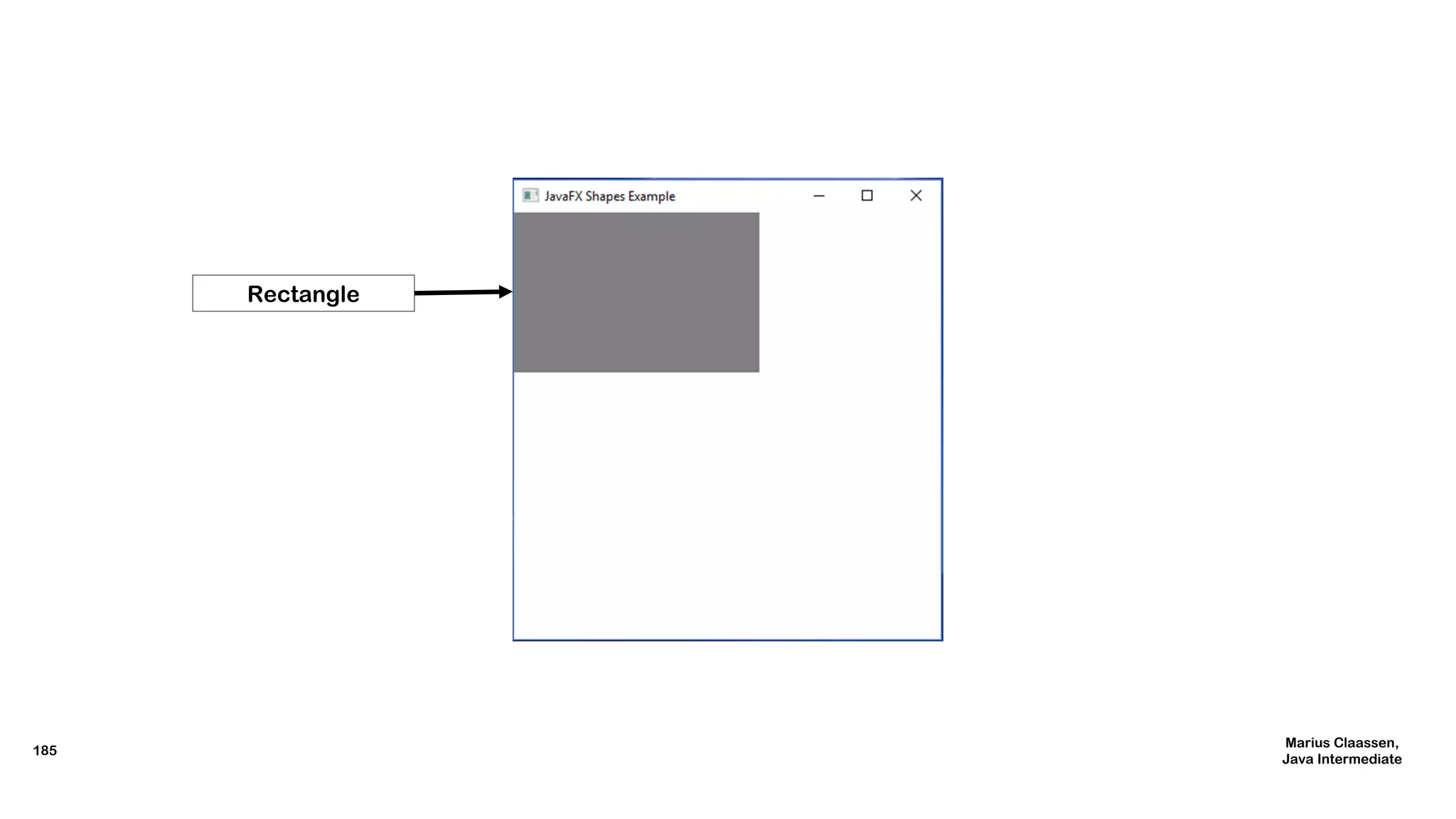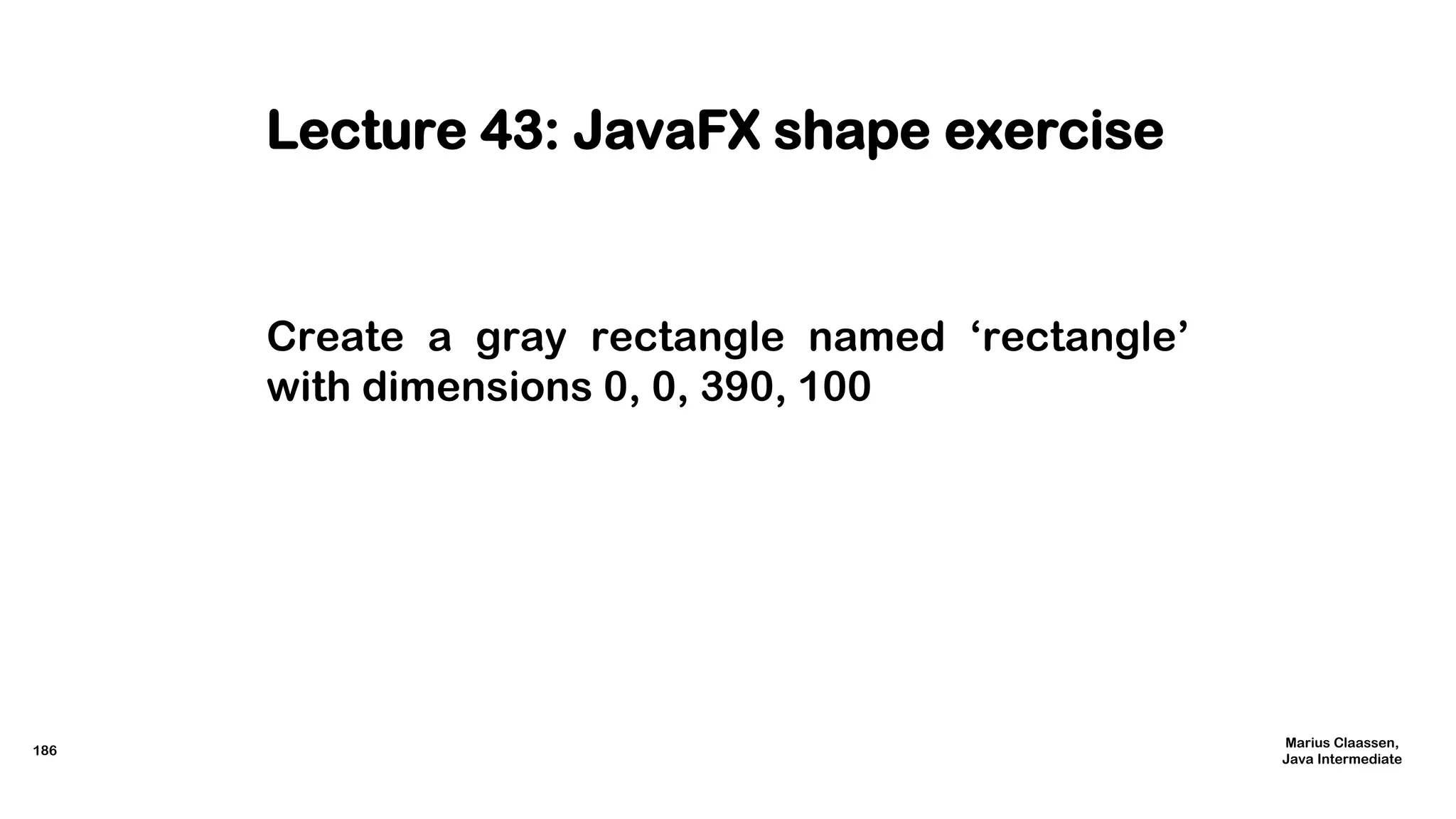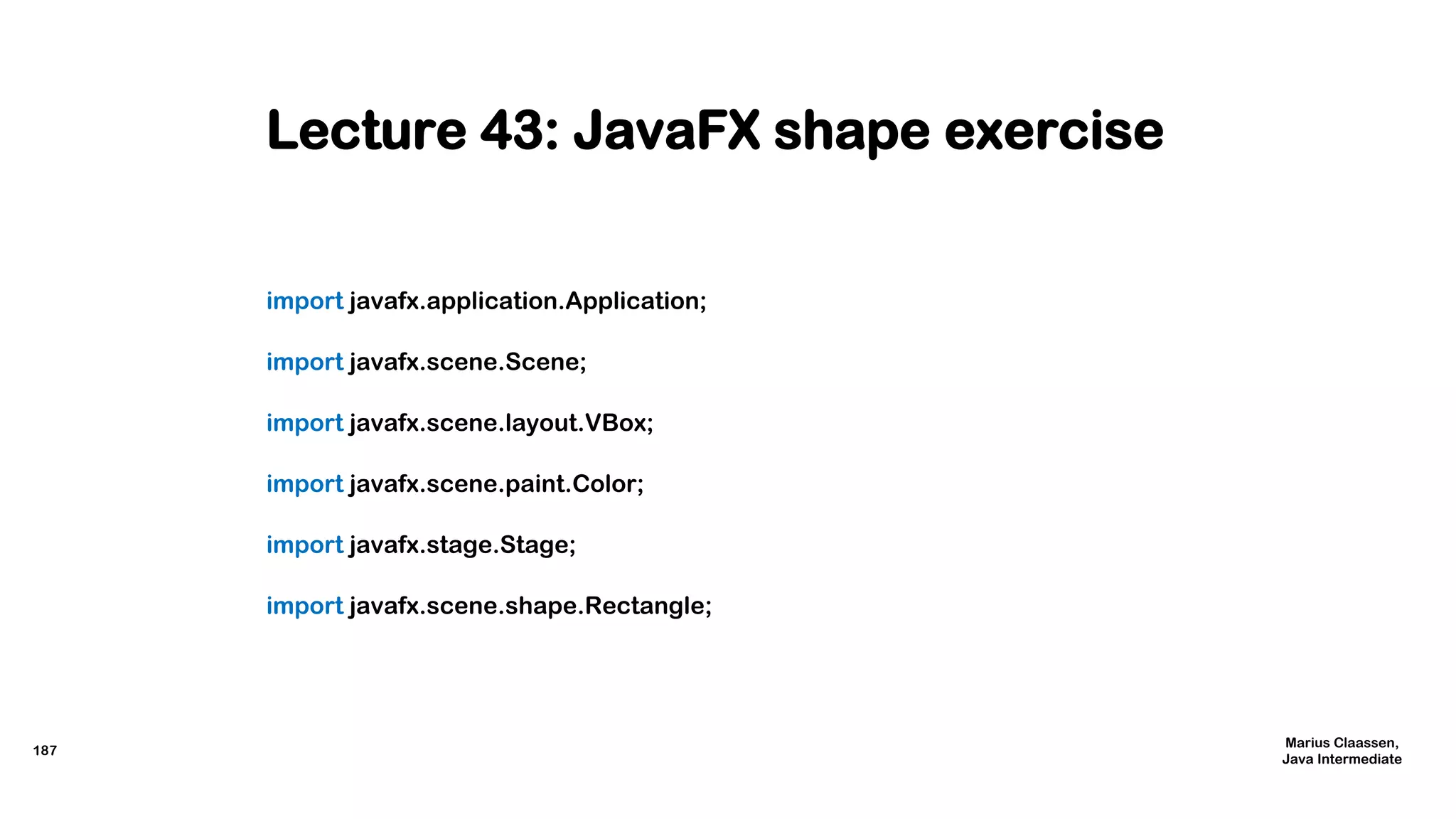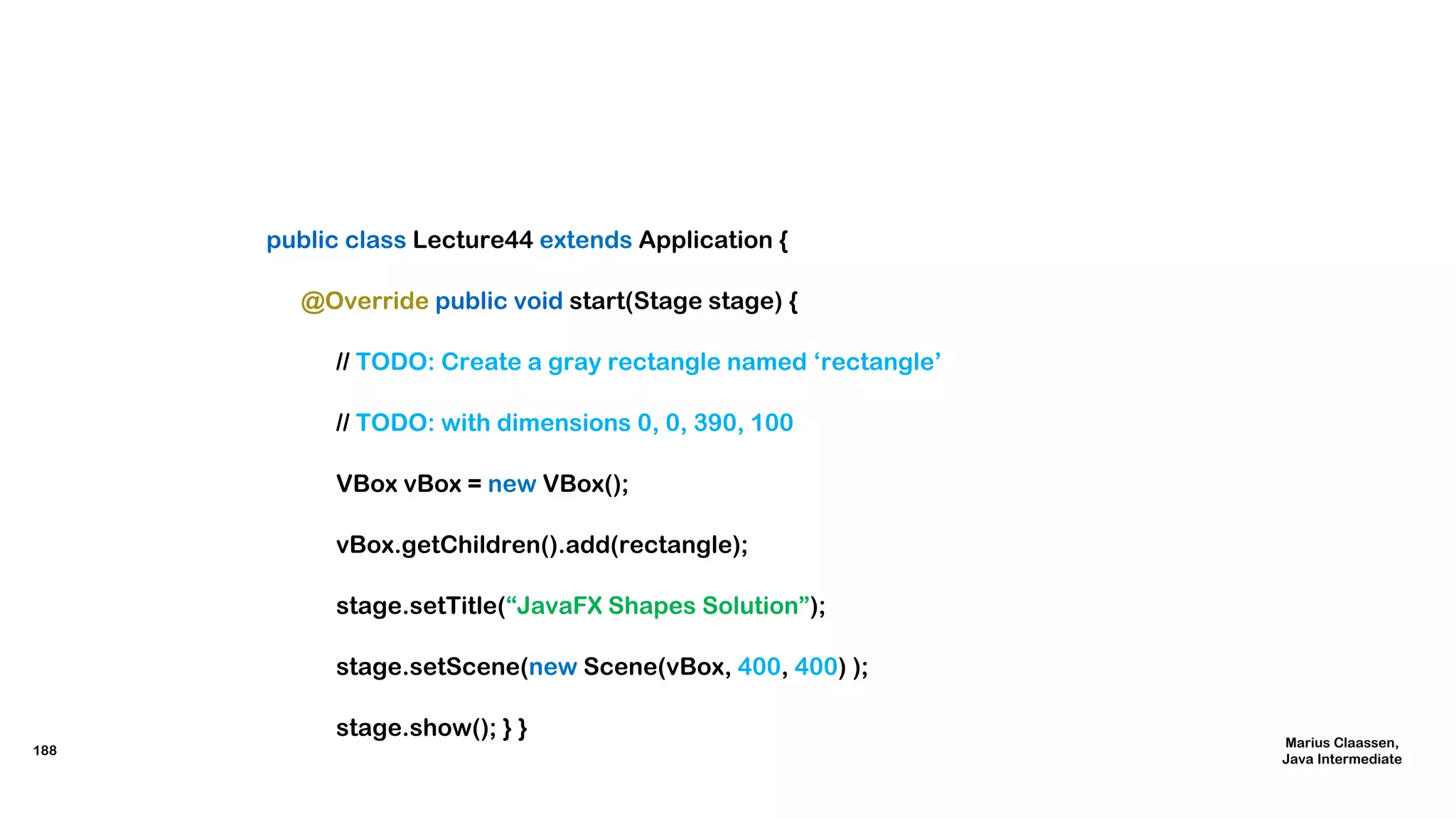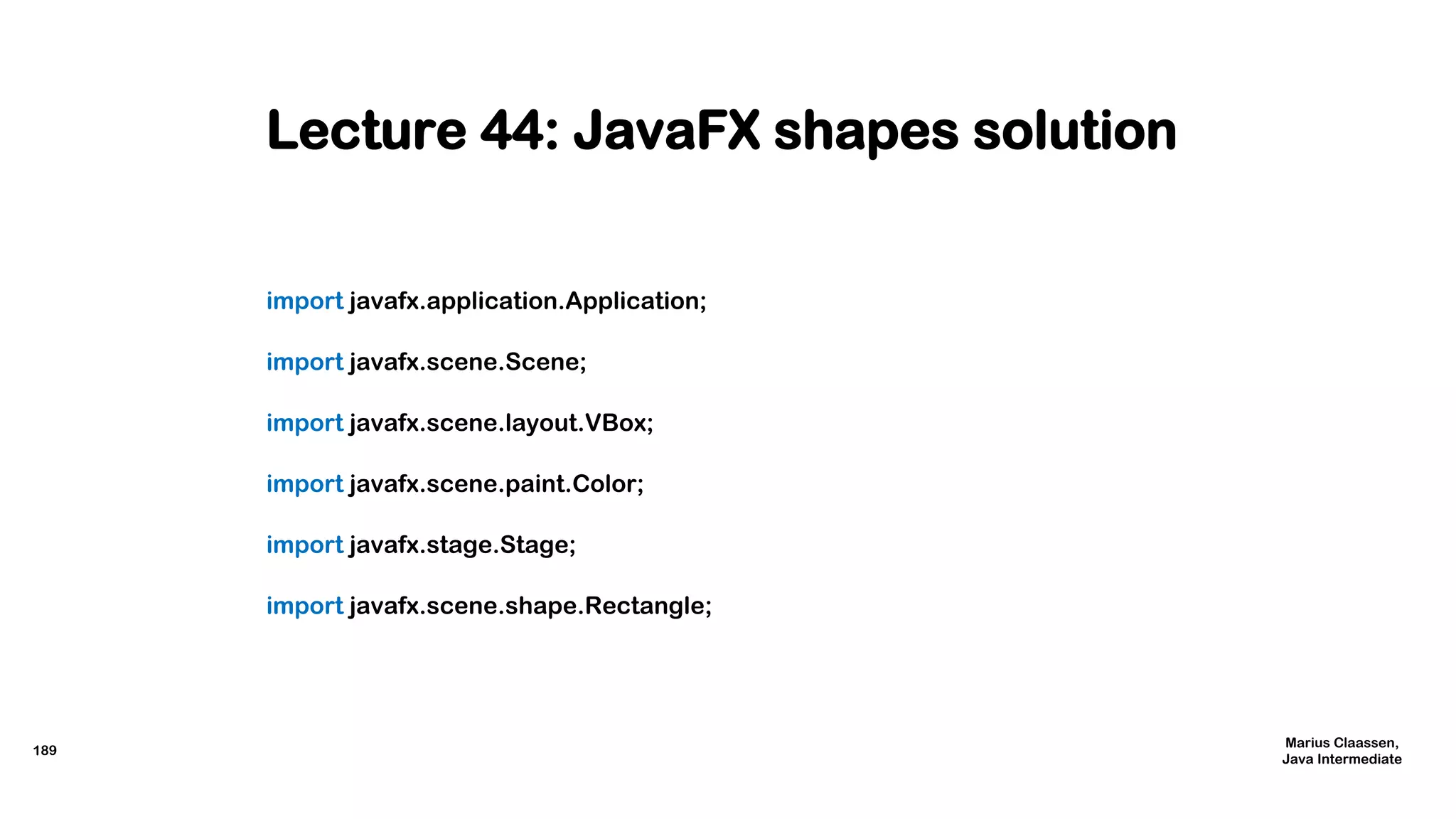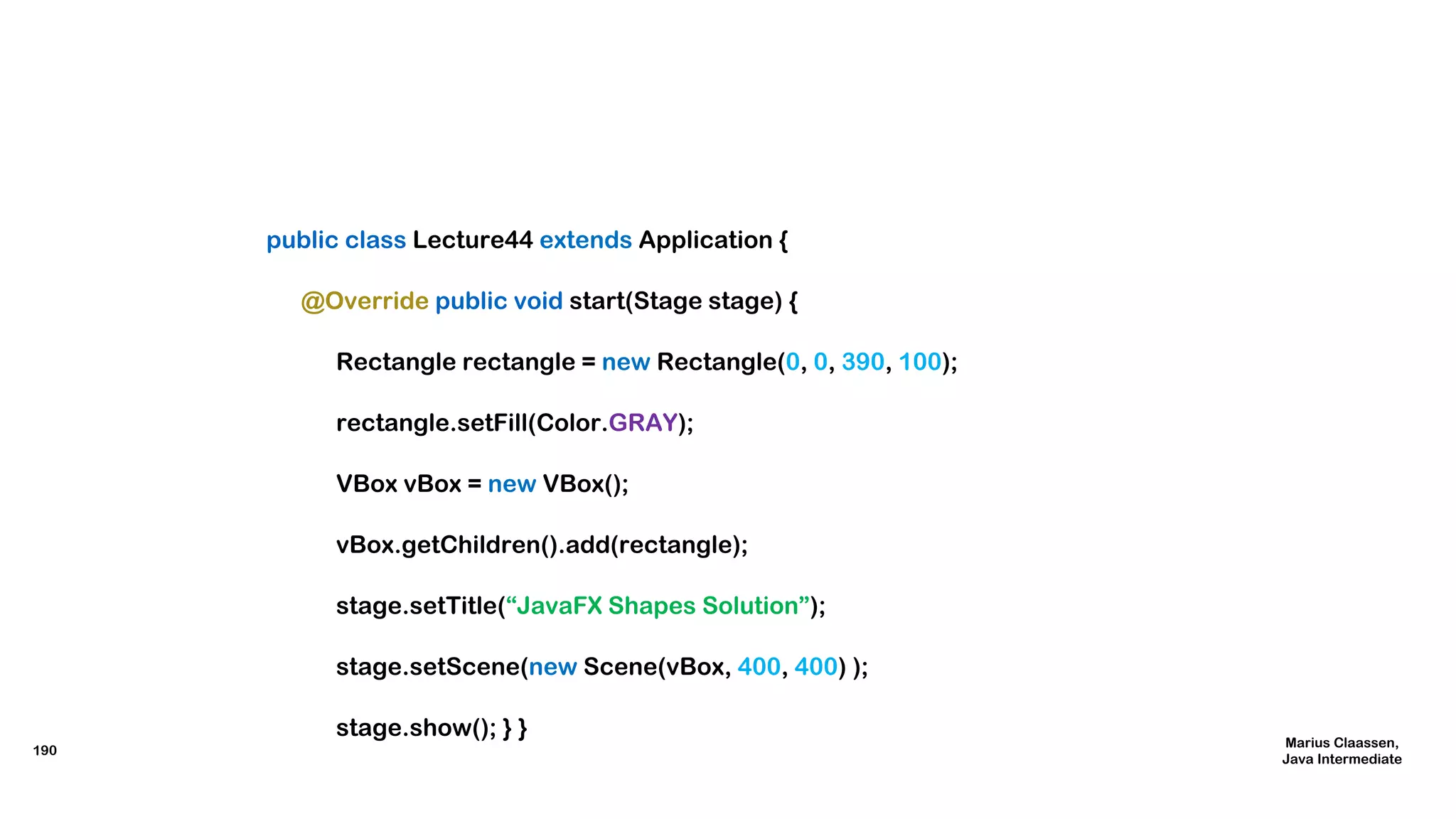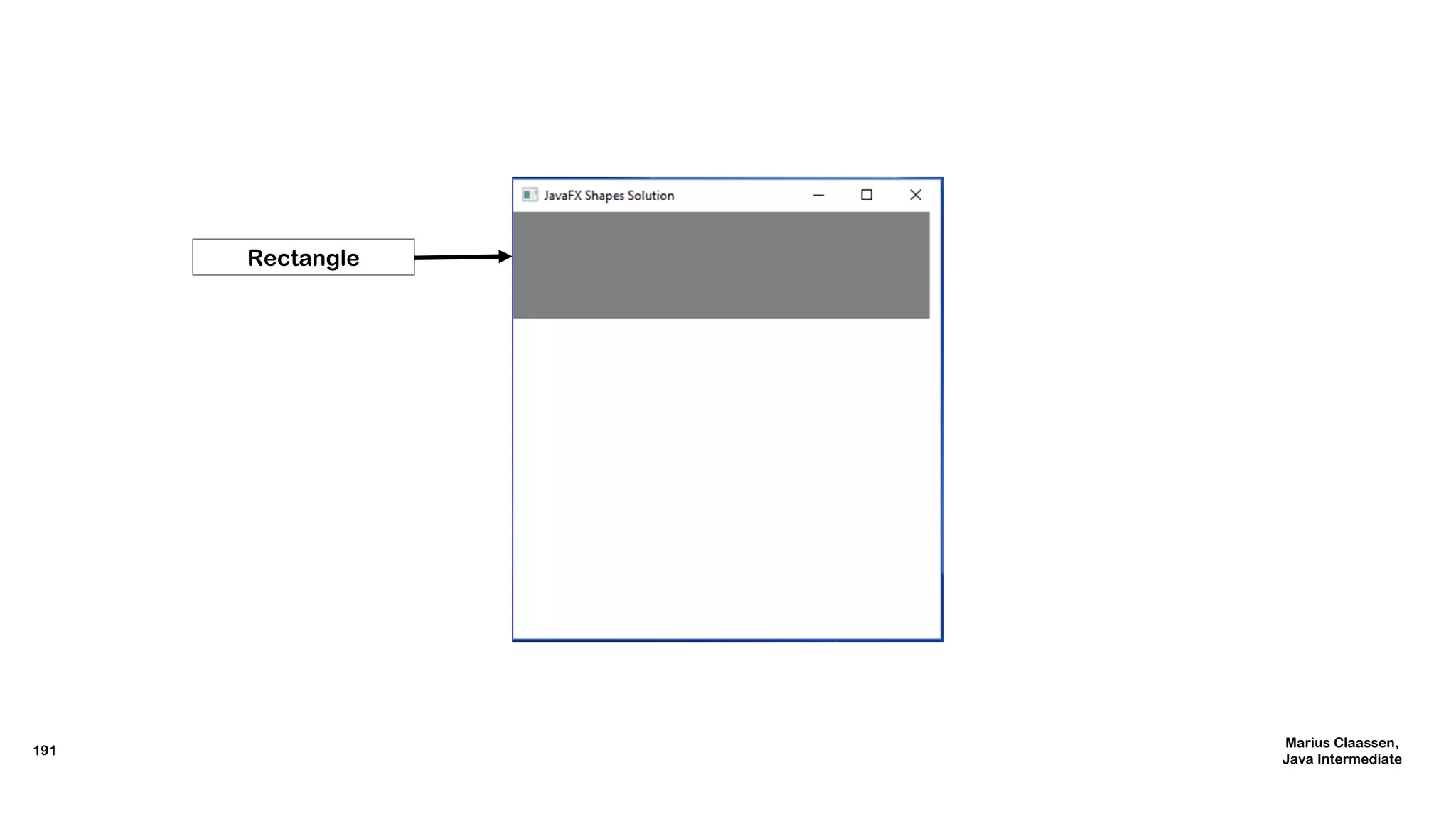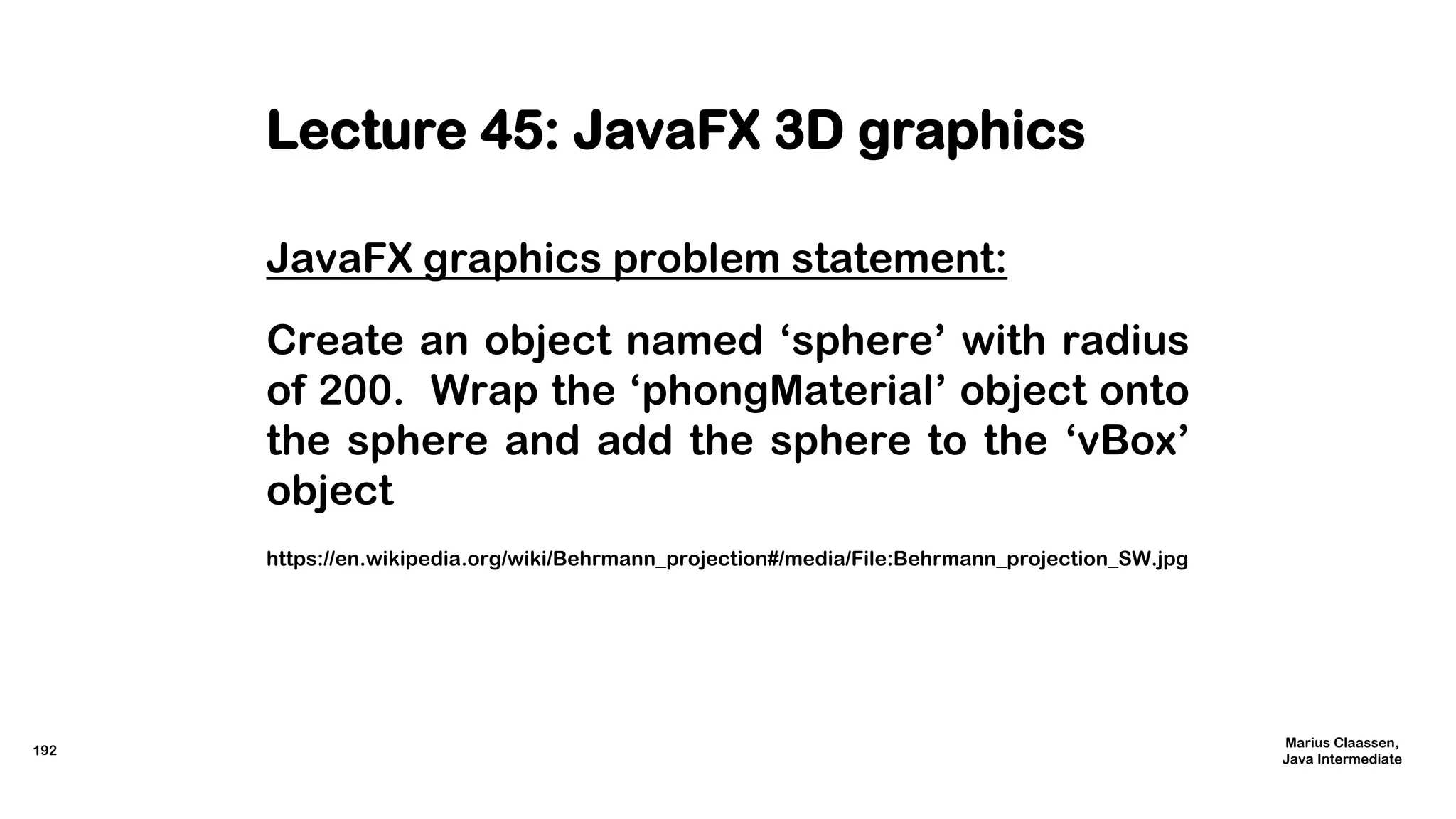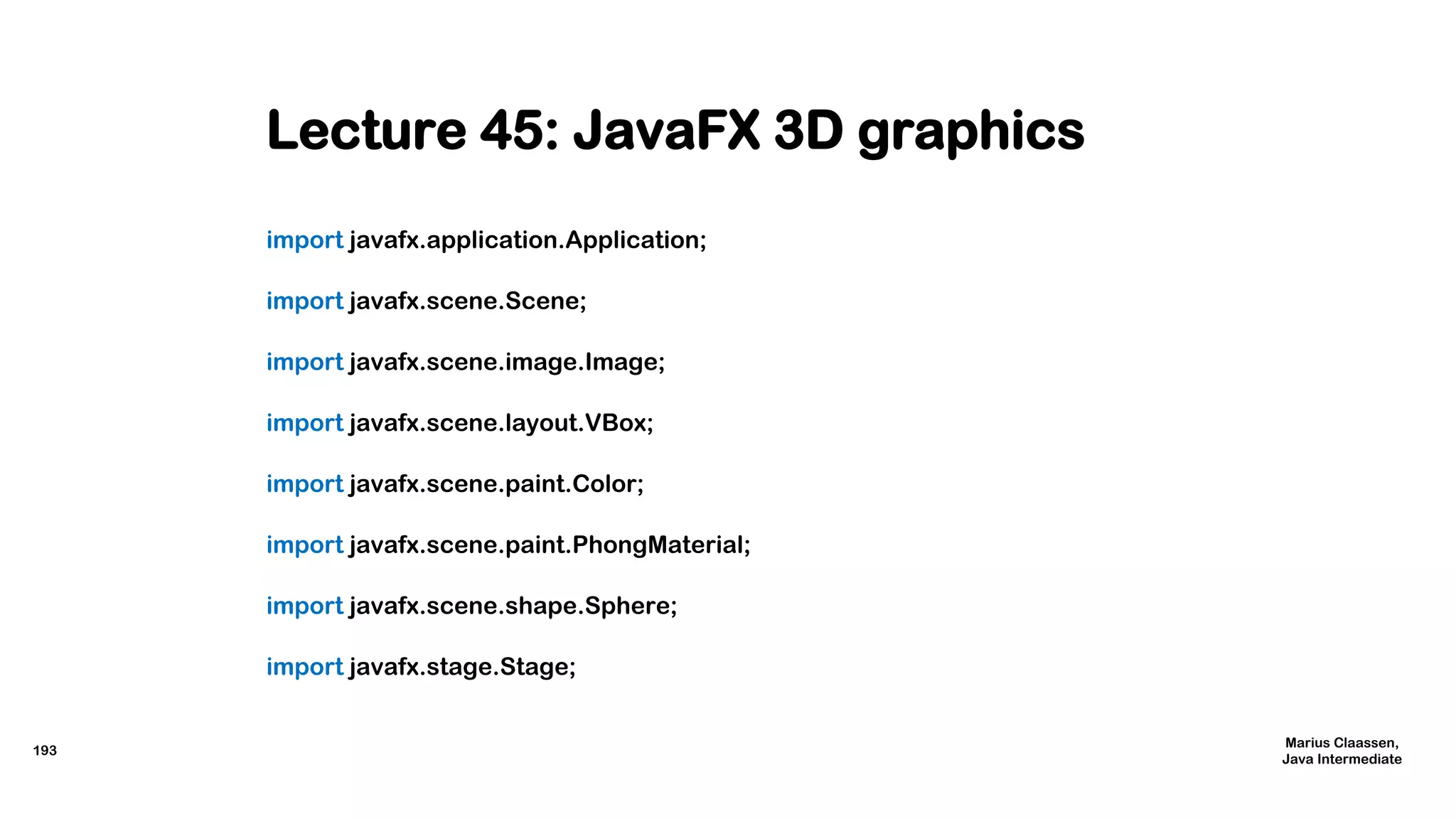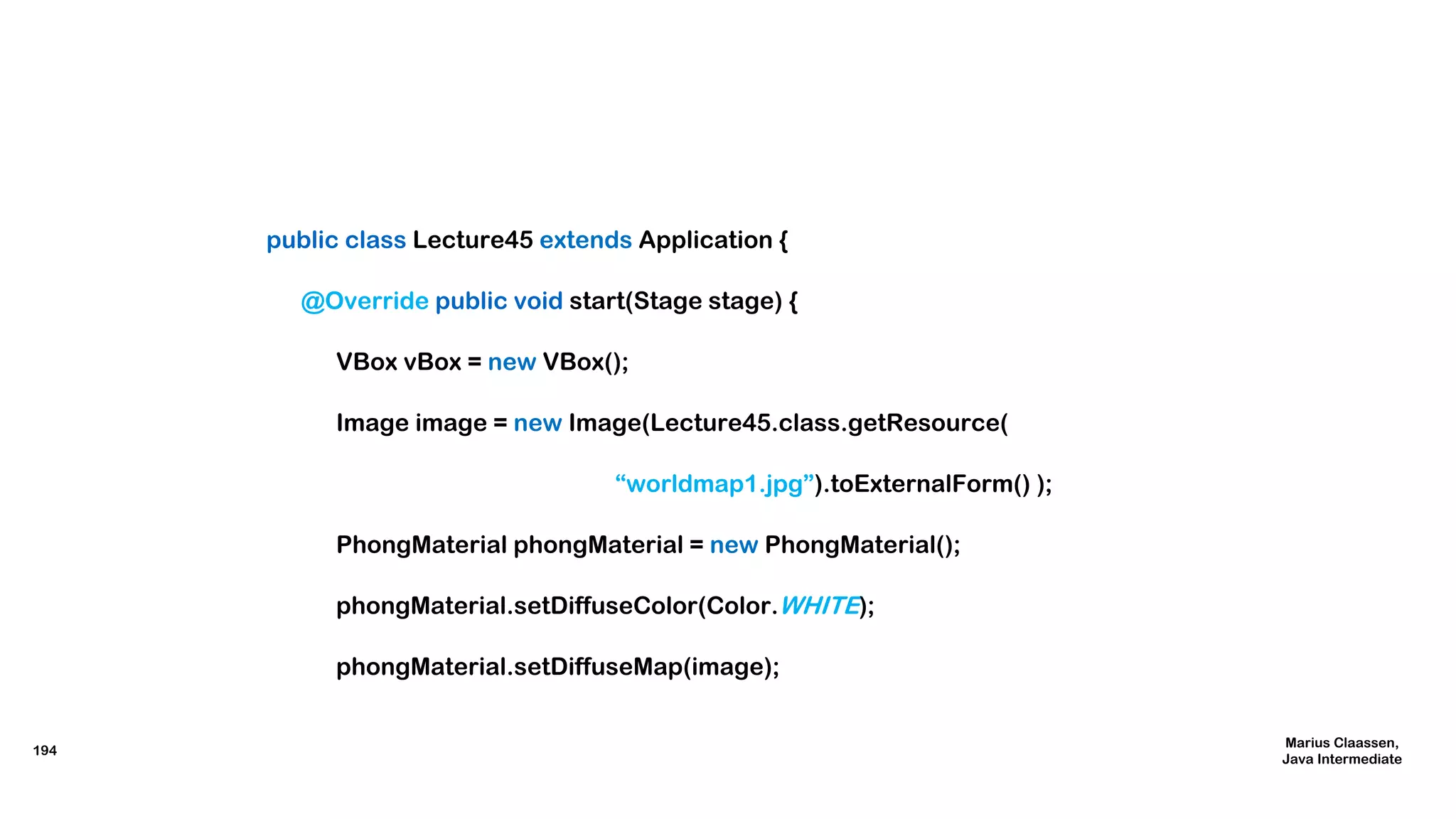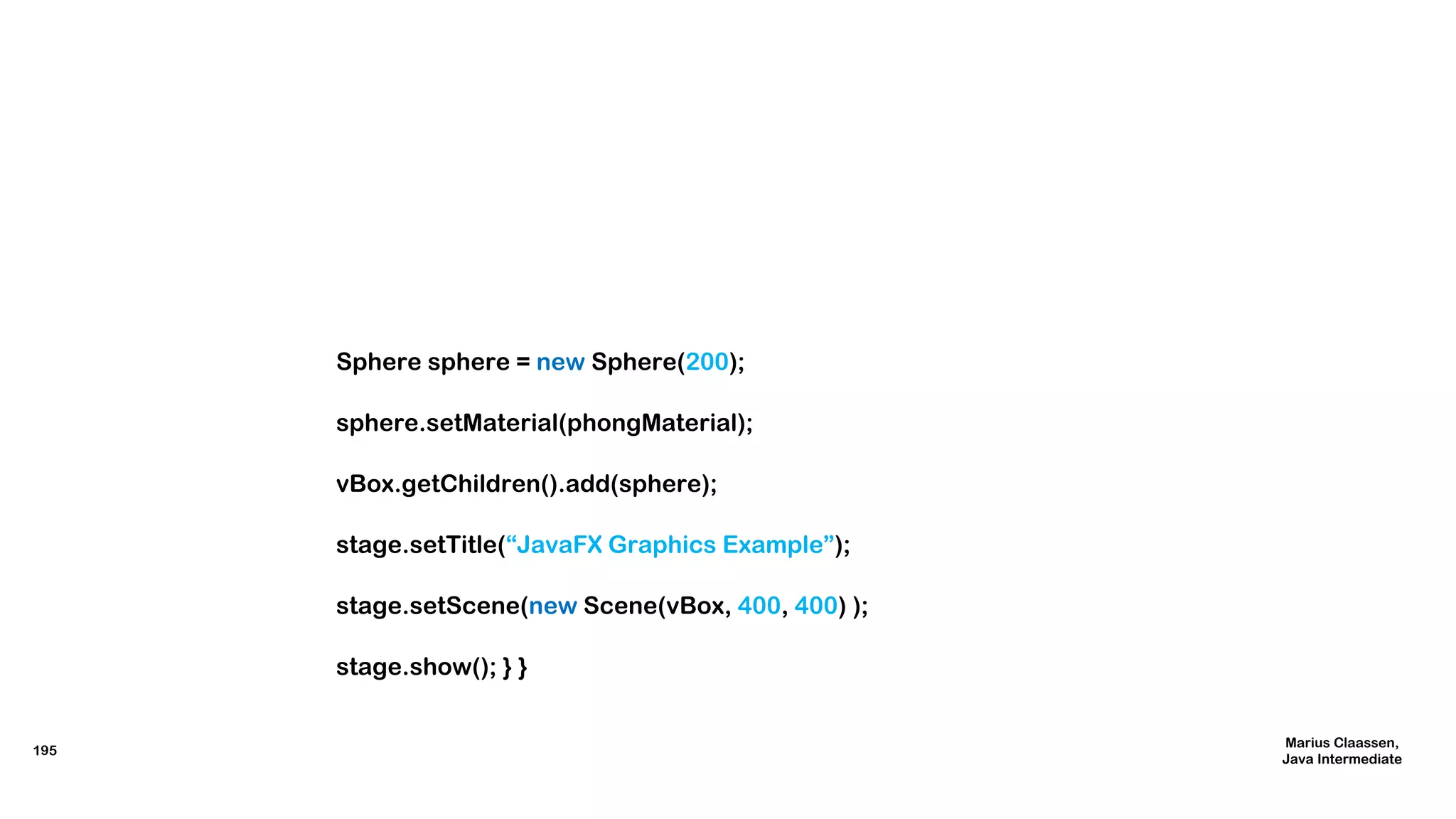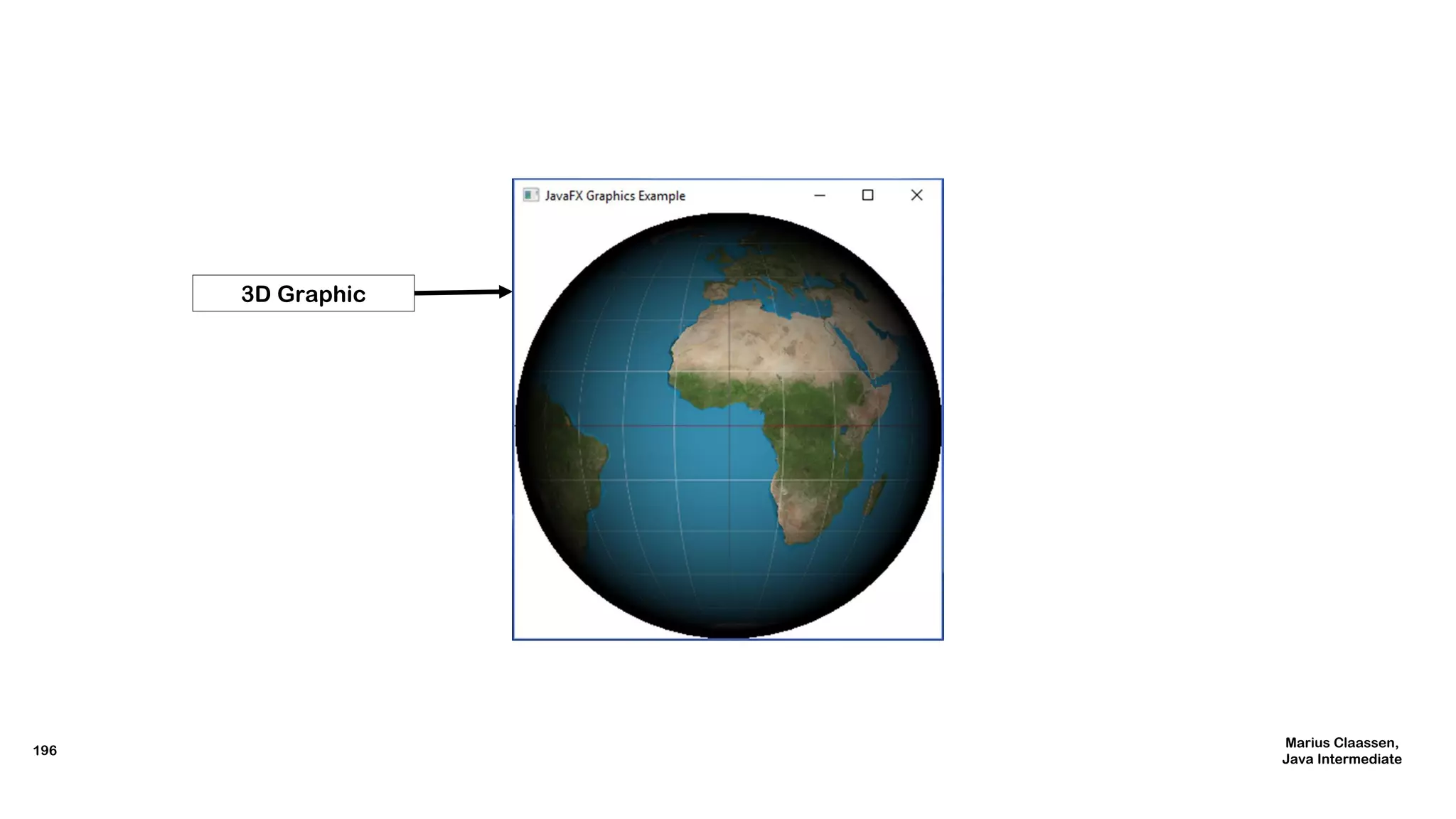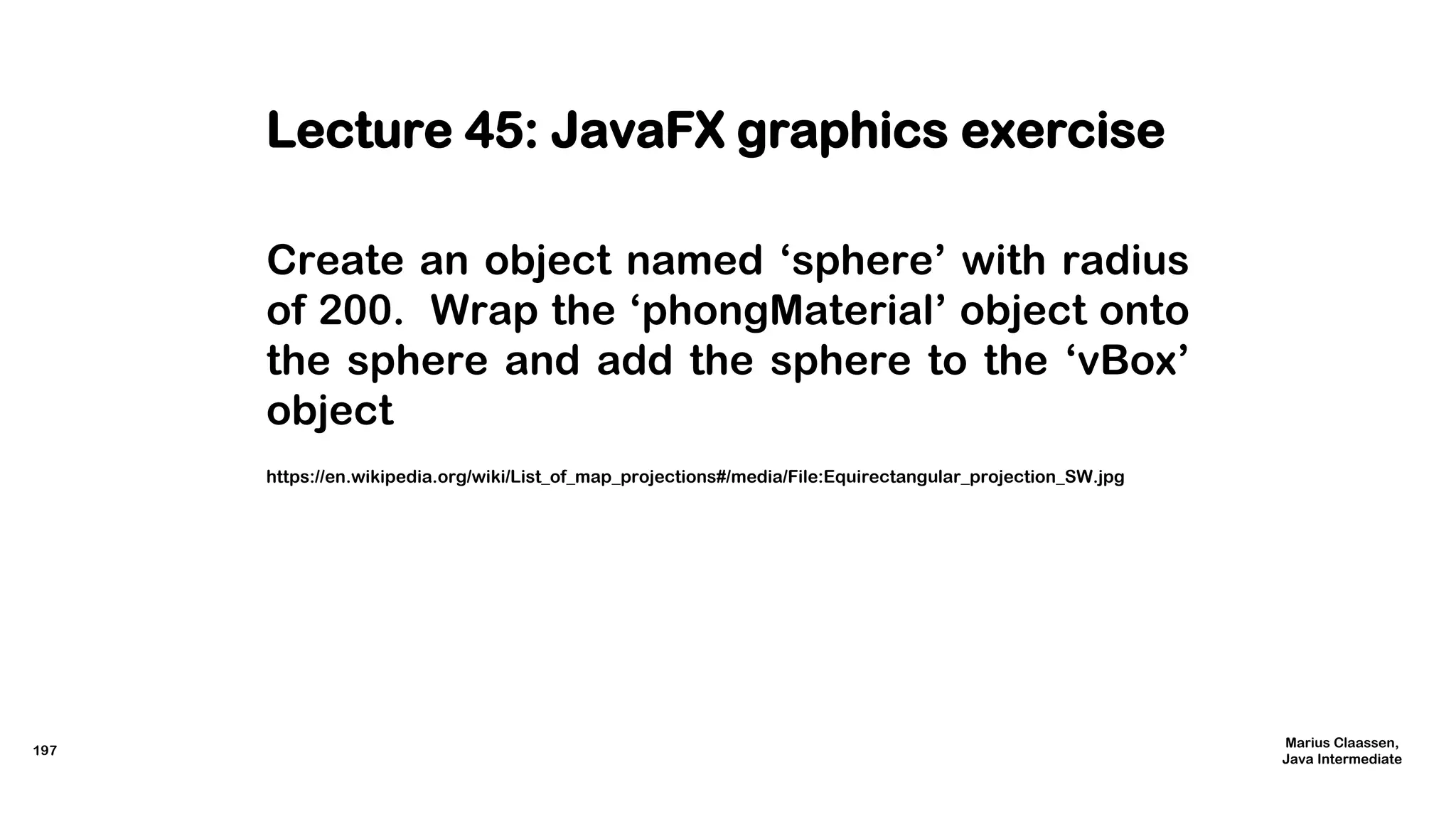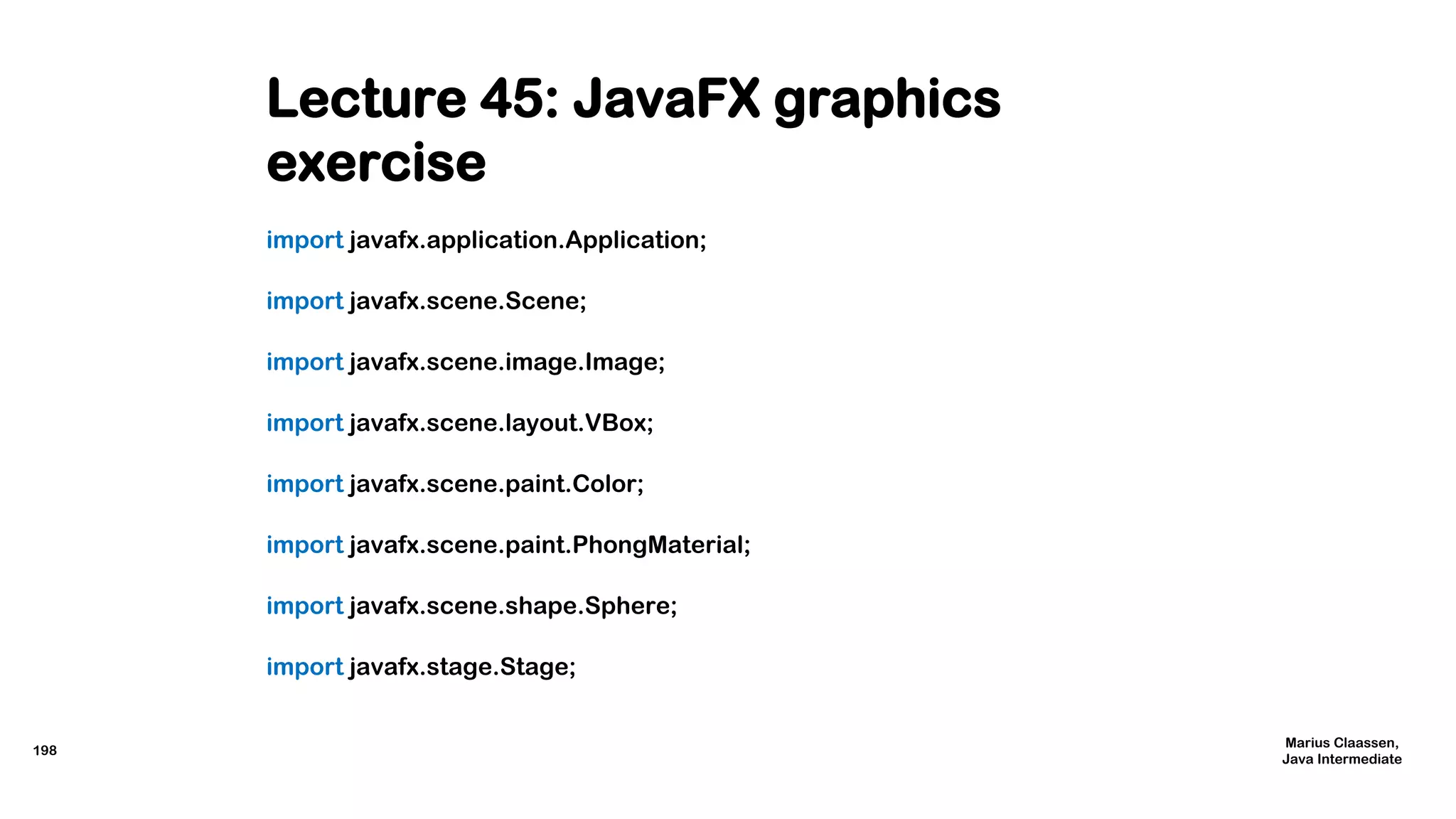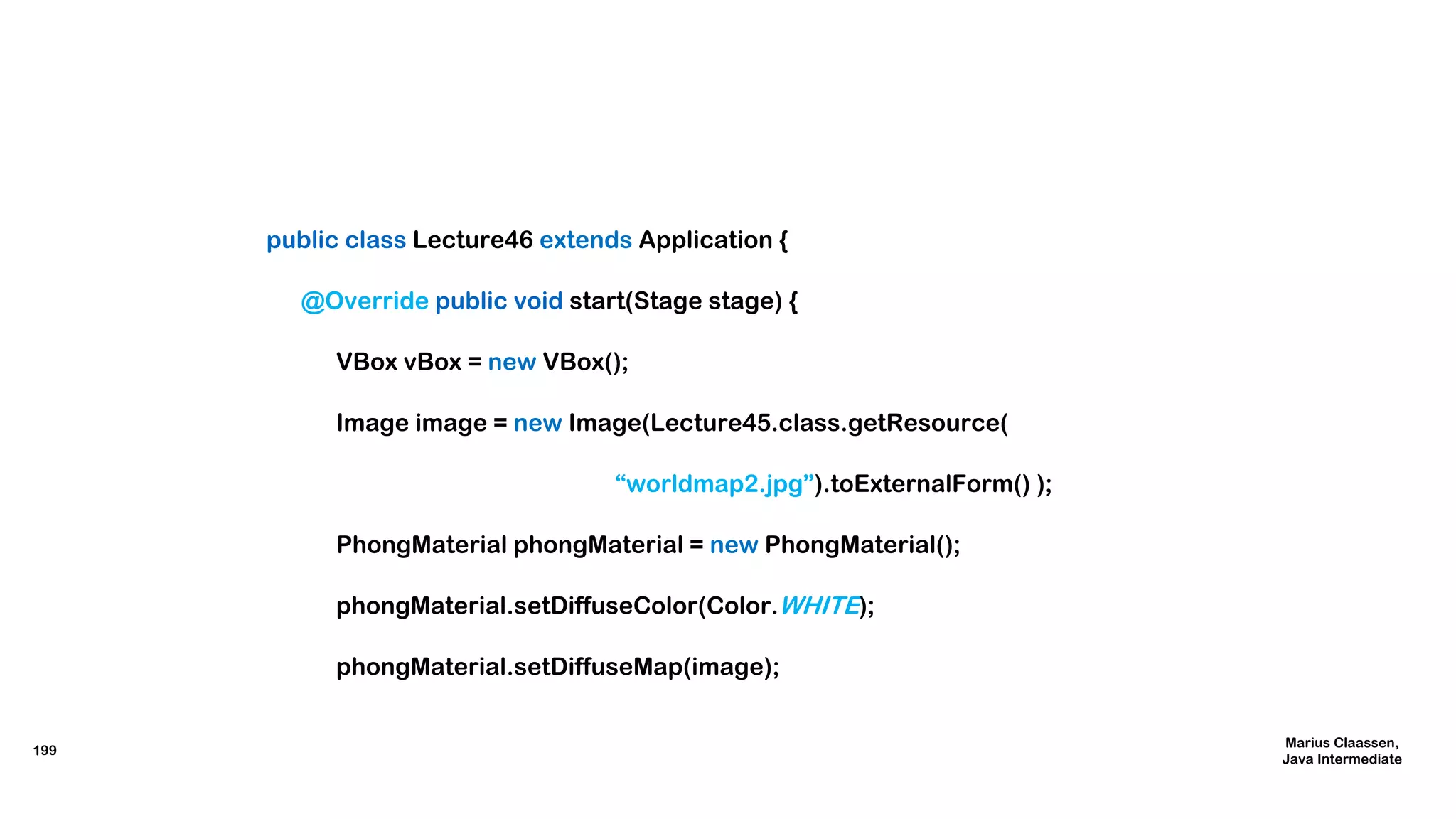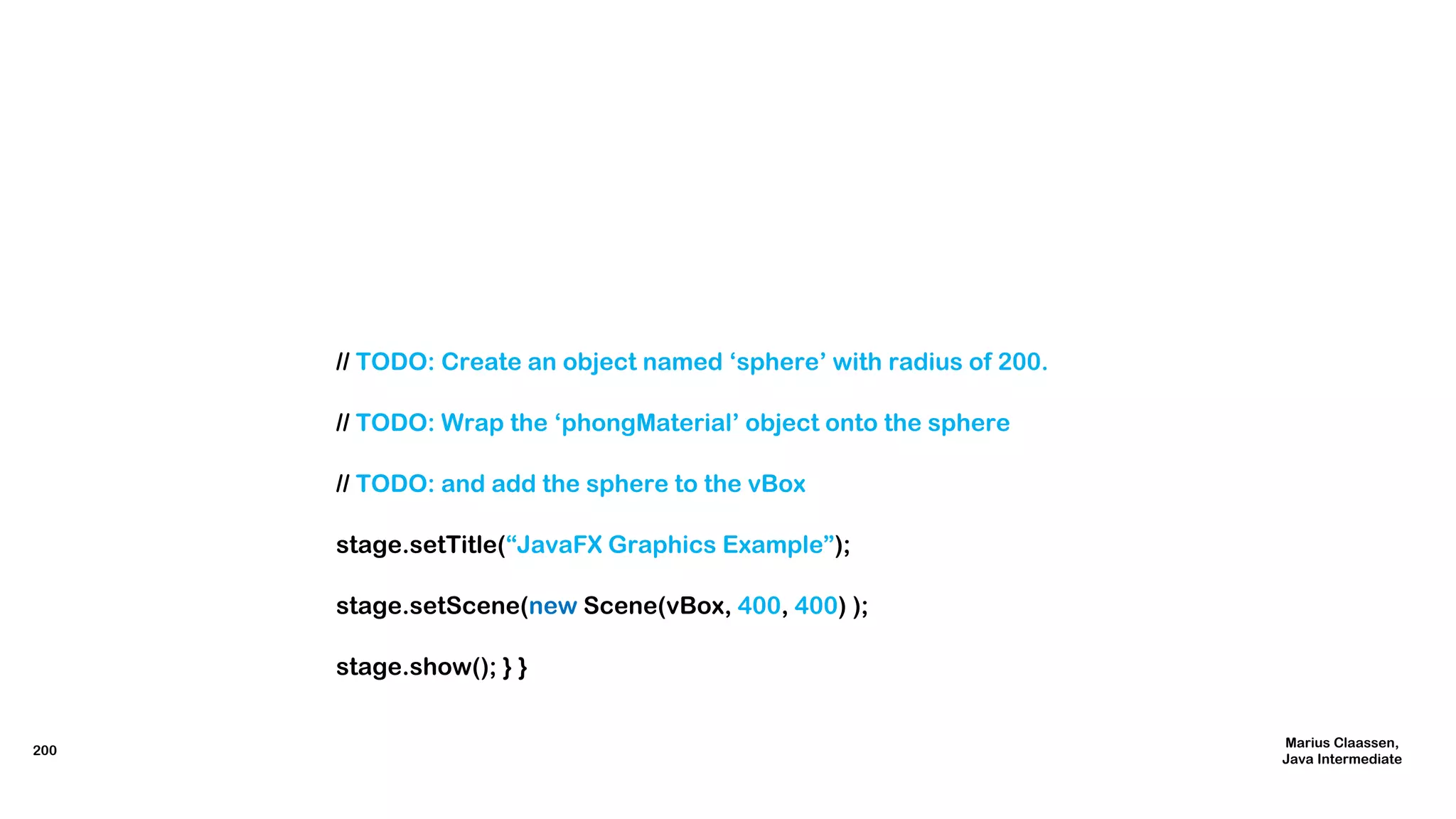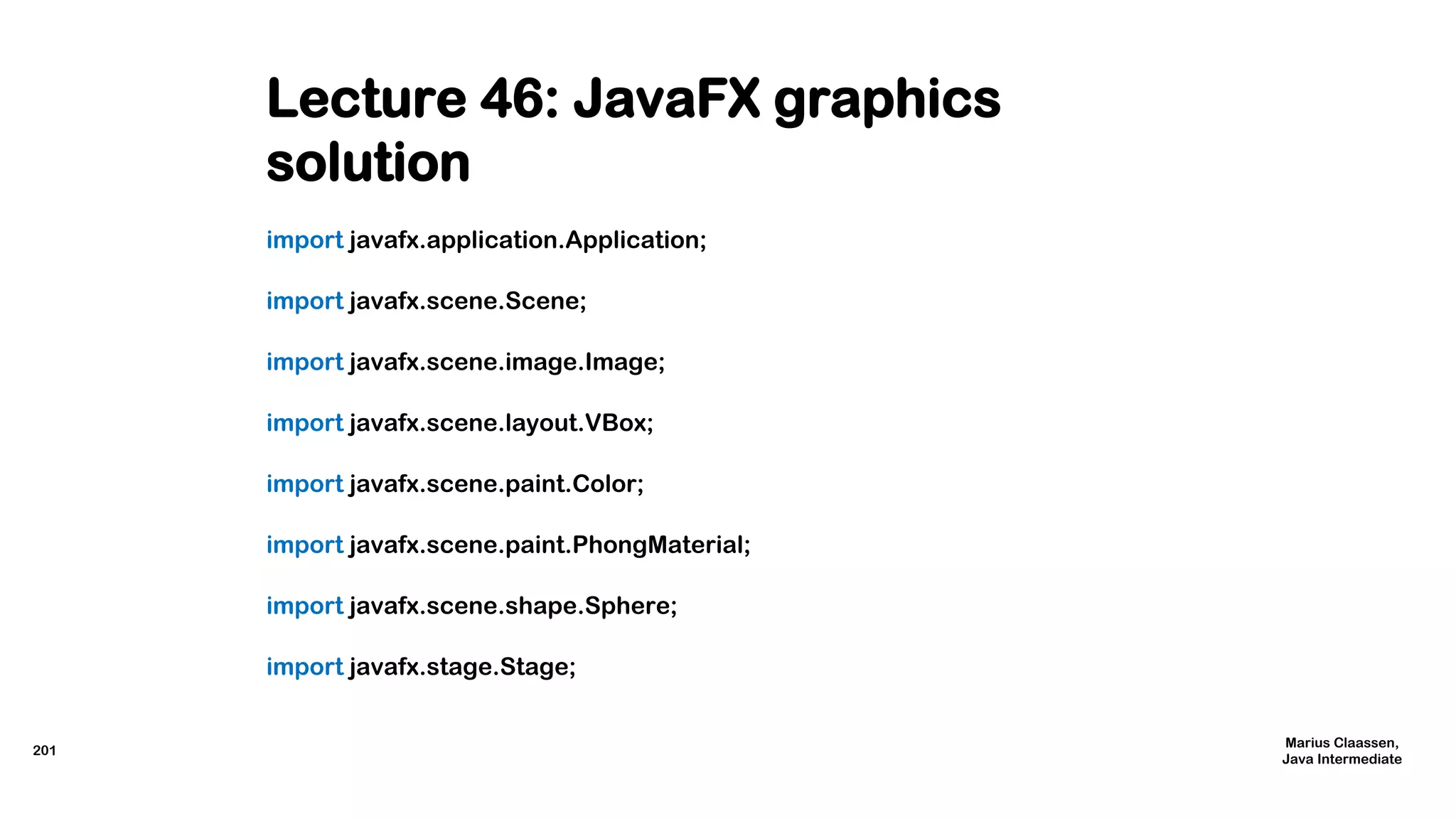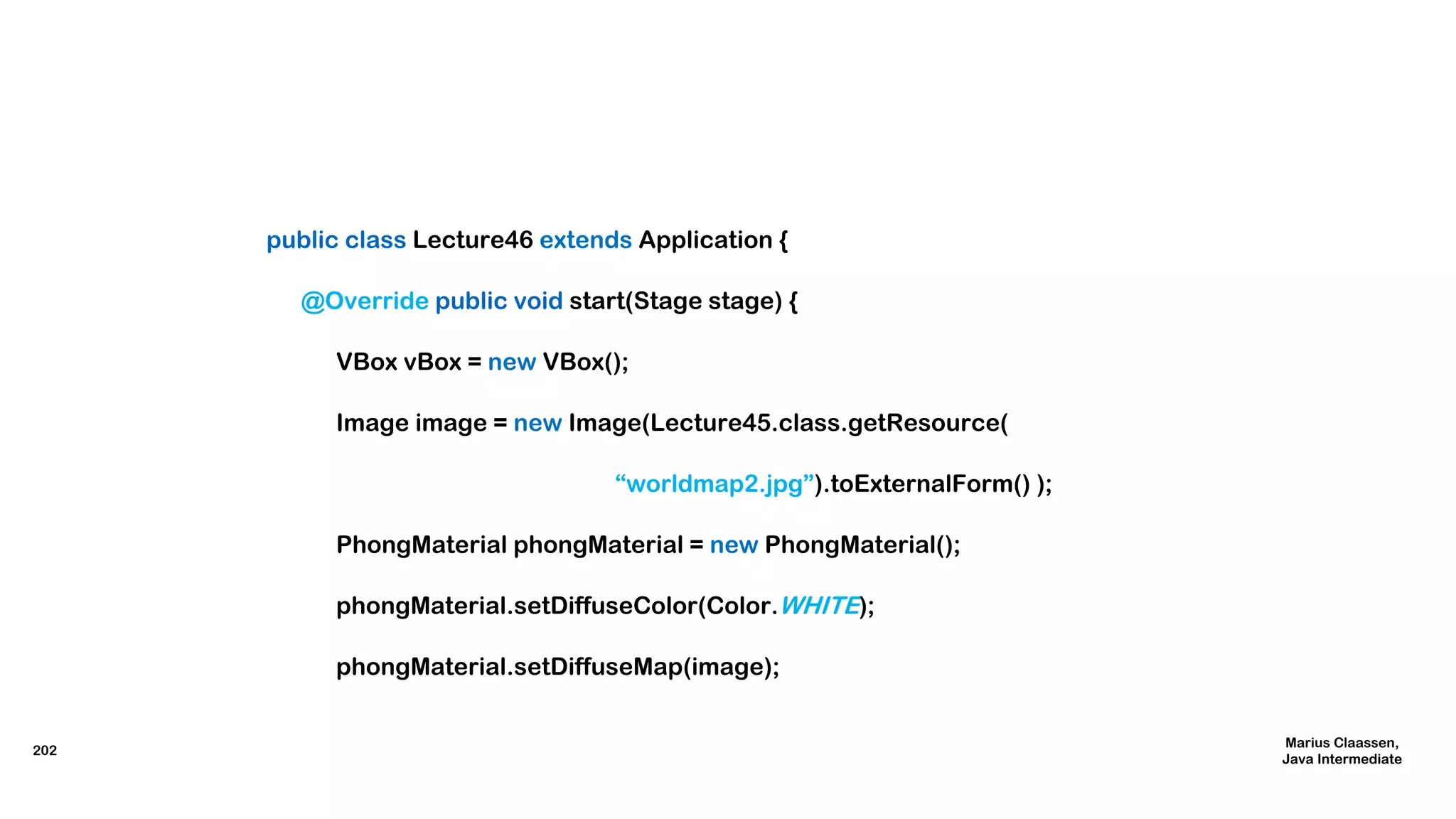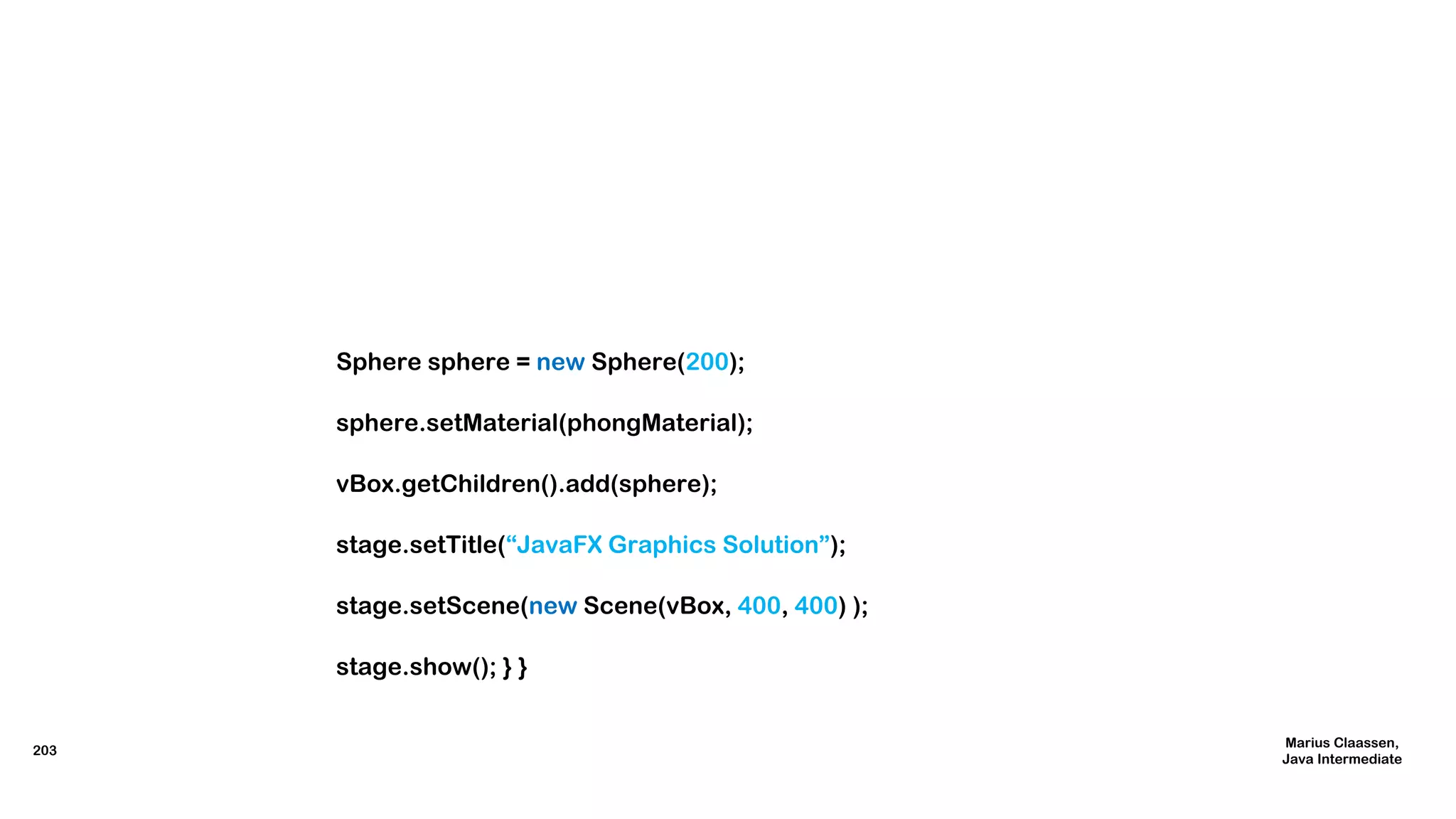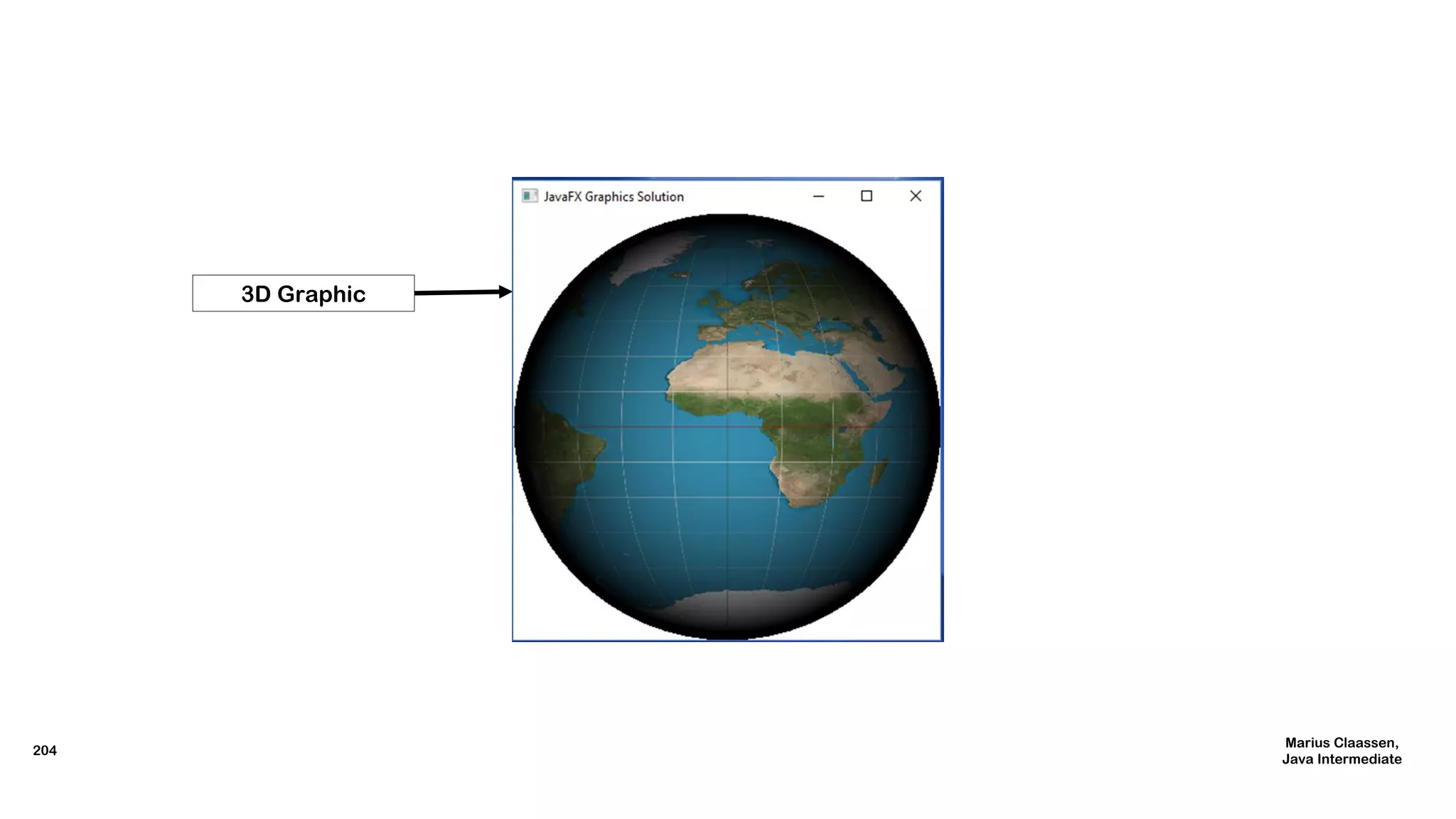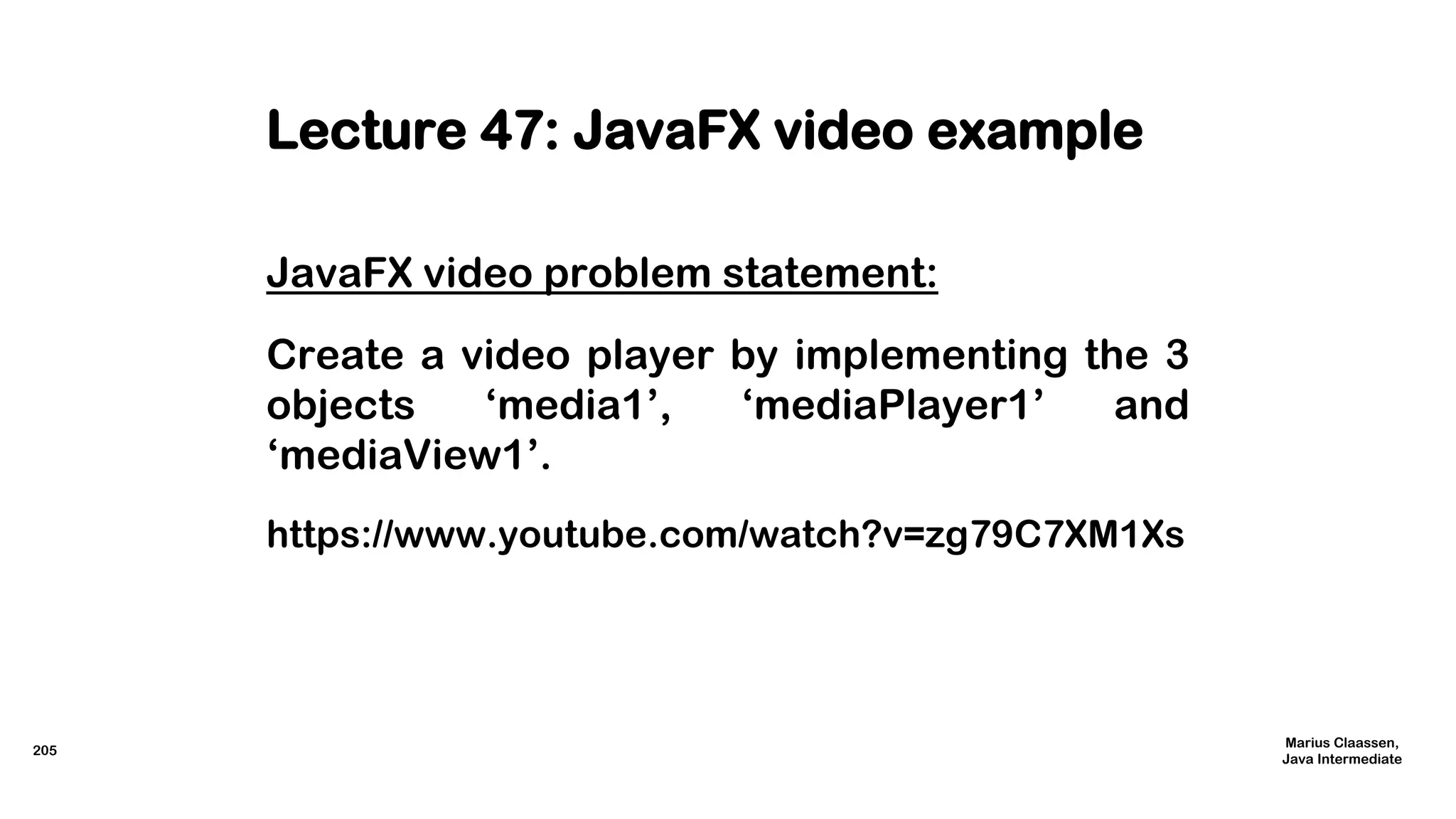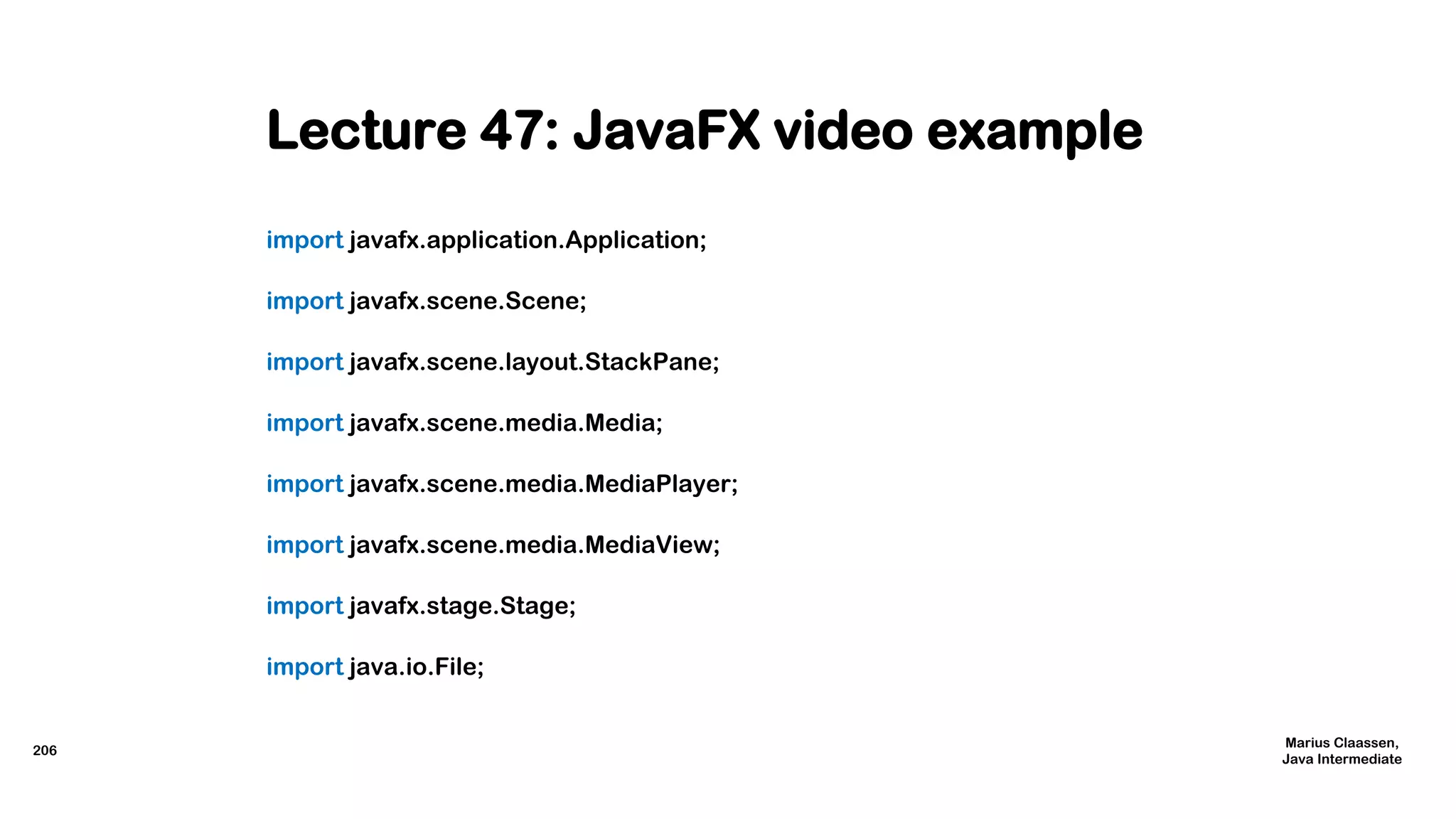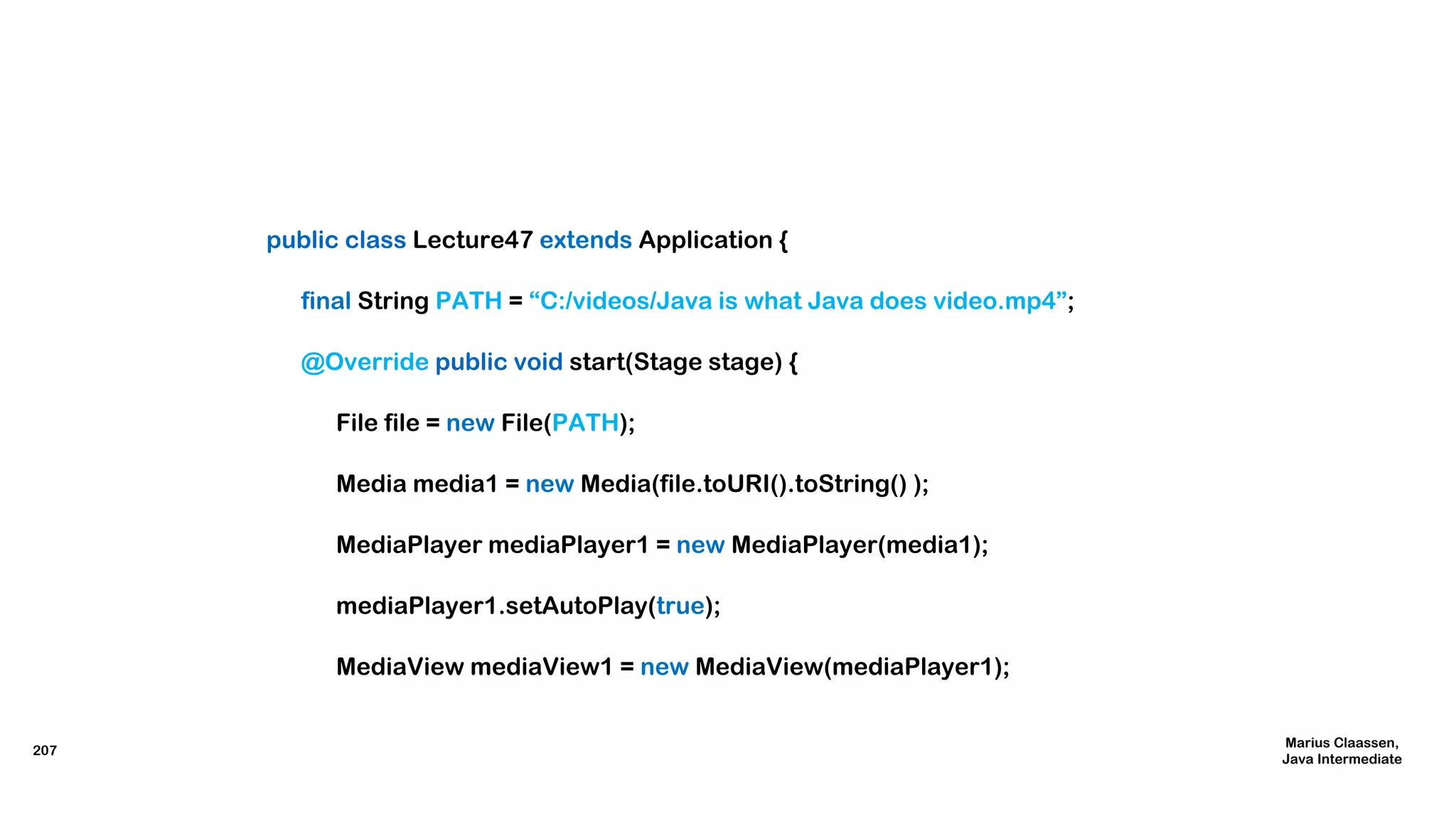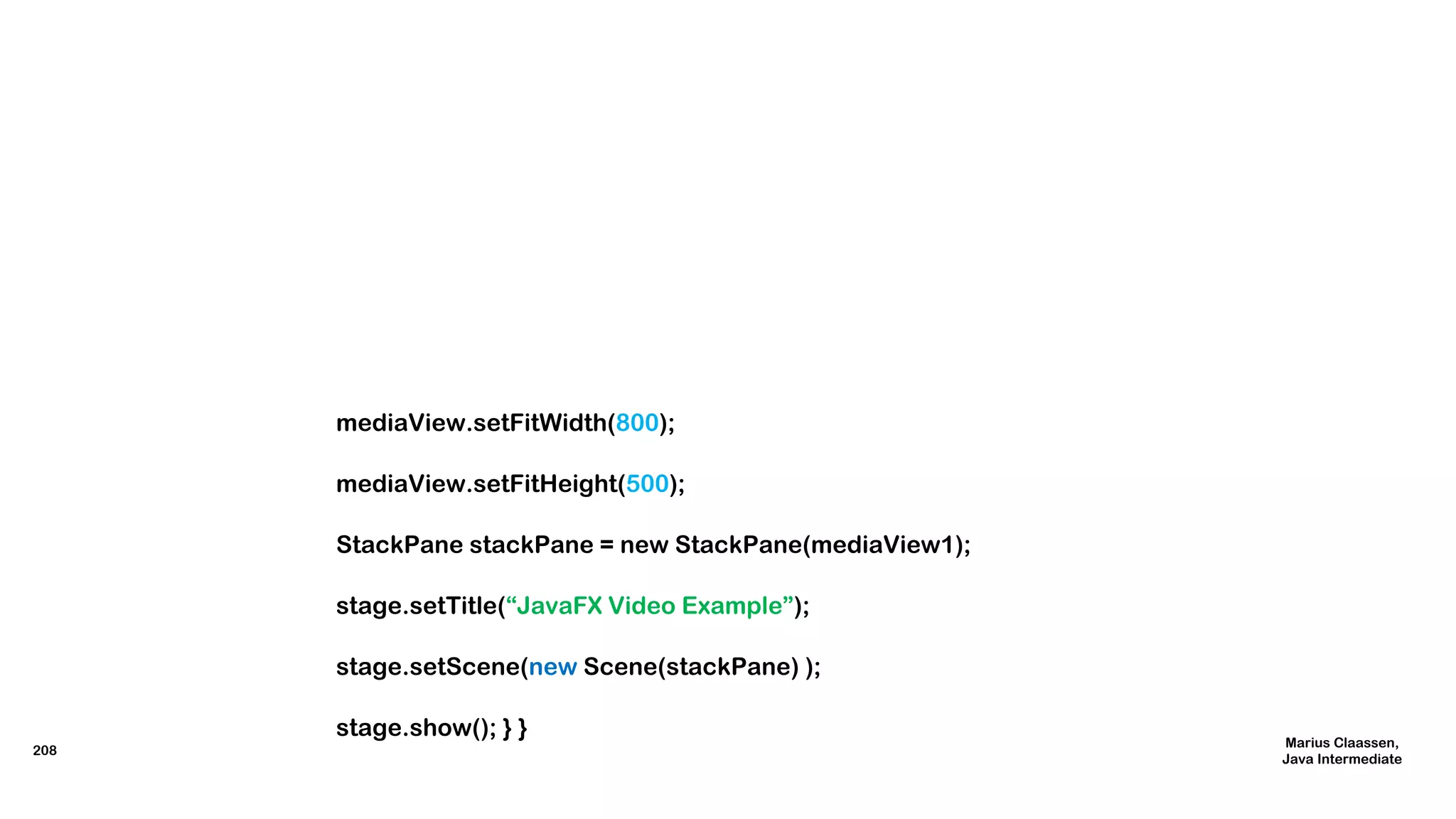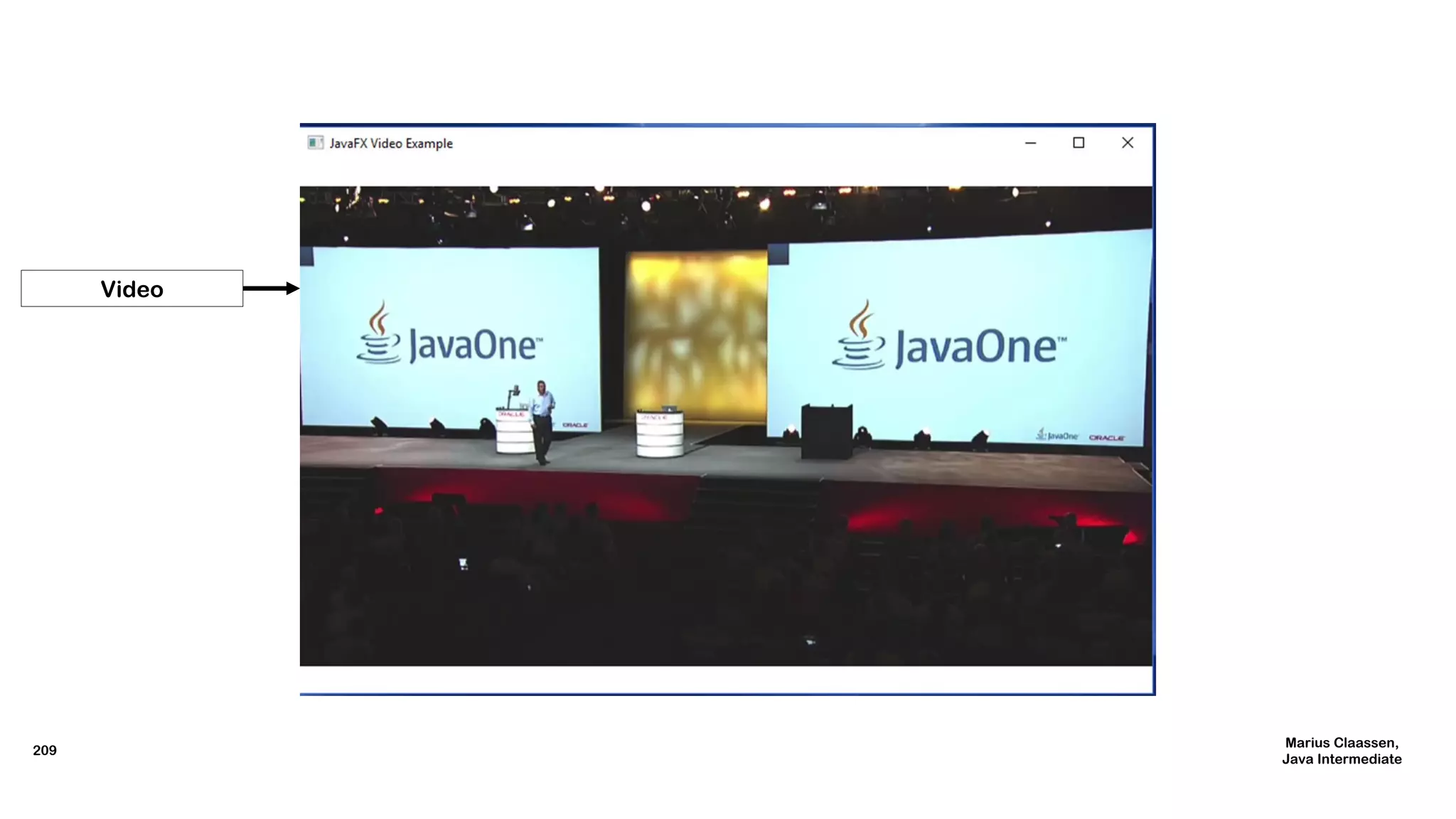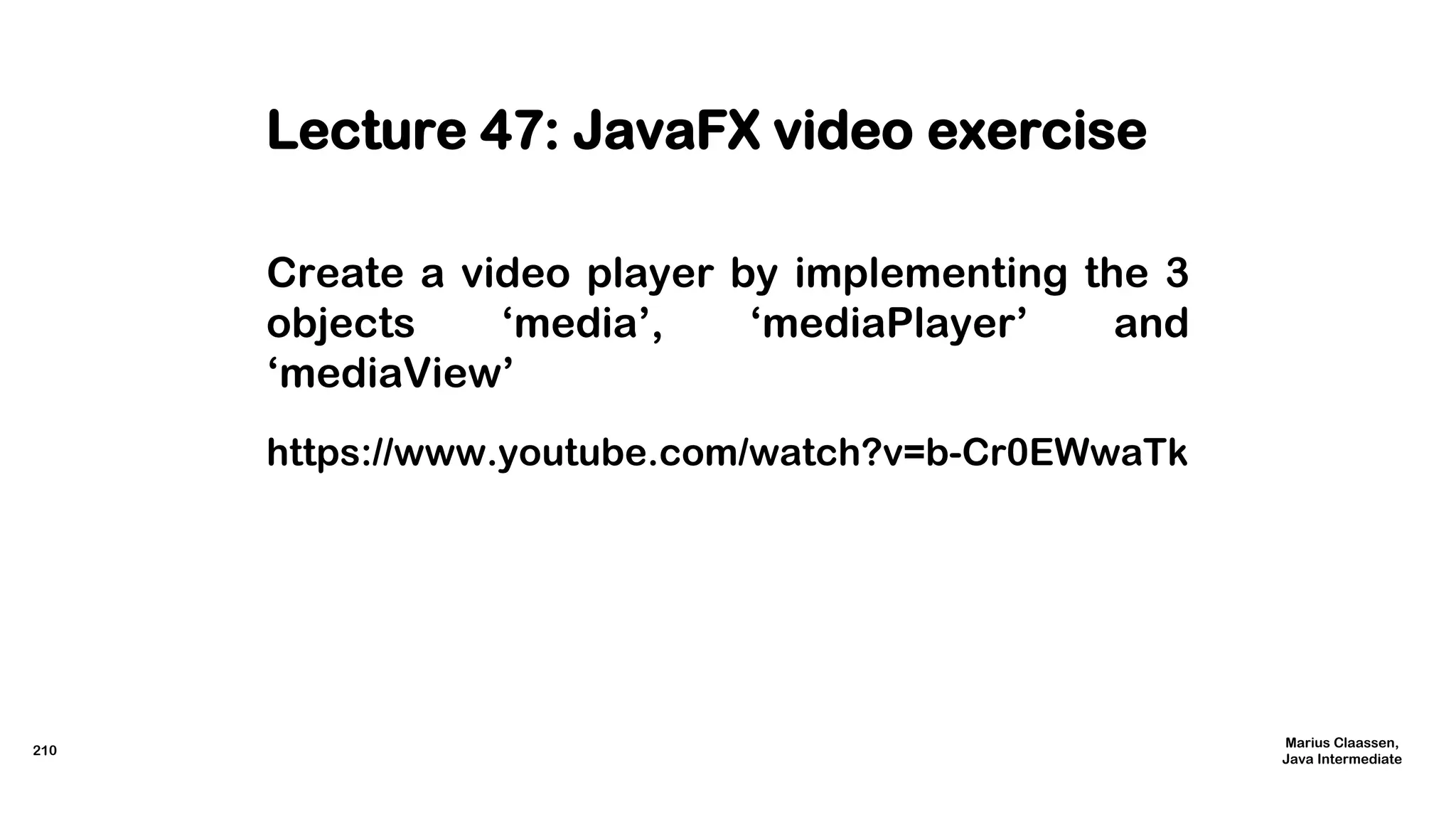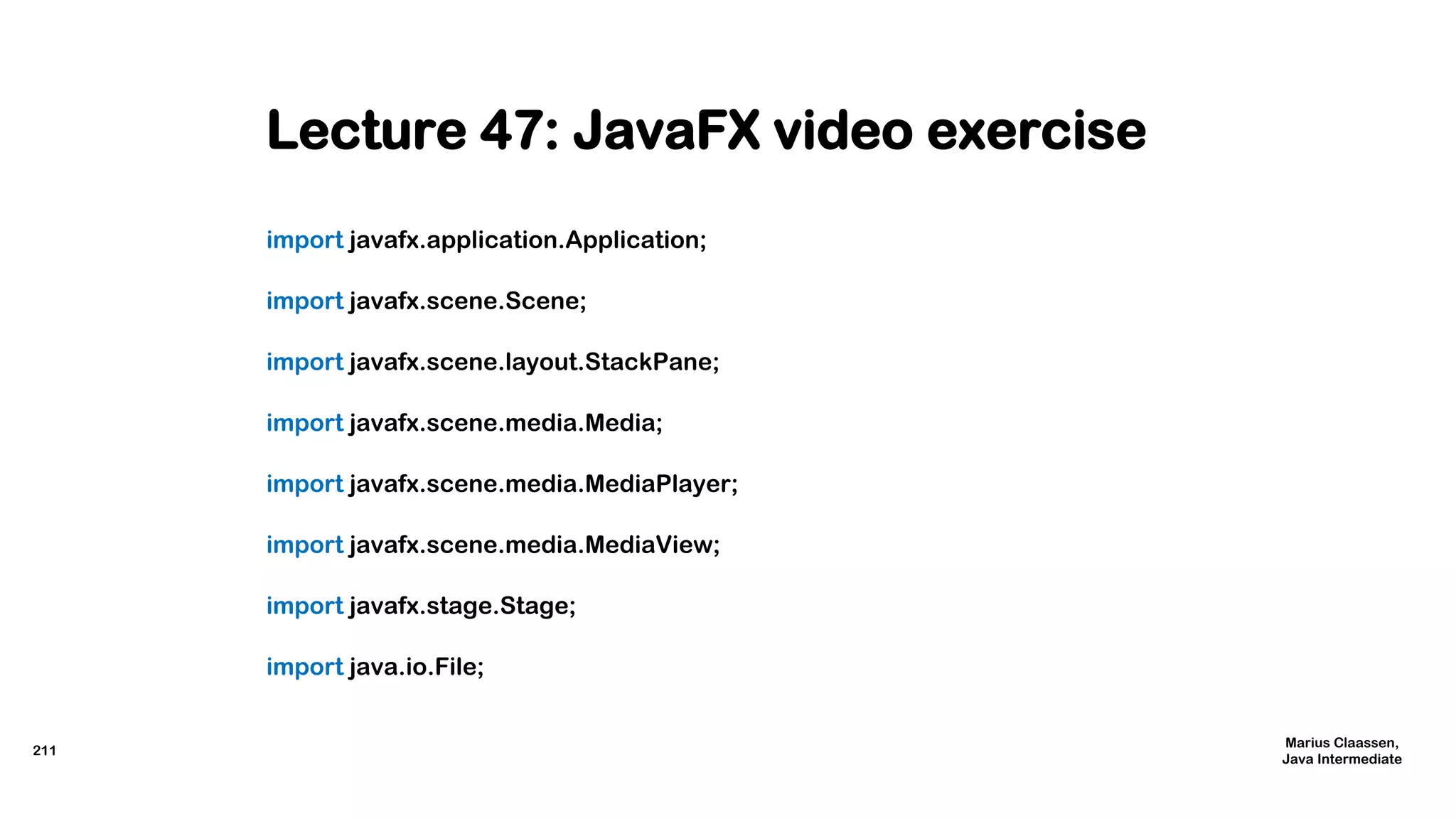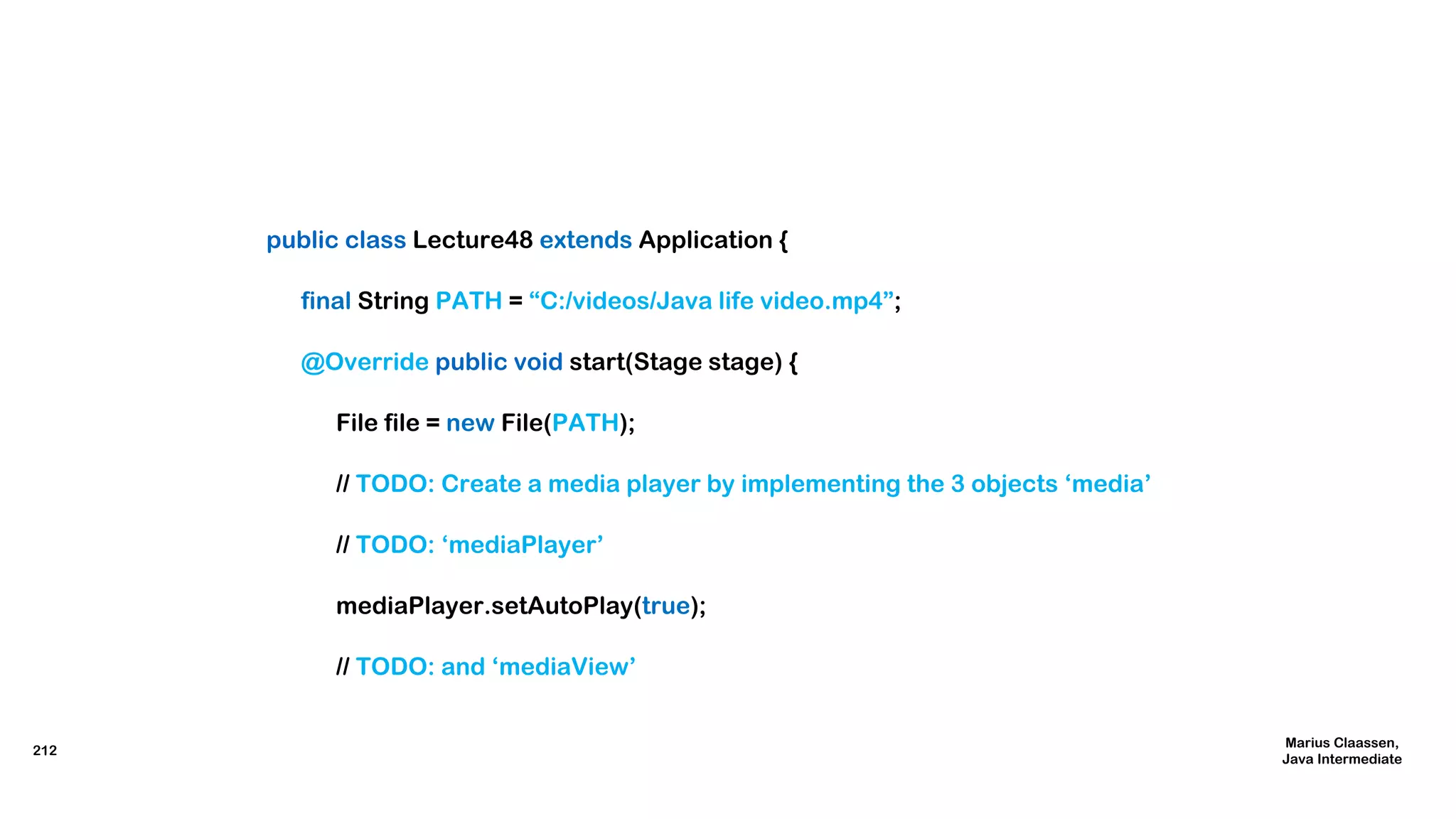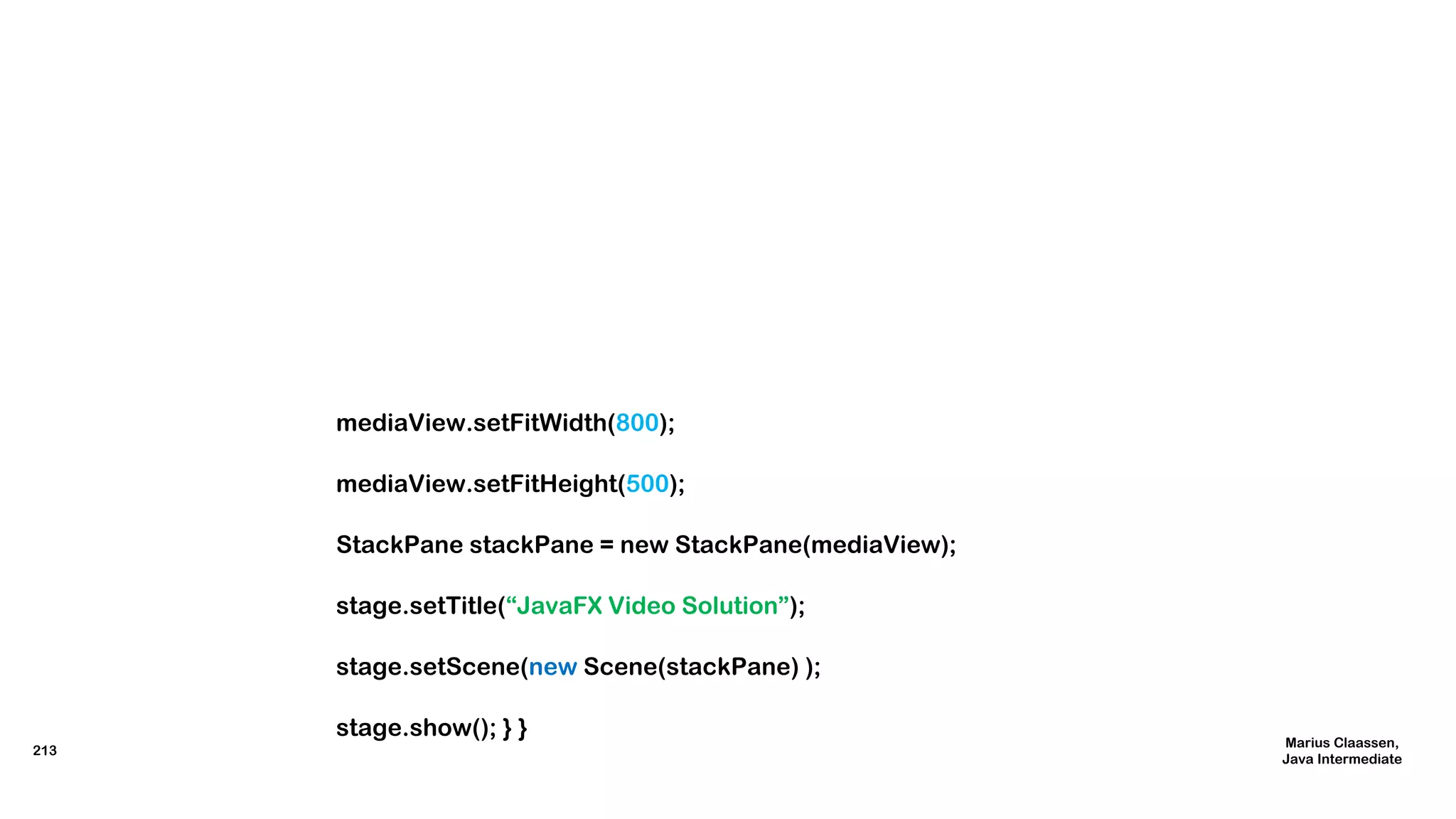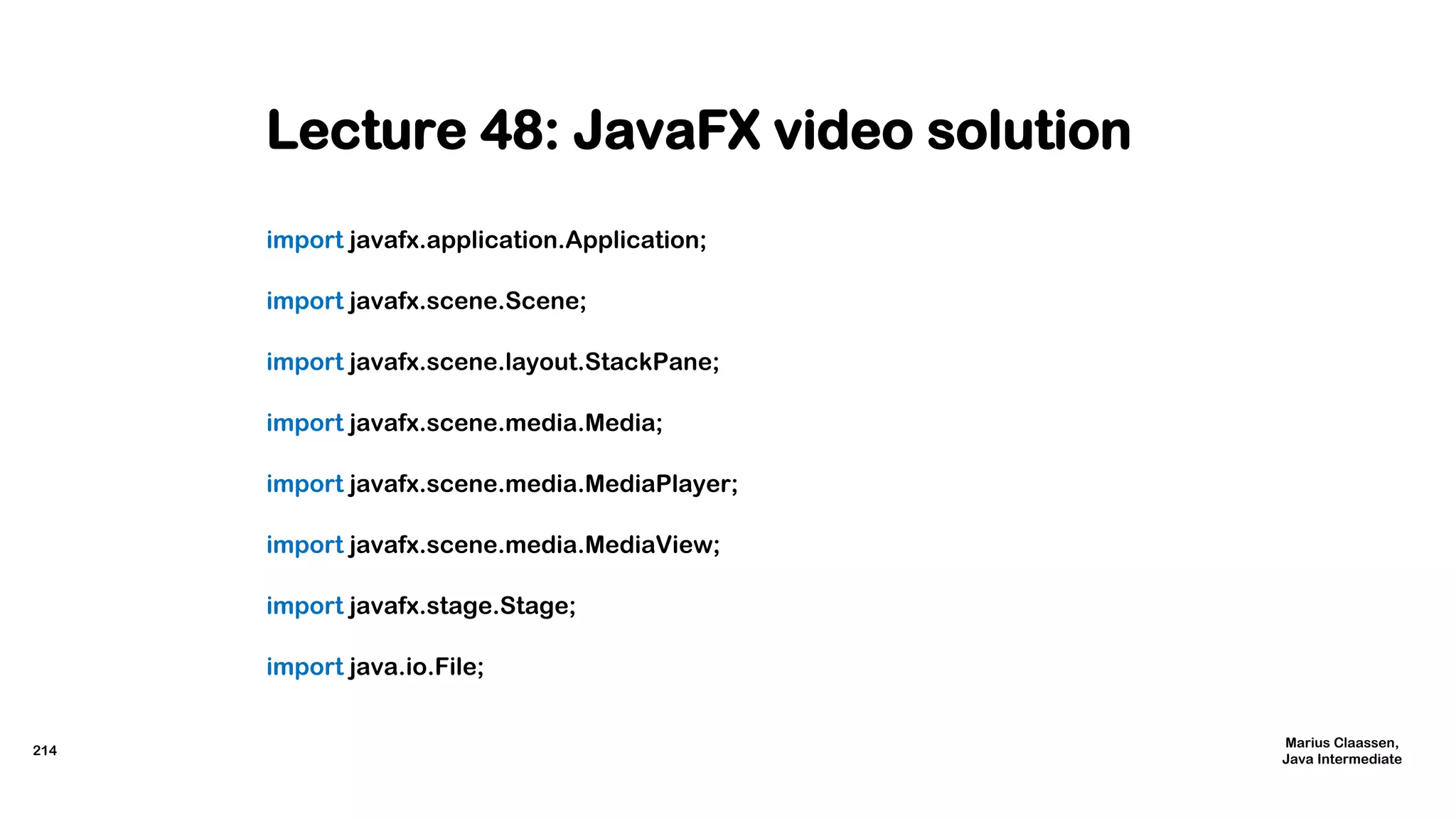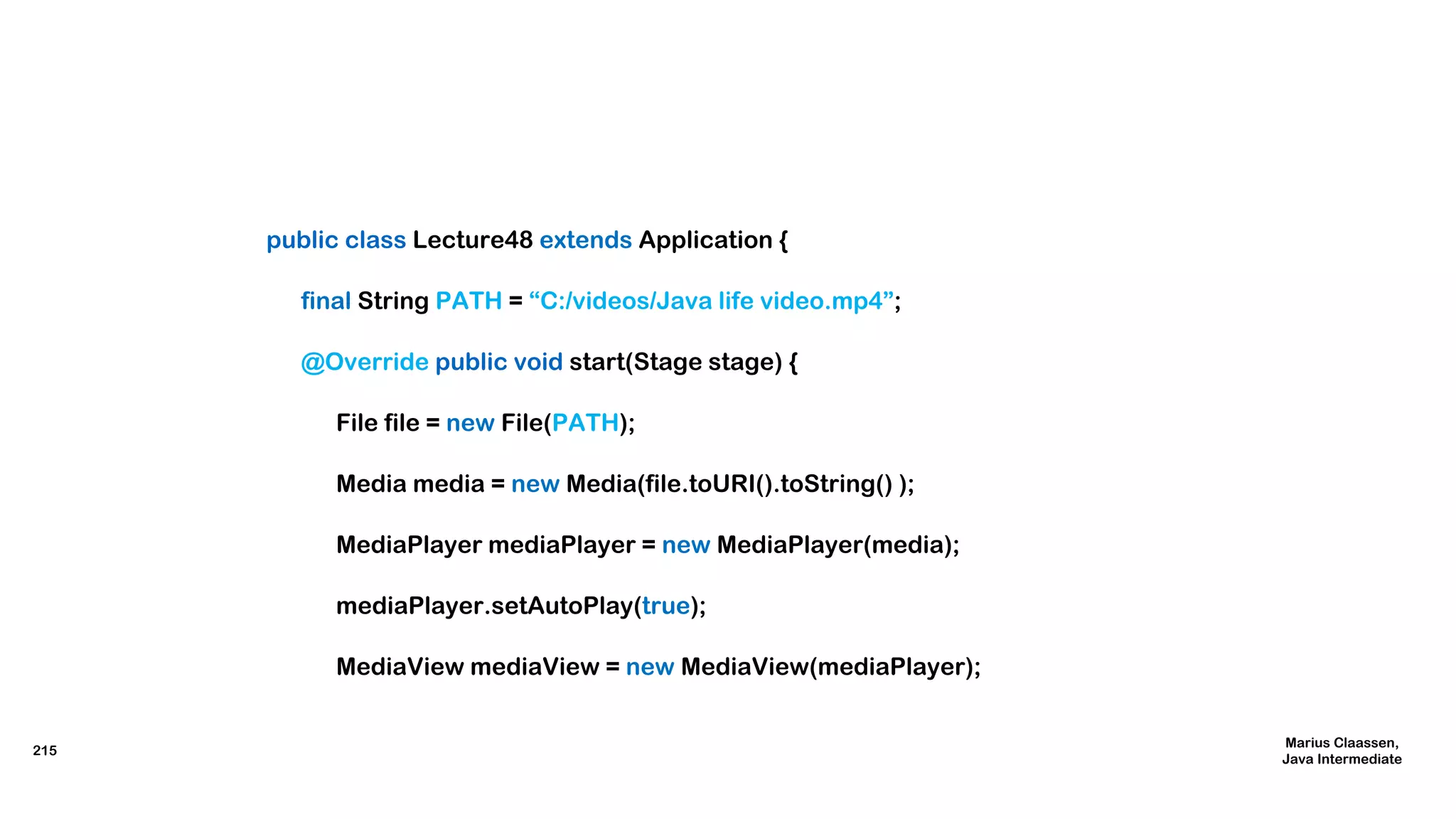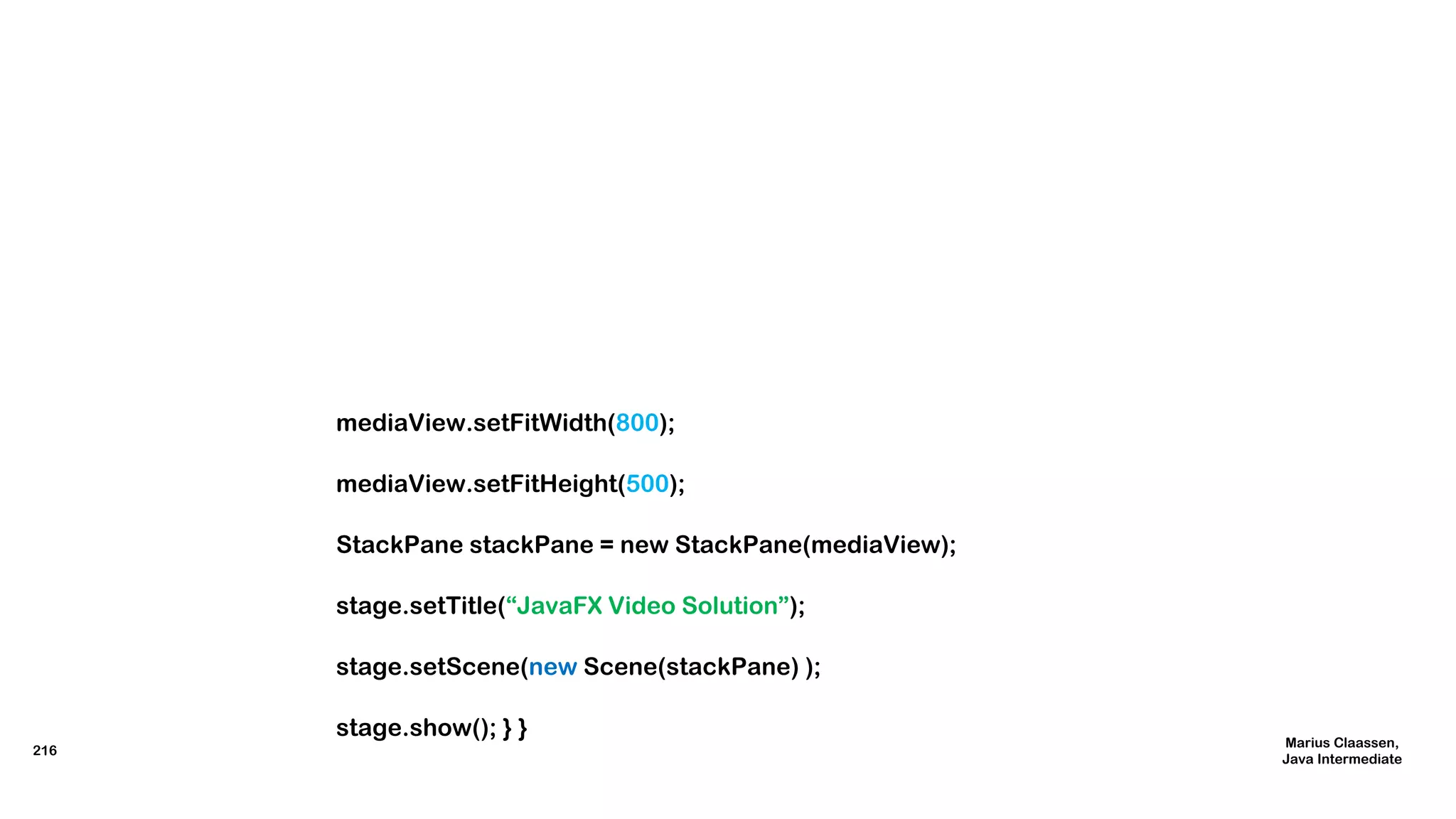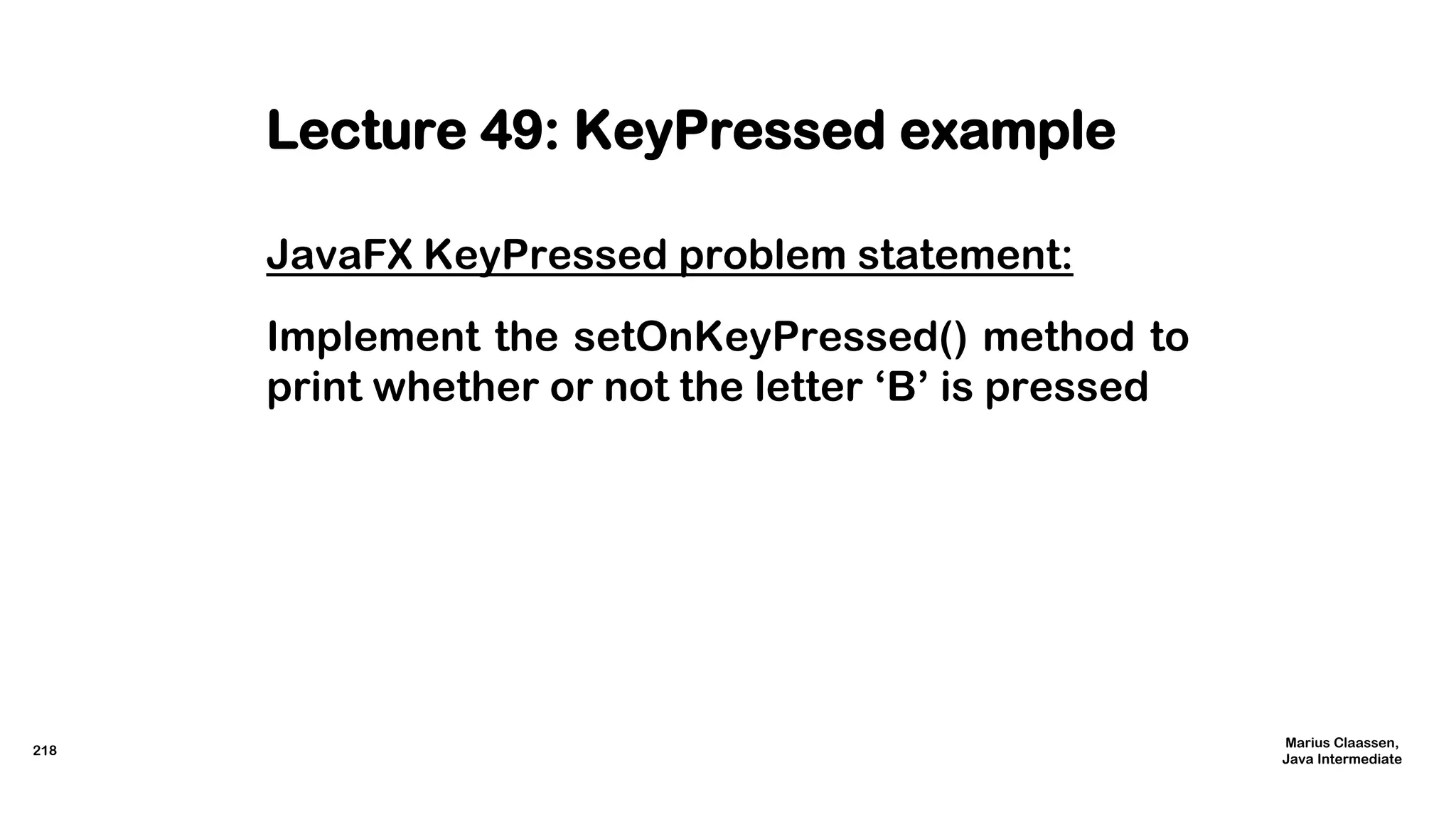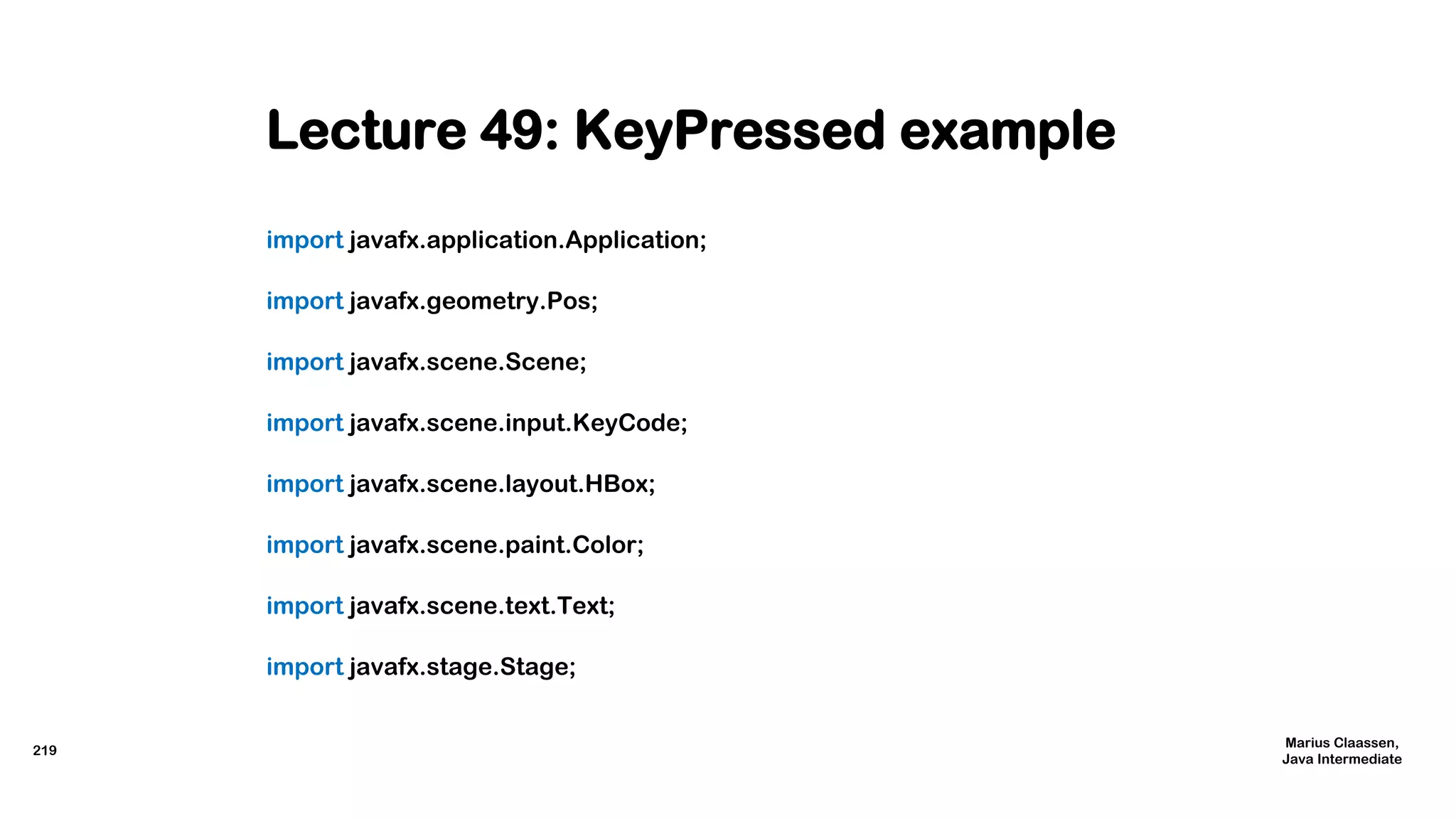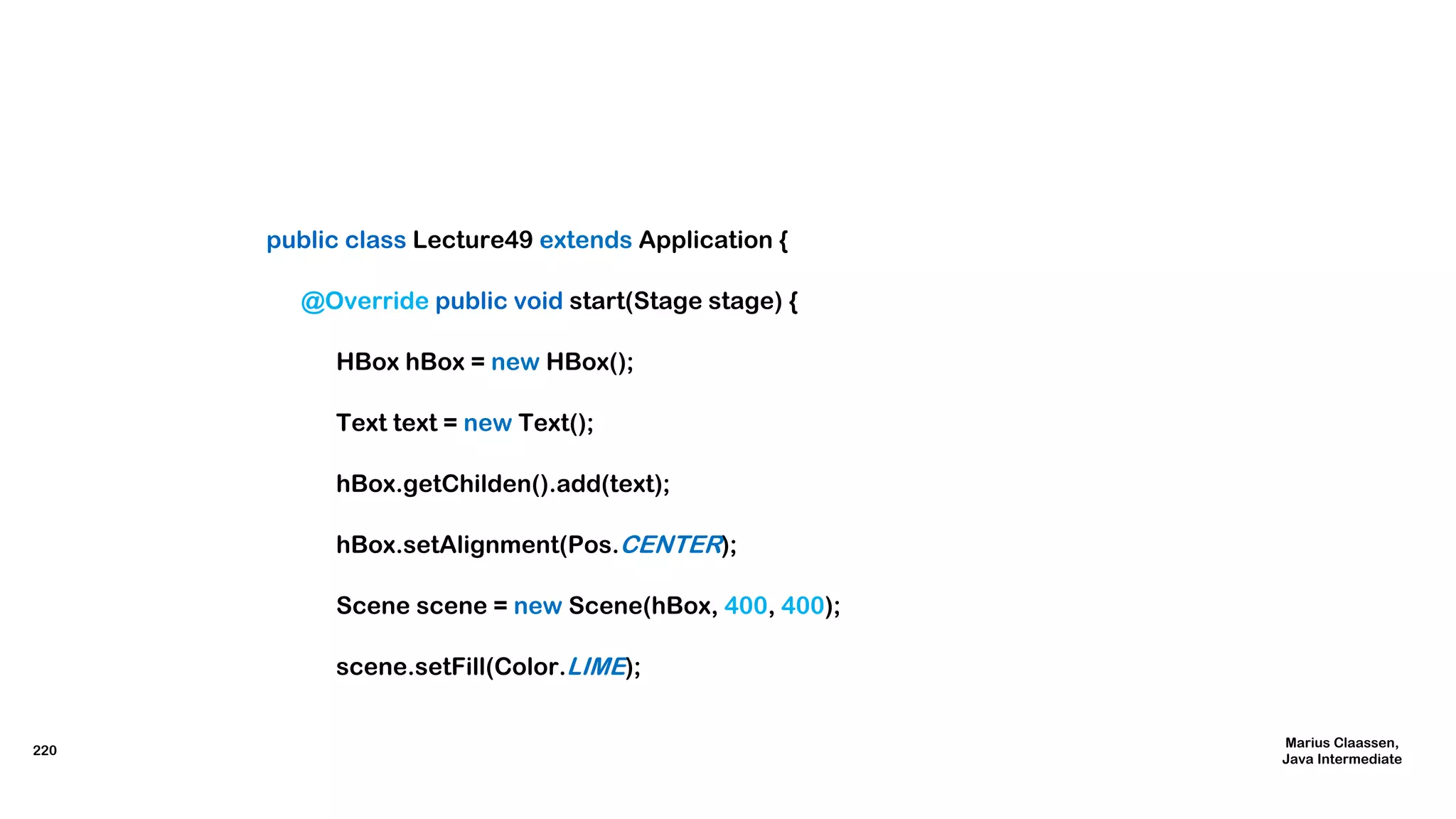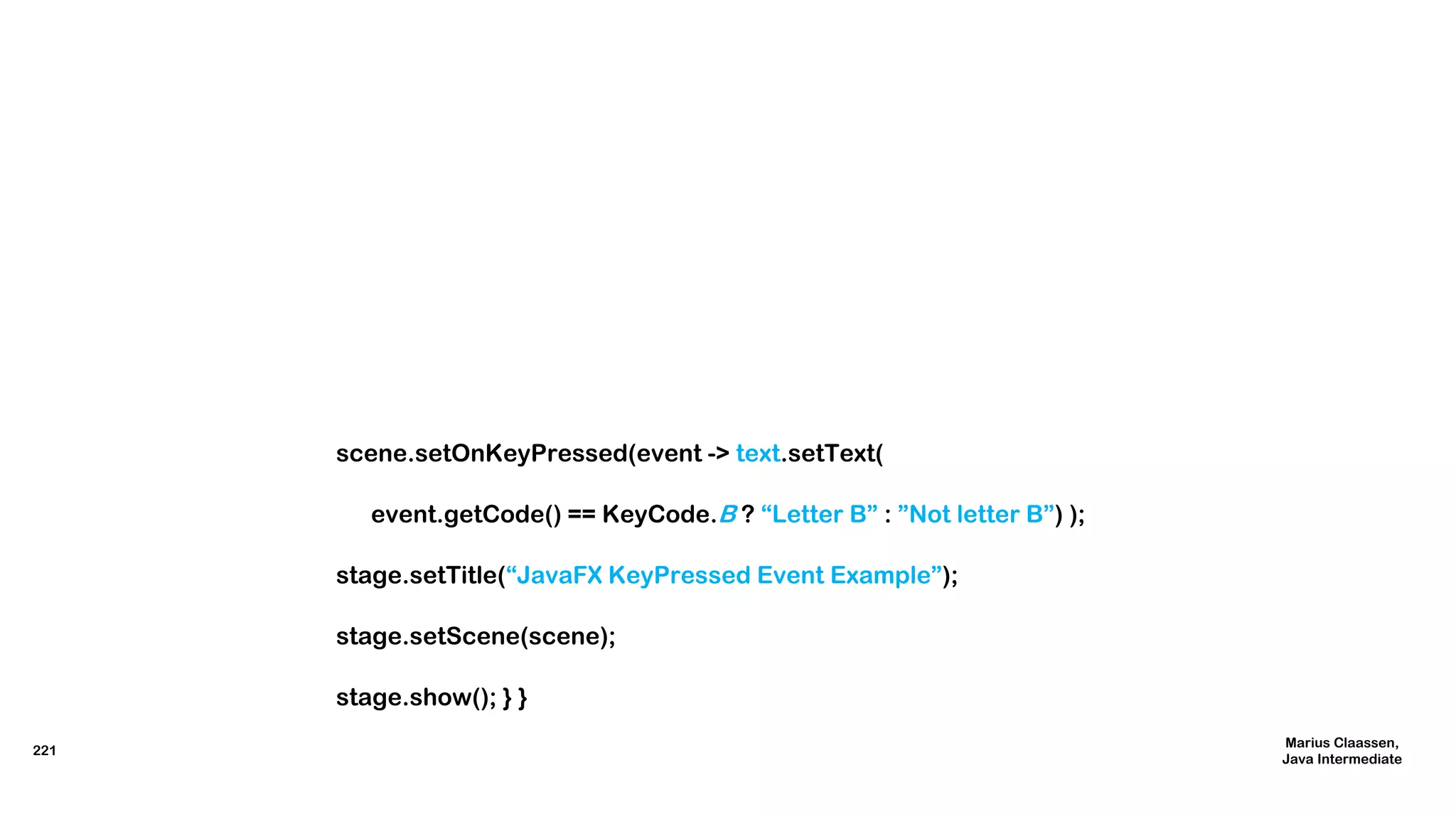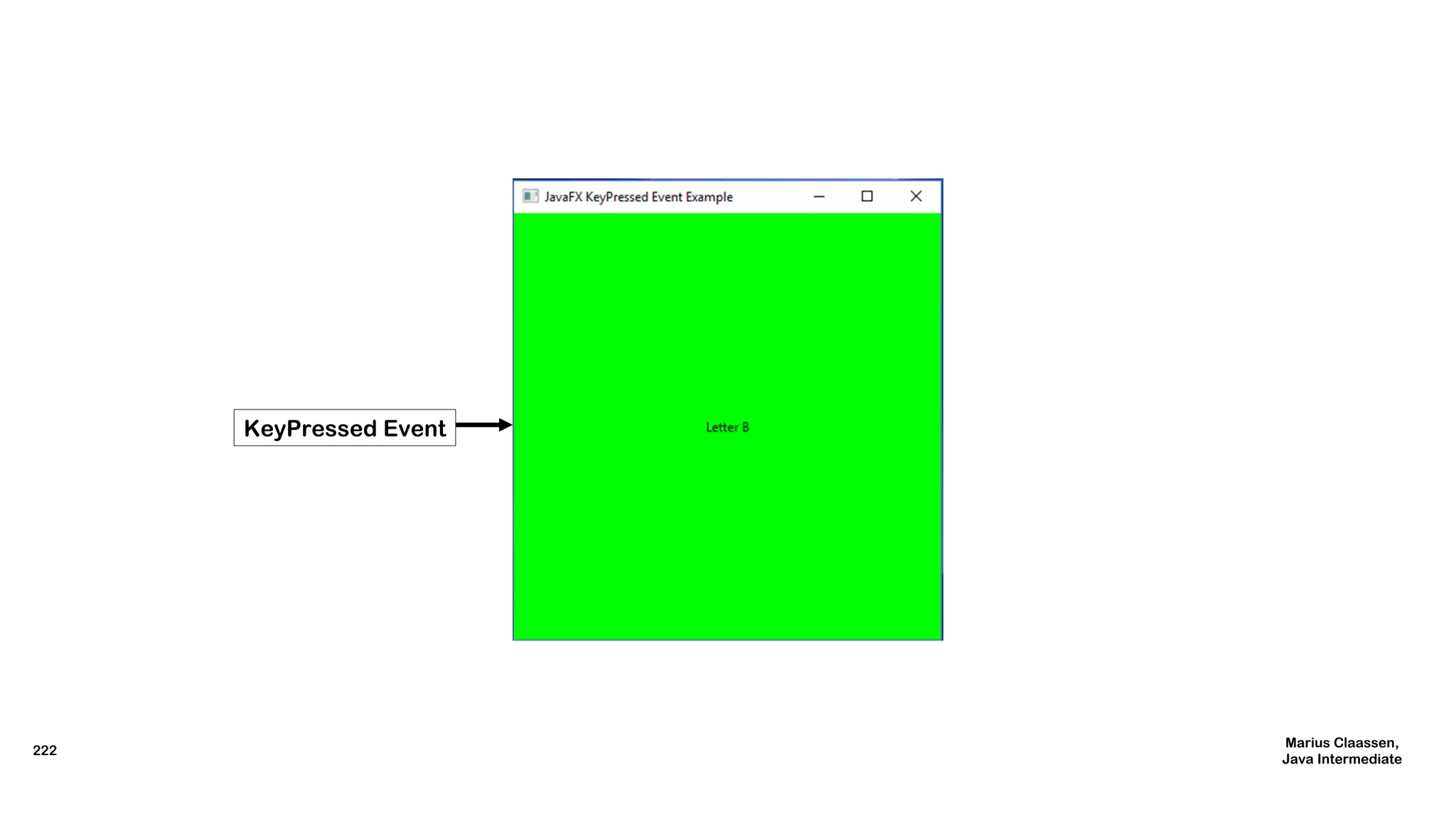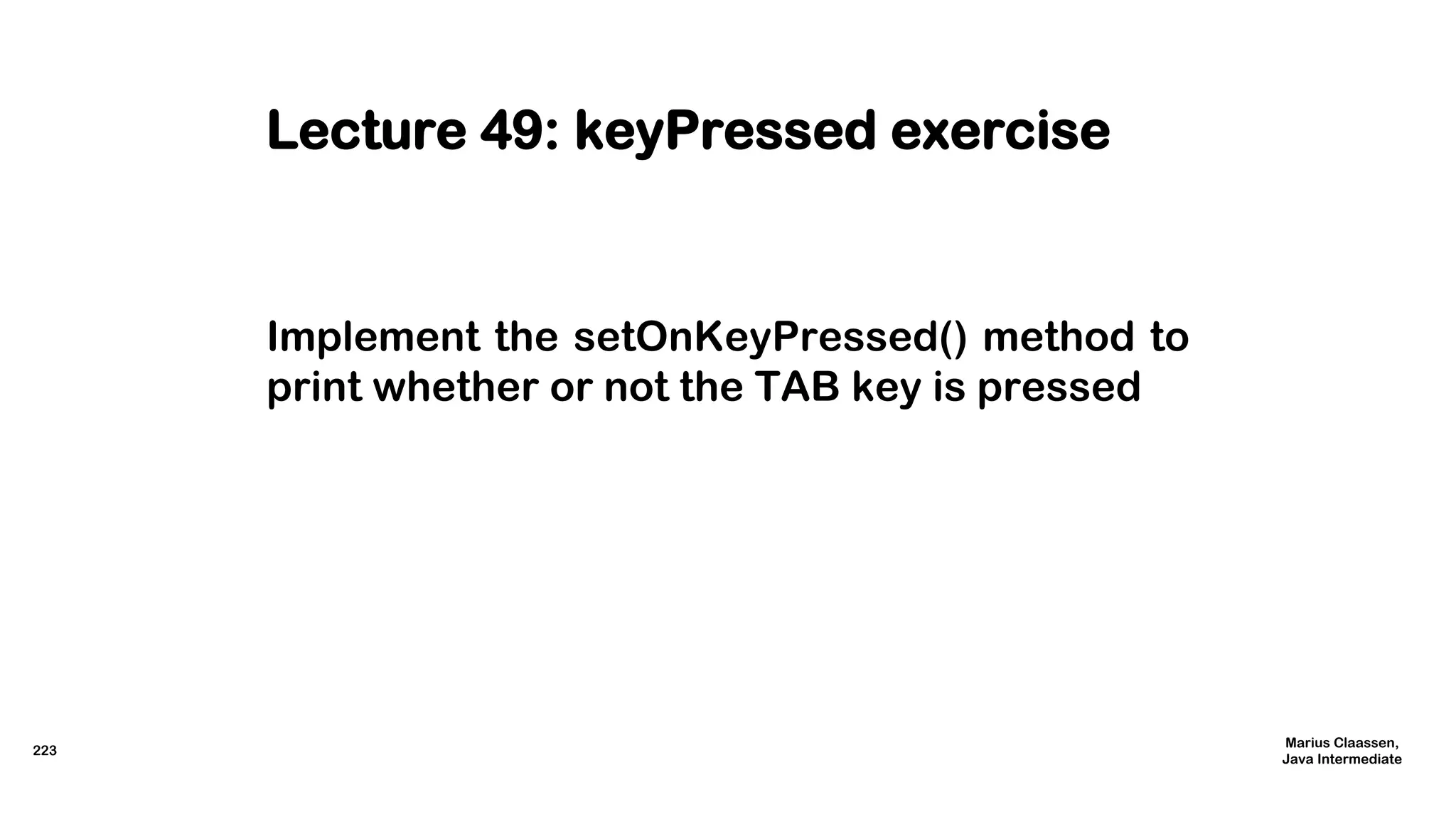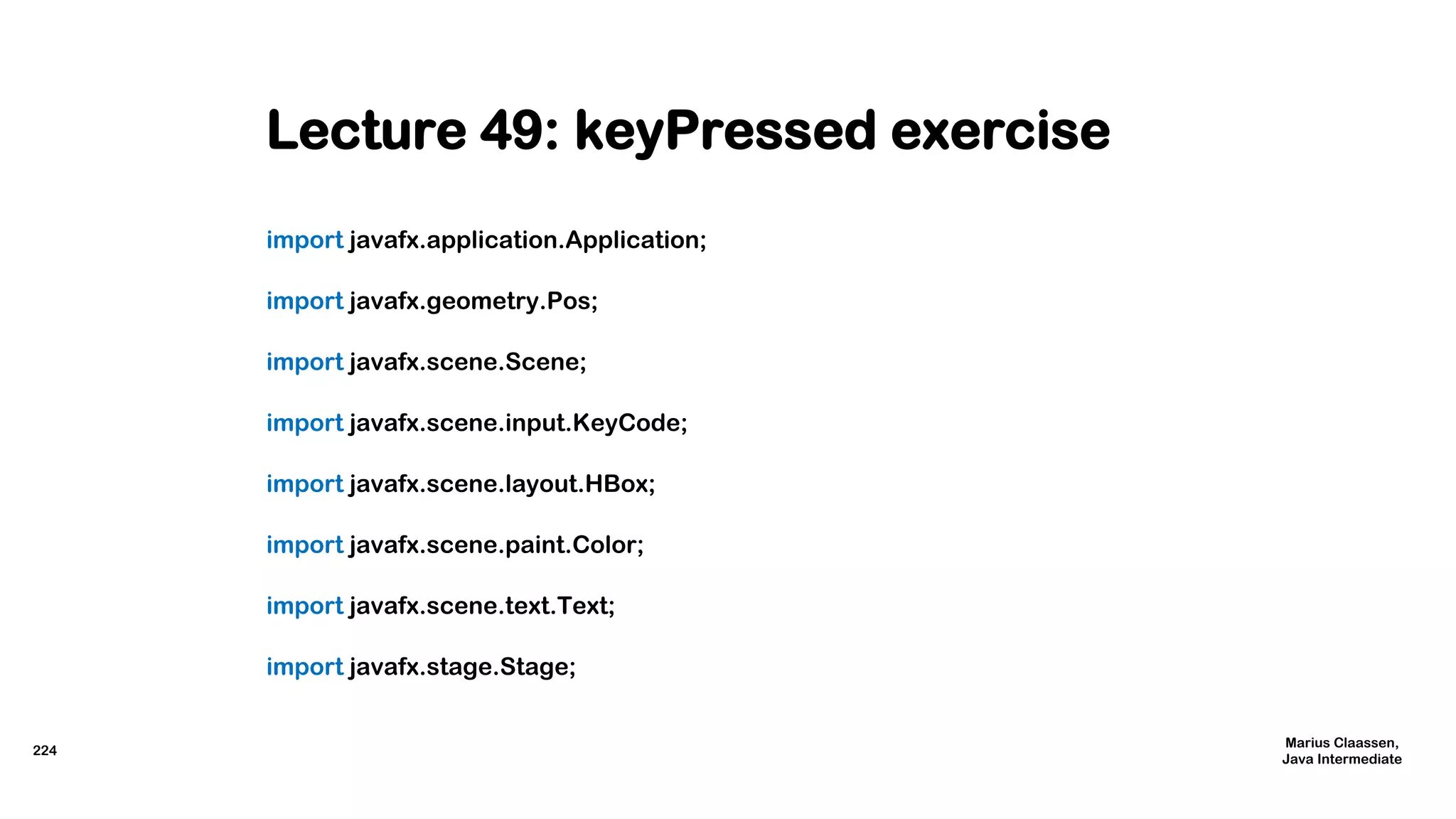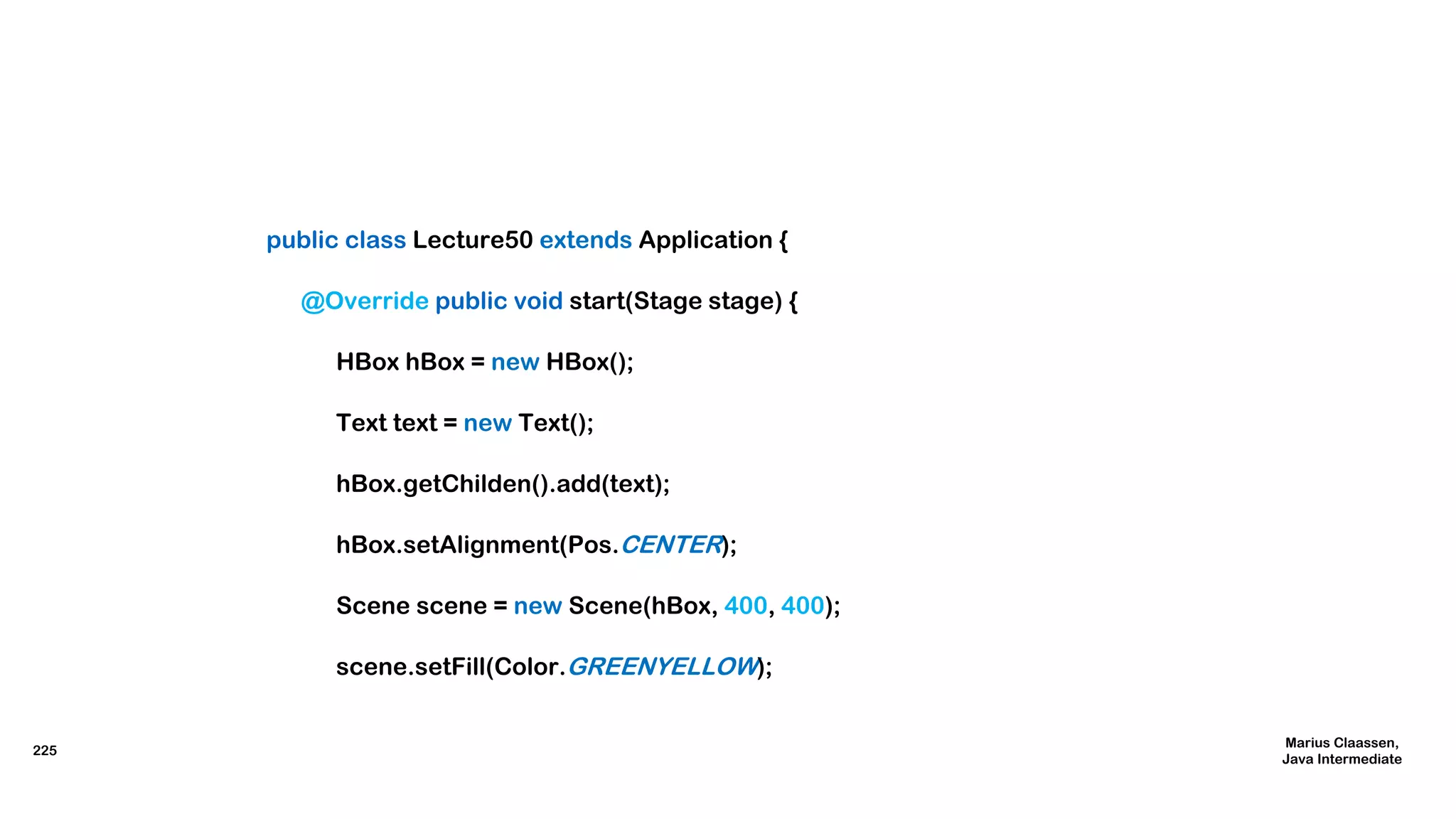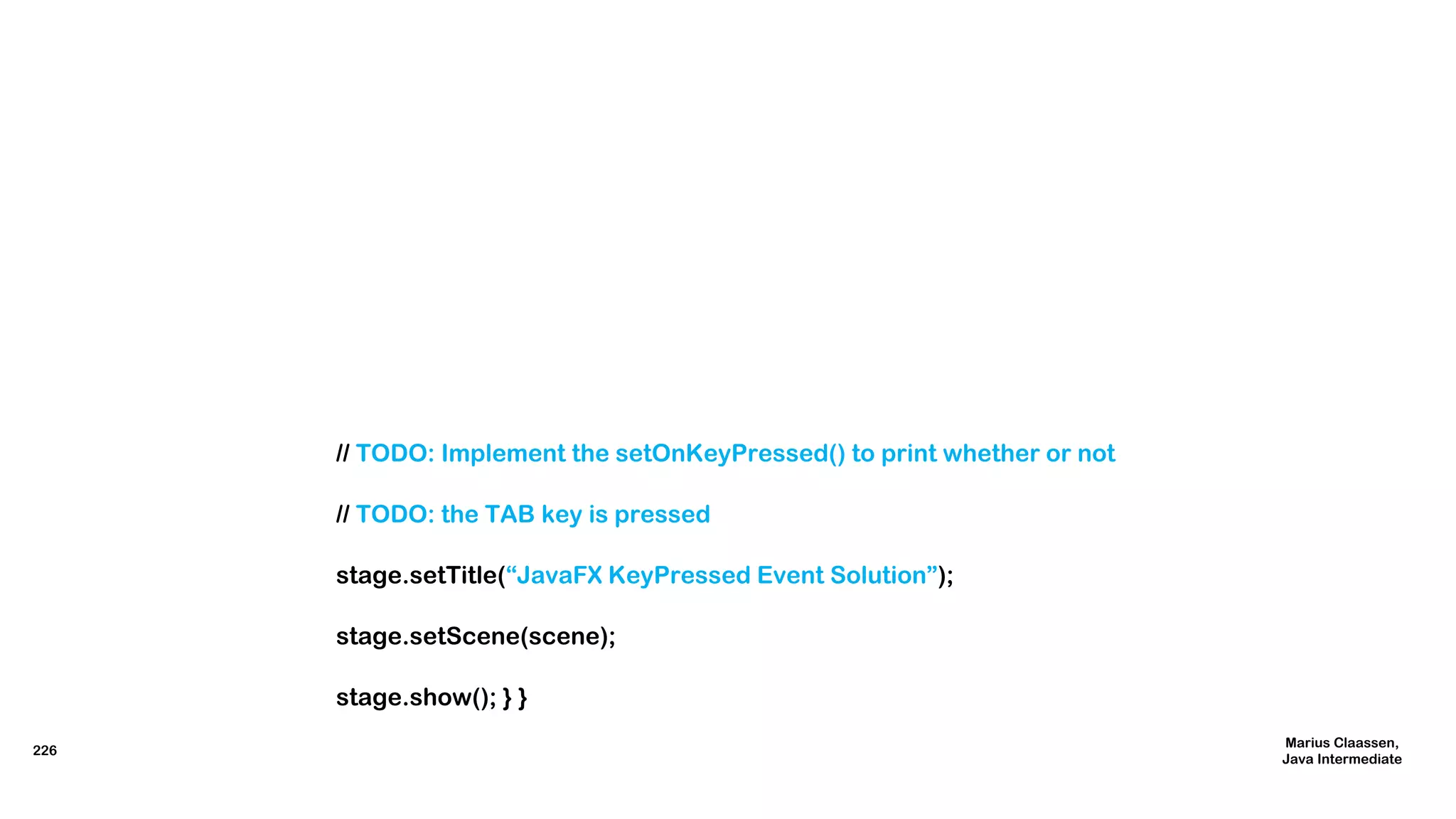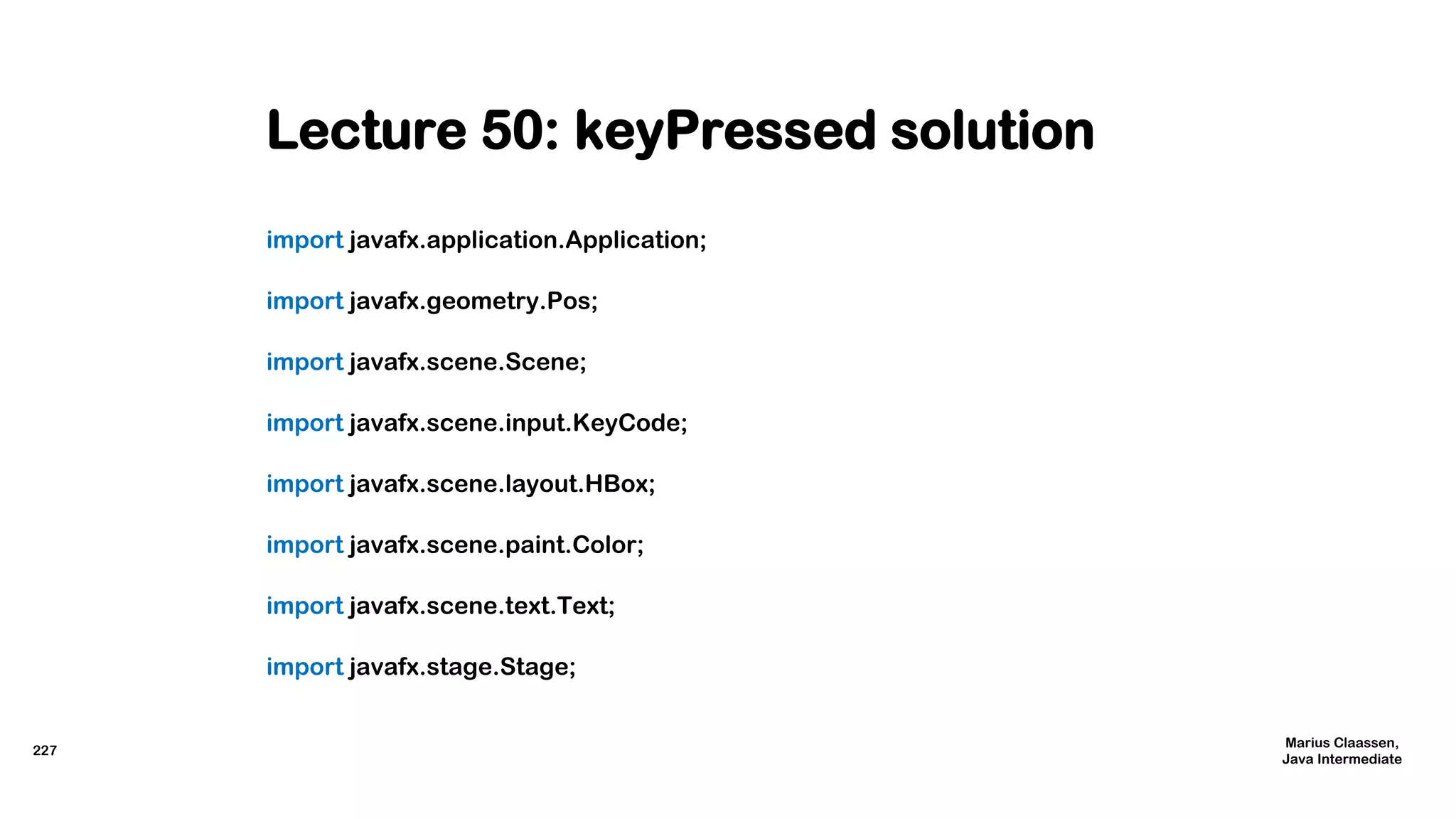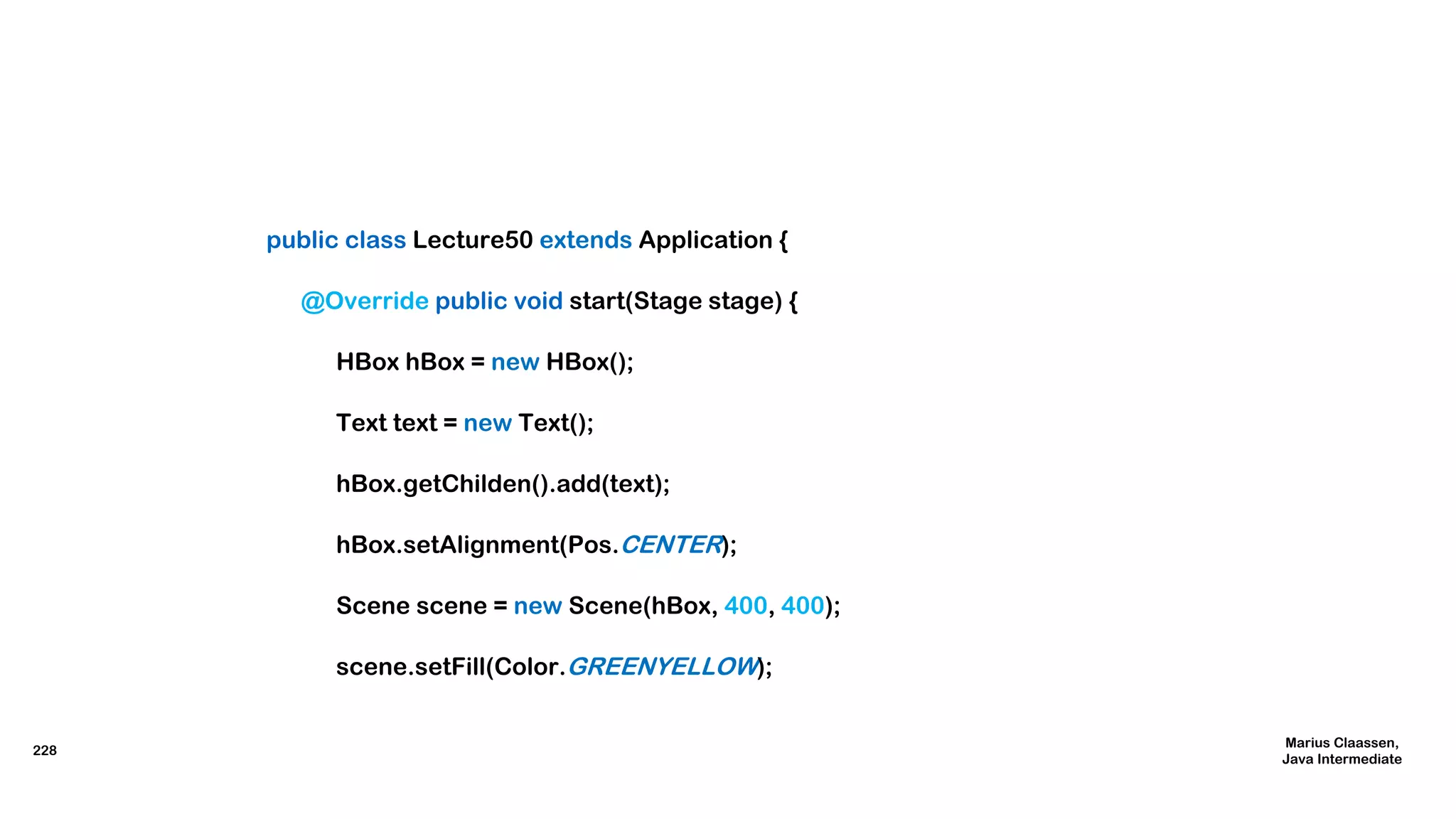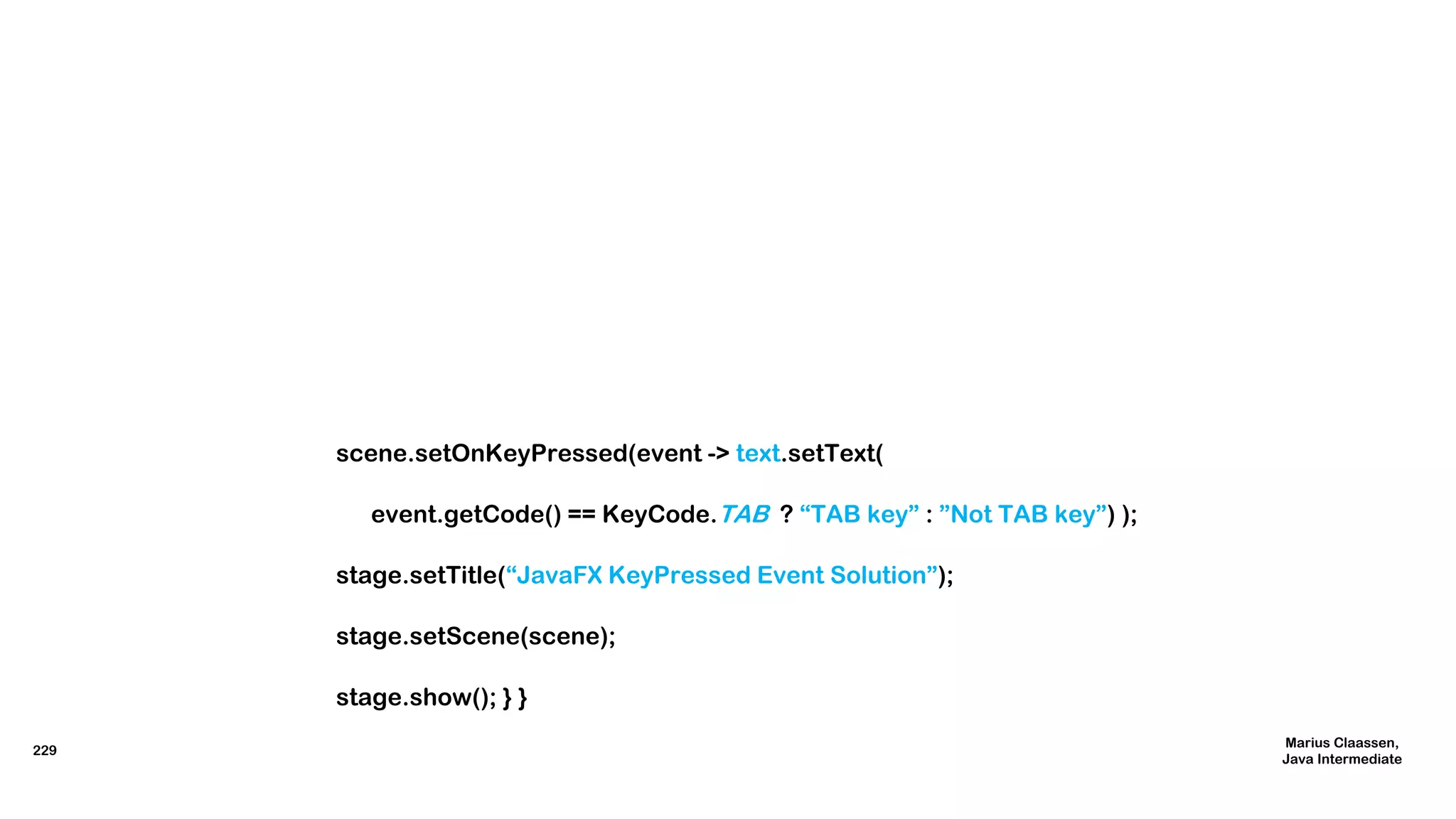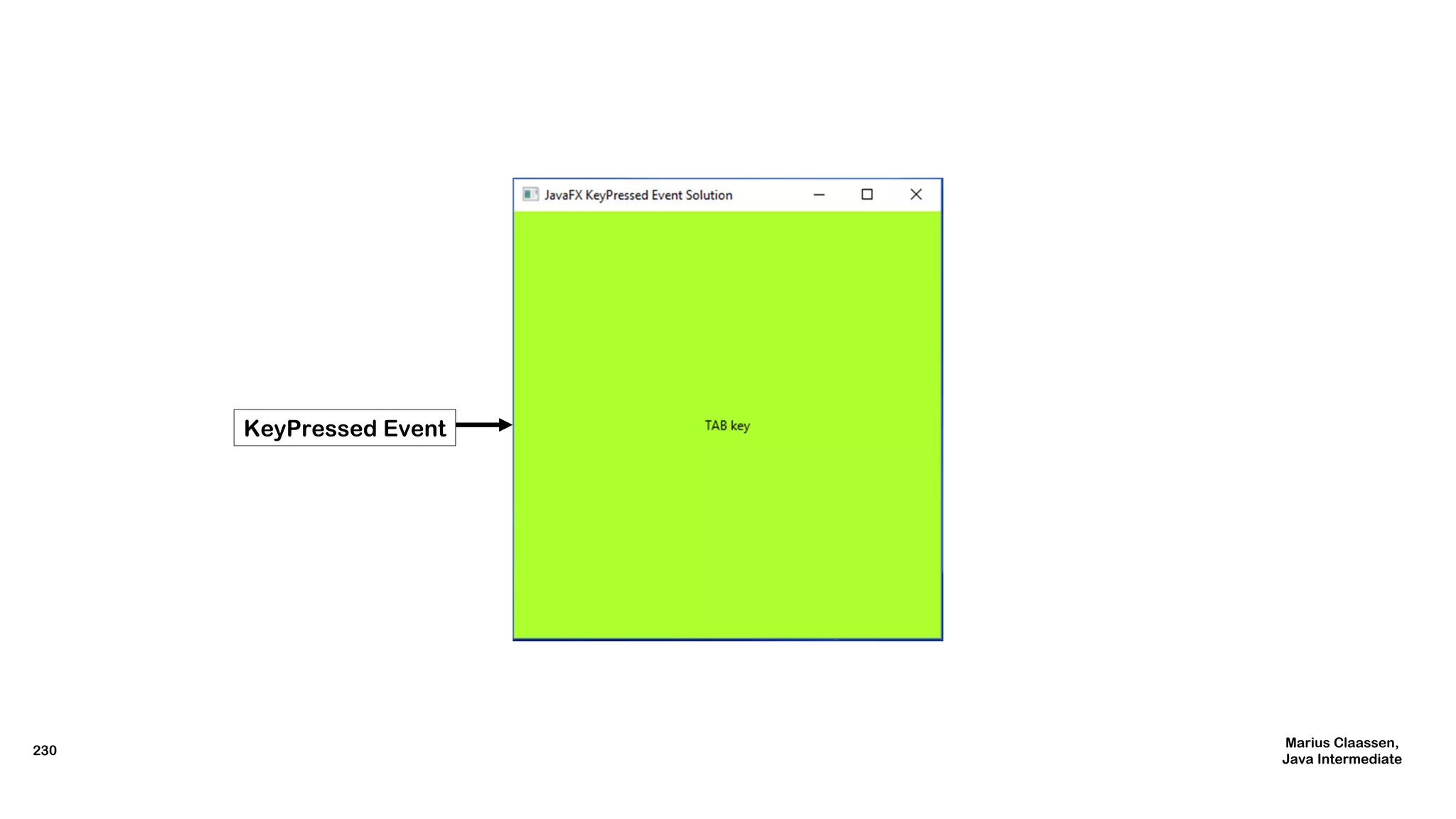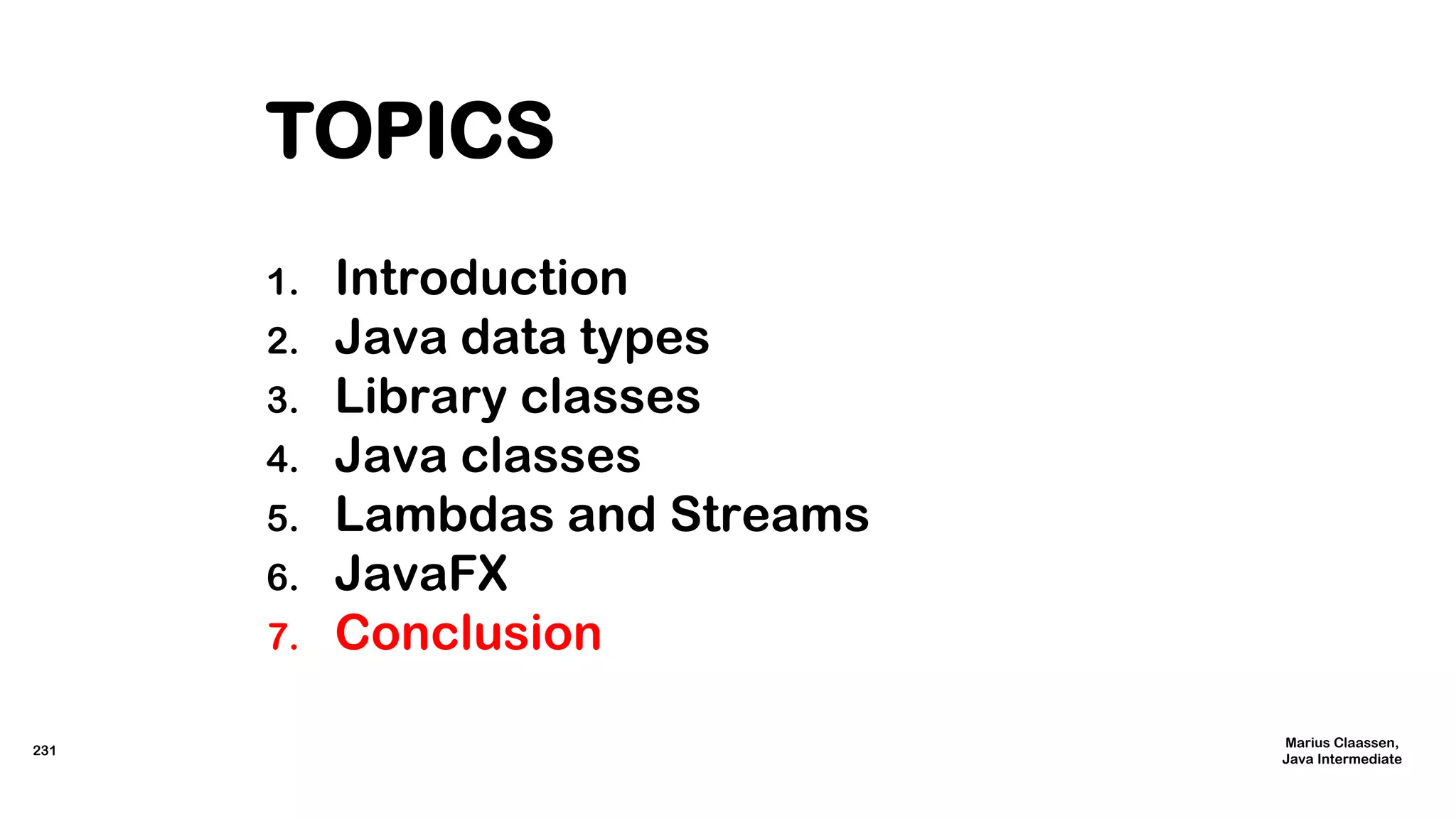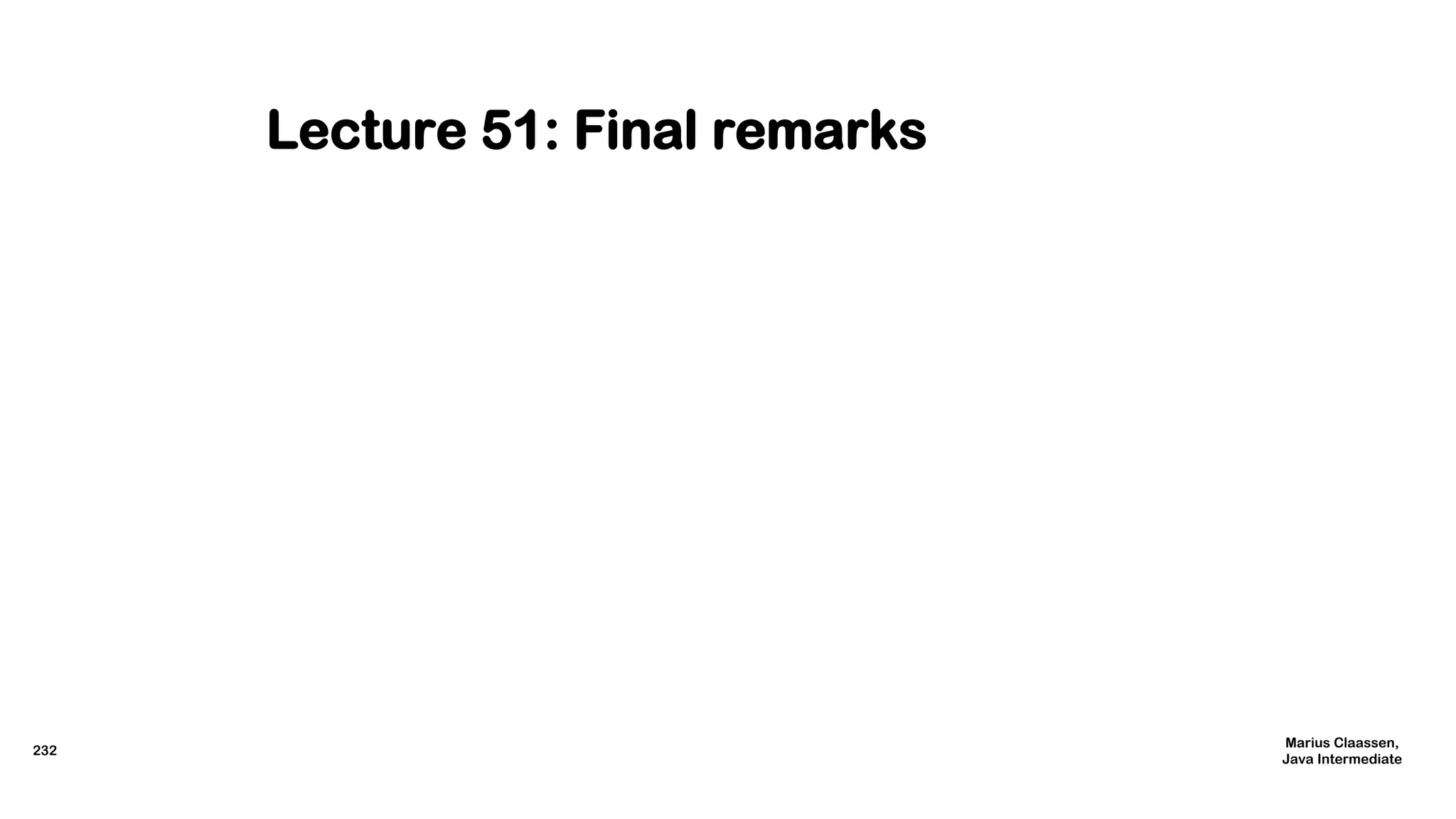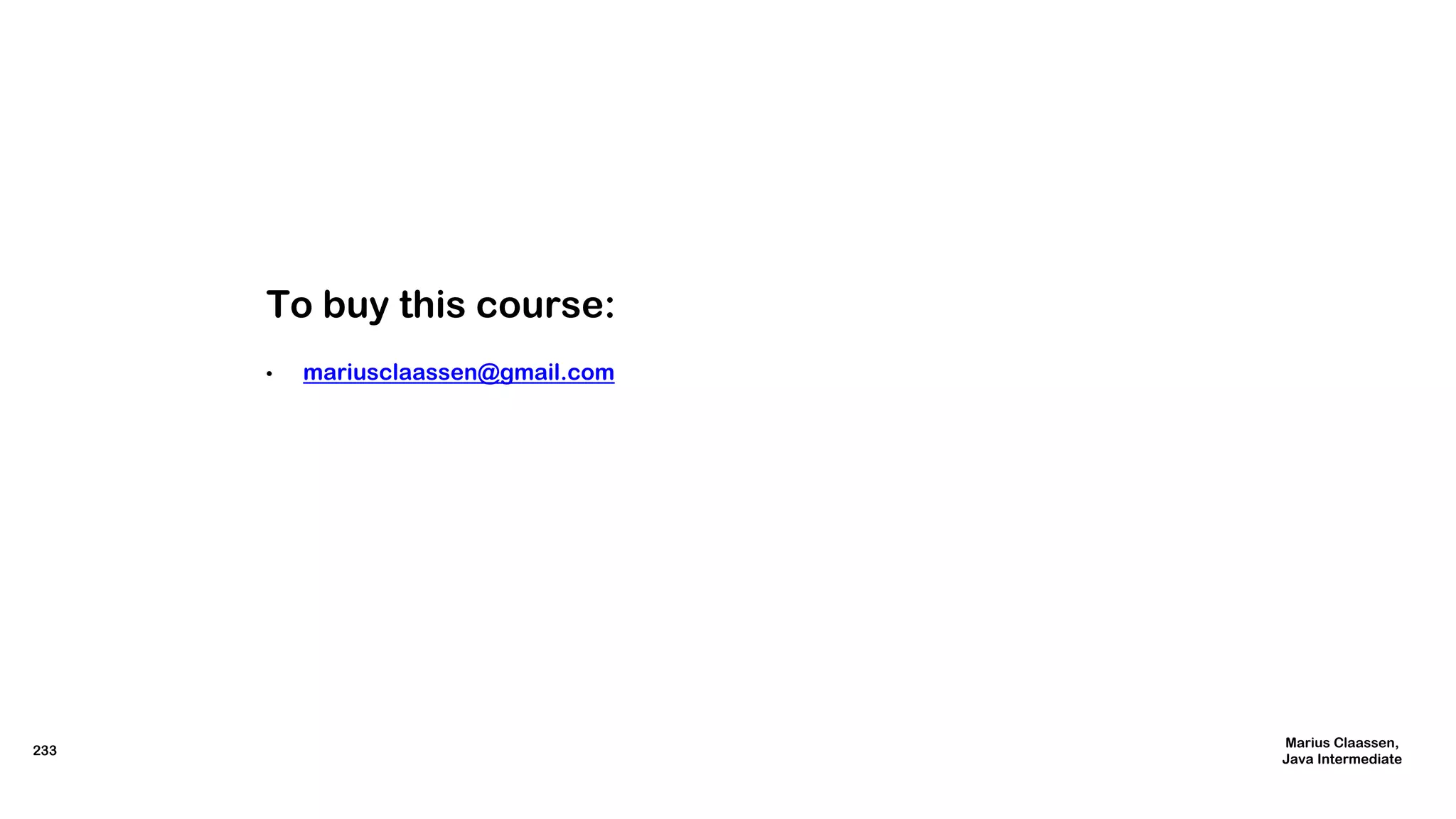This document outlines a Java course for intermediate users, taught by Marius Claassen, focusing on refining programming skills and building useful applications. It includes an extensive lecture outline covering topics such as Java data types, library classes, and practical coding exercises. The course is designed for individuals who have completed a beginner Java course and aims to enhance their coding proficiency through hands-on experience.
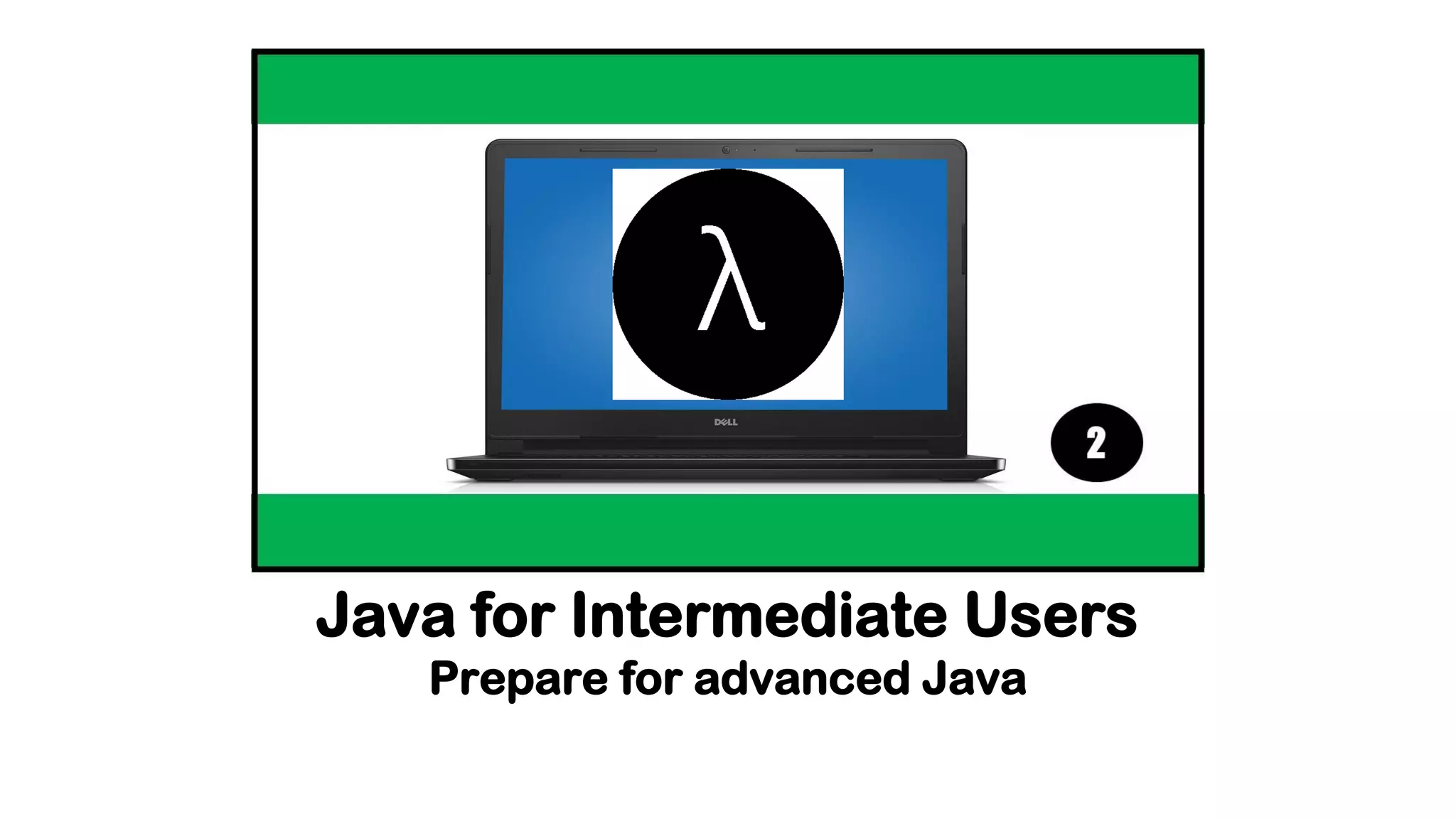
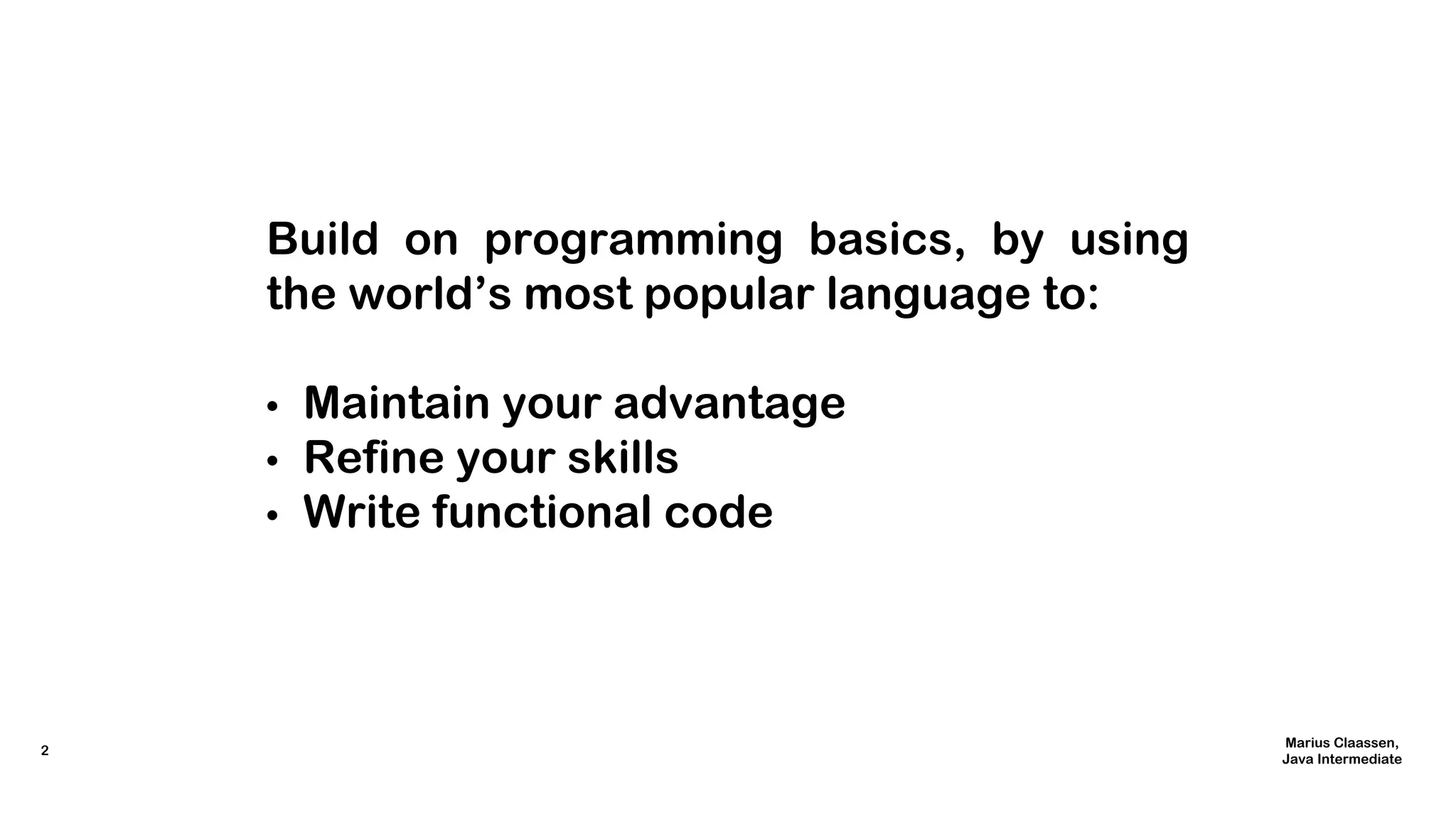
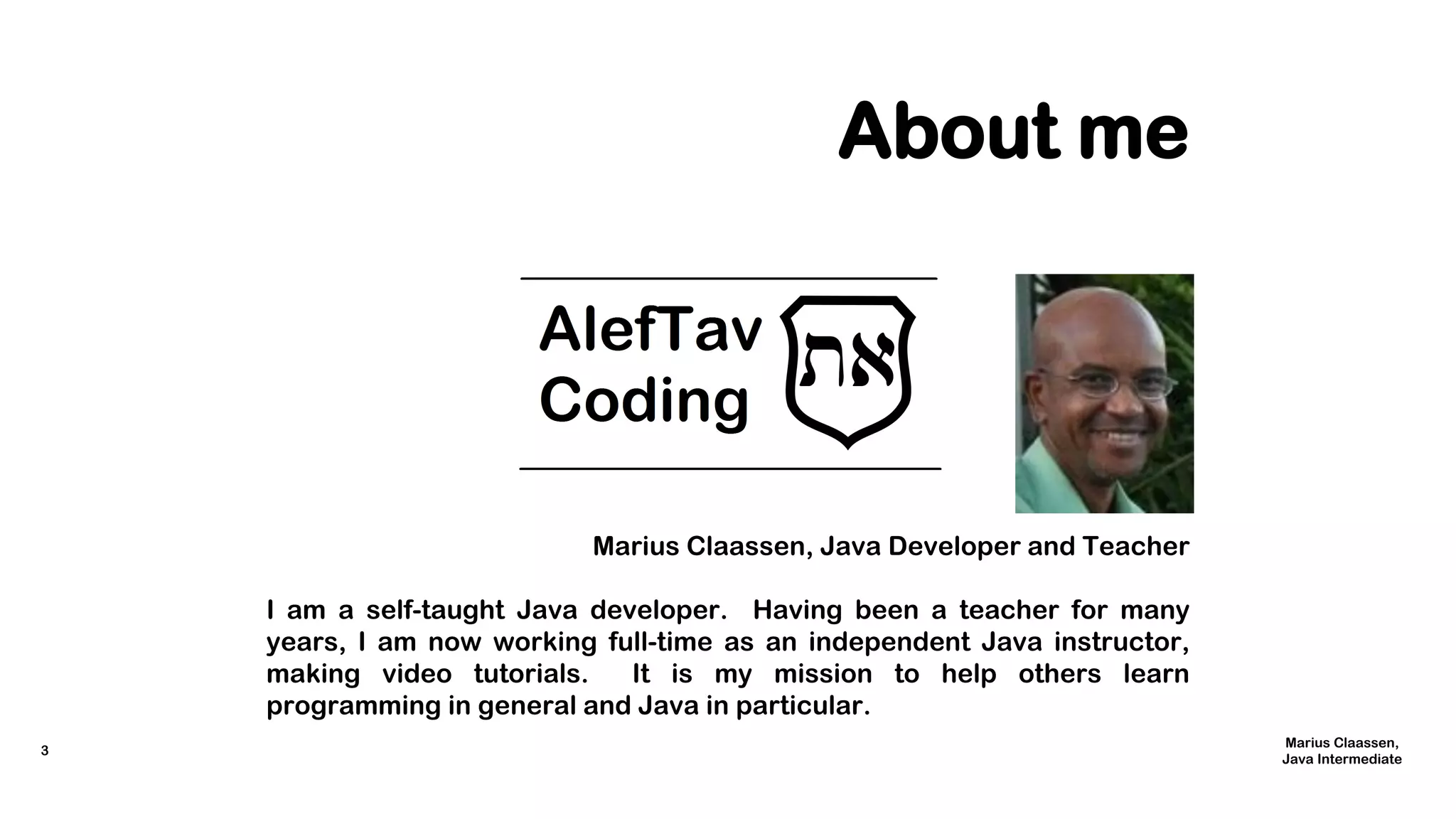
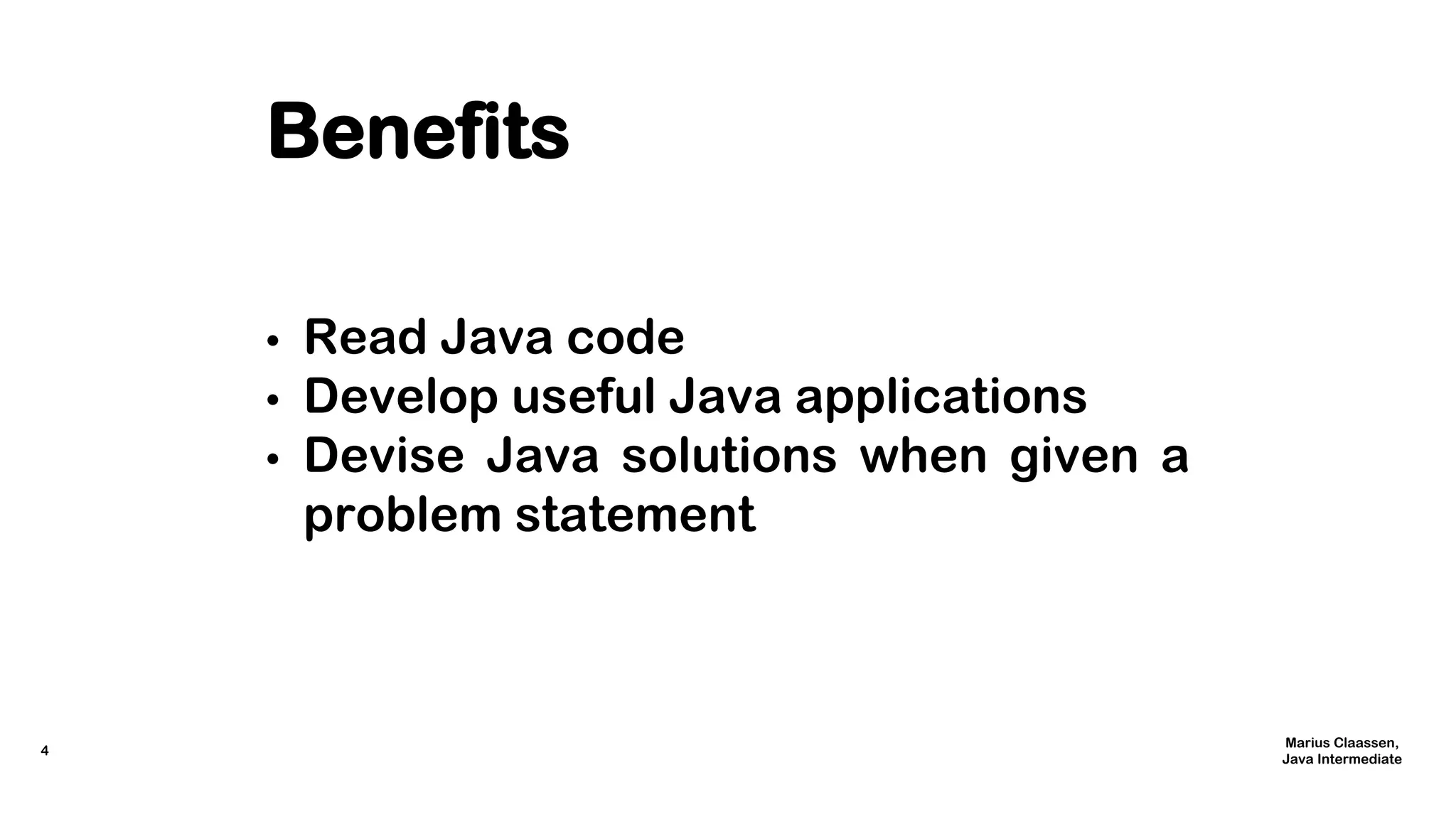
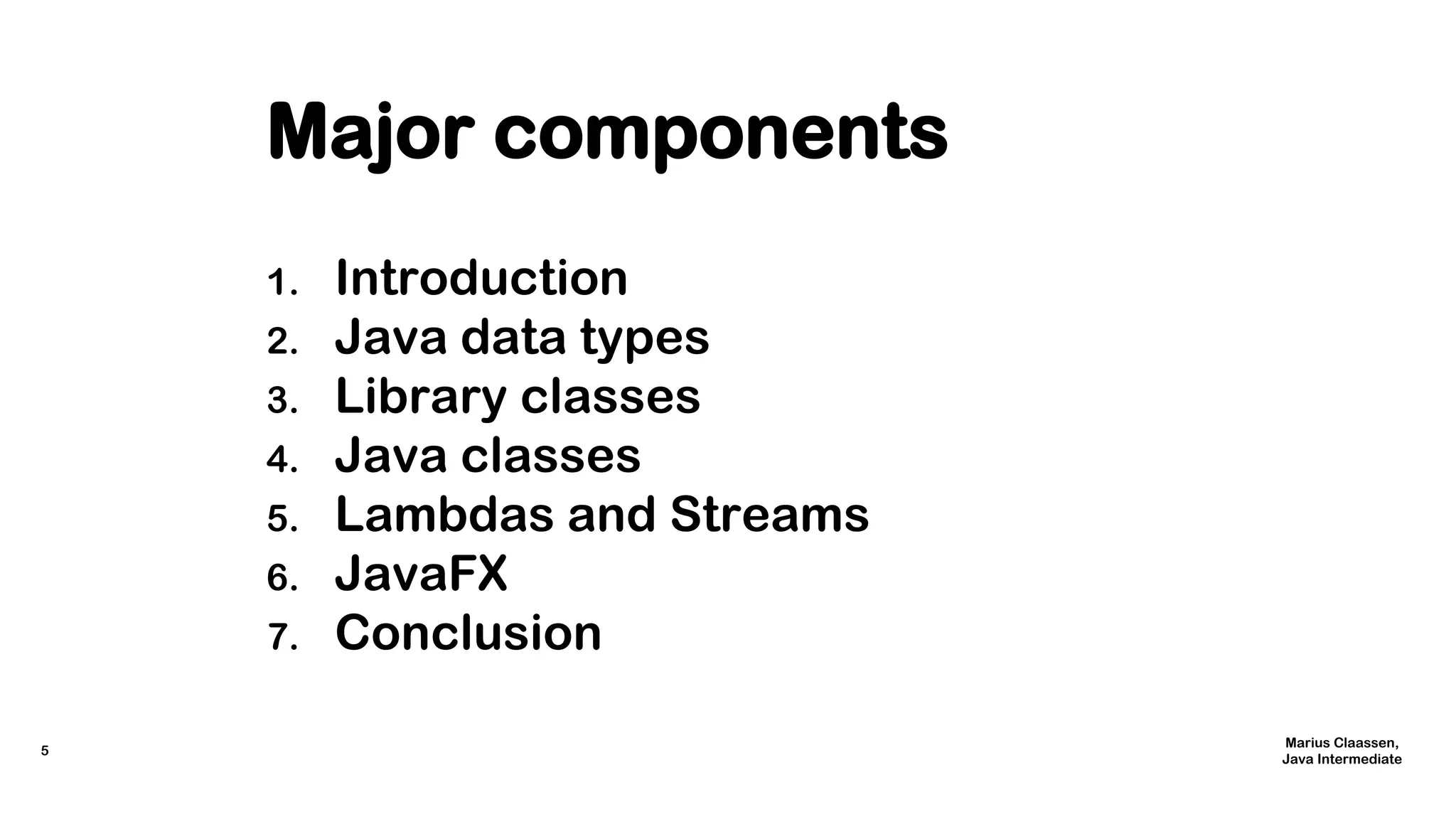
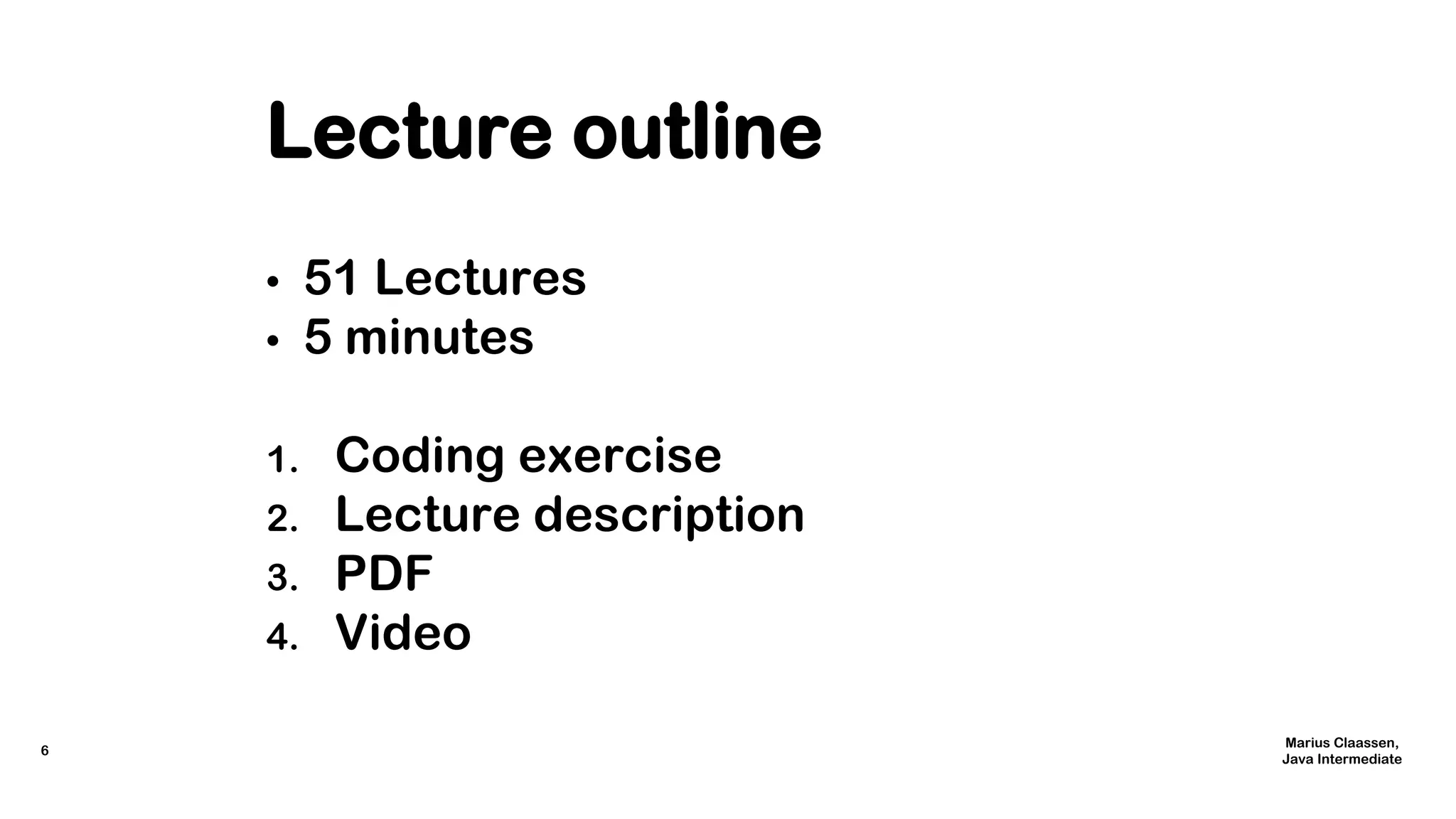
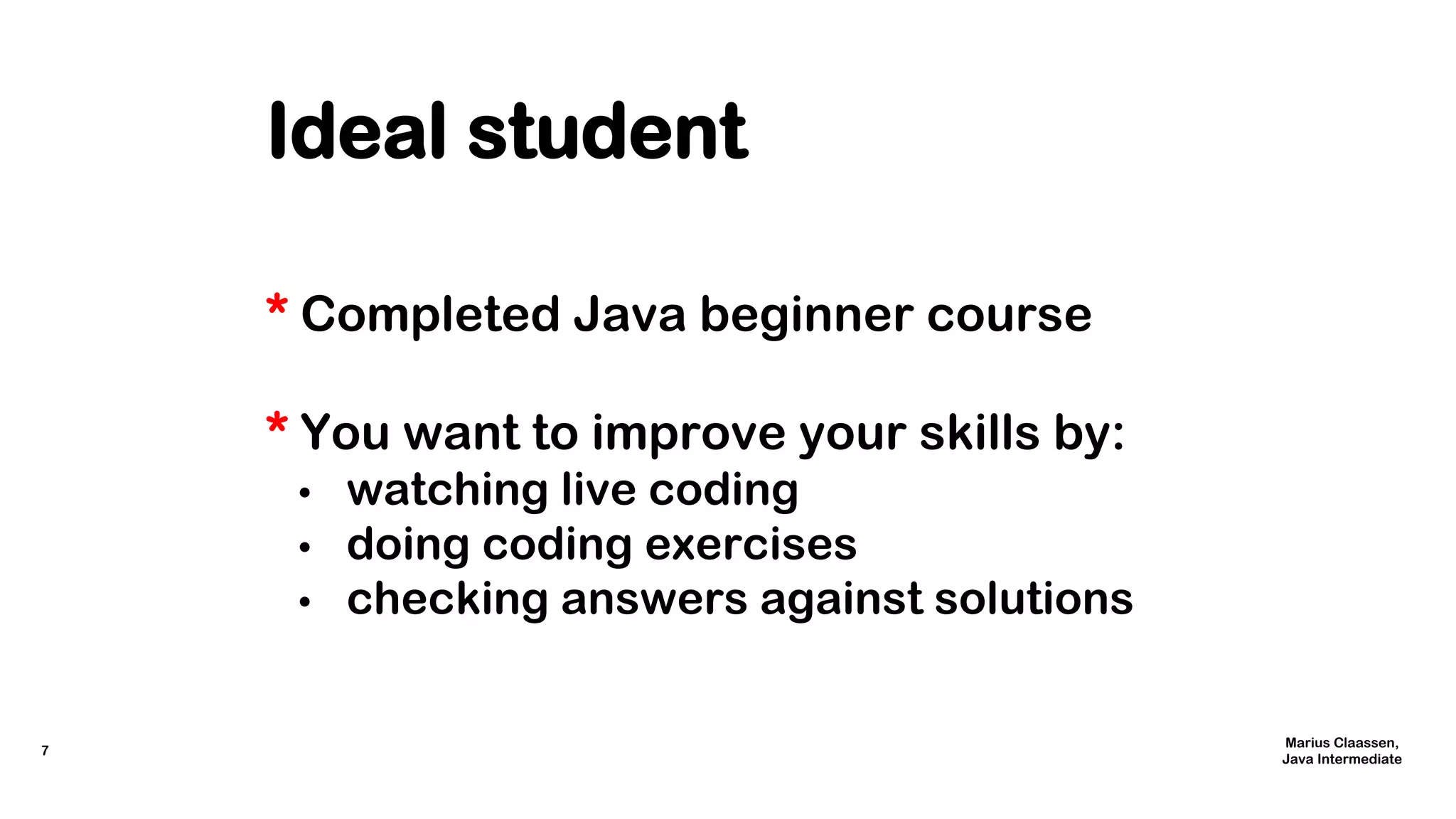
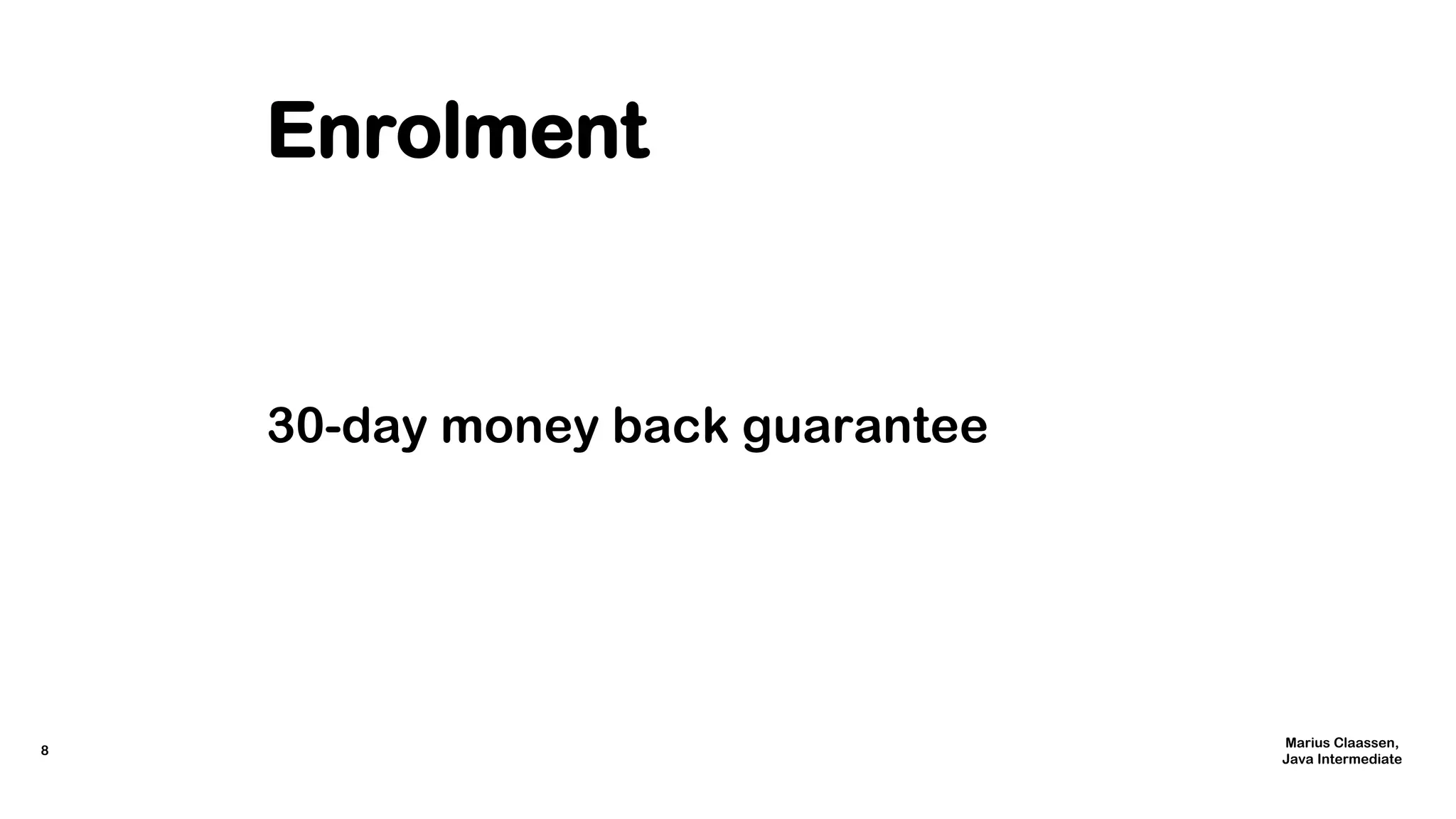
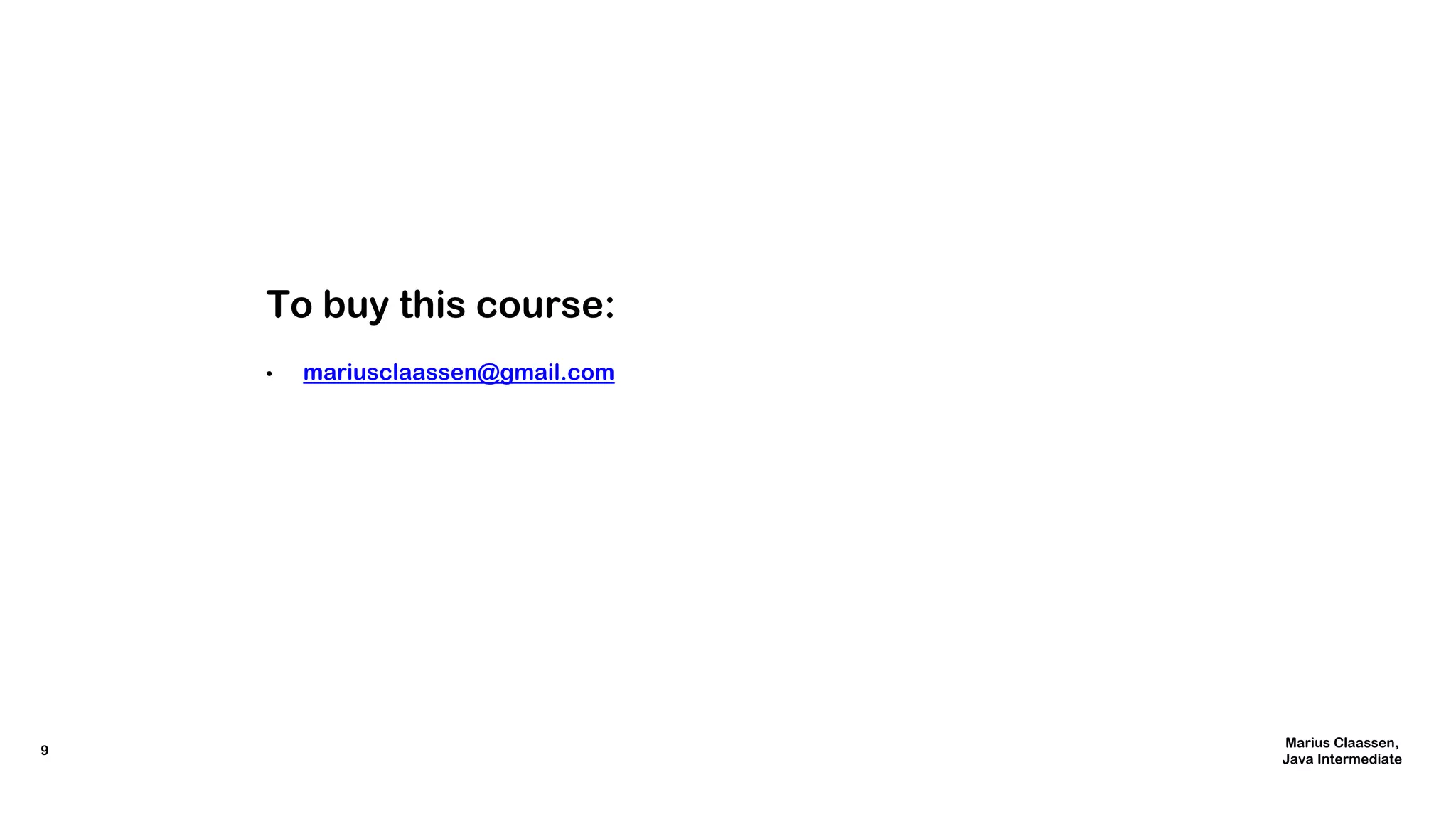
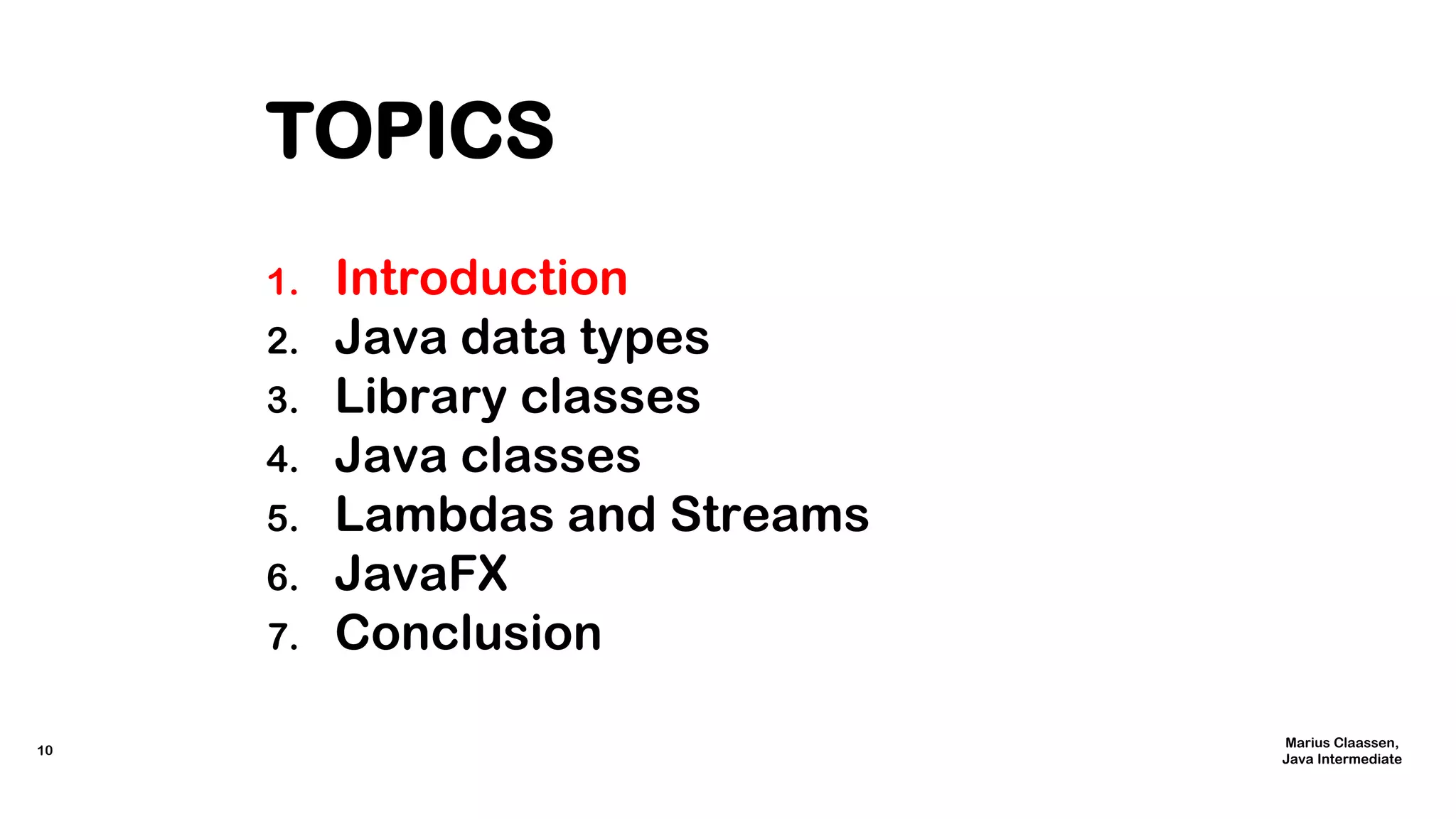
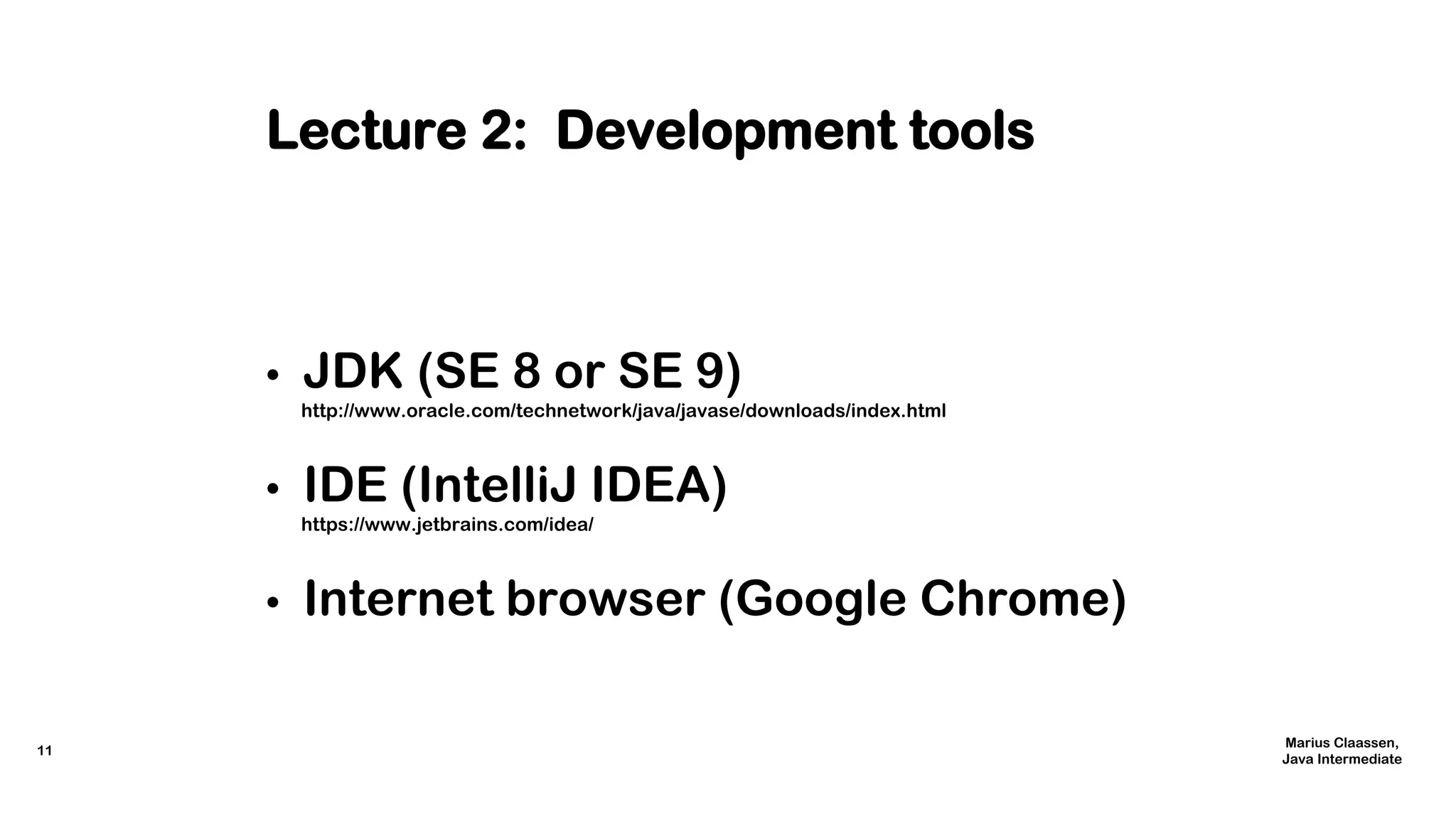
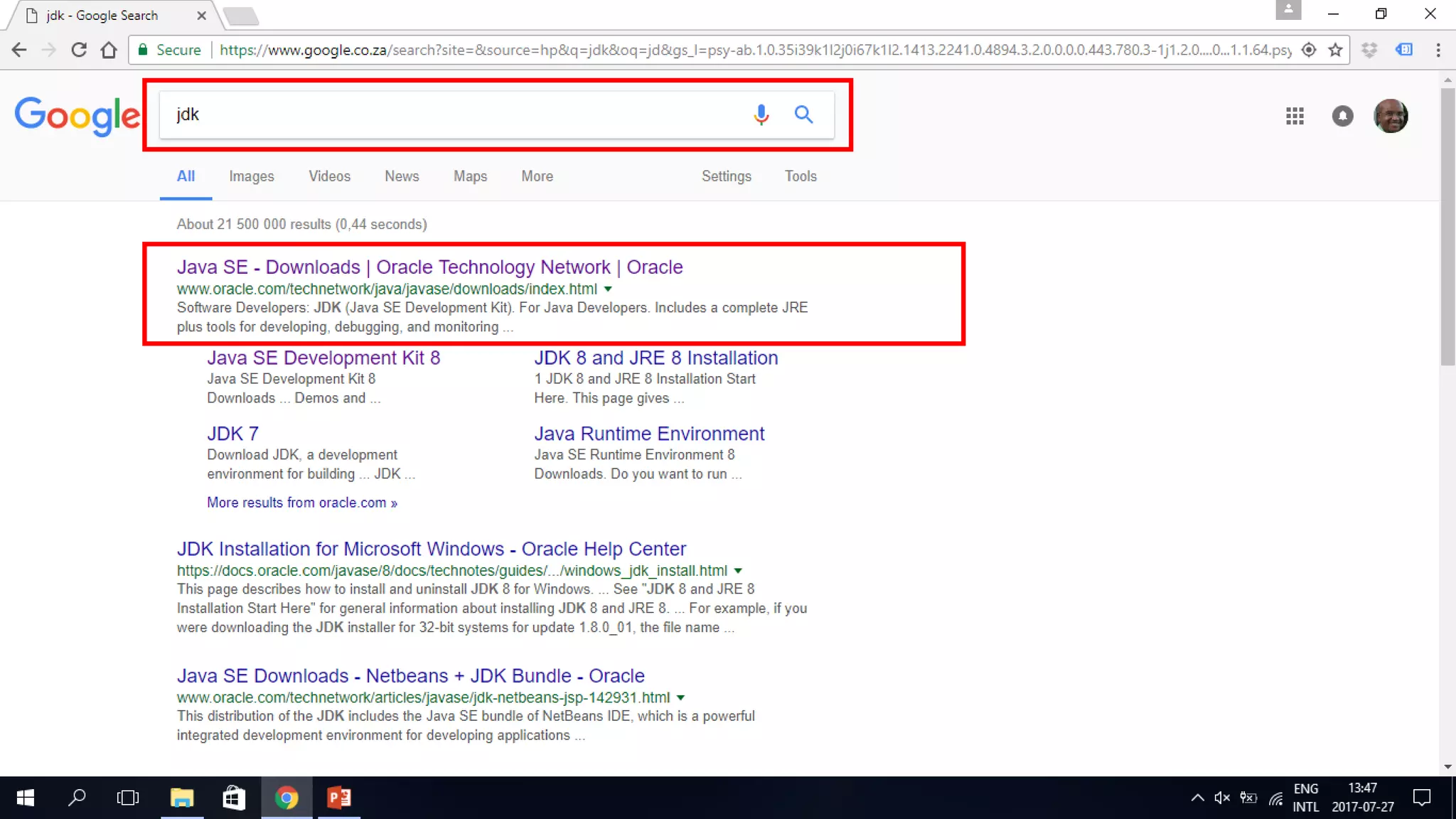
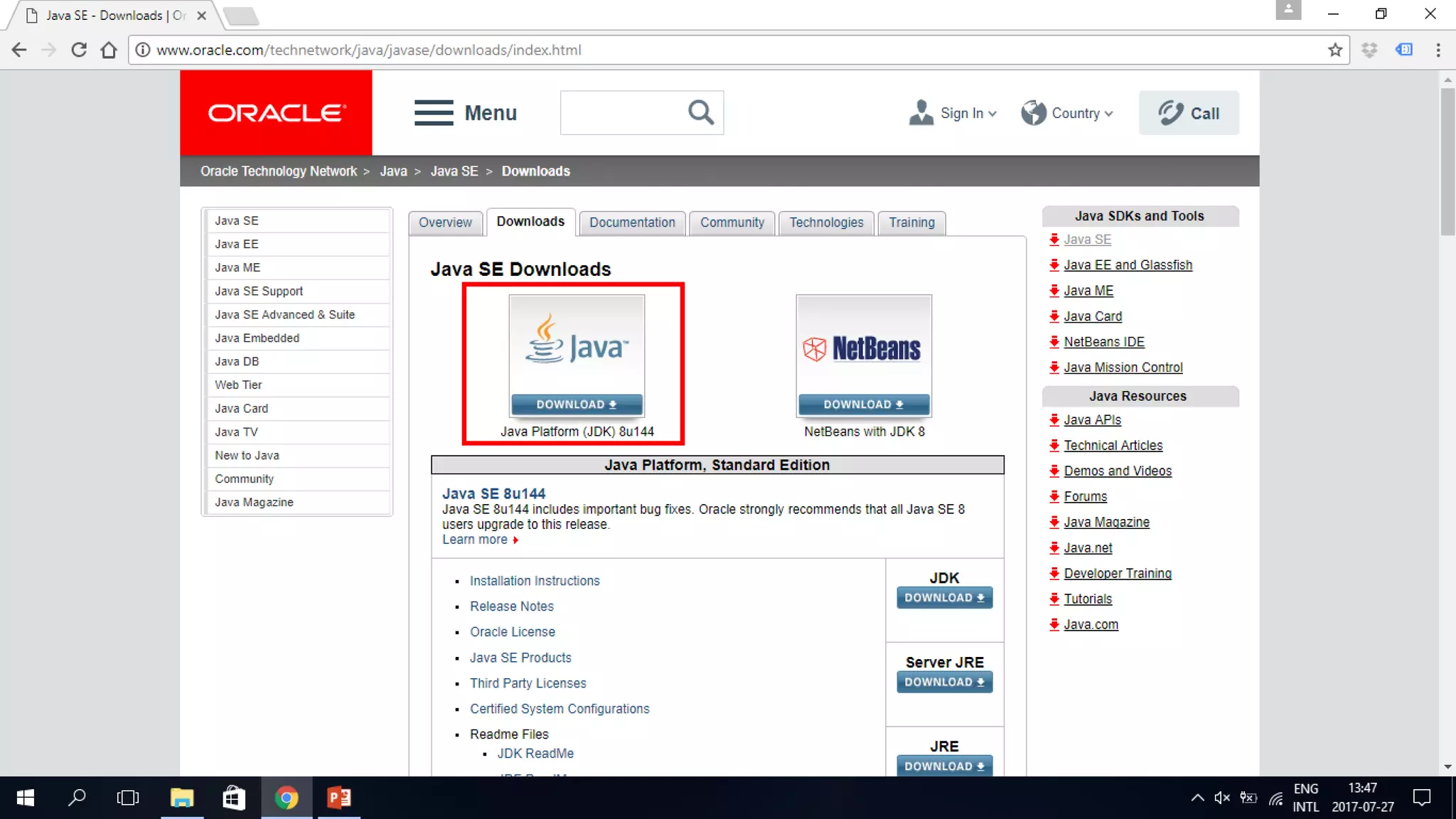
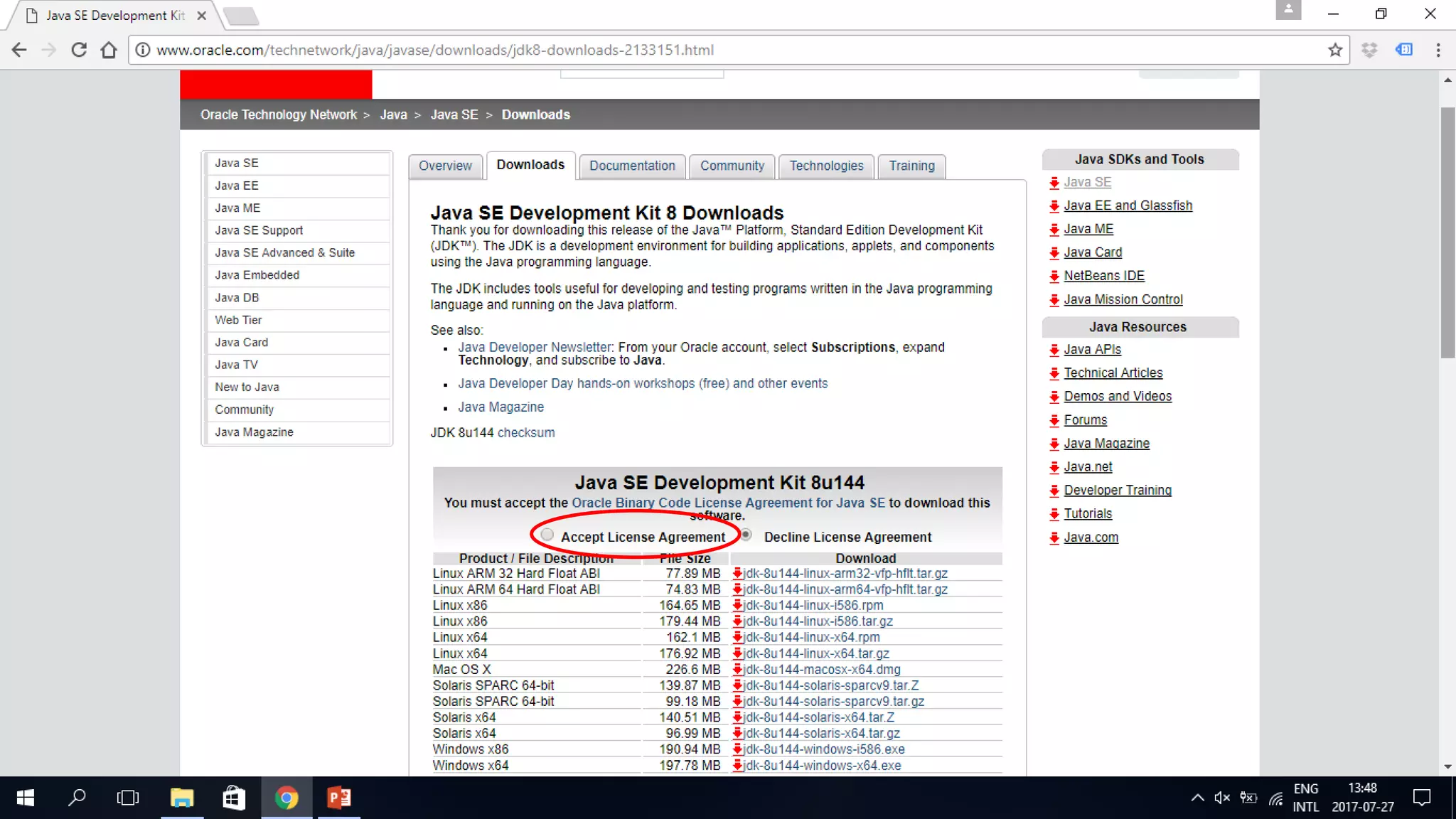
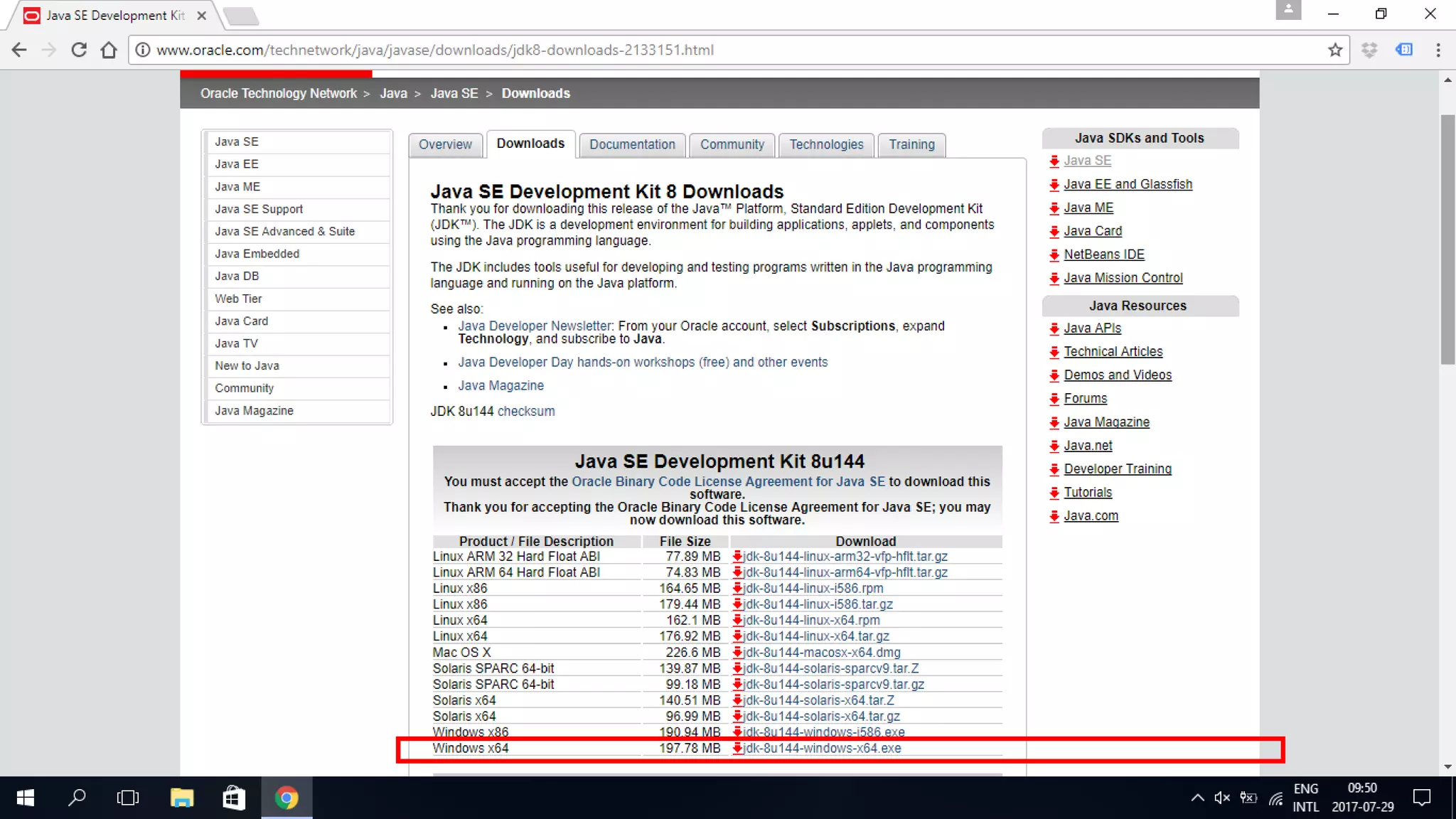
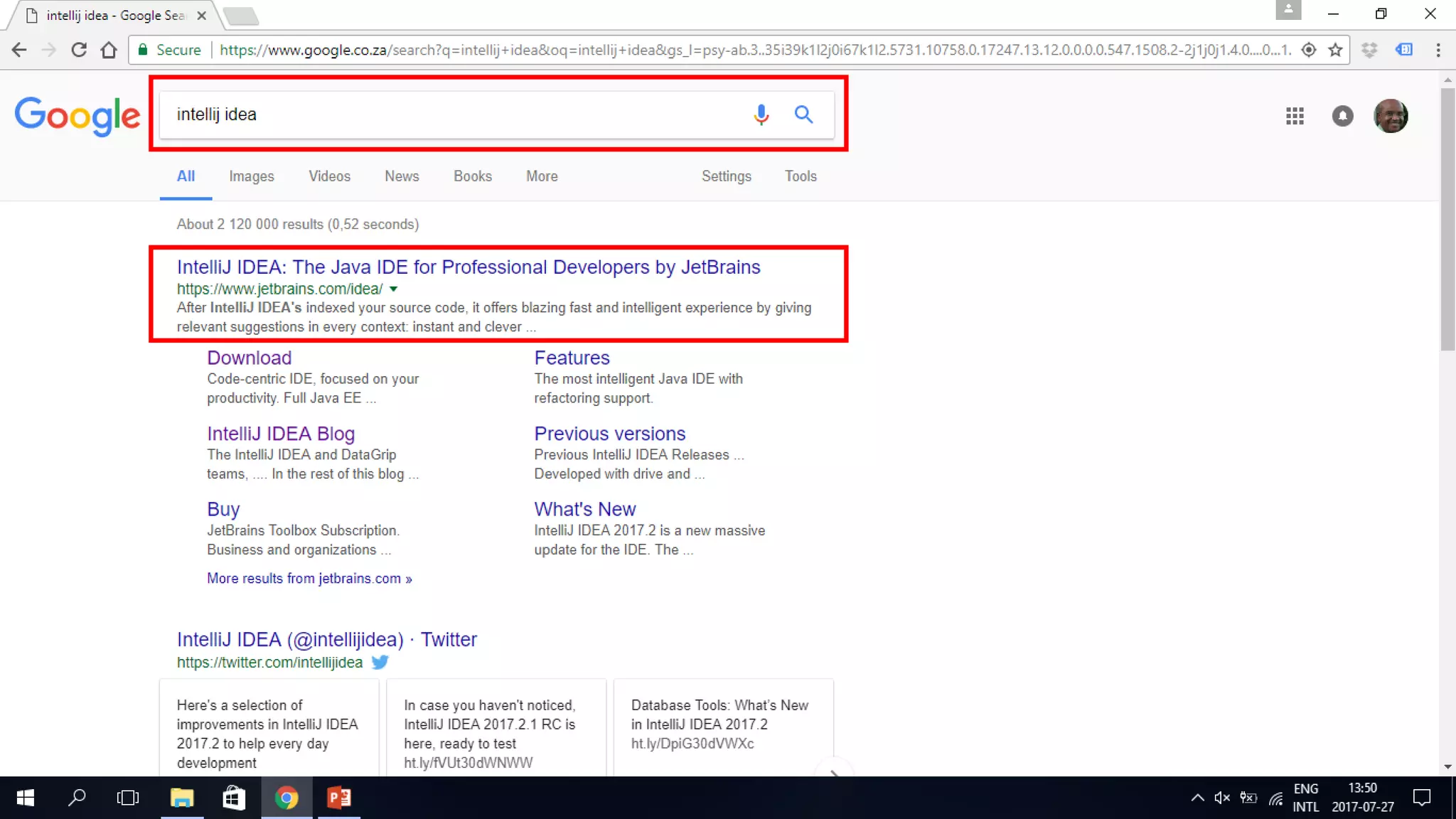
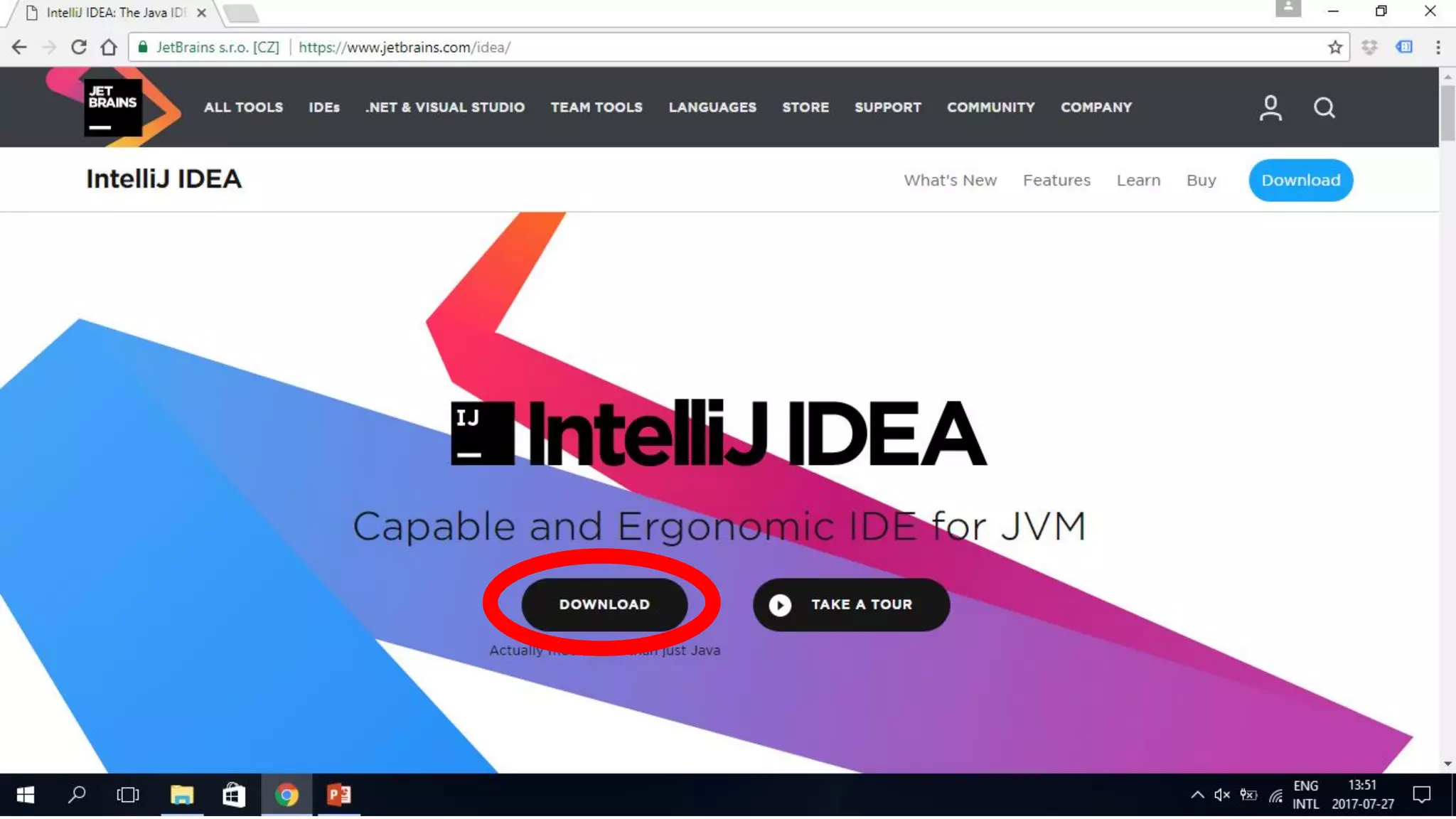
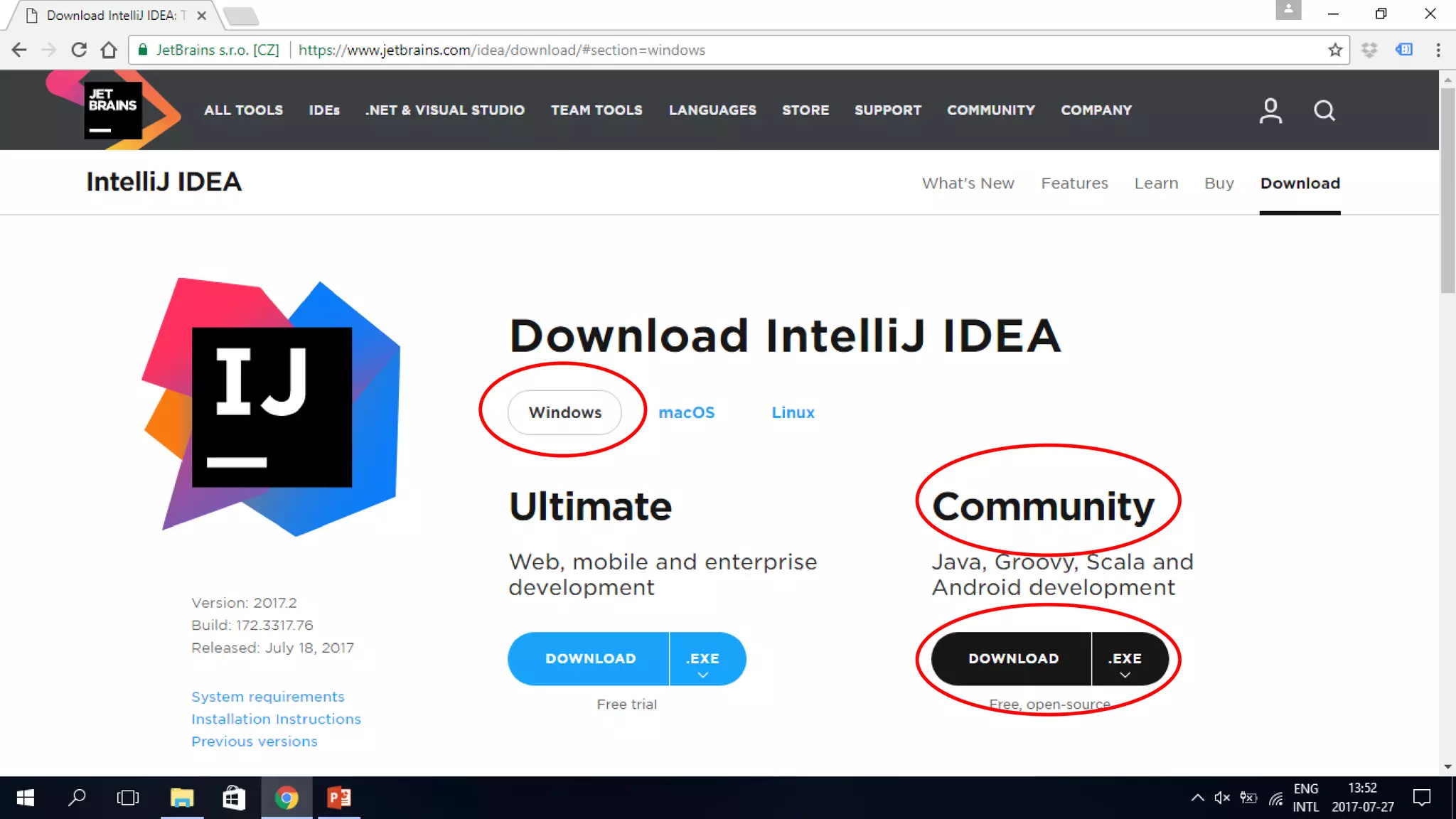
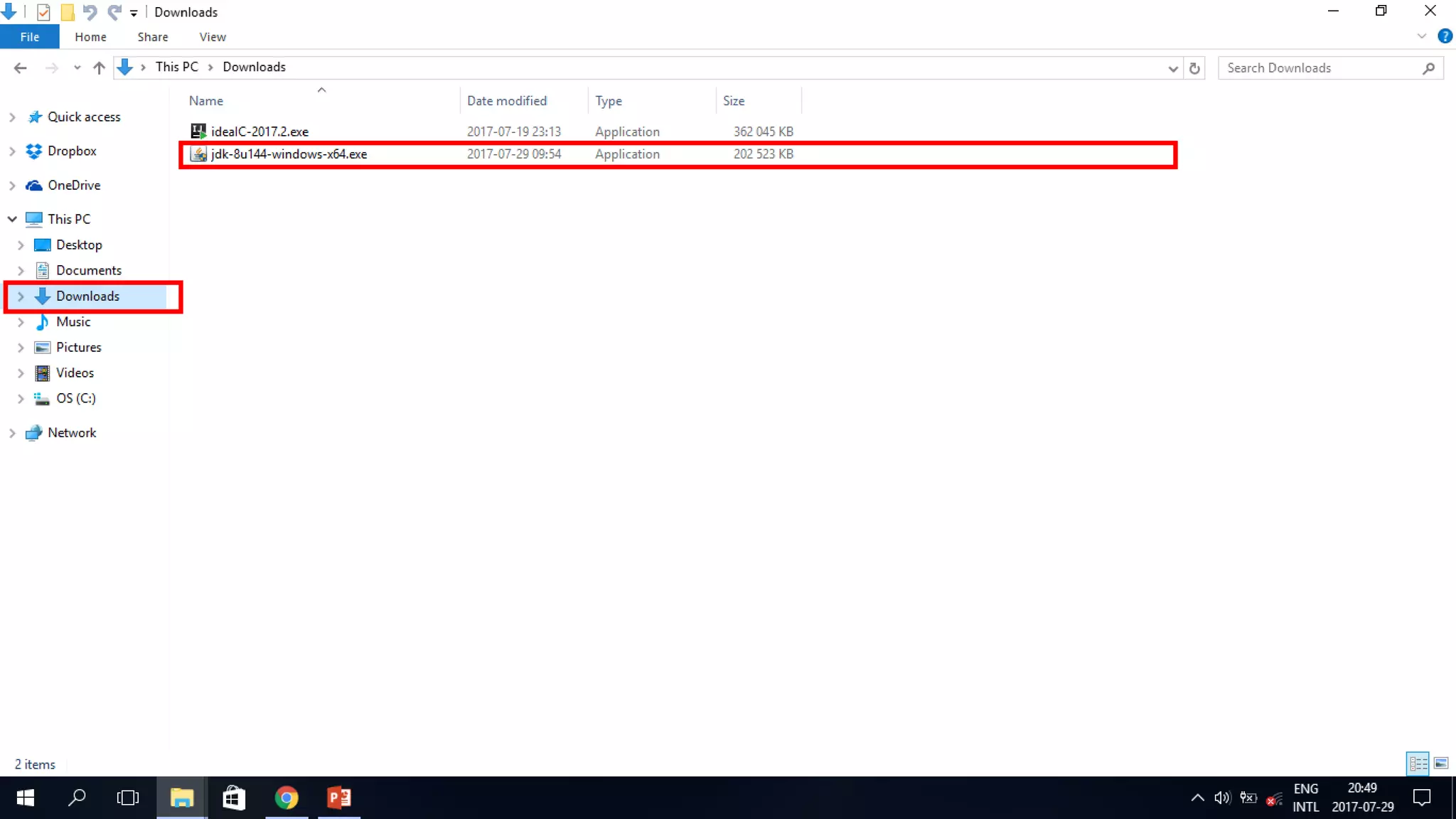
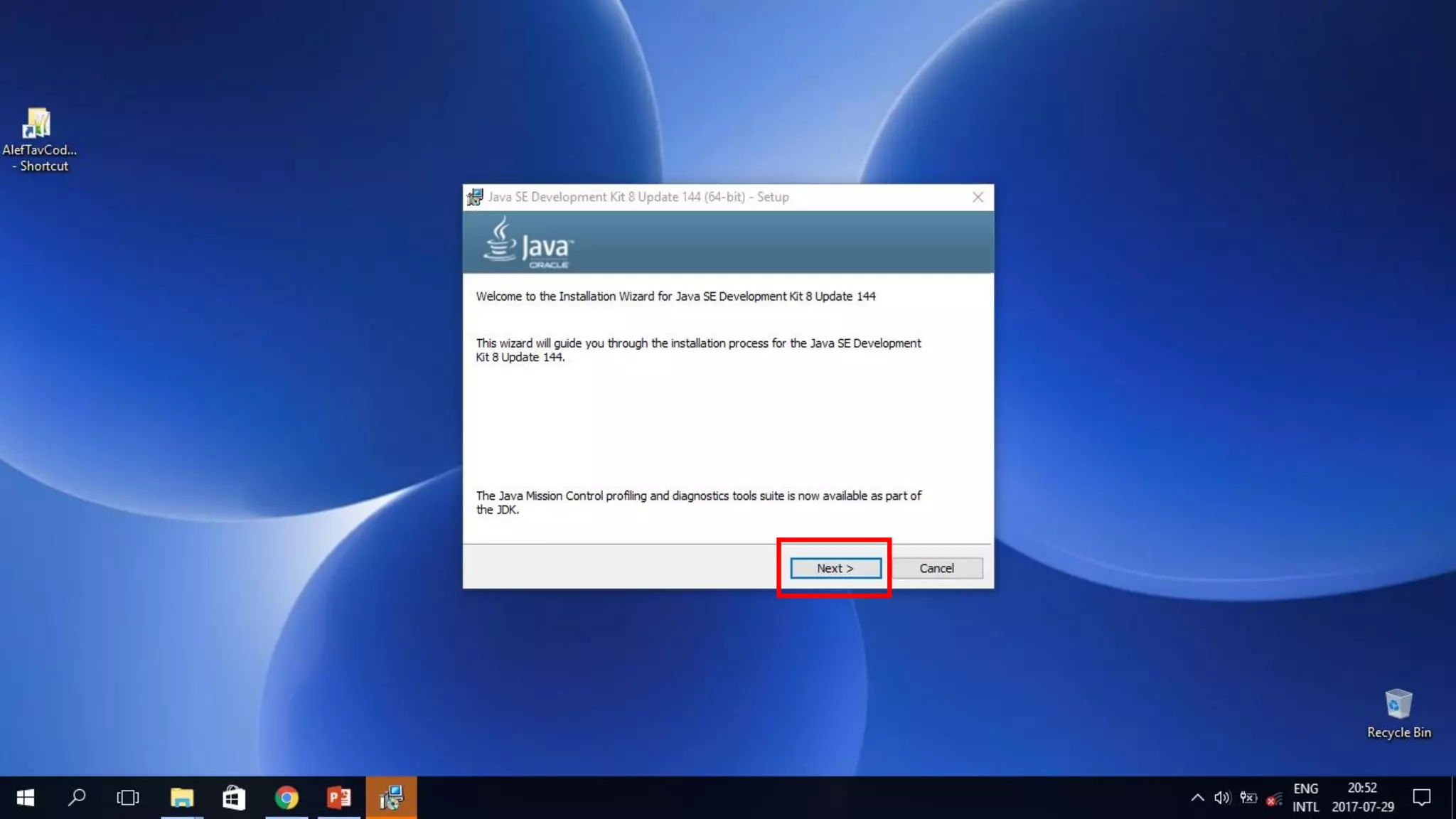
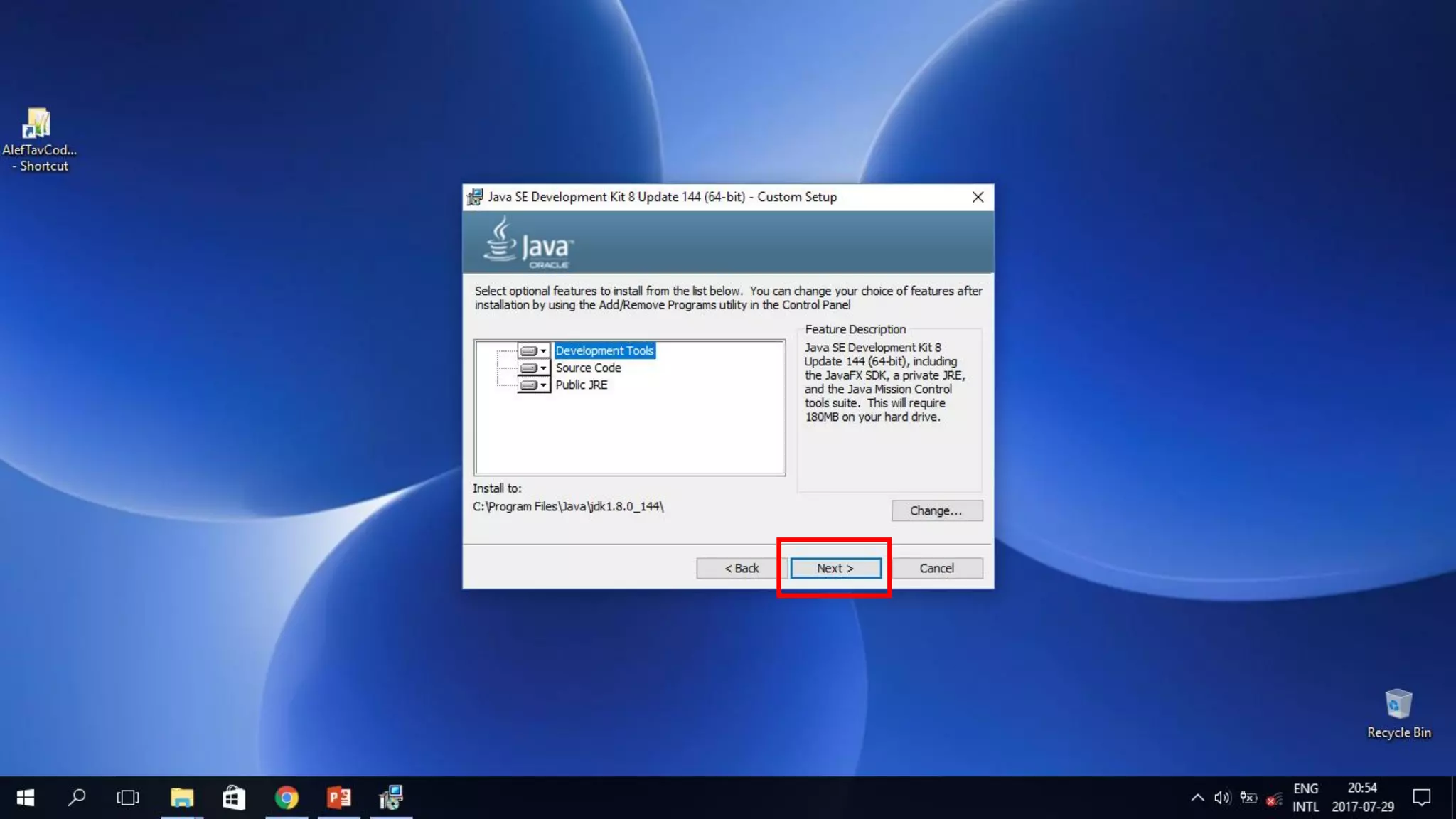
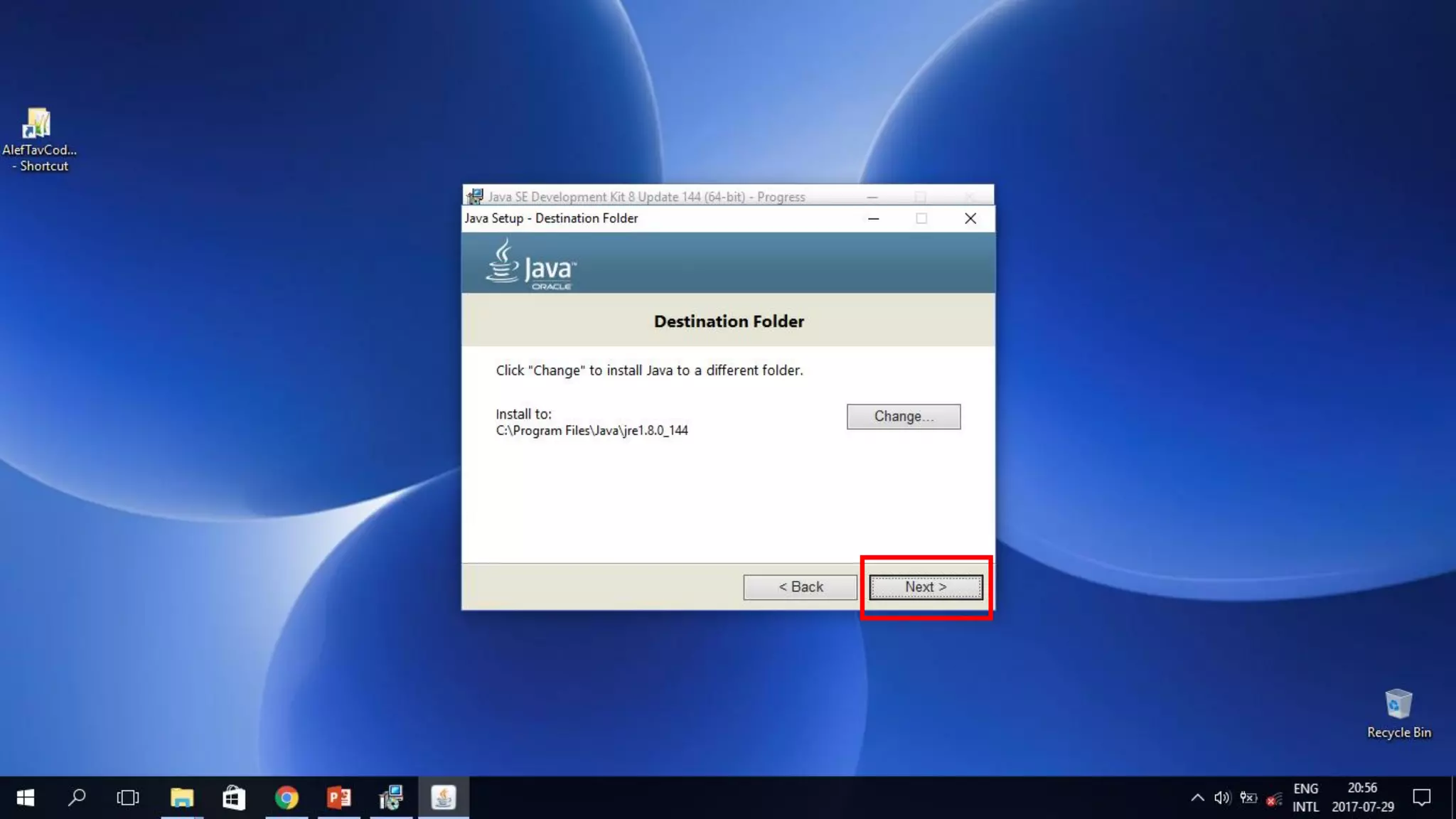
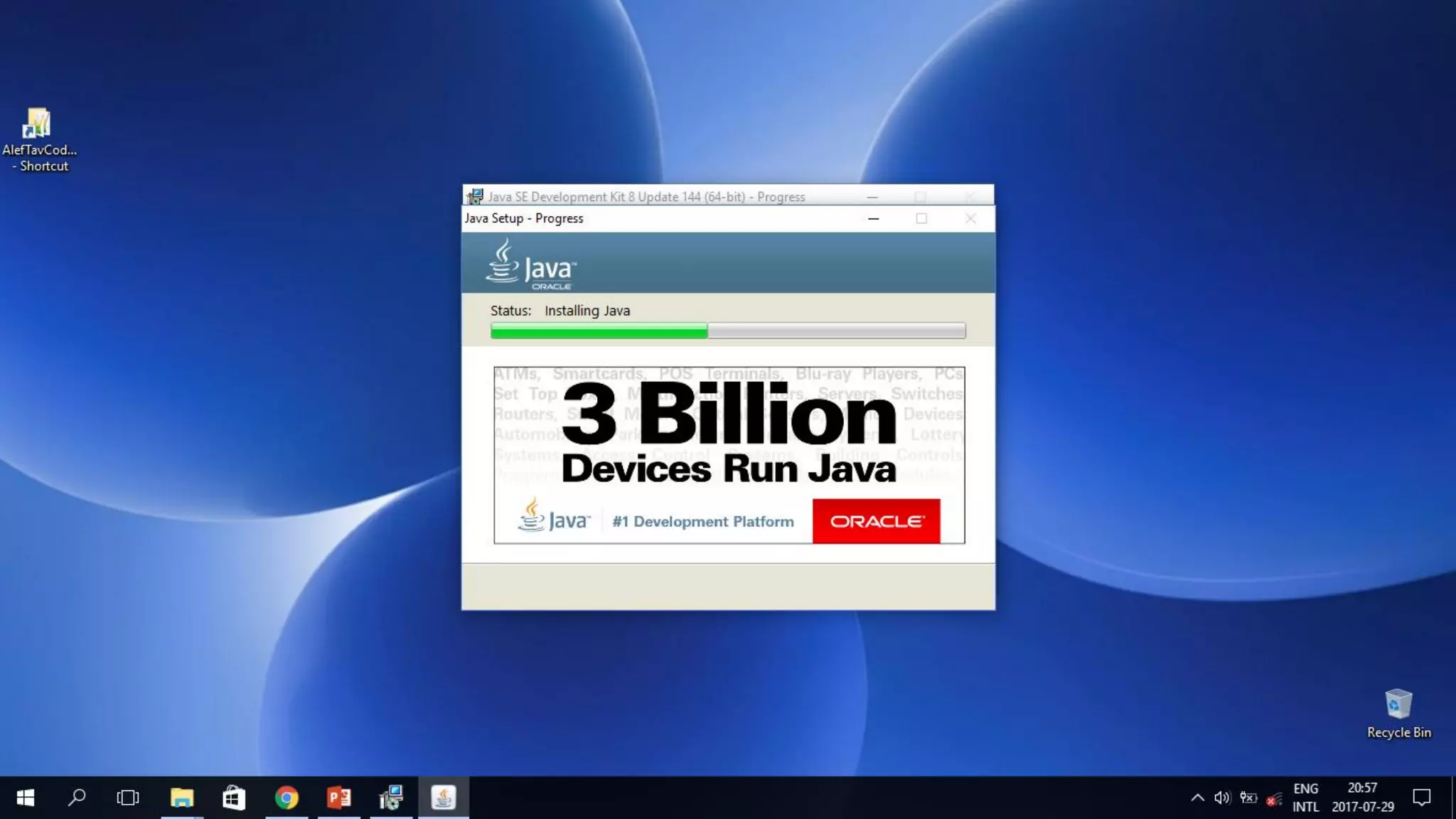
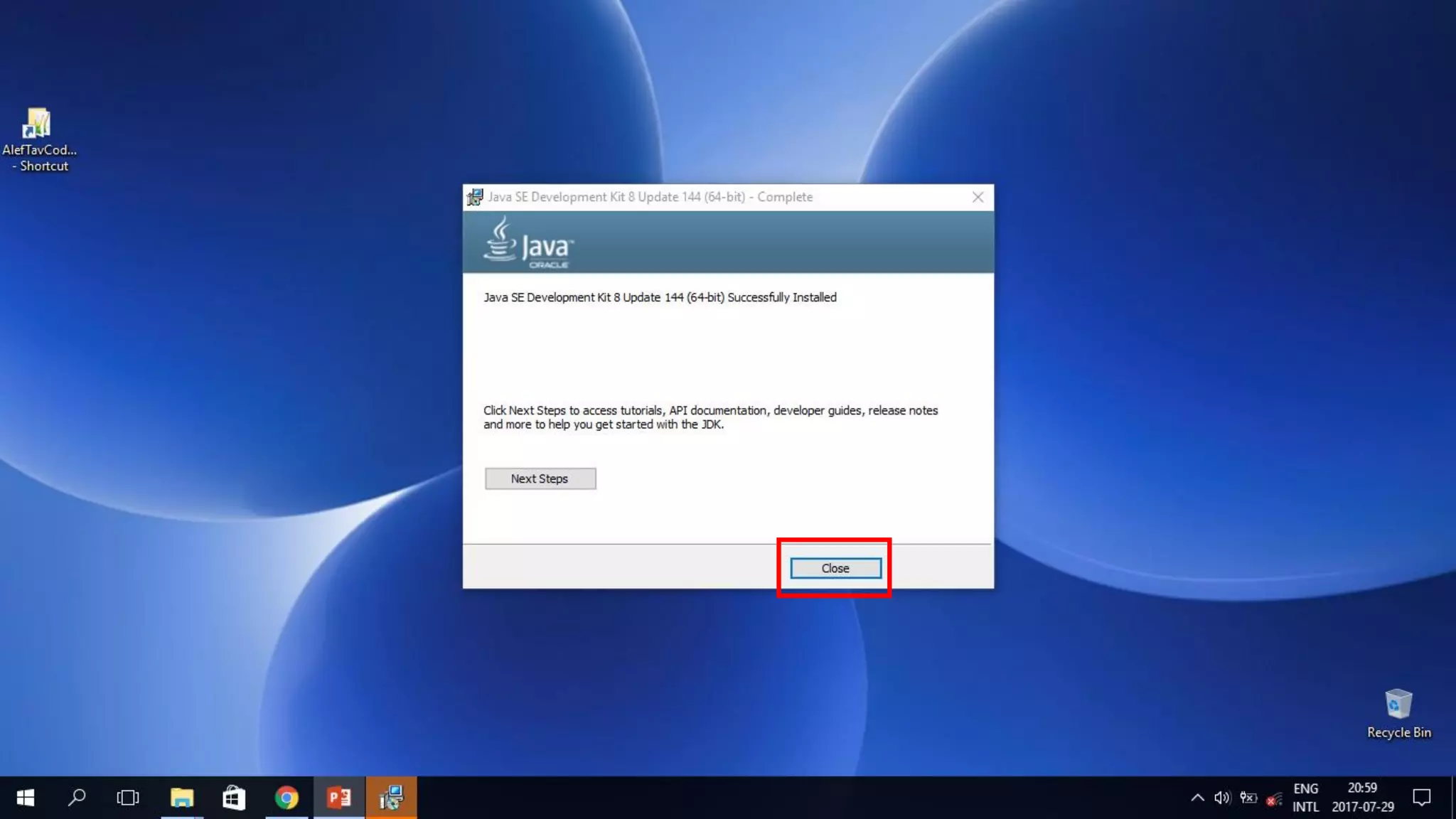
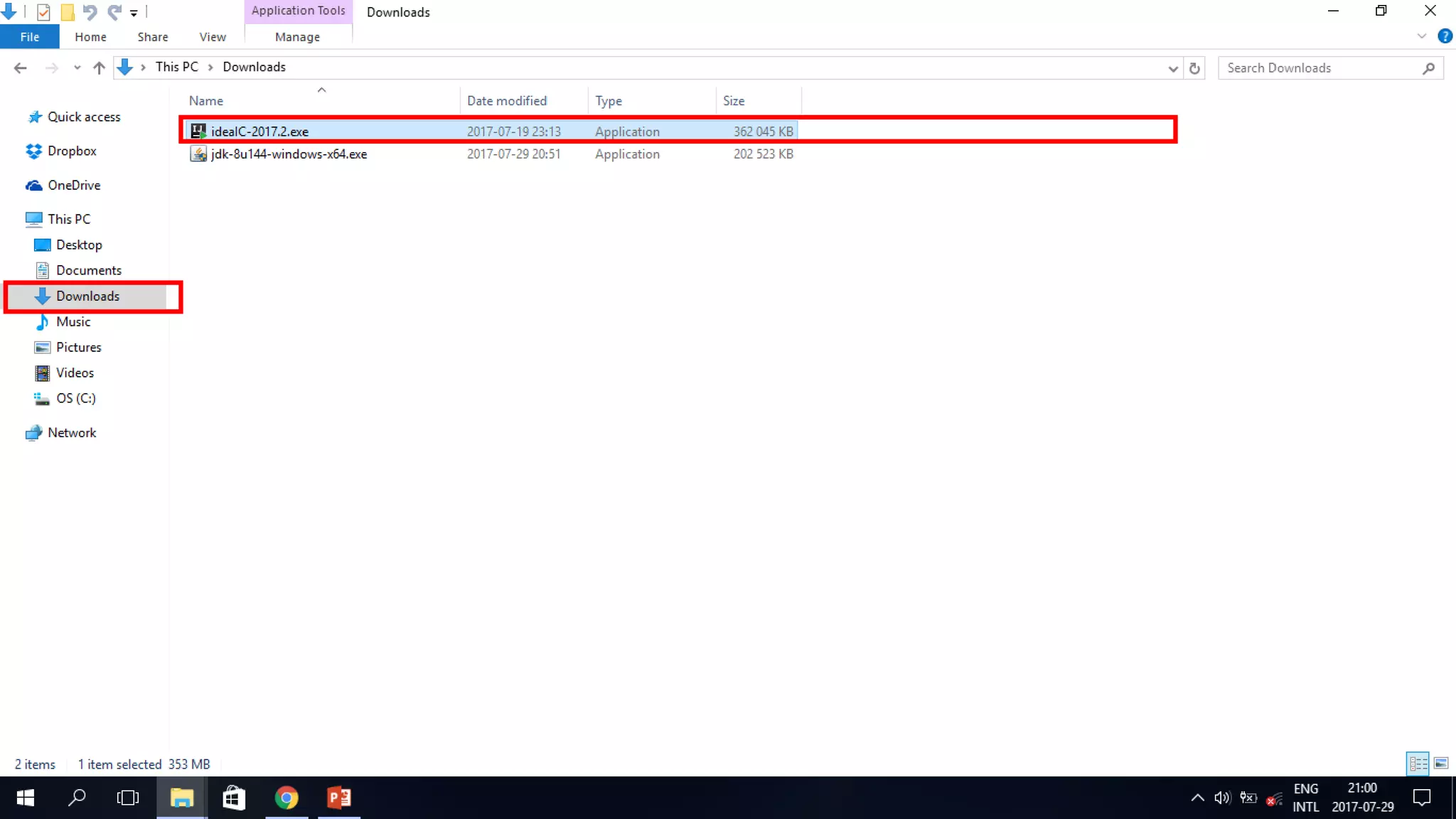
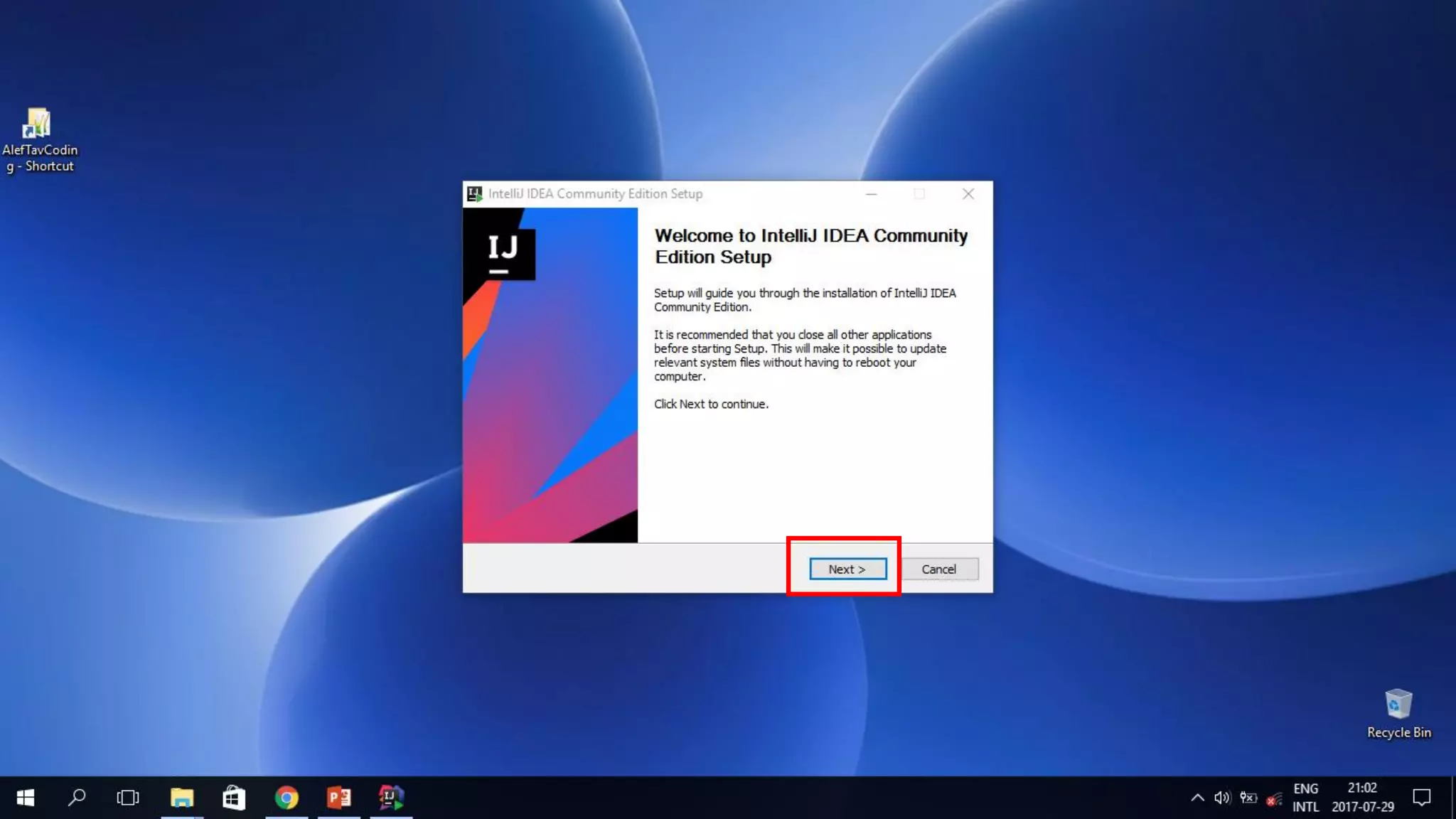

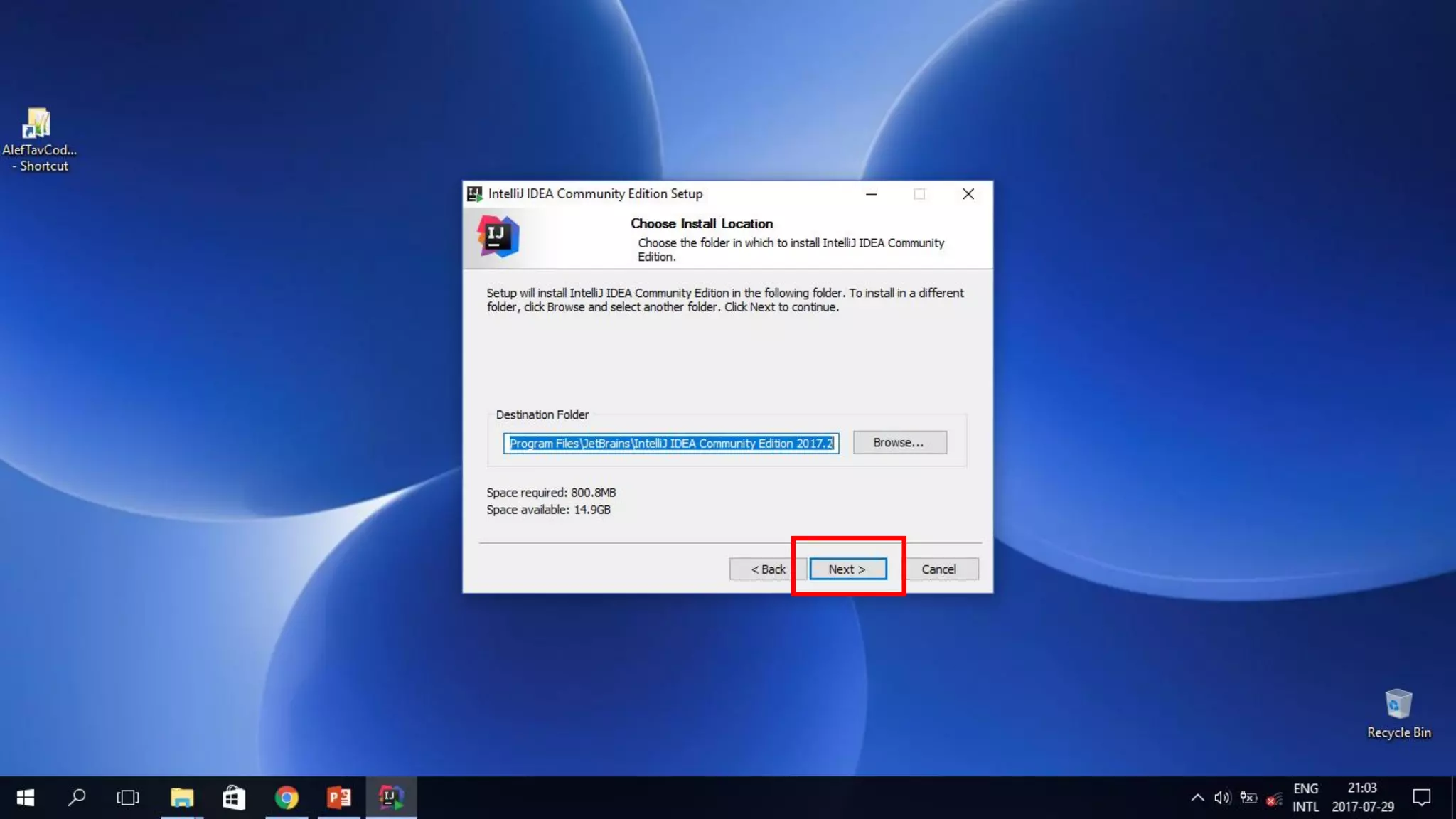
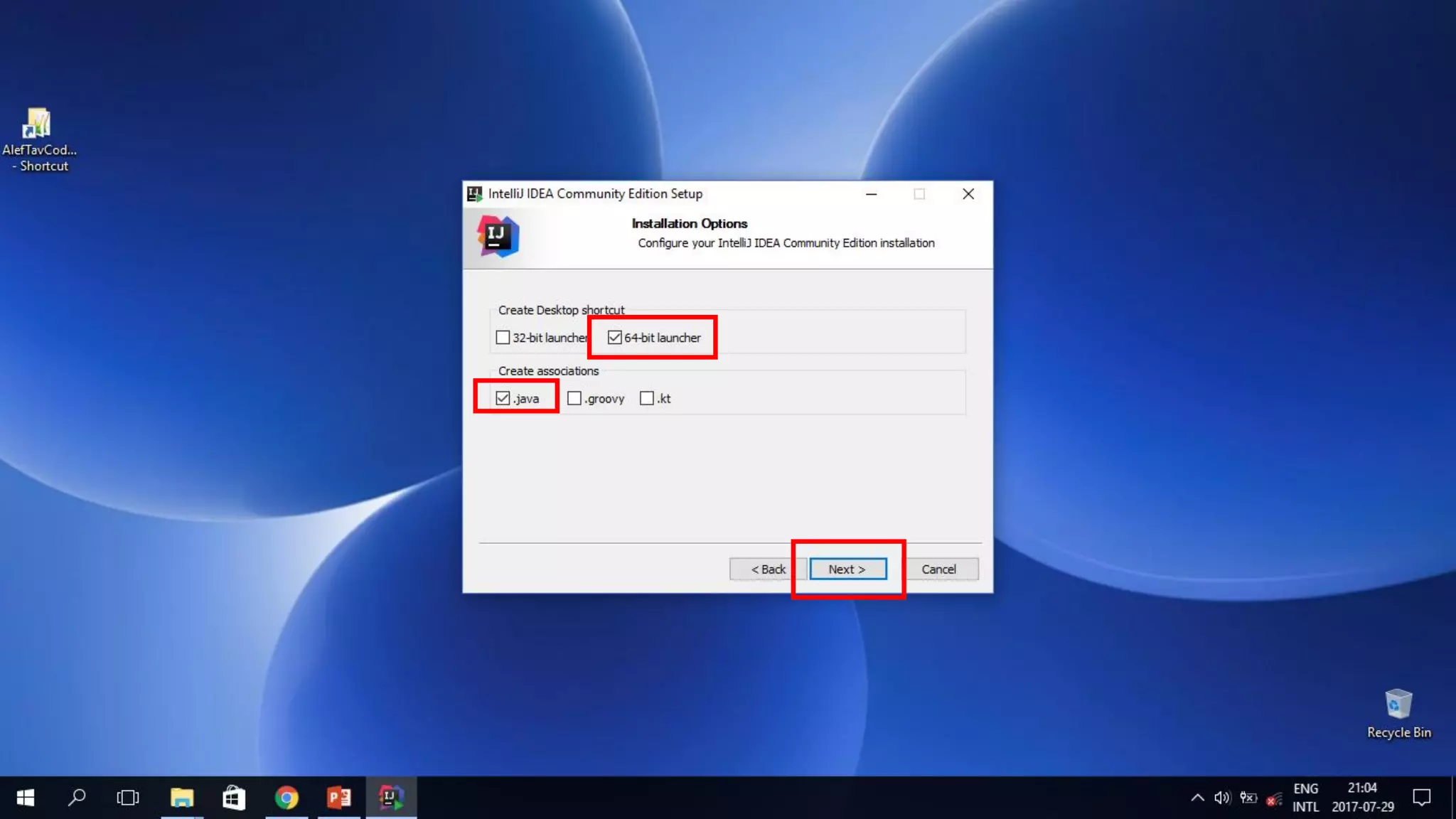
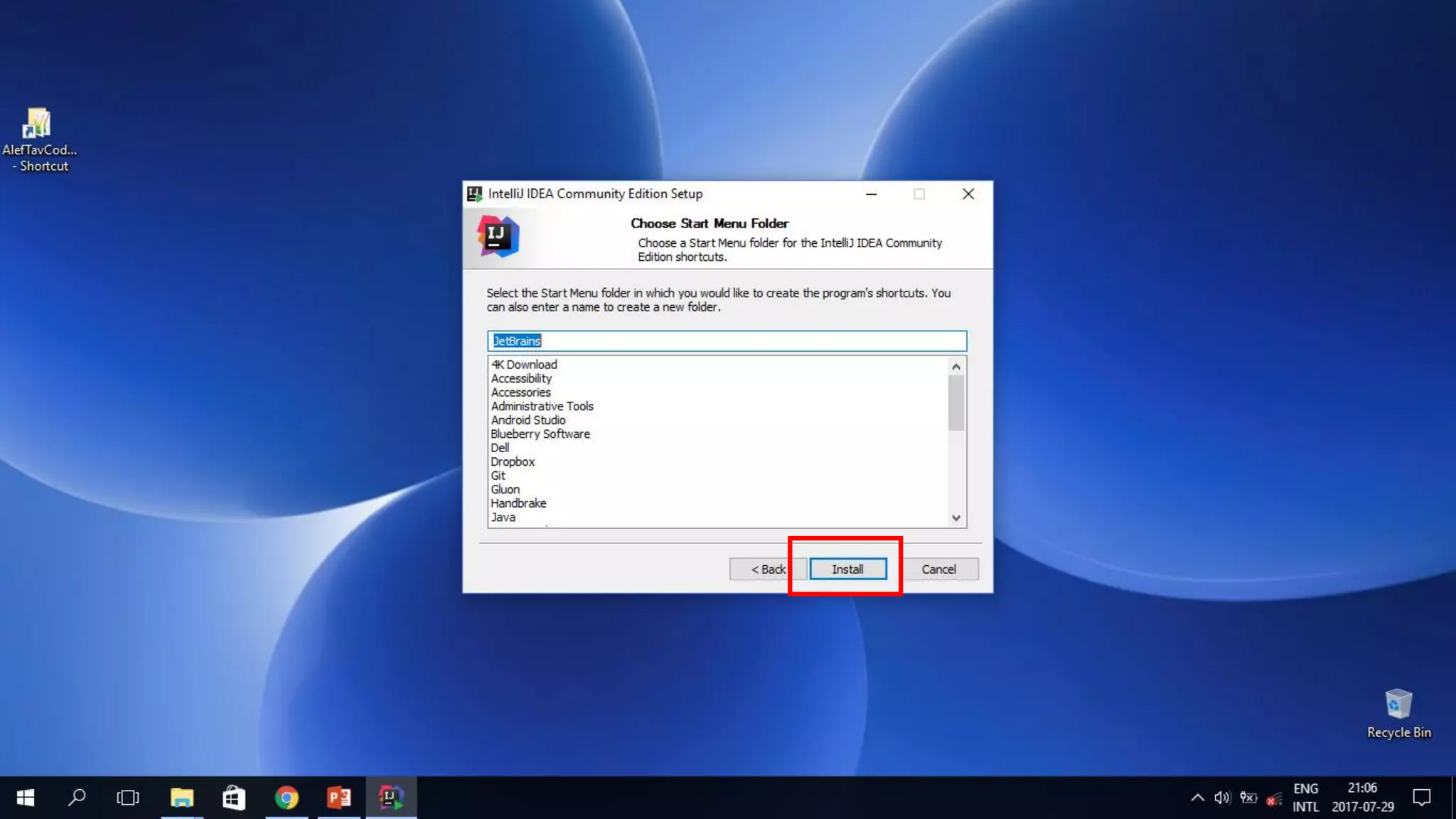
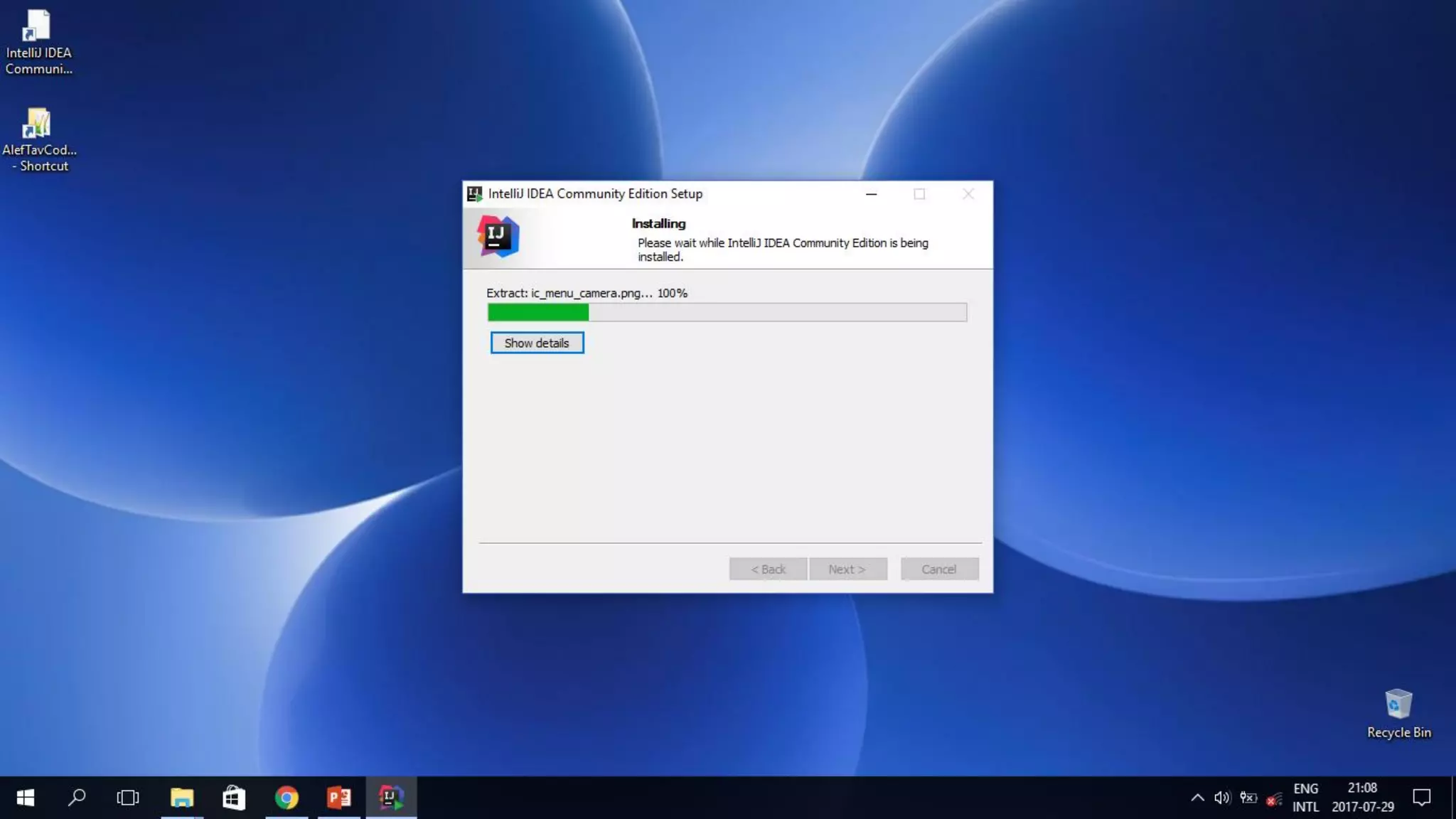
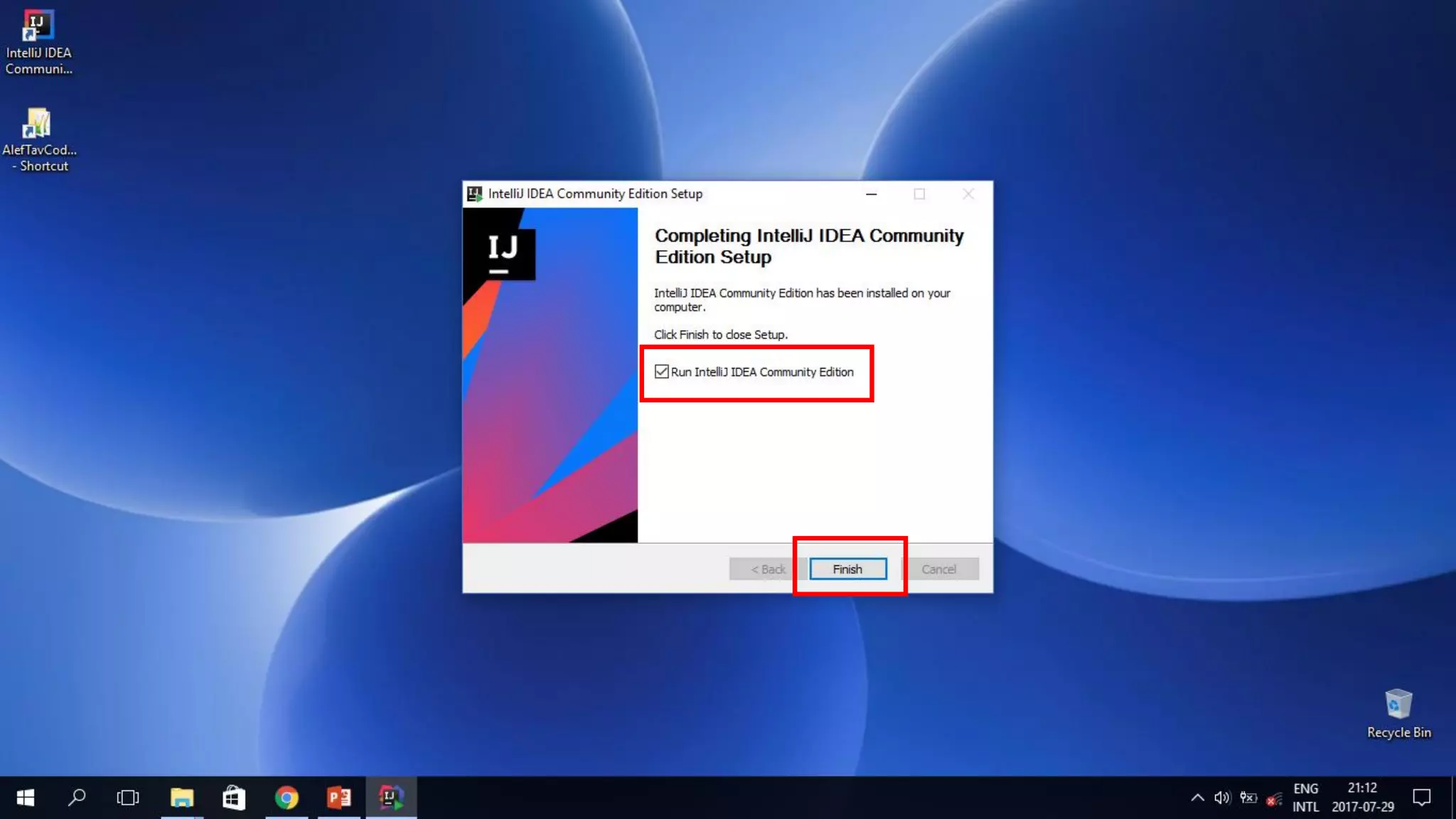
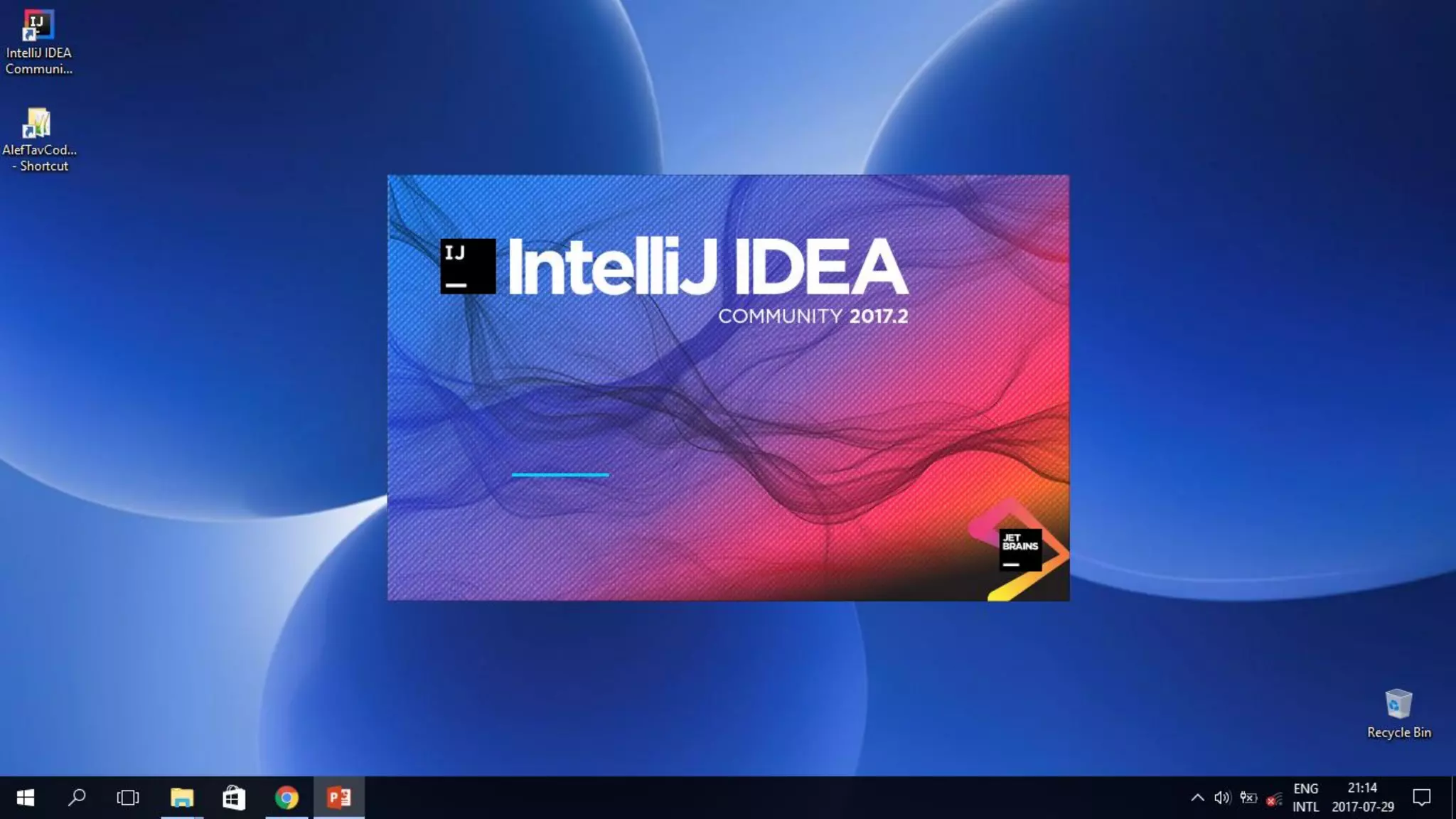
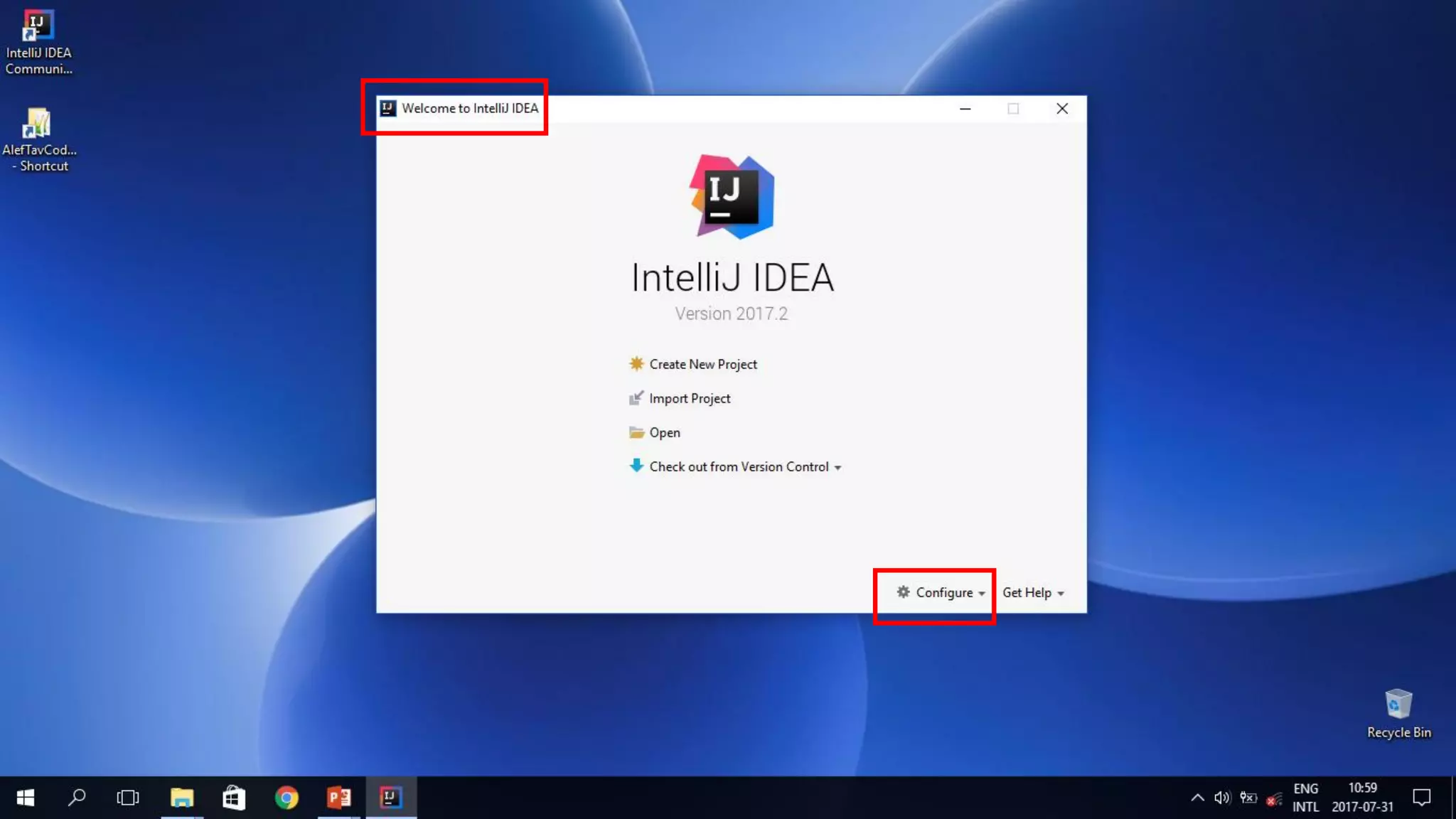
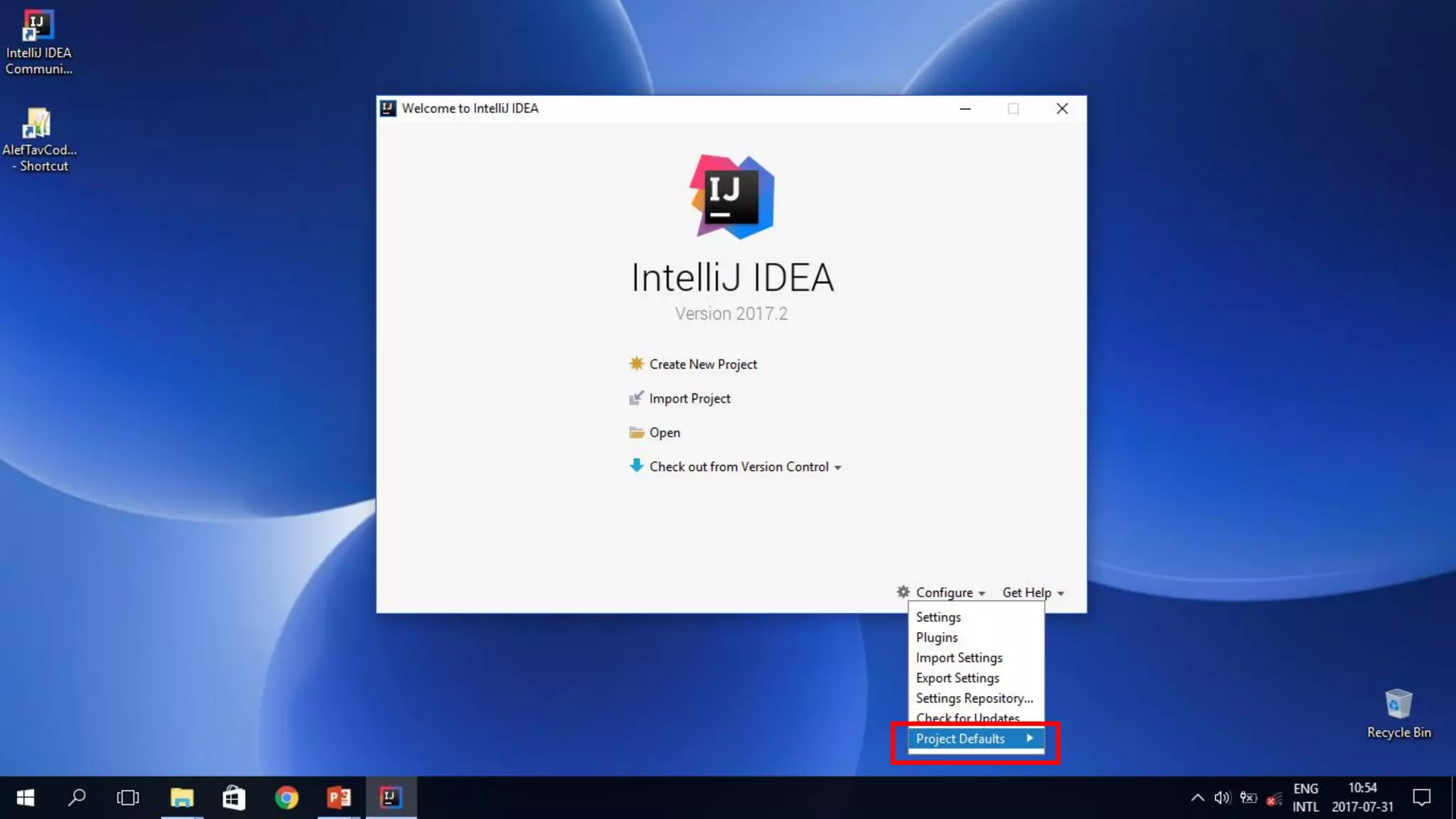
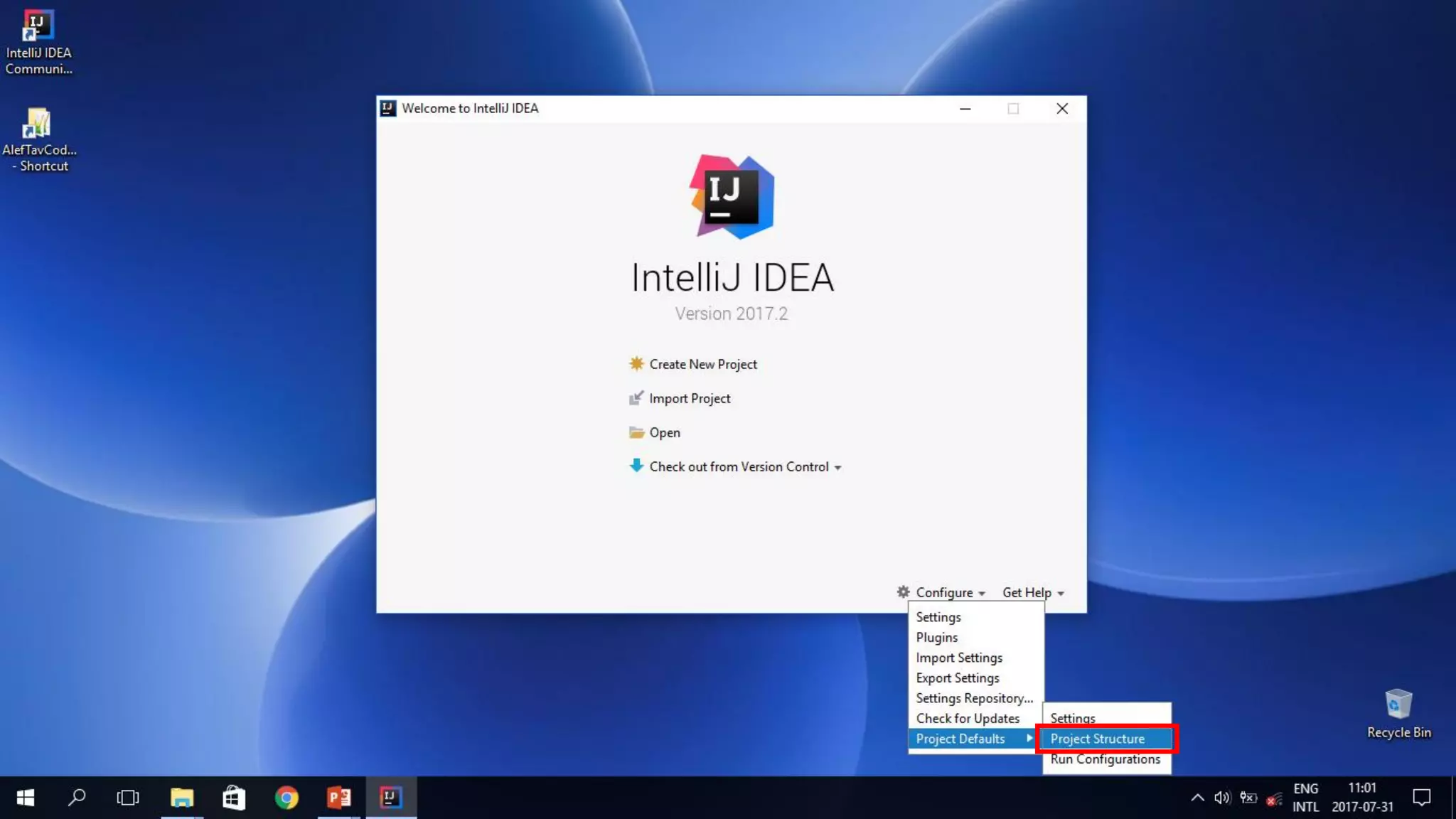
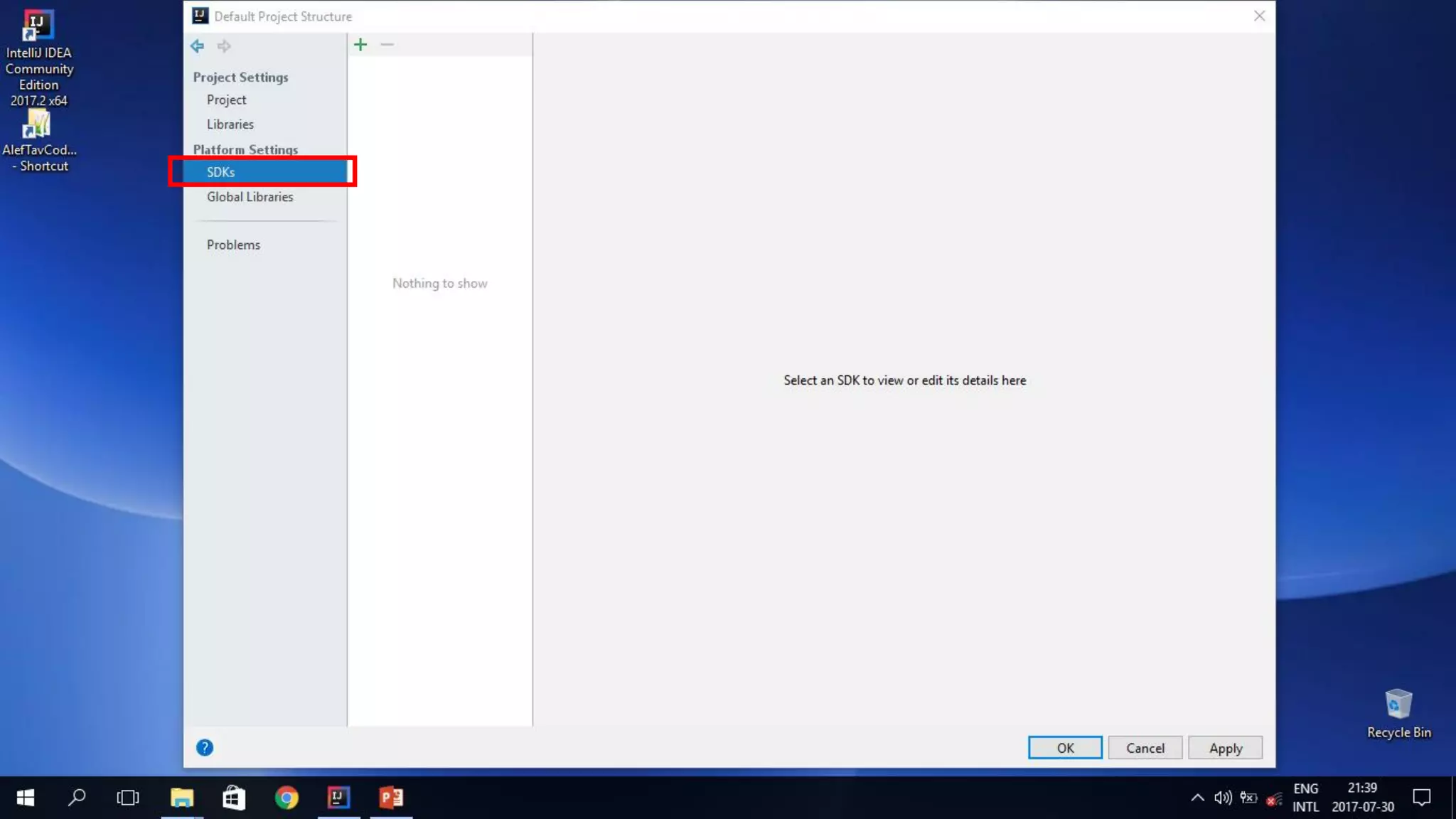
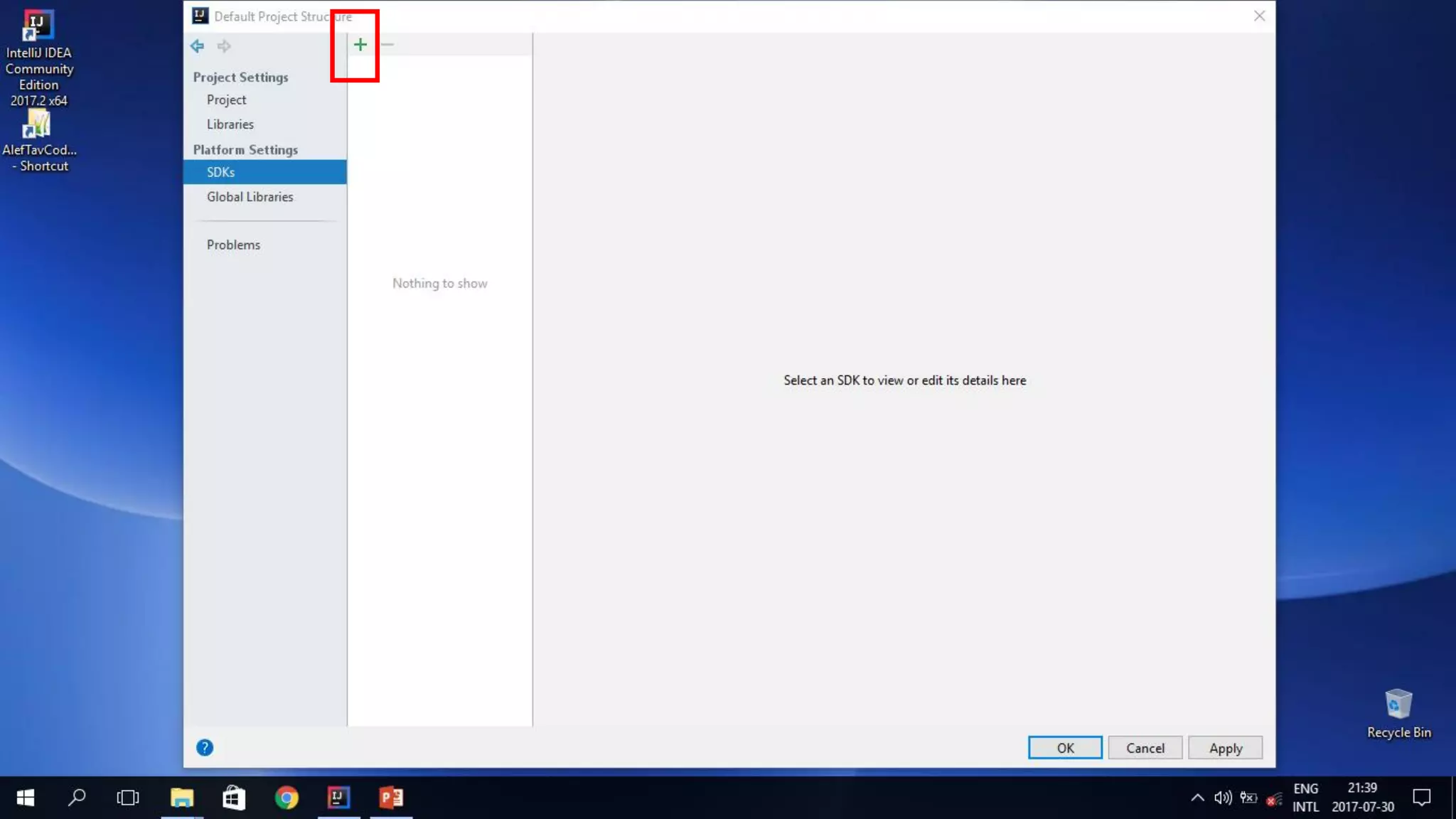
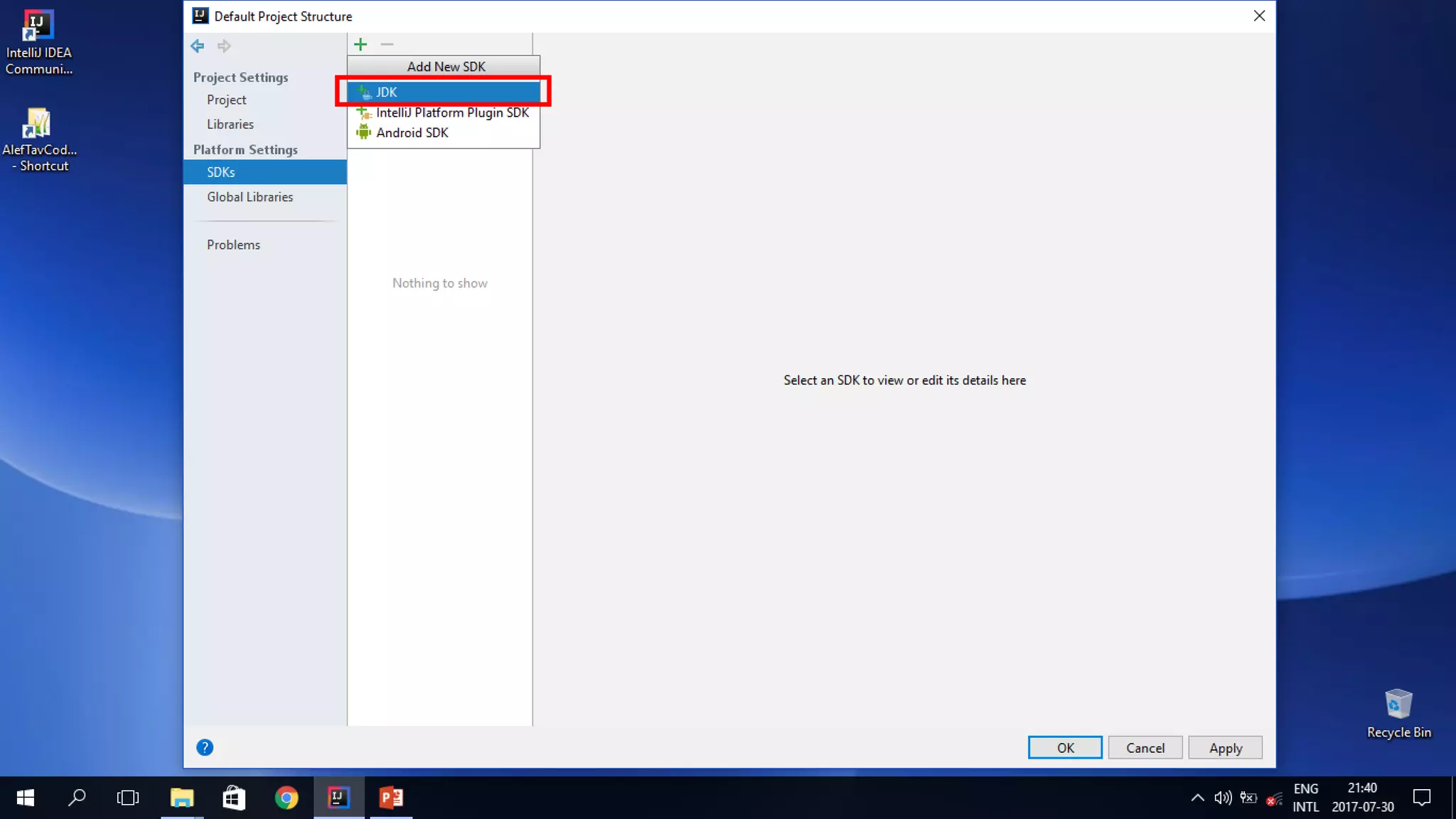
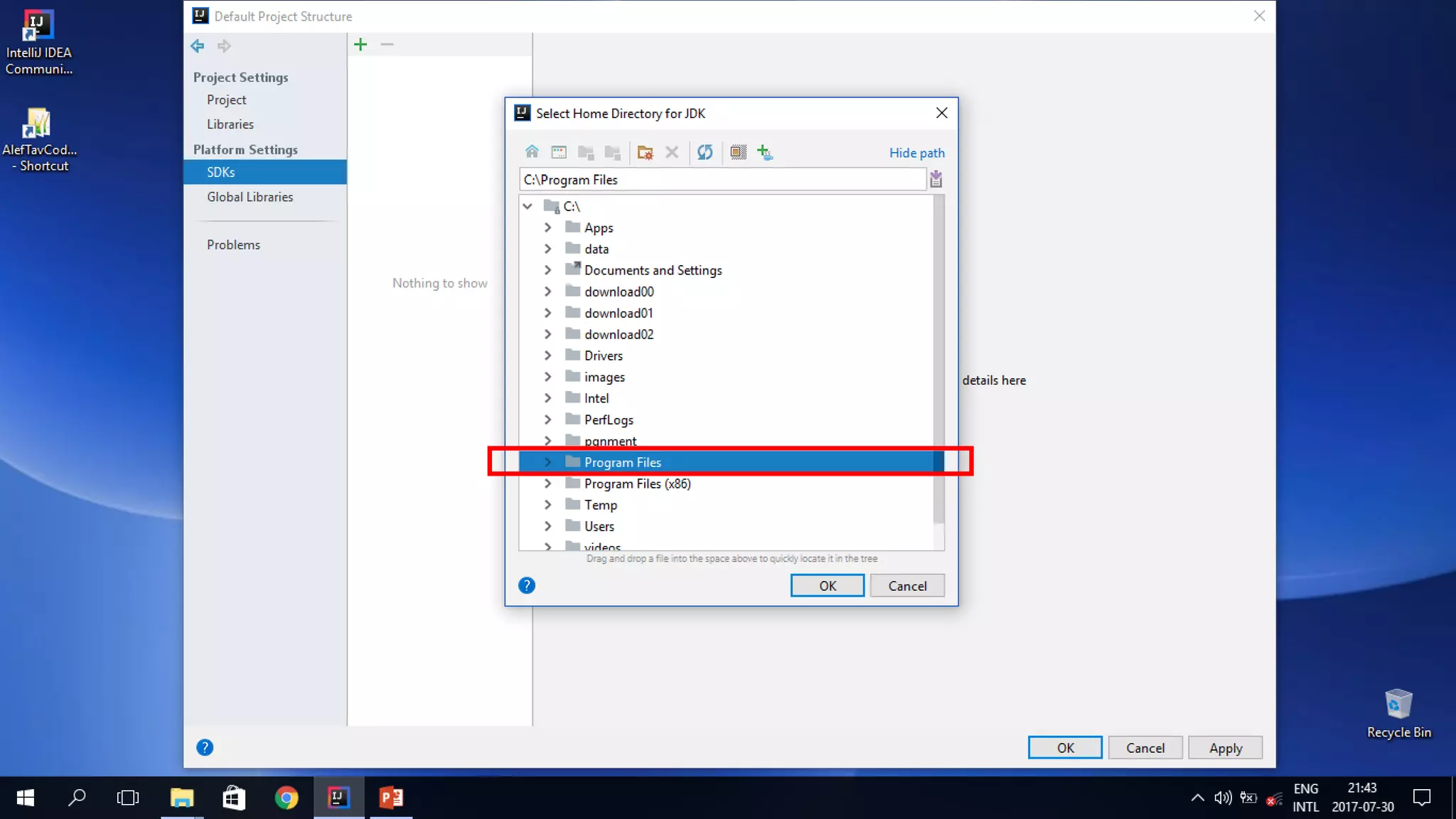
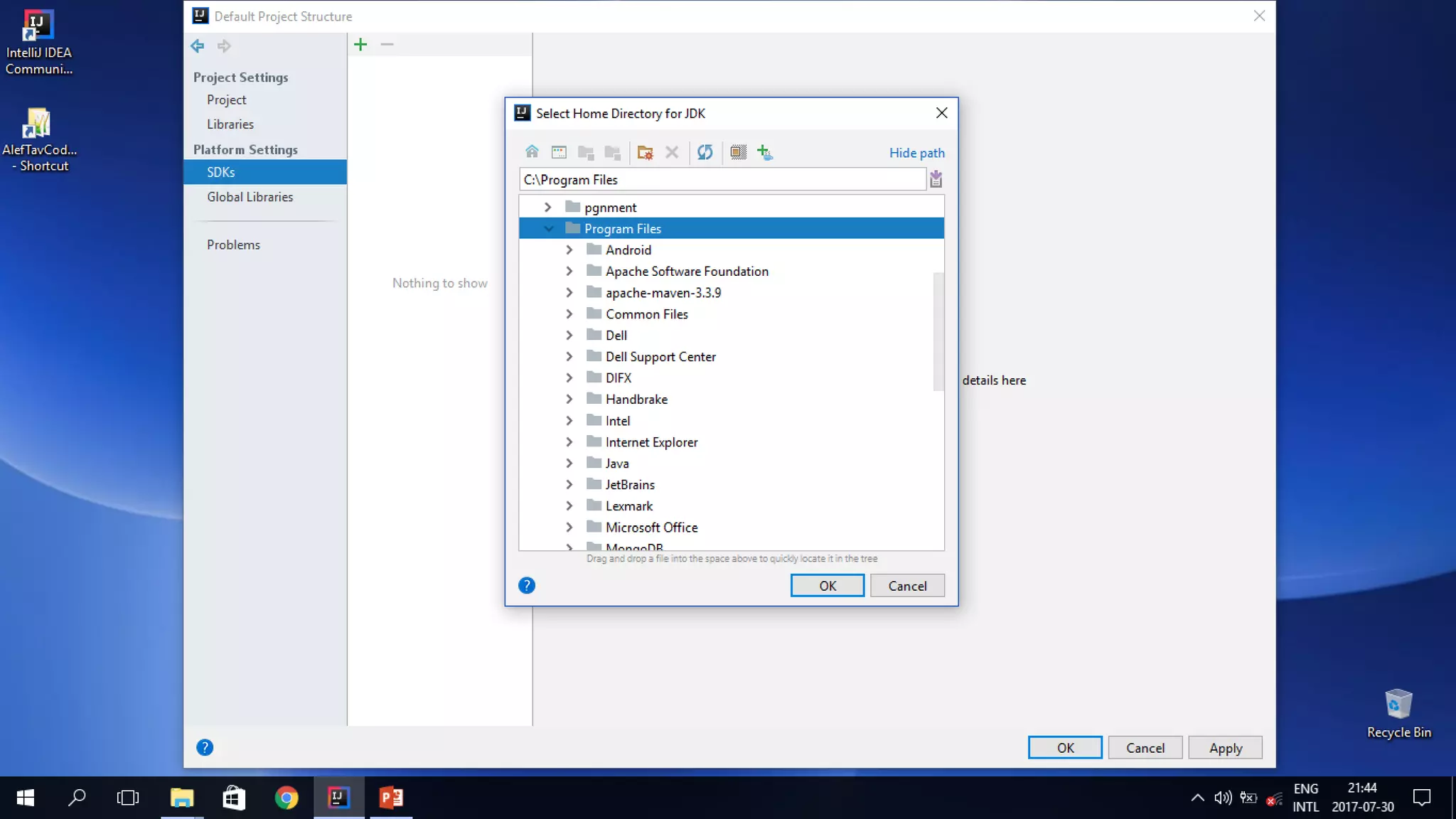
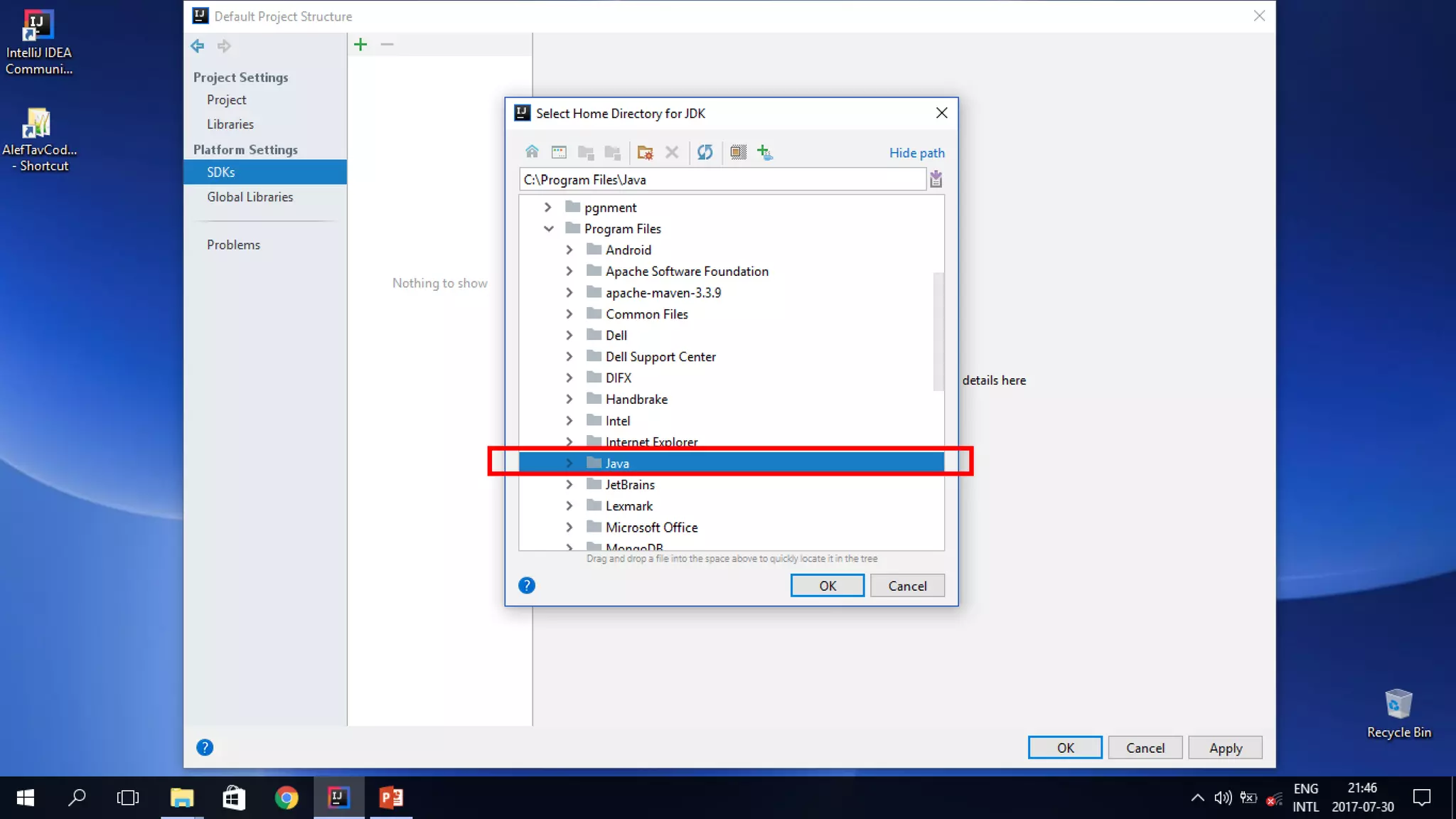
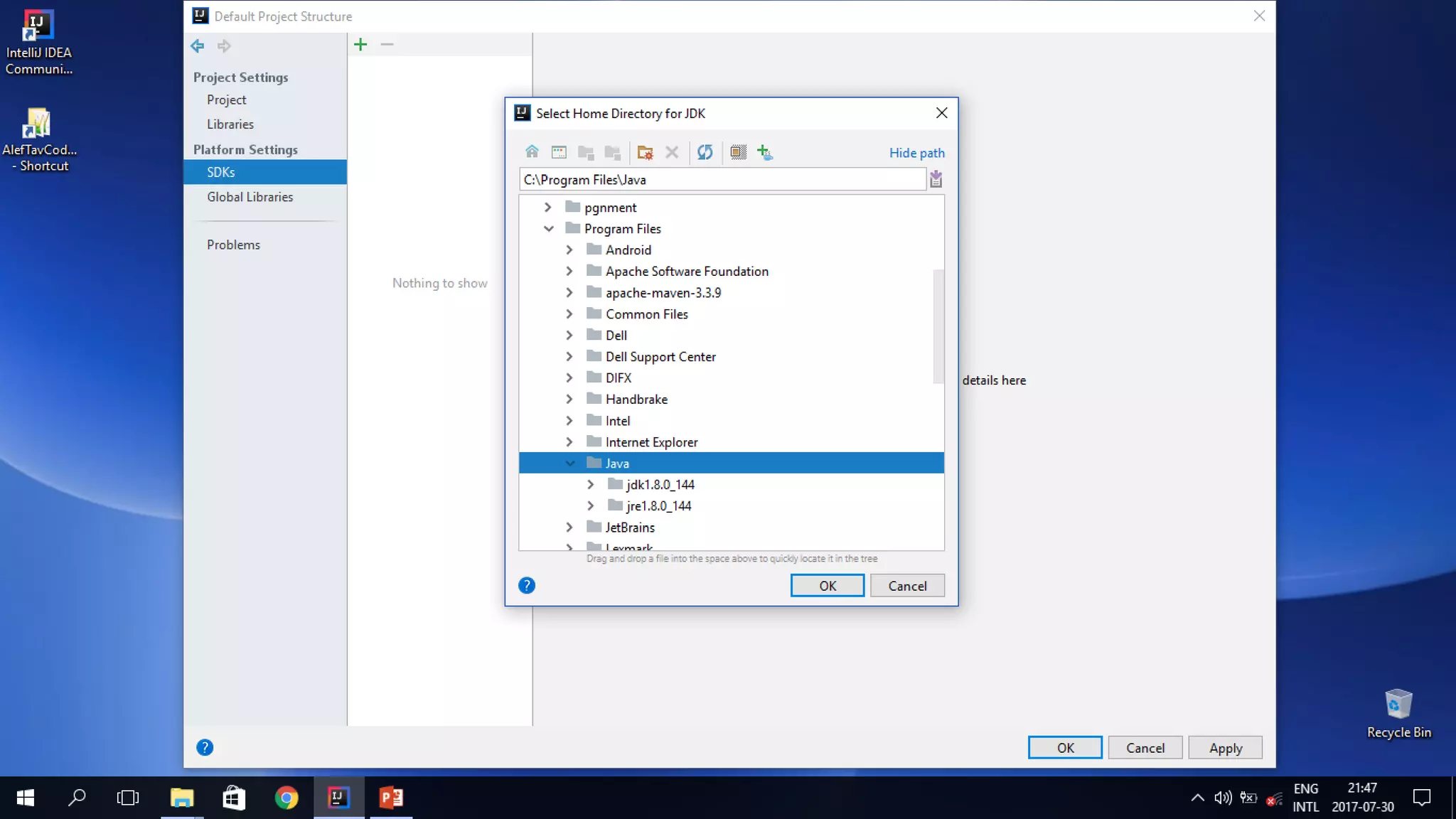
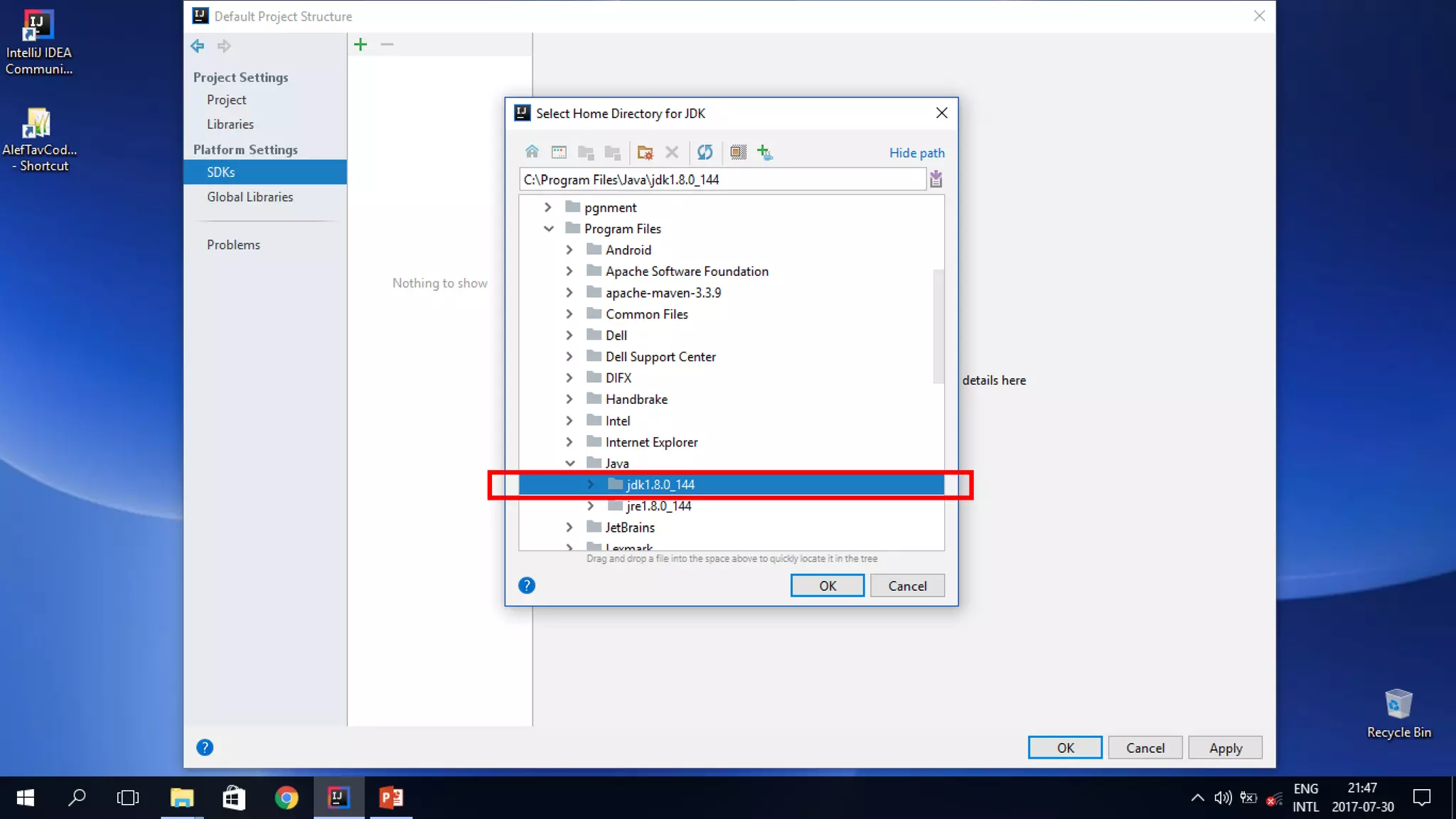
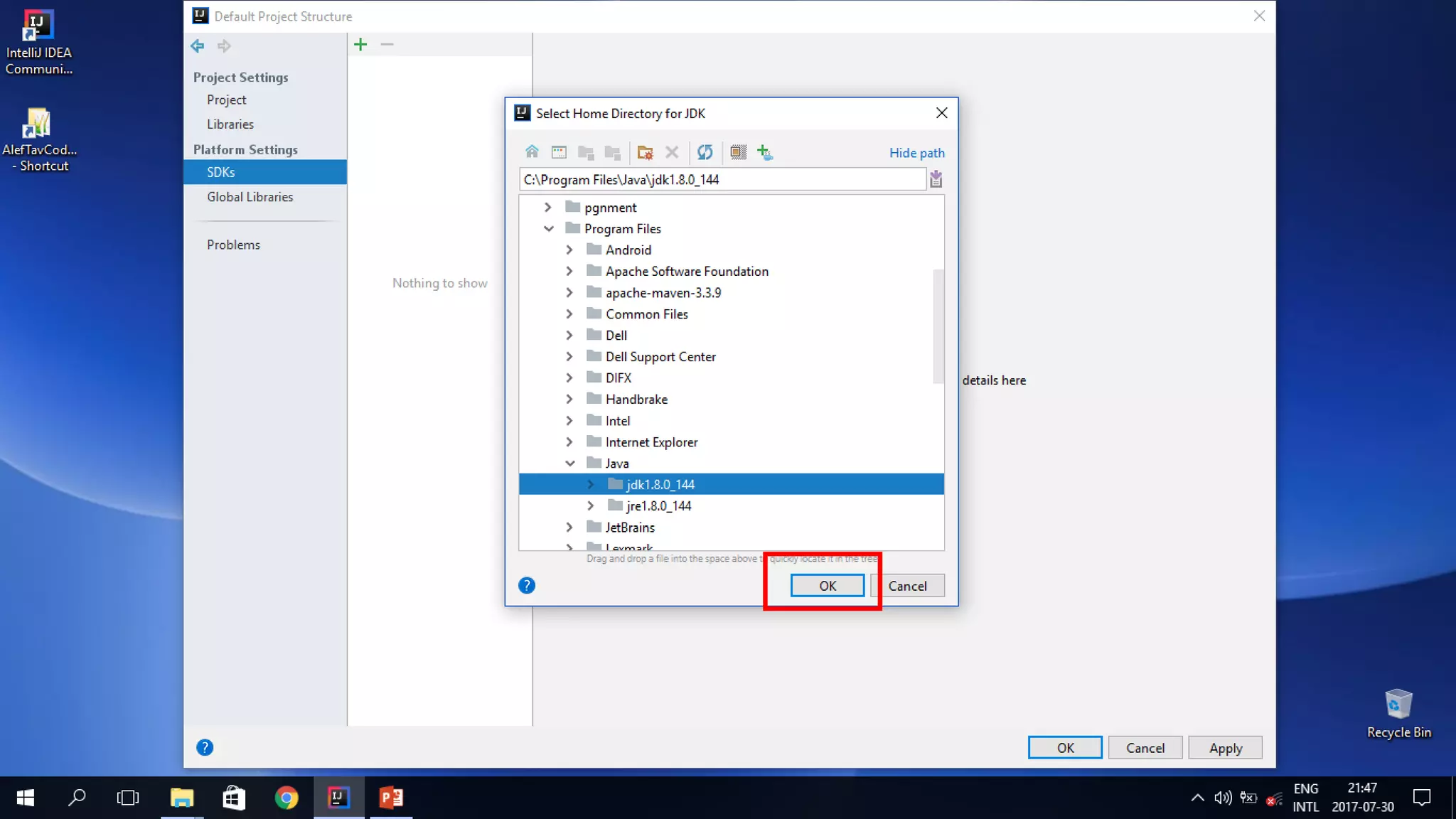
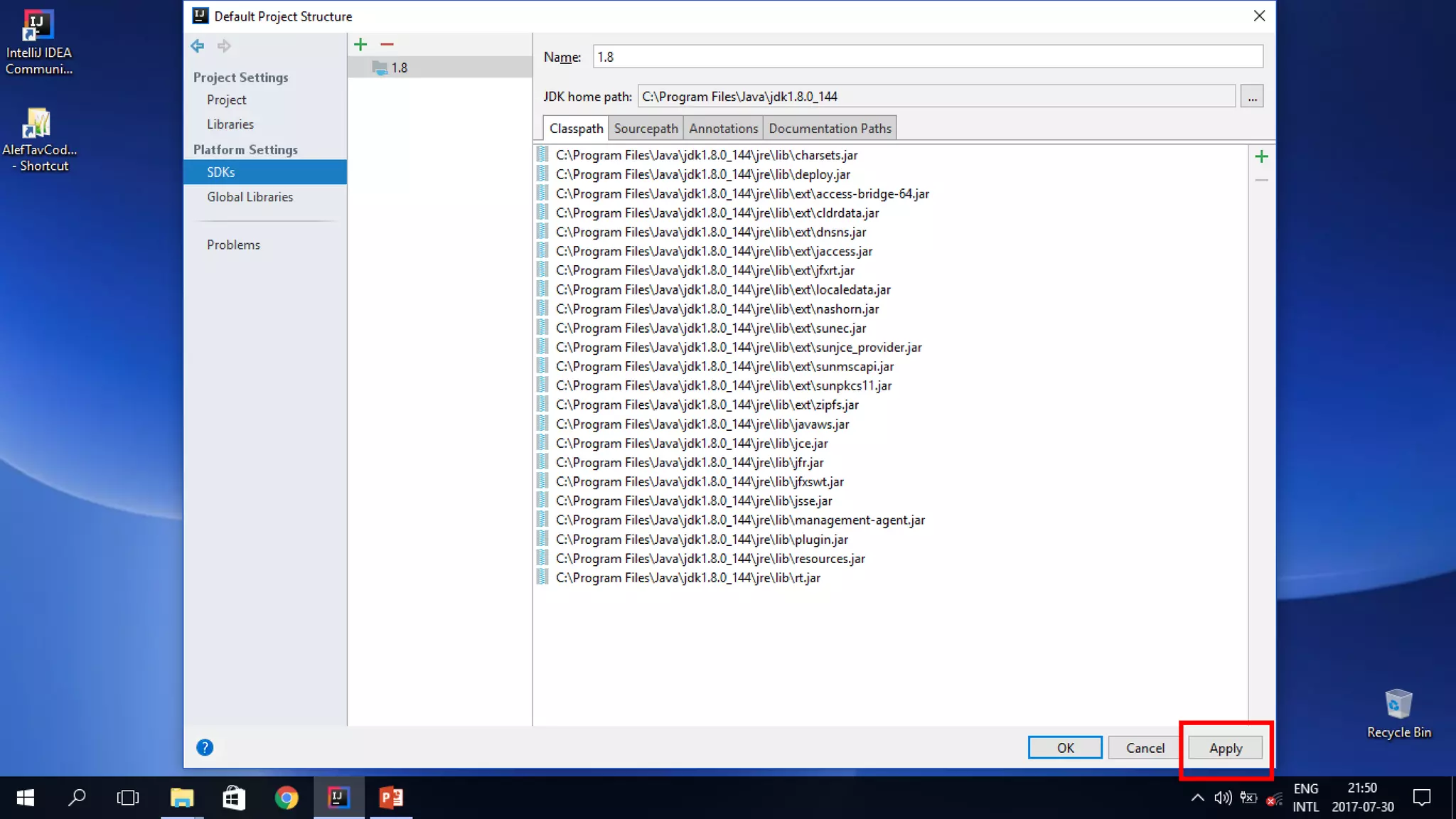
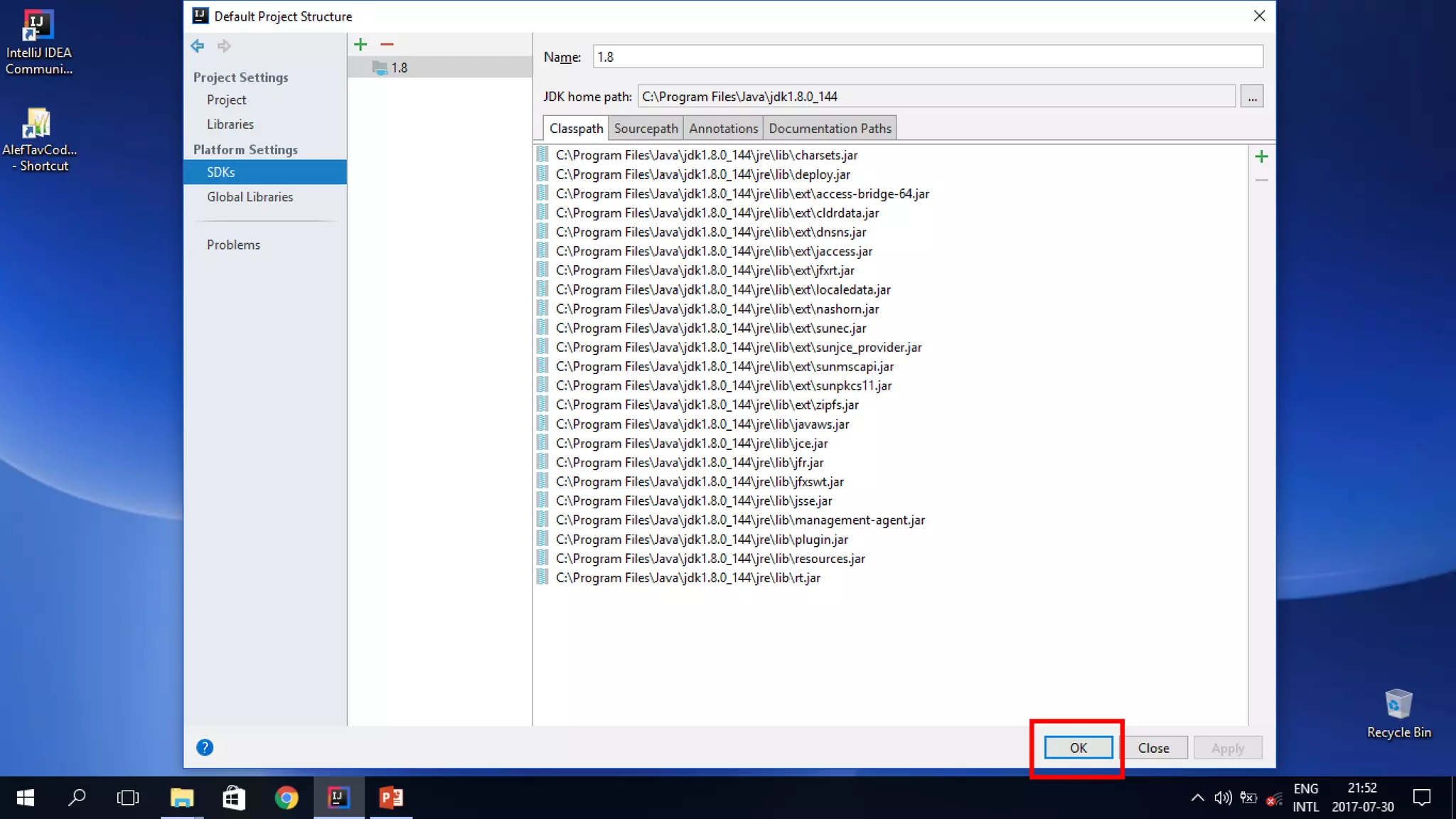
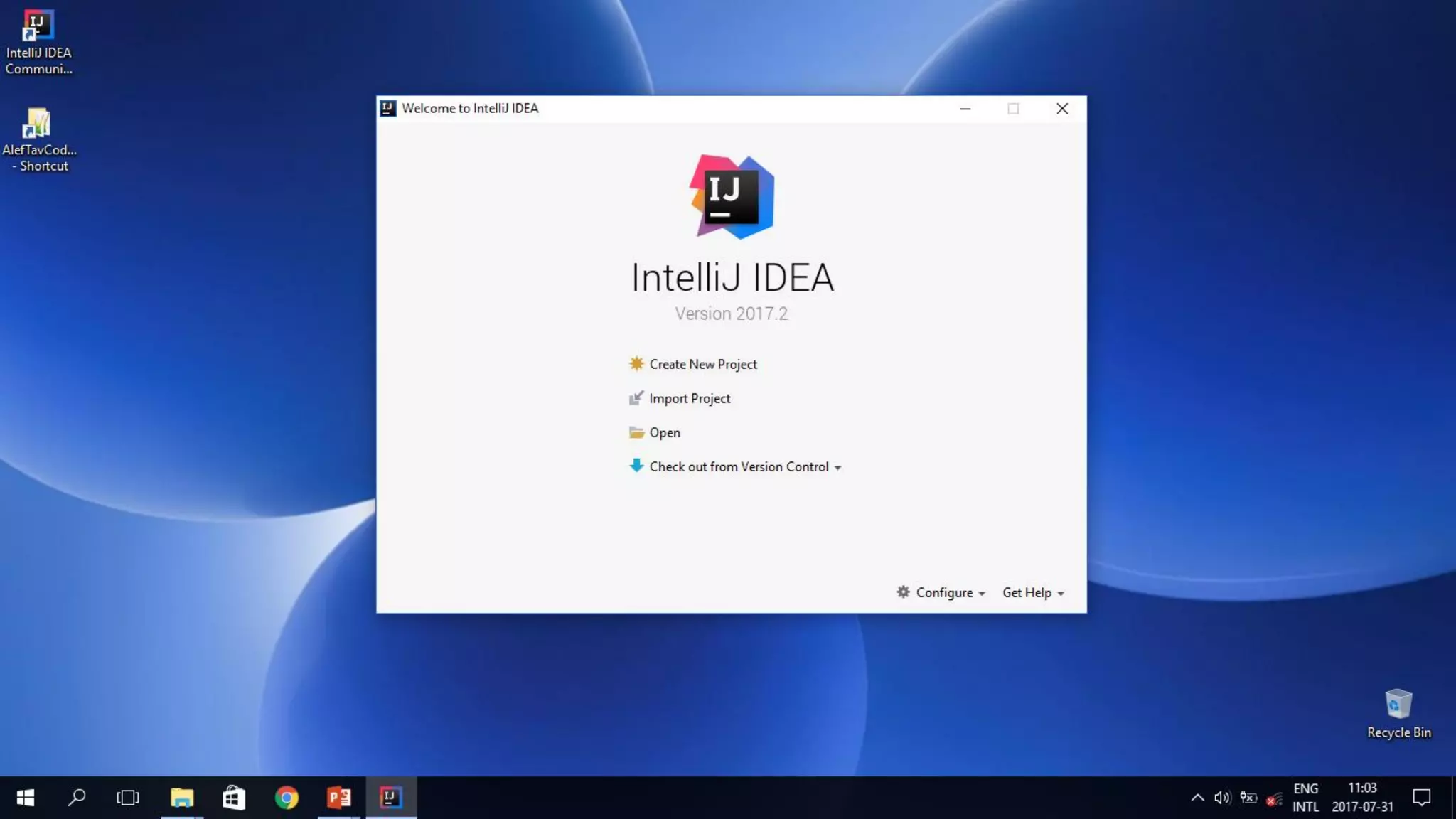
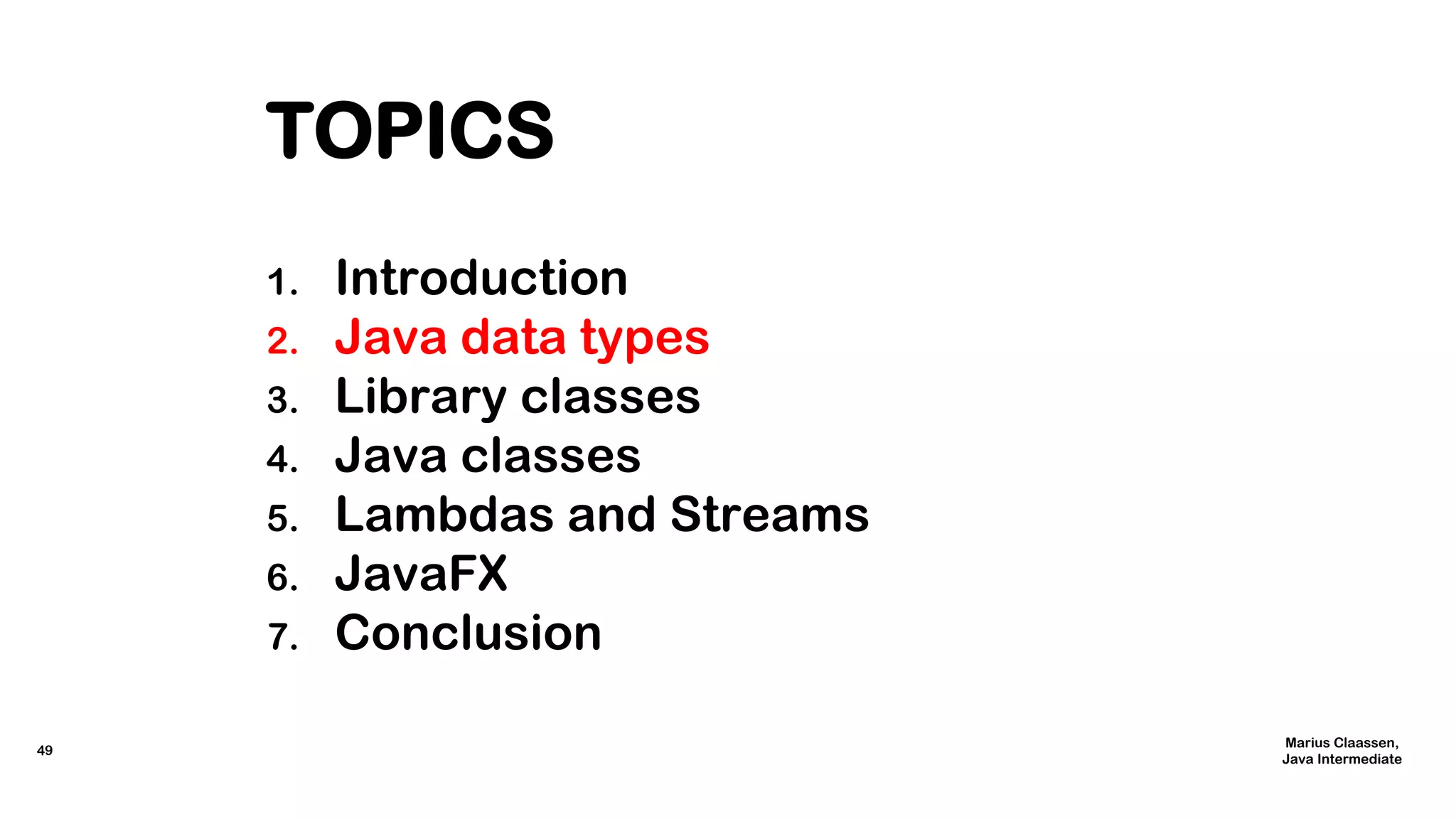
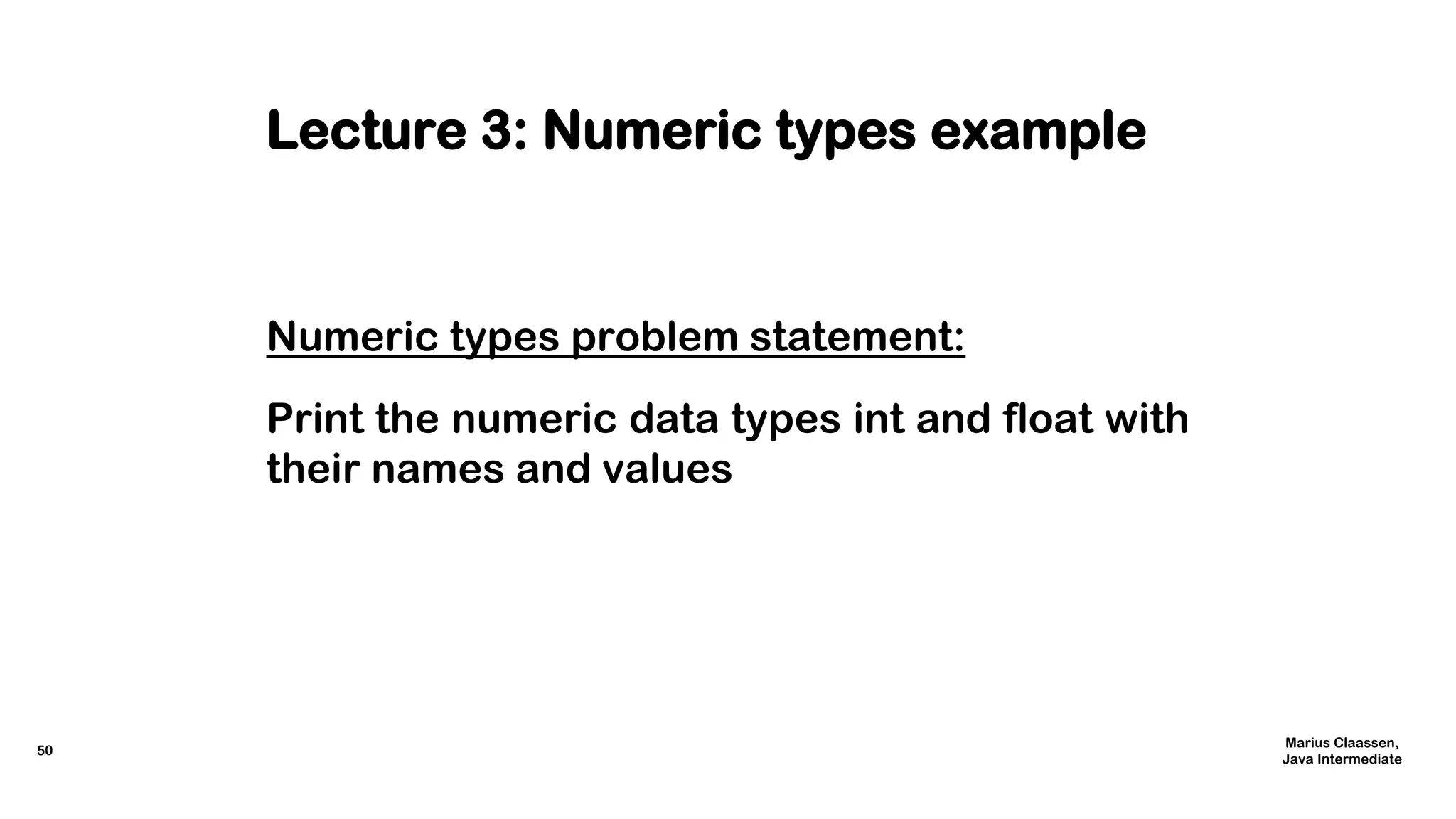
![Lecture 3: Numeric types example
public class Lecture3 {
public static void main(String[] args) {
int intNumber = 308_000;
float floatNumber = 9_000f;
System.out.print(“intNumber: ” + intNumber);
System.out.print(“tfloatNumber: ” + floatNumber);
}
} // intNumber: 308000 floatNumber: 9000.0
51
Marius Claassen,
Java Intermediate](https://image.slidesharecdn.com/javaforintermediateusers-170912102557/75/Java-for-intermediate-users-51-2048.jpg)
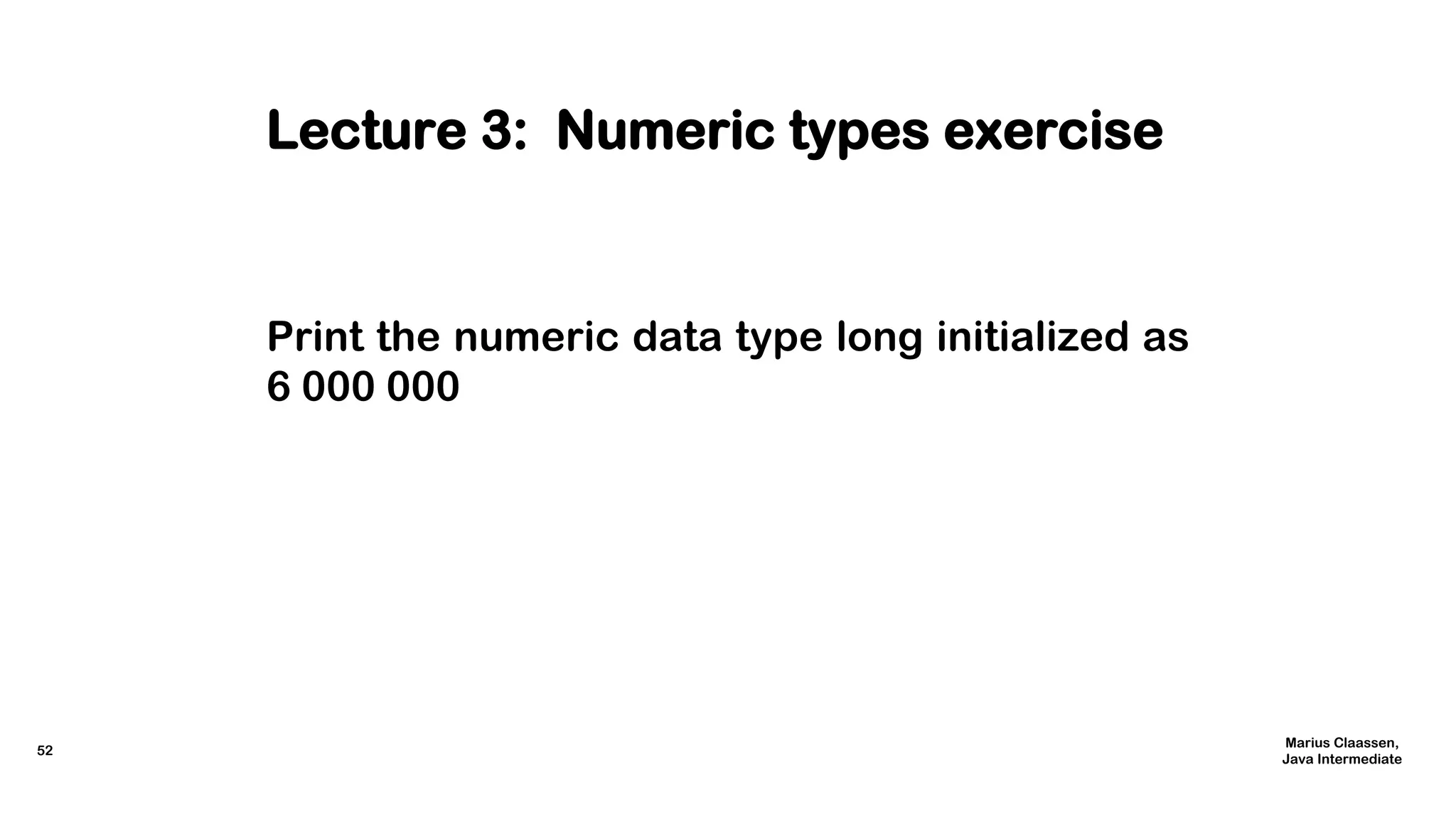
![Lecture 3: Numeric types exercise
public class Lecture4 {
public static void main(String[] args) {
long longNumber = 6_000_000;
// TODO: Print the name and value of ‘longNumber’
}
}
53
Marius Claassen,
Java Intermediate](https://image.slidesharecdn.com/javaforintermediateusers-170912102557/75/Java-for-intermediate-users-53-2048.jpg)
![Lecture 4: Numeric types solution
public class Lecture4 {
public static void main(String[] args) {
long longNumber = 6_000_000;
System.out.print(“longNumber: ” + longNumber);
}
} // longNumber: 6000000
54
Marius Claassen,
Java Intermediate](https://image.slidesharecdn.com/javaforintermediateusers-170912102557/75/Java-for-intermediate-users-54-2048.jpg)
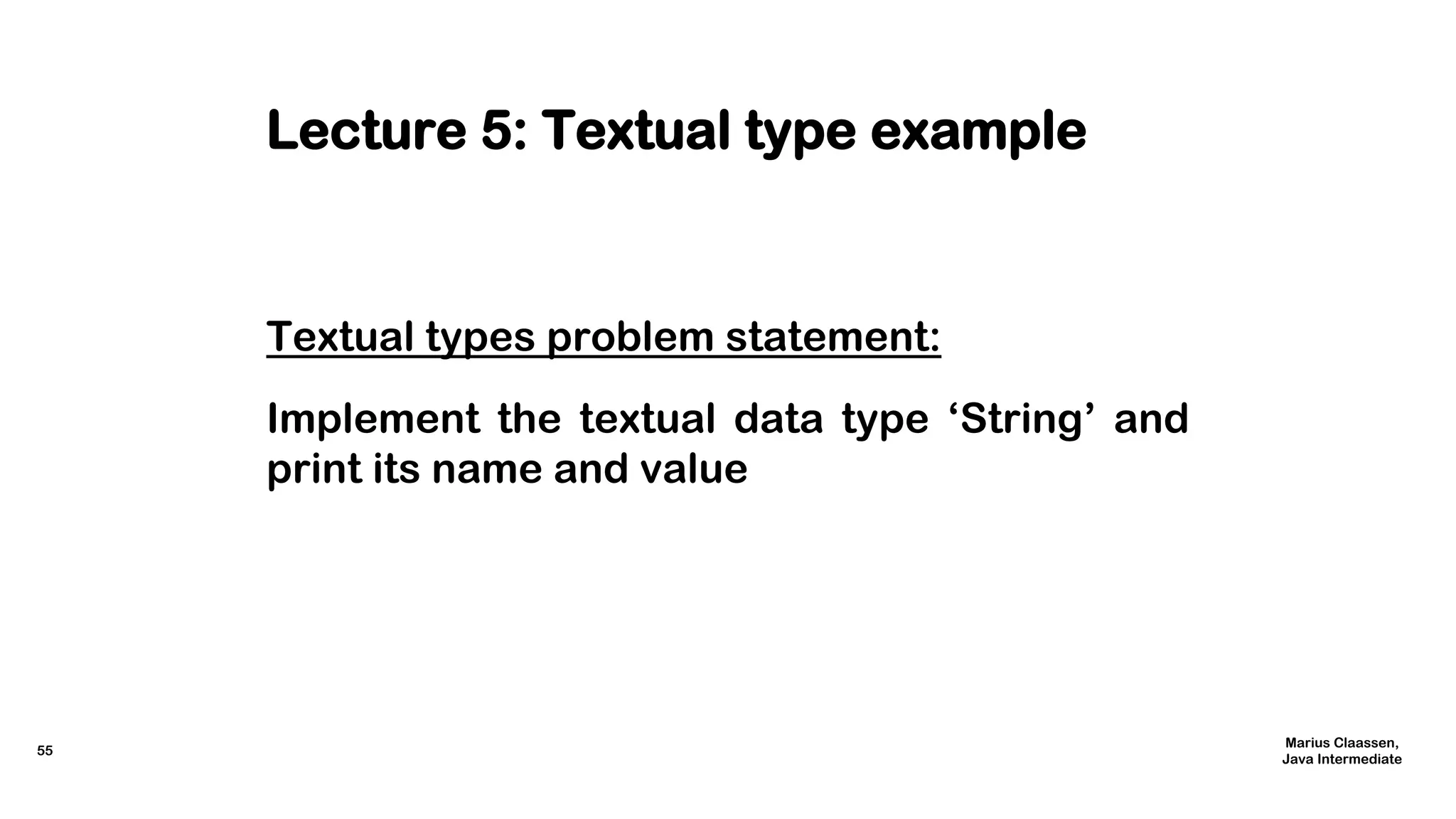
![Lecture 5: Textual type example
public class Lecture5 {
public static void main(String[] args) {
String string = “Java is everywhere.”;
System.out.print(“Text: ” + string);
}
} // Text: Java is everywhere.
56
Marius Claassen,
Java Intermediate](https://image.slidesharecdn.com/javaforintermediateusers-170912102557/75/Java-for-intermediate-users-56-2048.jpg)
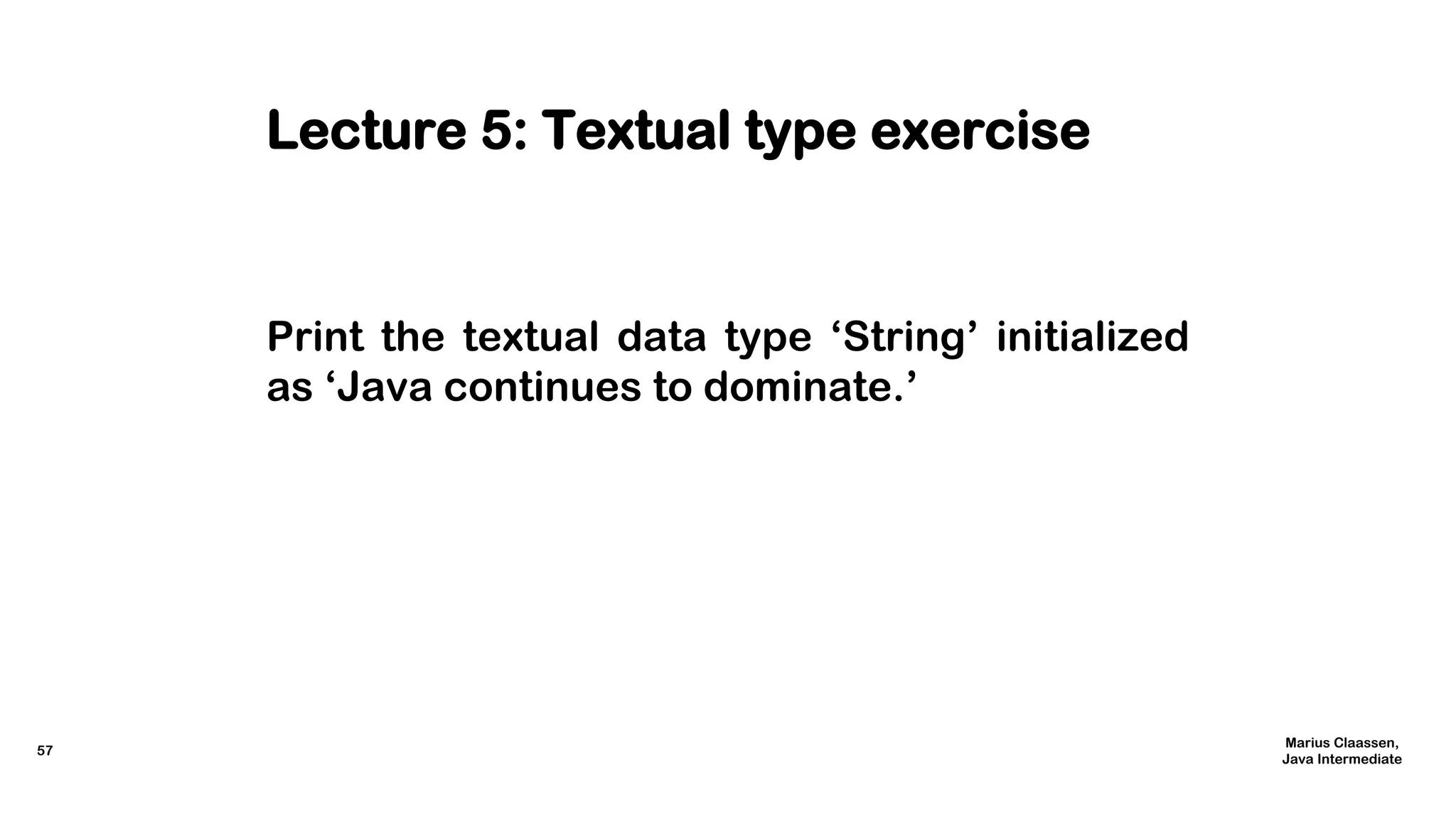
![Lecture 5: Textual type exercise
public class Lecture6 {
public static void main(String[] args) {
String myString = “Java continues to dominate.”;
// TODO: Print the name and value of ‘myString’
}
}
58
Marius Claassen,
Java Intermediate](https://image.slidesharecdn.com/javaforintermediateusers-170912102557/75/Java-for-intermediate-users-58-2048.jpg)
![Lecture 6: Textual type solution
public class Lecture6 {
public static void main(String[] args) {
String myString = “Java continues to dominate.”;
System.out.print(“myString: ” + myString);
}
} // myString: Java continues to dominate.
59
Marius Claassen,
Java Intermediate](https://image.slidesharecdn.com/javaforintermediateusers-170912102557/75/Java-for-intermediate-users-59-2048.jpg)
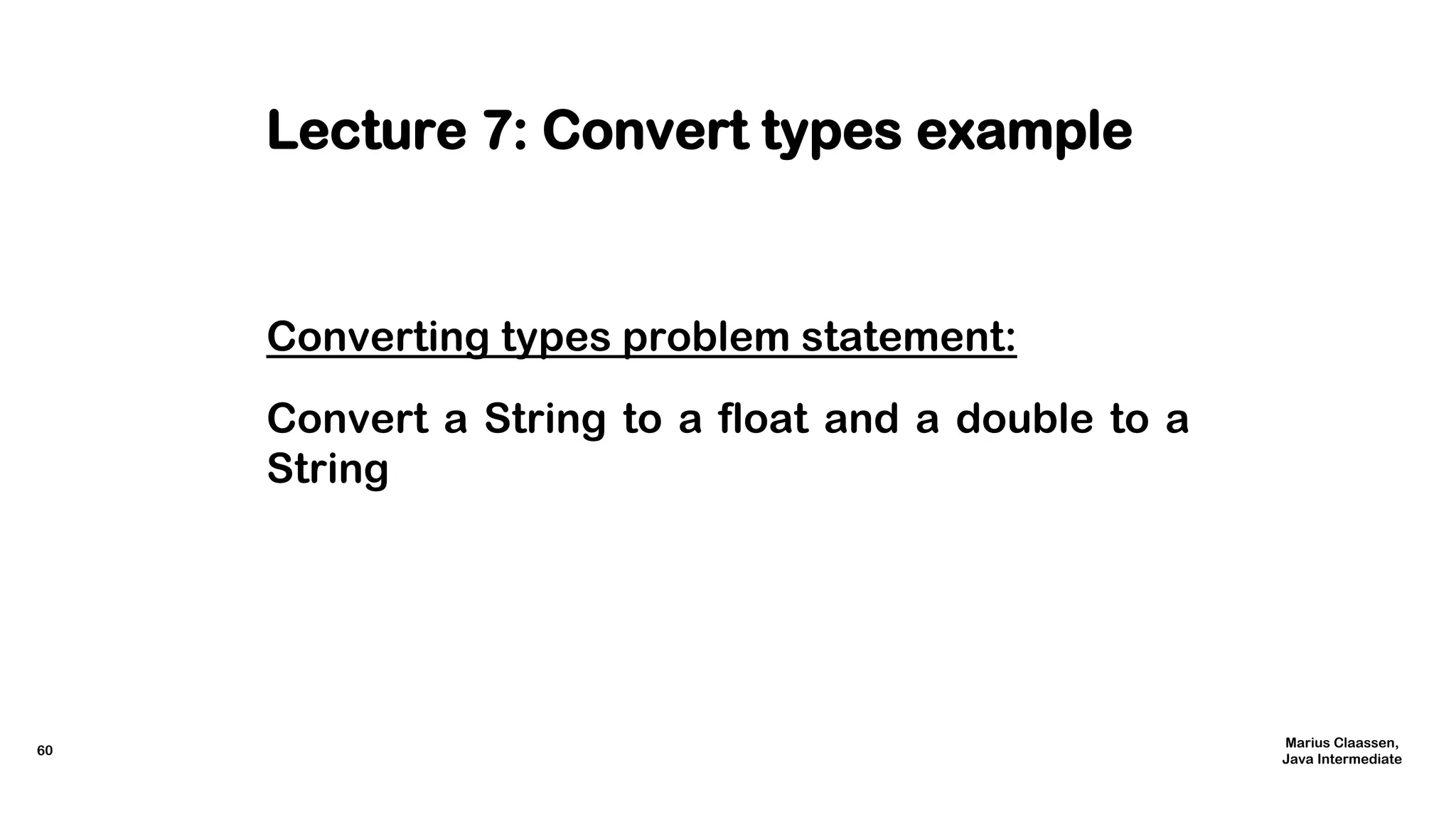
![Lecture 7: Convert types example
public class Lecture7 {
public static void main(String[] args) {
String stringText = “7.7”;
float floatNumber = Float.parseFloat(stringText);
System.out.print(“String to float: ” + floatNumber);
double doubleNumber = 200;
String text1 = Double.toString(doubleNumber);
System.out.print(“ndouble to String: ” + text1); } }
// String to float: 7.7
// double to String: 200.0
61
Marius Claassen,
Java Intermediate](https://image.slidesharecdn.com/javaforintermediateusers-170912102557/75/Java-for-intermediate-users-61-2048.jpg)
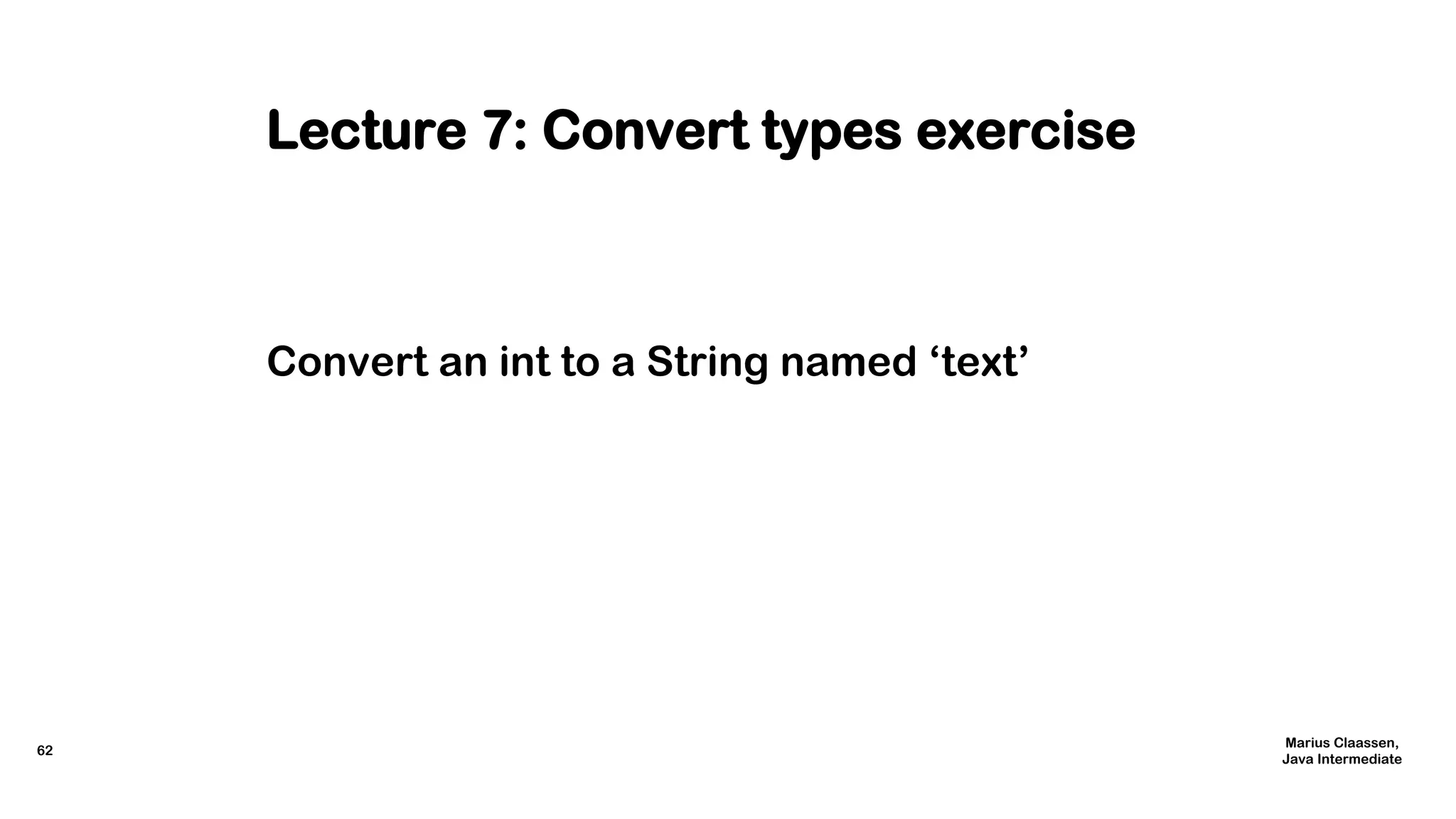
![Lecture 7: Convert types exercise
public class Lecture8 {
public static void main(String[] args) {
int value = 1_000;
// TODO: Convert int ‘value’ to a String ‘text’
System.out.print(“int to String: ” + text);
}
}
63
Marius Claassen,
Java Intermediate](https://image.slidesharecdn.com/javaforintermediateusers-170912102557/75/Java-for-intermediate-users-63-2048.jpg)
![Lecture 8: Convert types solution
public class Lecture8 {
public static void main(String[] args) {
int value = 1_000;
String text = Integer.toString(value);
System.out.print(“int to String: ” + text);
}
} // int to String: 1000
64
Marius Claassen,
Java Intermediate](https://image.slidesharecdn.com/javaforintermediateusers-170912102557/75/Java-for-intermediate-users-64-2048.jpg)
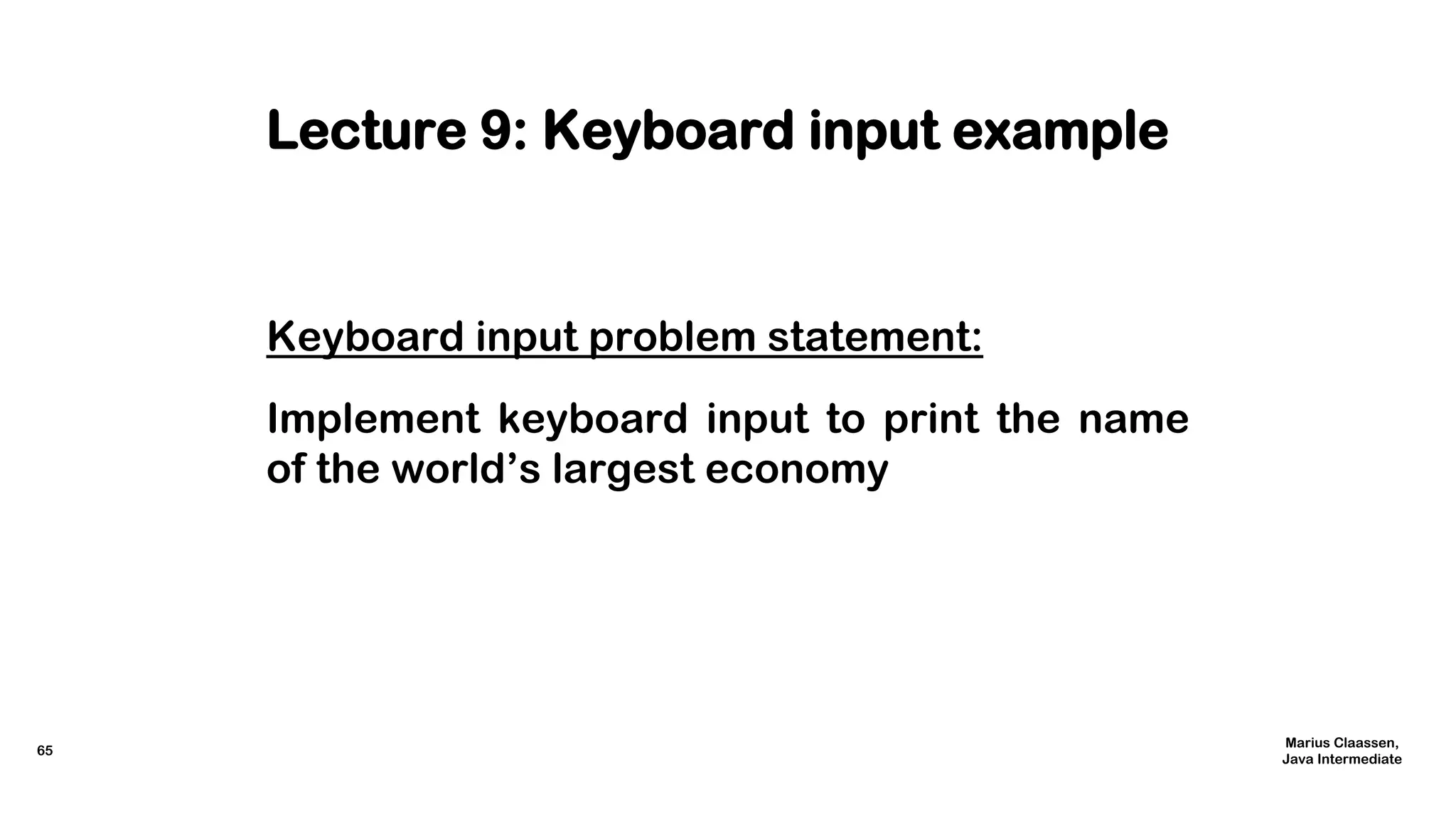
![Lecture 9: Keyboard input example
public class Lecture9 {
public static void main(String[] args) {
System.out.print(“Name the world’s largest economy ”);
Scanner scanner = new Scanner(System.in);
String largestEconomy = scanner.next;
System.out.print(largestEconomy+“ has the largest economy.”);}}
// Name the world’s largest economy ***?
// USA has the largest economy.
66
Marius Claassen,
Java Intermediate](https://image.slidesharecdn.com/javaforintermediateusers-170912102557/75/Java-for-intermediate-users-66-2048.jpg)
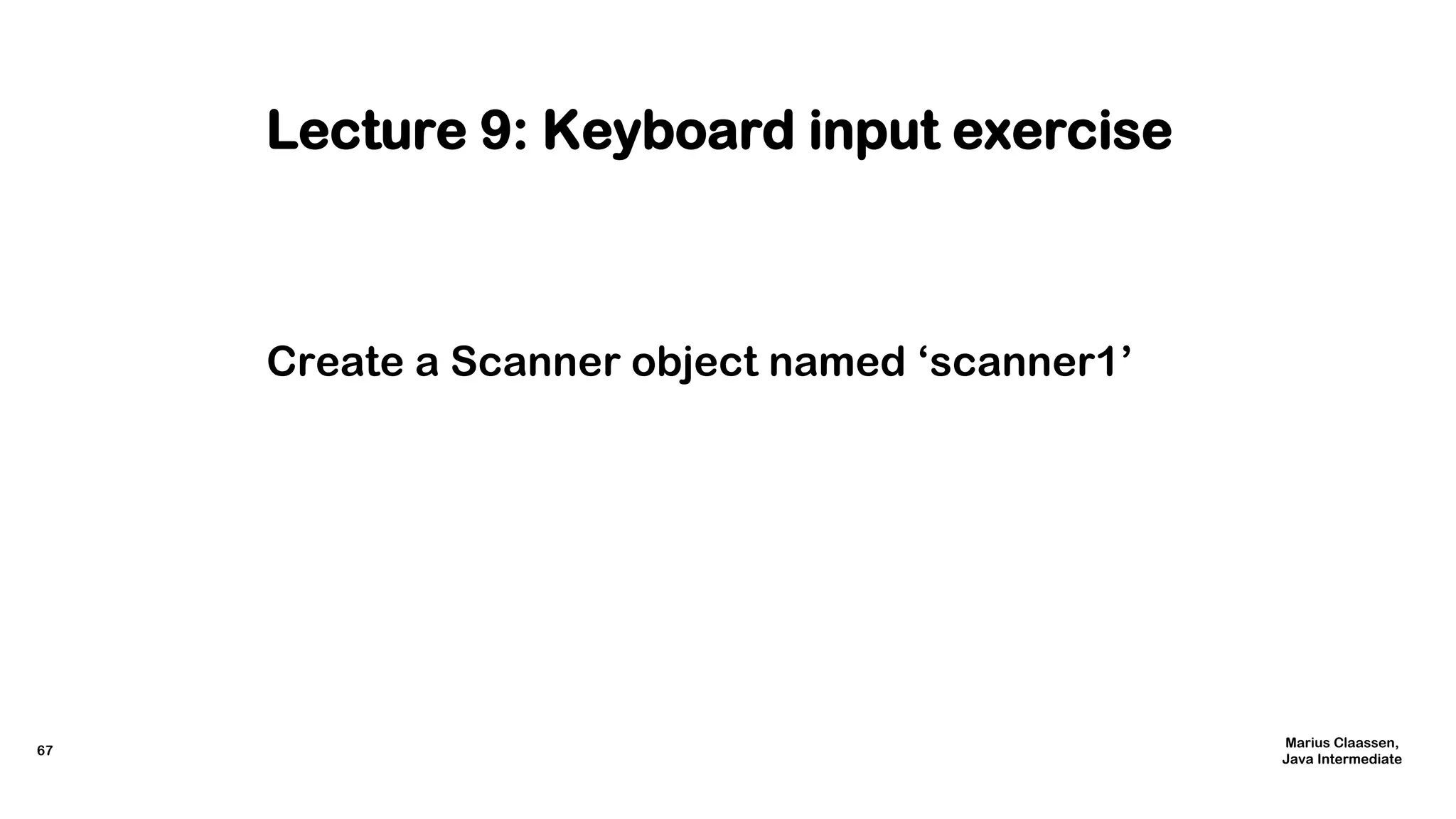
![Lecture 9: Keyboard input exercise
public class Lecture10 {
public static void main(String[] args) {
System.out.print(“Name the world’s most populous country ”);
// TODO: Create a Scanner object named ‘scanner1’
String largestPopulation = scanner1.next;
System.out.print(largestPopulation+“ has the largest population”); } }
68
Marius Claassen,
Java Intermediate](https://image.slidesharecdn.com/javaforintermediateusers-170912102557/75/Java-for-intermediate-users-68-2048.jpg)
![Lecture 10: Keyboard input solution
public class Lecture10 {
public static void main(String[] args) {
System.out.print(“Name the world’s most populous country ”);
Scanner scanner1 = new Scanner(System.in);
String largestPopulation = scanner1.next;
System.out.print(largestPopulation+“ has the largest population”); } }
// Name the world’s most populous country ***?
// China has the largest population
69
Marius Claassen,
Java Intermediate](https://image.slidesharecdn.com/javaforintermediateusers-170912102557/75/Java-for-intermediate-users-69-2048.jpg)
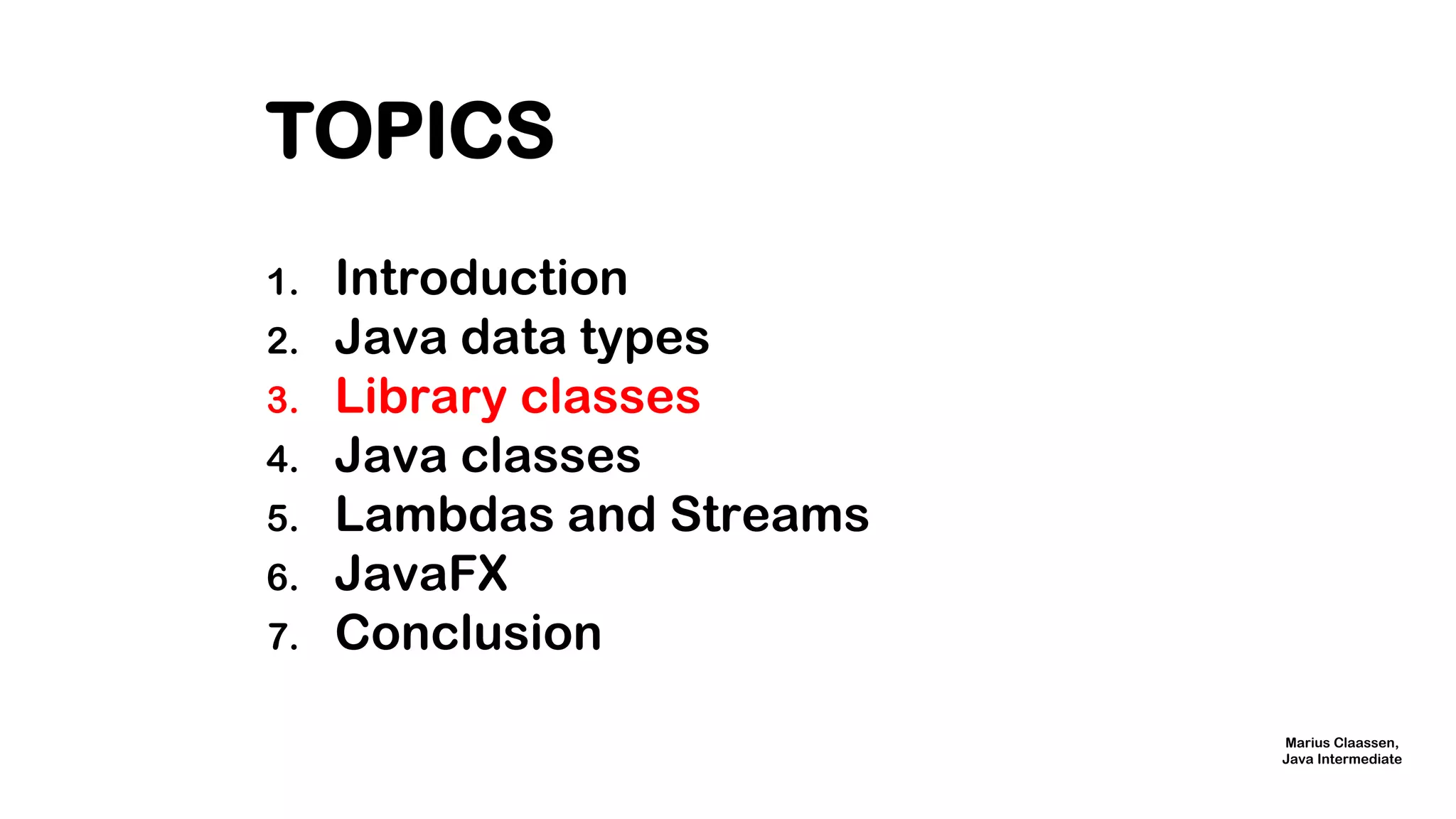
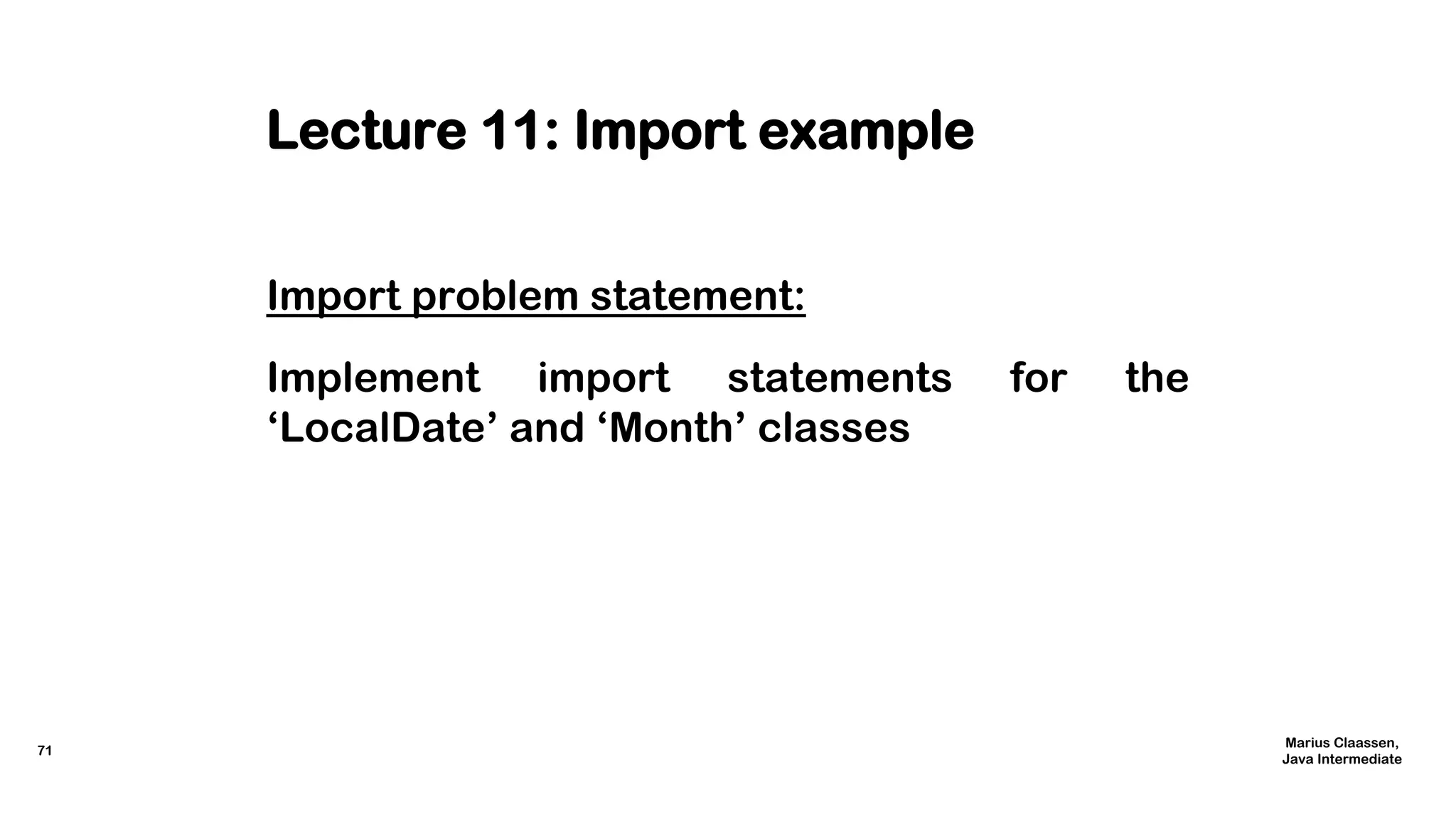
![Lecture 11: Import example
import java.time.LocalDate;
import java.time.Month;
public class Lecture11 {
public static void main(String[] args) {
LocalDate jdk1Release = LocalDate.of(1996, Month.JANUARY, 21);
System.out.print(“JDK 1.0 release date: ” + jdk1Release); } }
// JDK 1.0 release date: 1996-01-21
72
Marius Claassen,
Java Intermediate](https://image.slidesharecdn.com/javaforintermediateusers-170912102557/75/Java-for-intermediate-users-72-2048.jpg)
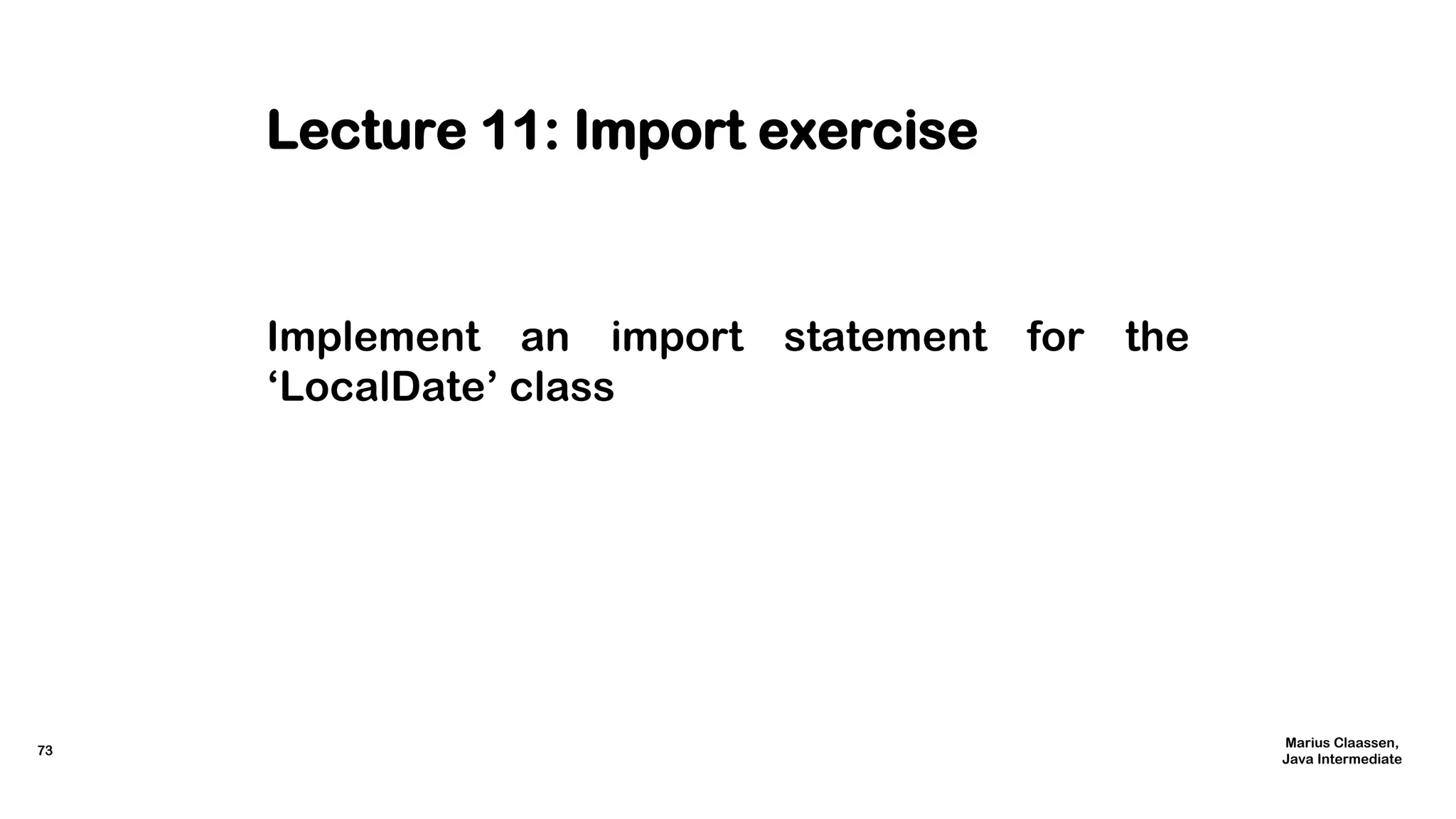
![Lecture 11: Import exercise
// TODO: Import the ‘LocalDate’ class
import java.time.Month;
public class Lecture12 {
public static void main(String[] args) {
LocalDate jdk9ReleaseDate
= LocalDate.of(2017, Month. SEPTEMBER, 21);
System.out.print(“JDK SE 9 release date: ” + jdk9ReleaseDate); } }
74
Marius Claassen,
Java Intermediate](https://image.slidesharecdn.com/javaforintermediateusers-170912102557/75/Java-for-intermediate-users-74-2048.jpg)
![Lecture 12: Import solution
import java.time.LocalDate;
import java.time.Month;
public class Lecture12 {
public static void main(String[] args) {
LocalDate jdk9ReleaseDate
= LocalDate.of(2017, Month. SEPTEMBER, 21);
System.out.print(“JDK SE 9 release date: ” + jdk9ReleaseDate); } }
75
Marius Claassen,
Java Intermediate](https://image.slidesharecdn.com/javaforintermediateusers-170912102557/75/Java-for-intermediate-users-75-2048.jpg)
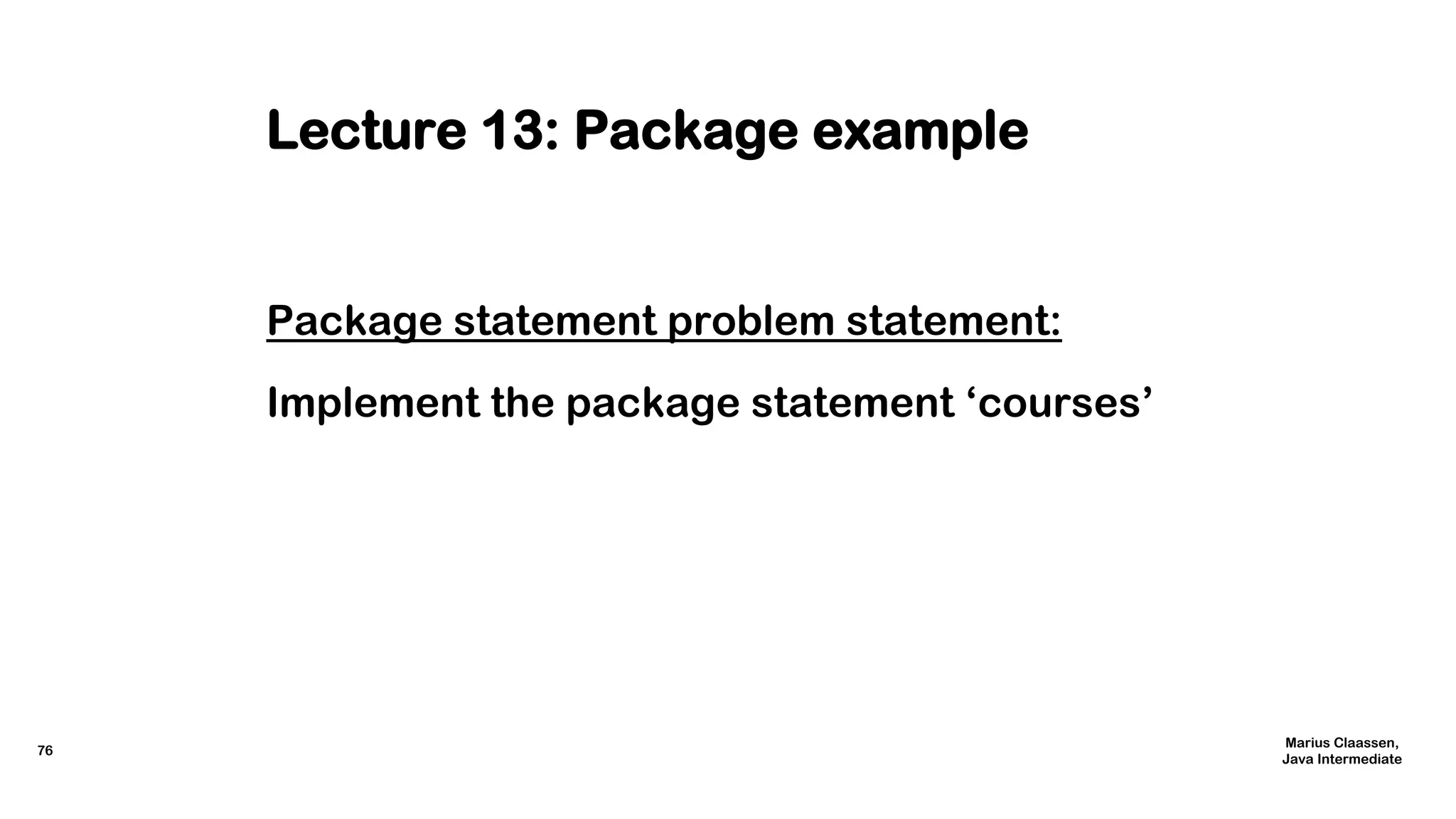
![Lecture 13: Package example
package courses;
public class Lecture13 {
public static void main(String[] args) {
BeginnerJava beginnerJava = new BeginnerJava();
beginnerJava.printBeginnerJava();
IntermediateJava intermediateJava = new IntermediateJava();
intermediateJava.printIntermediateJava(); } }
// Java Beginner course published
// Java Intermediate course completed
77
Marius Claassen,
Java Intermediate](https://image.slidesharecdn.com/javaforintermediateusers-170912102557/75/Java-for-intermediate-users-77-2048.jpg)
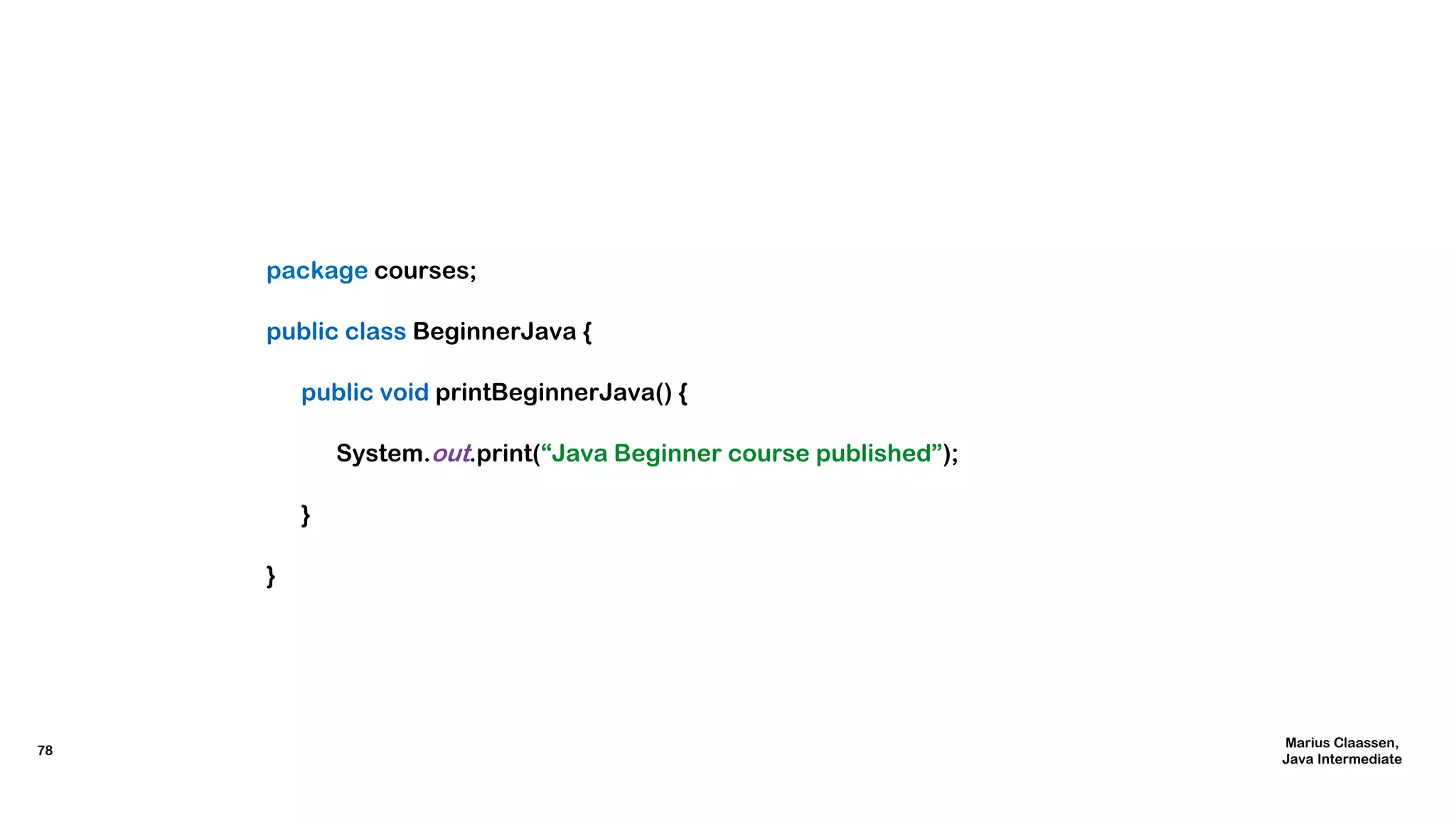
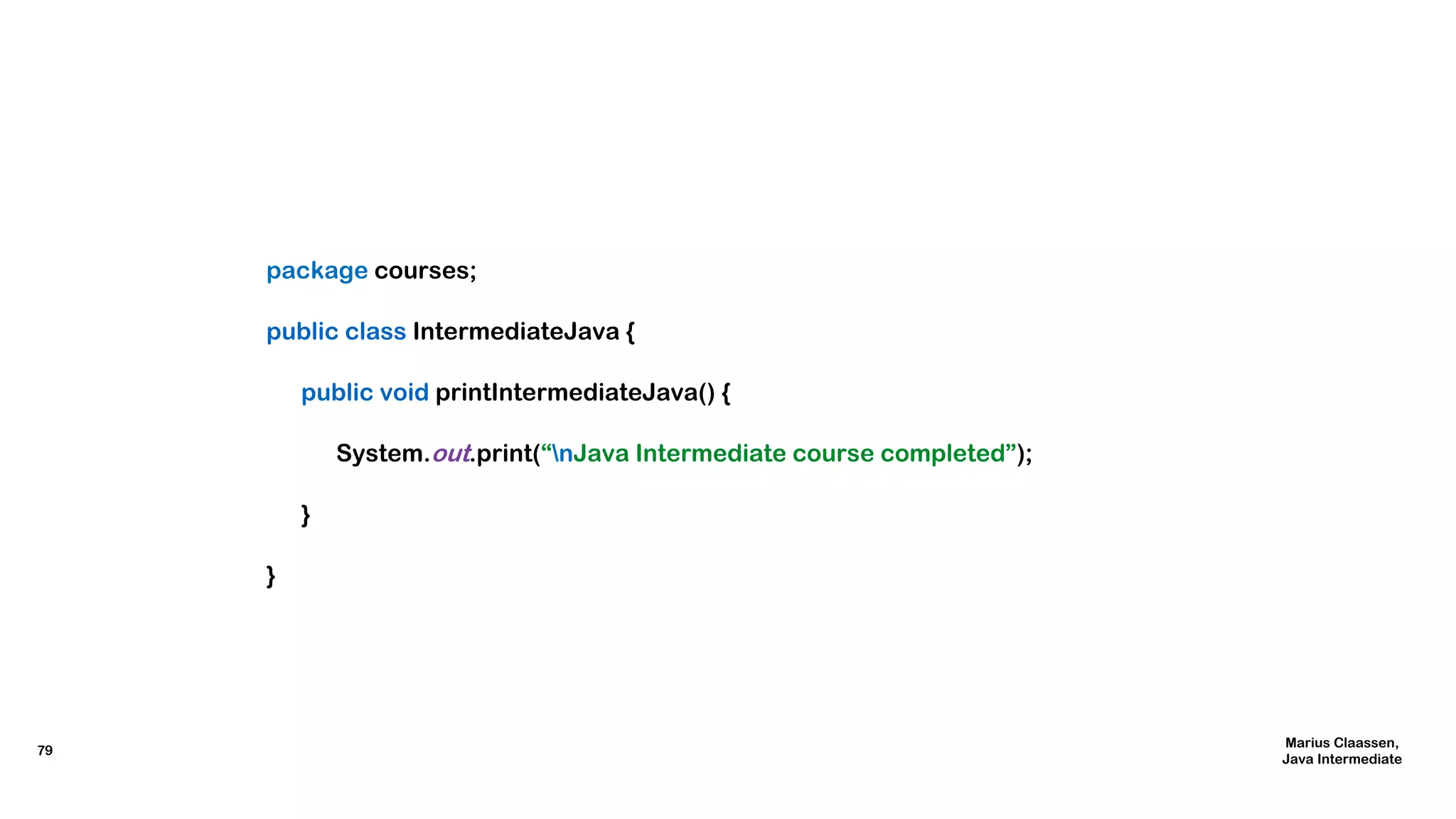
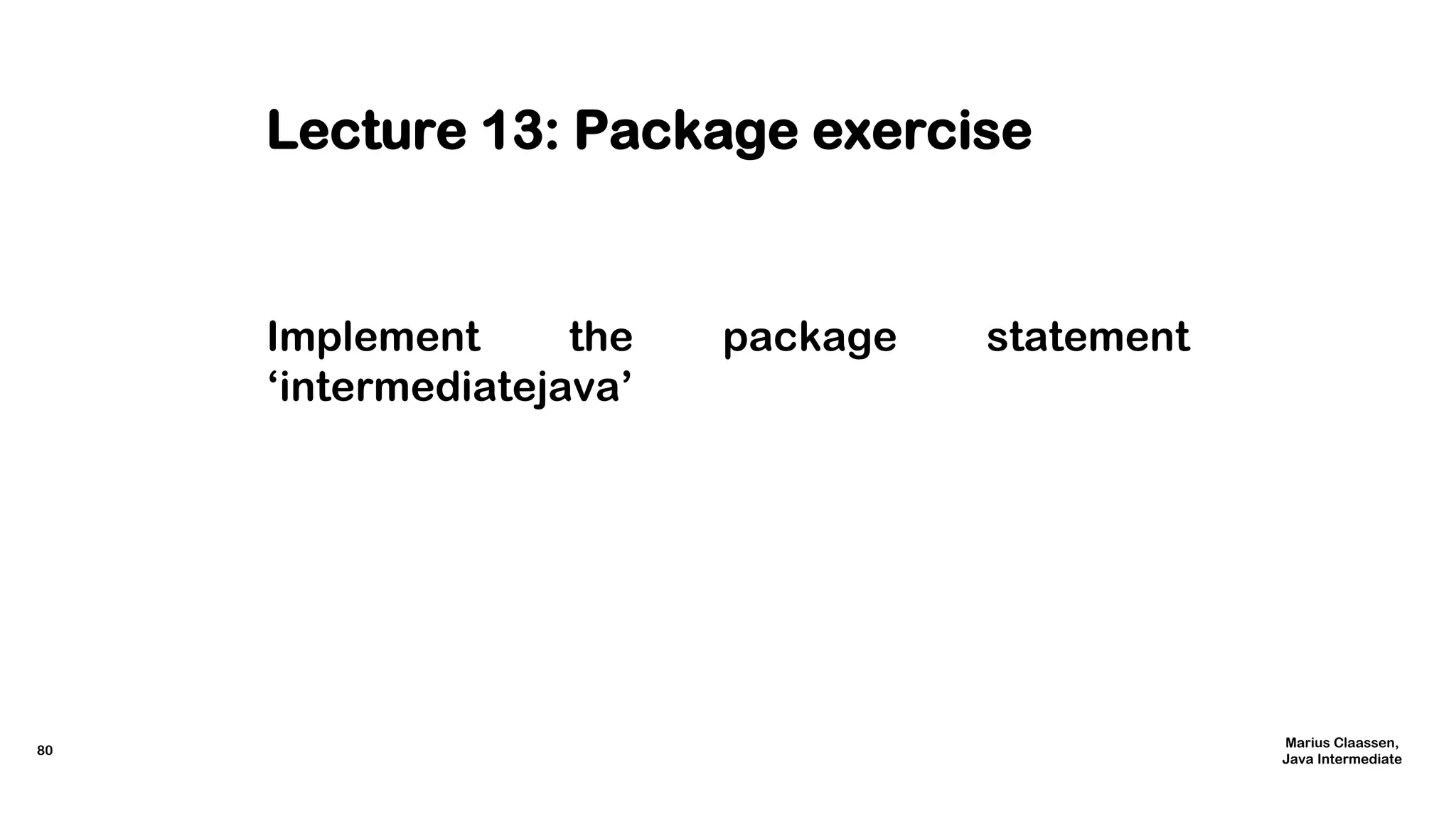
![Lecture 13: Package exercise
// TODO: Implement the package statement ‘intermediatejava’
public class Lecture14 {
public static void main(String[] args) {
Introduction introduction = new Introduction();
introduction.printIntroduction();
Contents contents = new Contents();
contents.printContents(); } }
81
Marius Claassen,
Java Intermediate](https://image.slidesharecdn.com/javaforintermediateusers-170912102557/75/Java-for-intermediate-users-81-2048.jpg)
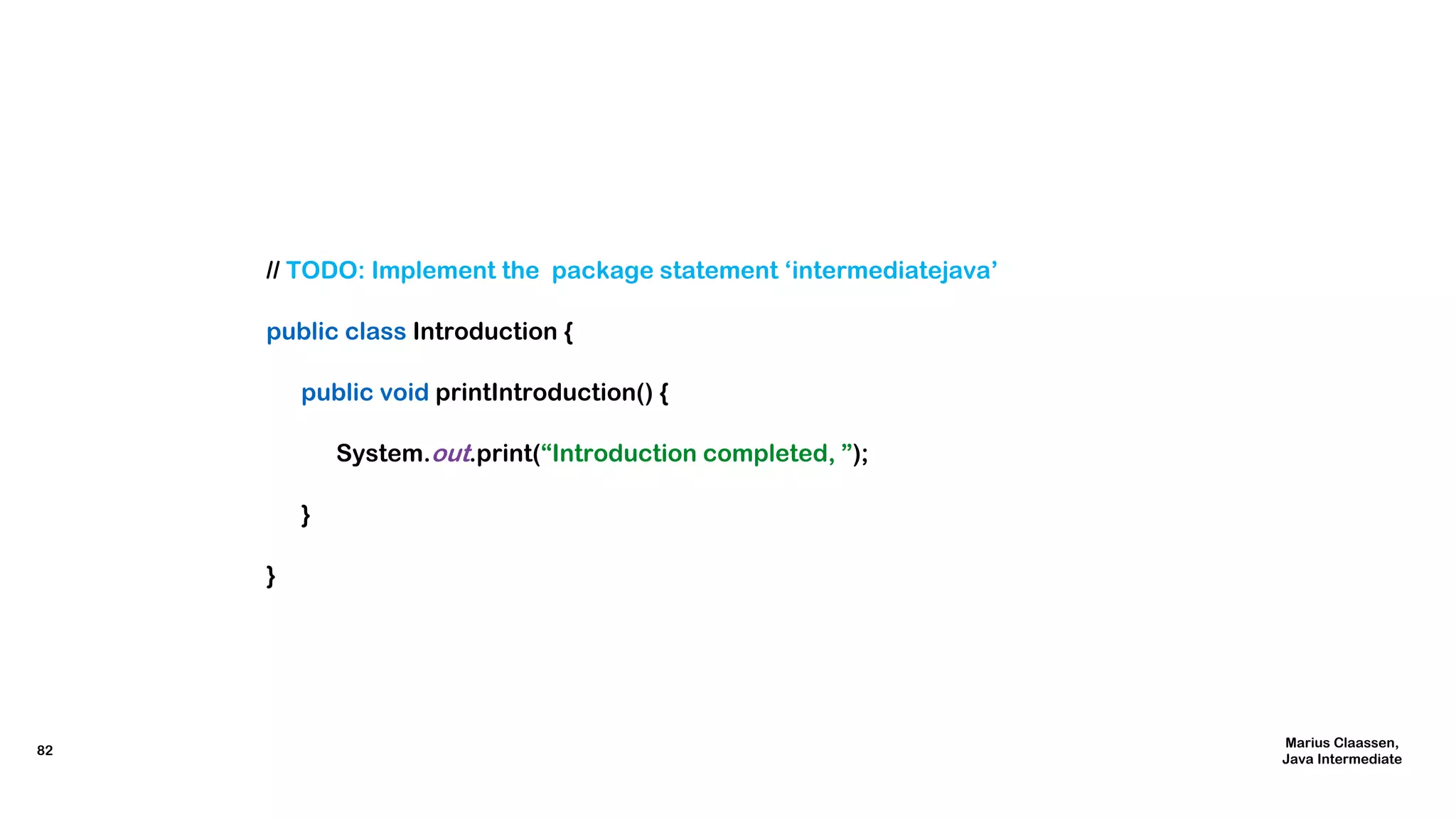
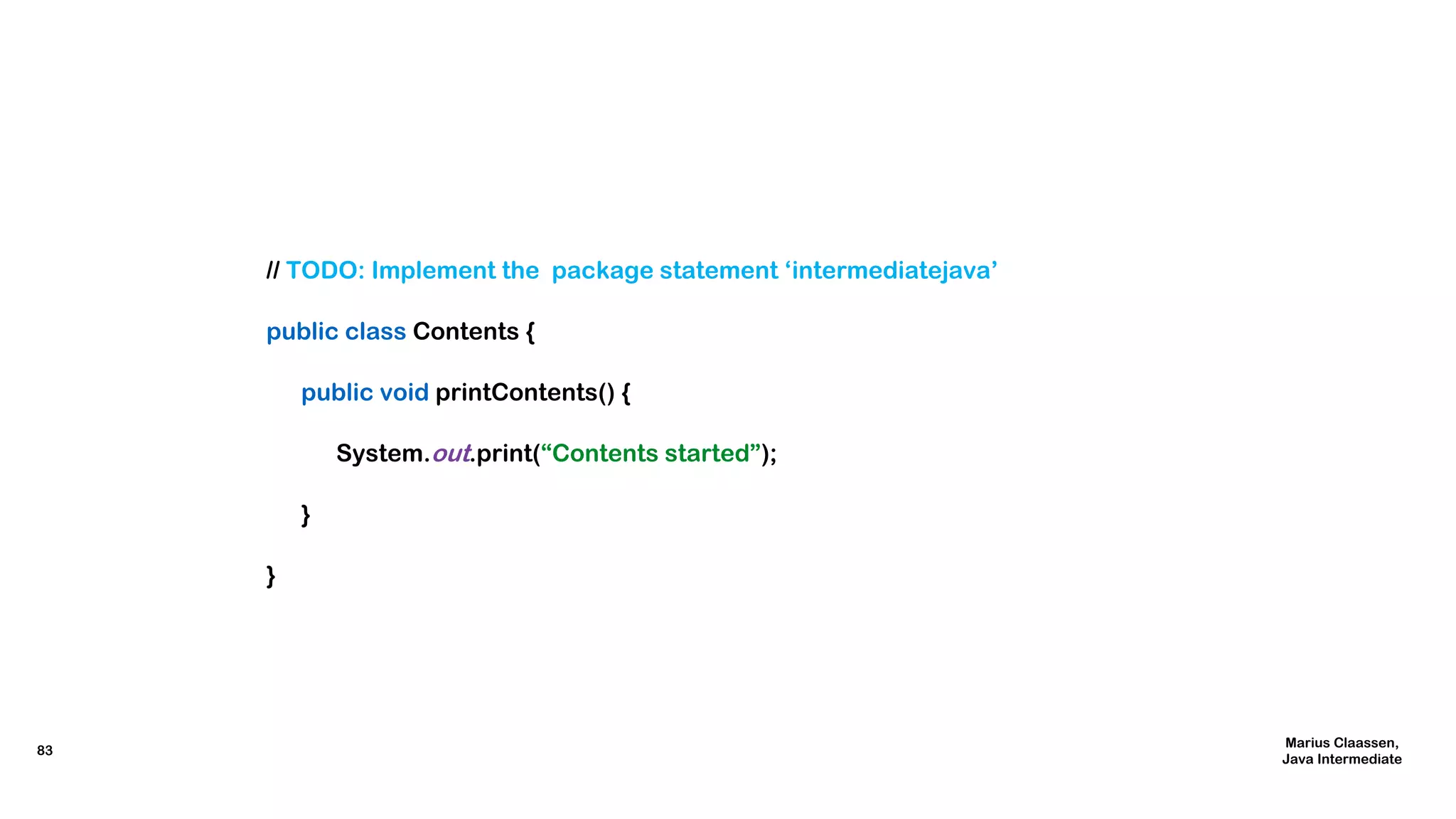
![Lecture 14: Package solution
package intermediatejava;
public class Lecture14 {
public static void main(String[] args) {
Introduction introduction = new Introduction();
introduction.printIntroduction();
Contents contents = new Contents();
contents.printContents(); } }
// Introduction completed, Contents started
84
Marius Claassen,
Java Intermediate](https://image.slidesharecdn.com/javaforintermediateusers-170912102557/75/Java-for-intermediate-users-84-2048.jpg)
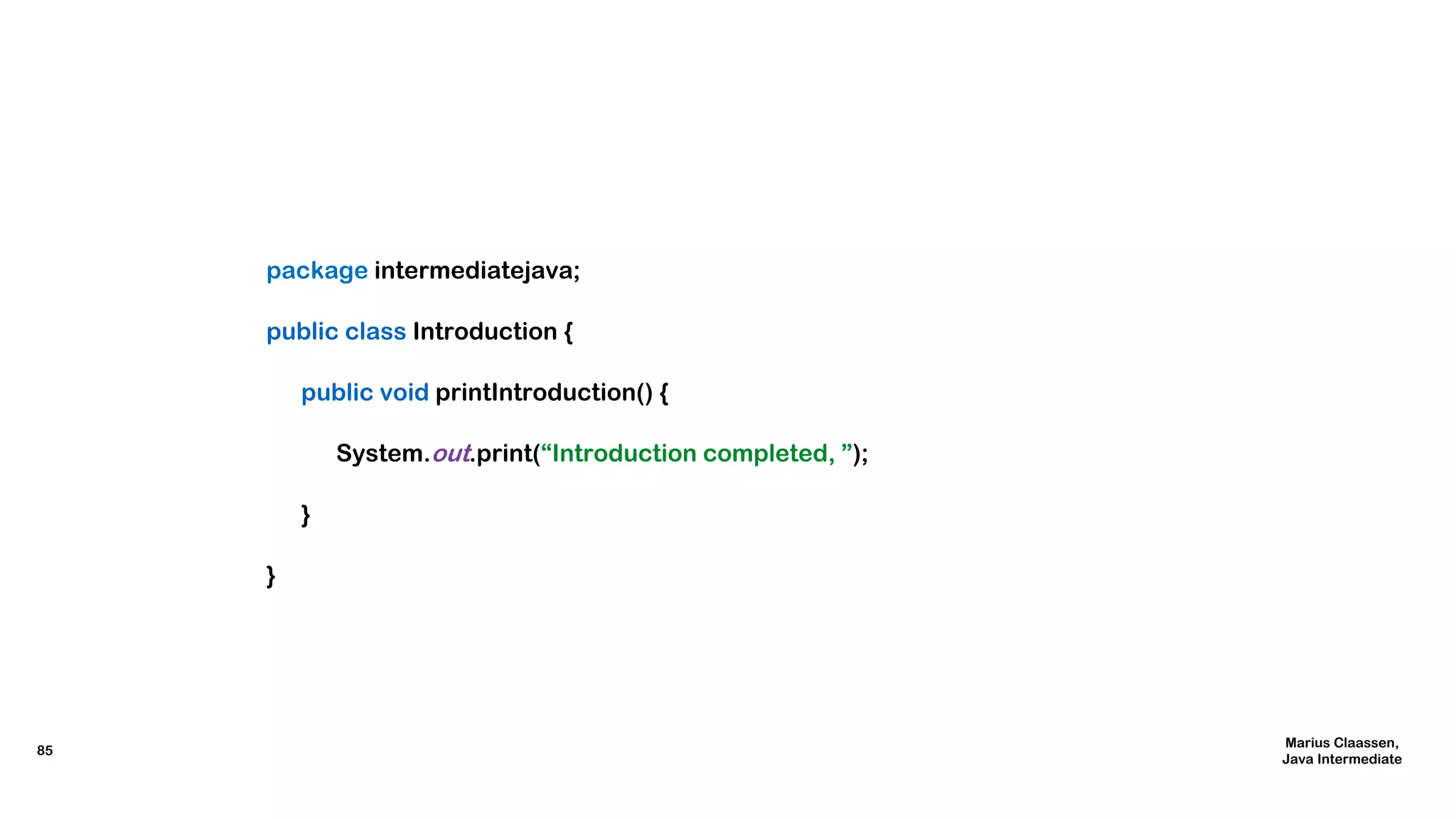
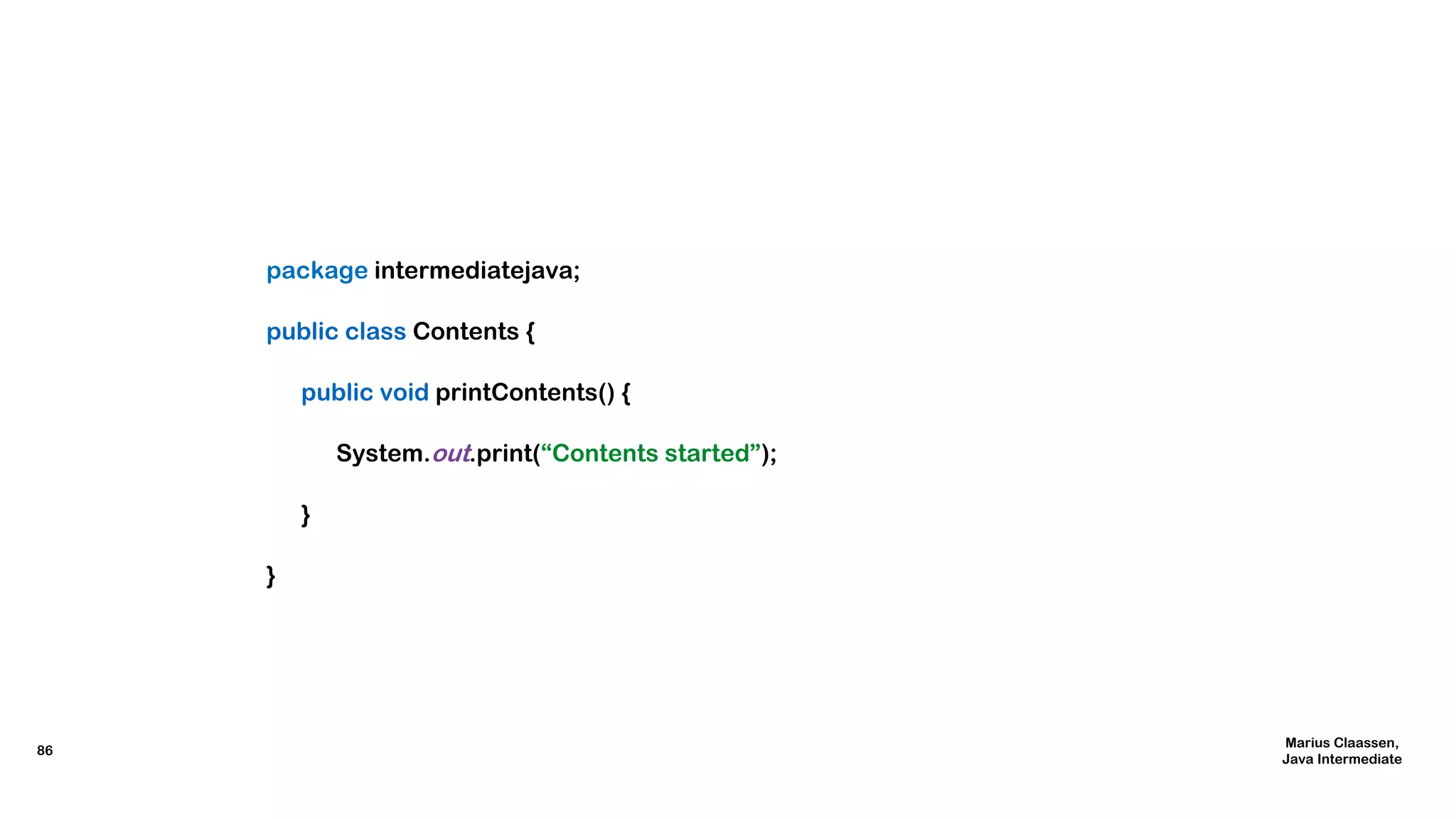
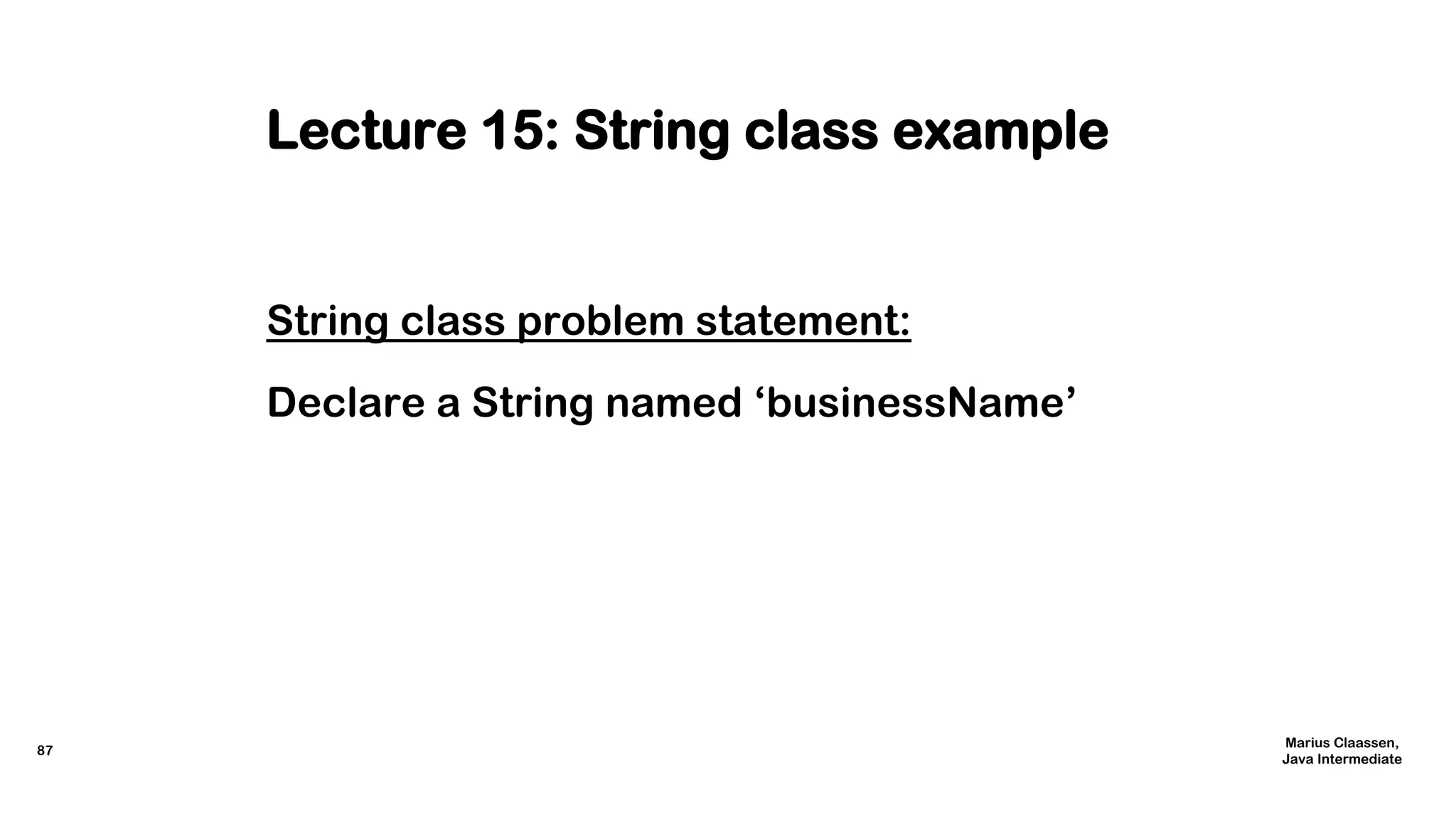
![Lecture 15: String class example
public class Lecture15 {
public static void main(String[] args) {
String businessName = “AlefTav Coding”;
System.out.print(“My business is named ” + businessName);
}
}
// My business is named AlefTav Coding
88
Marius Claassen,
Java Intermediate](https://image.slidesharecdn.com/javaforintermediateusers-170912102557/75/Java-for-intermediate-users-88-2048.jpg)
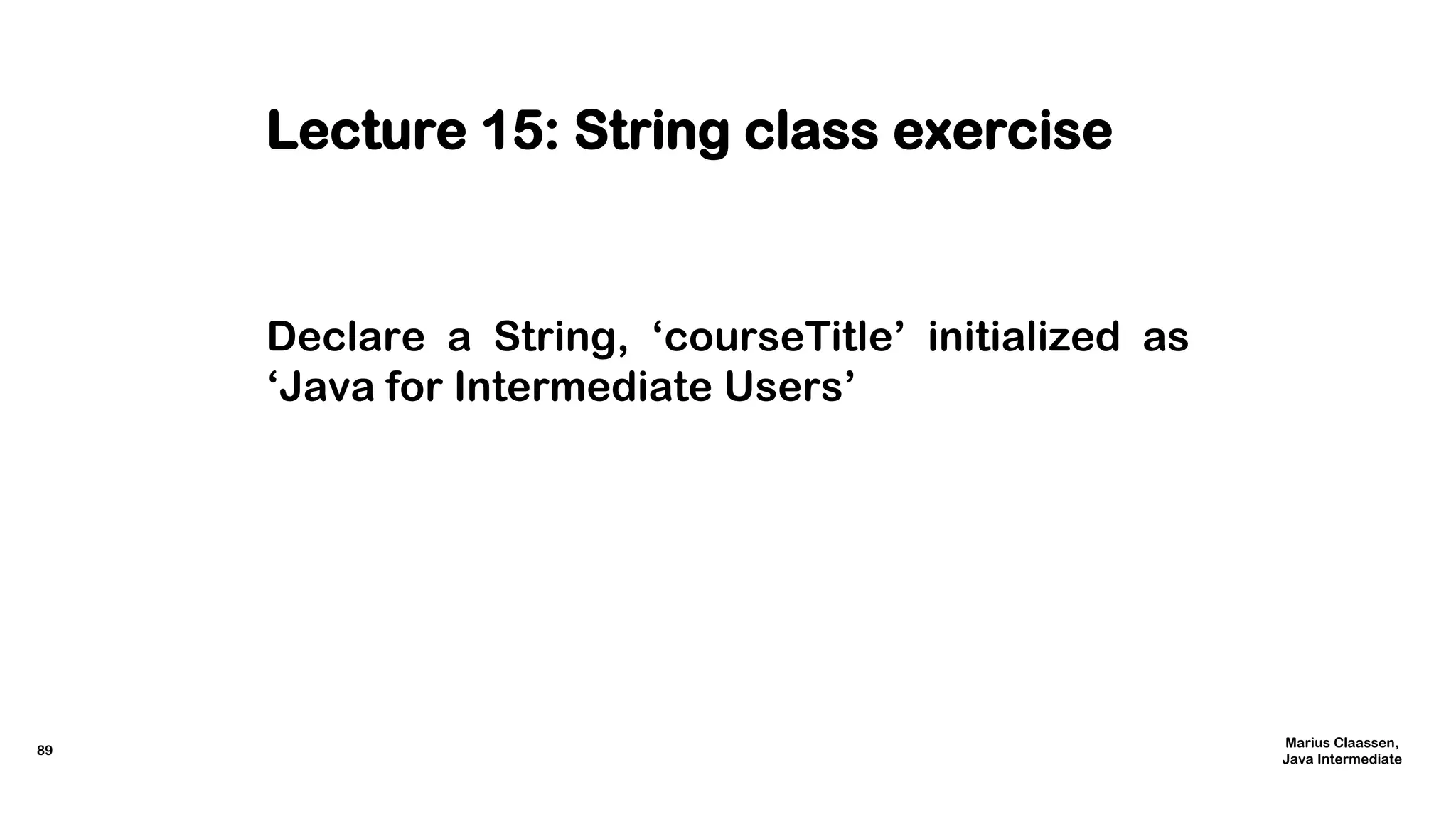
![Lecture 15: String class exercise
public class Lecture16 {
public static void main(String[] args) {
// TODO: Declare a String, ‘courseTitle’ initialized as ‘Java for
// Intermediate Users’
System.out.print(“The title of this course: ” + courseTitle);
}
}
90
Marius Claassen,
Java Intermediate](https://image.slidesharecdn.com/javaforintermediateusers-170912102557/75/Java-for-intermediate-users-90-2048.jpg)
![Lecture 16: String class solution
public class Lecture16 {
public static void main(String[] args) {
String courseTitle = “Java for Intermediate Users”;
System.out.print(“The title of this course is ” + courseTitle);
}
}
// The title of this course is Java for Intermediate Users
91
Marius Claassen,
Java Intermediate](https://image.slidesharecdn.com/javaforintermediateusers-170912102557/75/Java-for-intermediate-users-91-2048.jpg)
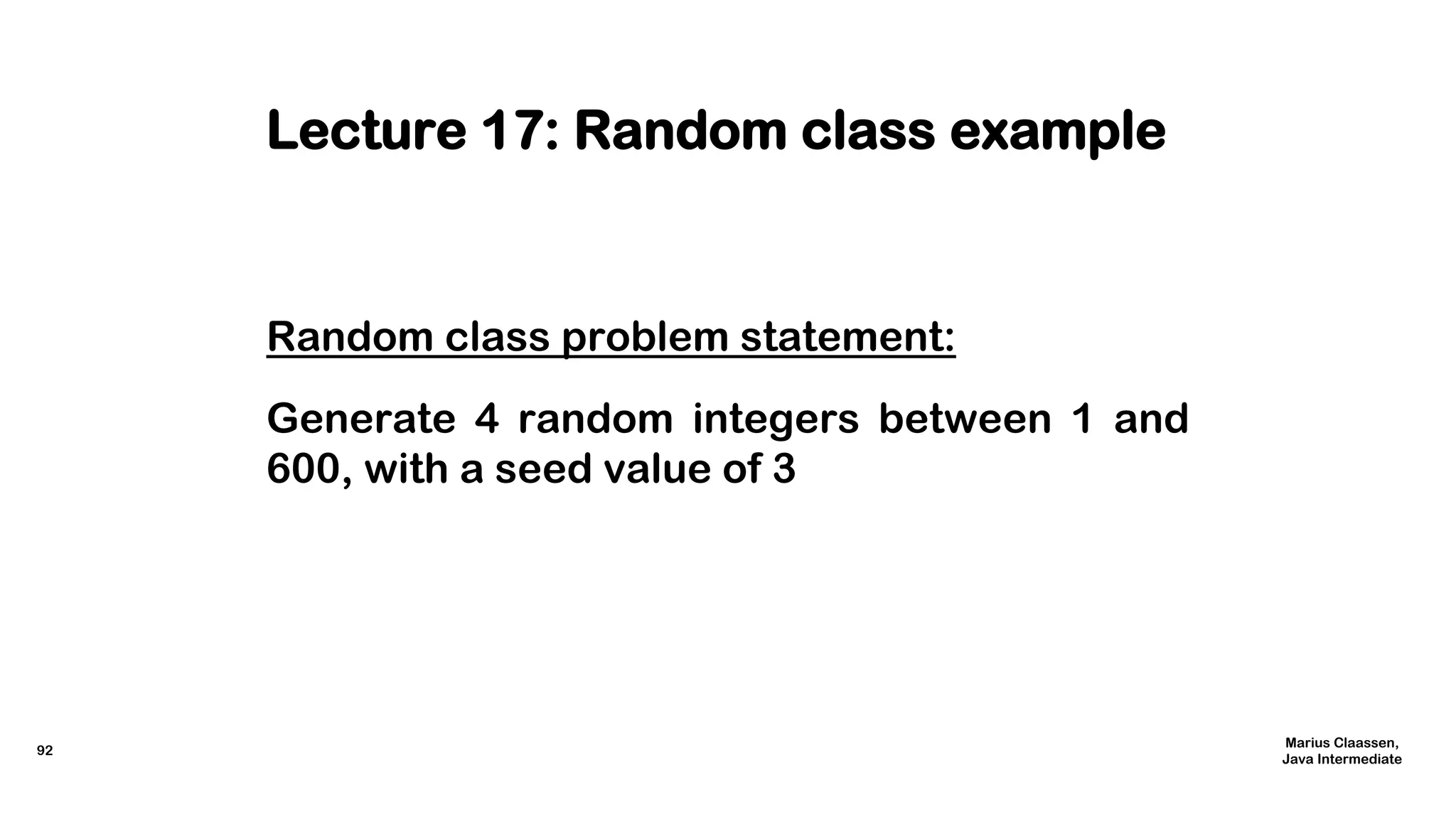
![Lecture 17: Random class example
public class Lecture17 {
public static void main(String[] args) {
Random random = new Random(3);
System.out.print(“Four random integers between 1 and 600: ”);
for (int i = 0; i < 4; i++) { System.out.print(random.nextInt(600) + “ ”); }
}
}
// Four random integers between 1 and 600: 134 260 210 181
93
Marius Claassen,
Java Intermediate](https://image.slidesharecdn.com/javaforintermediateusers-170912102557/75/Java-for-intermediate-users-93-2048.jpg)
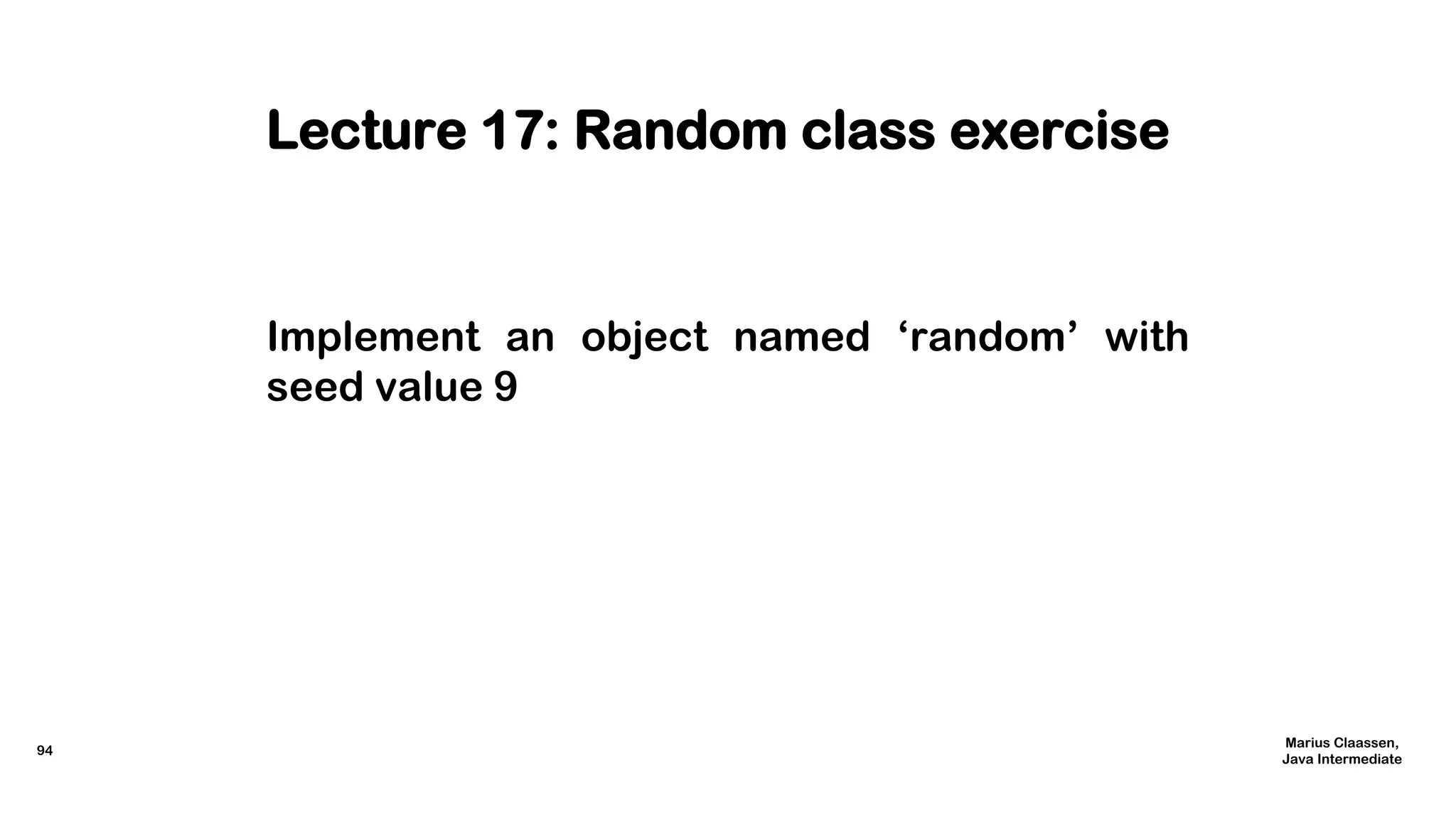
![Lecture 17: Random class exercise
public class Lecture18 {
public static void main(String[] args) {
// TODO: Implement an object named, ‘random’ with seed value 9
System.out.print(“Five random integers between 1 and 200: ”);
for (int i = 0; i < 5; i++) { System.out.print(random.nextInt(200) + “ ”); }
}
}
95
Marius Claassen,
Java Intermediate](https://image.slidesharecdn.com/javaforintermediateusers-170912102557/75/Java-for-intermediate-users-95-2048.jpg)
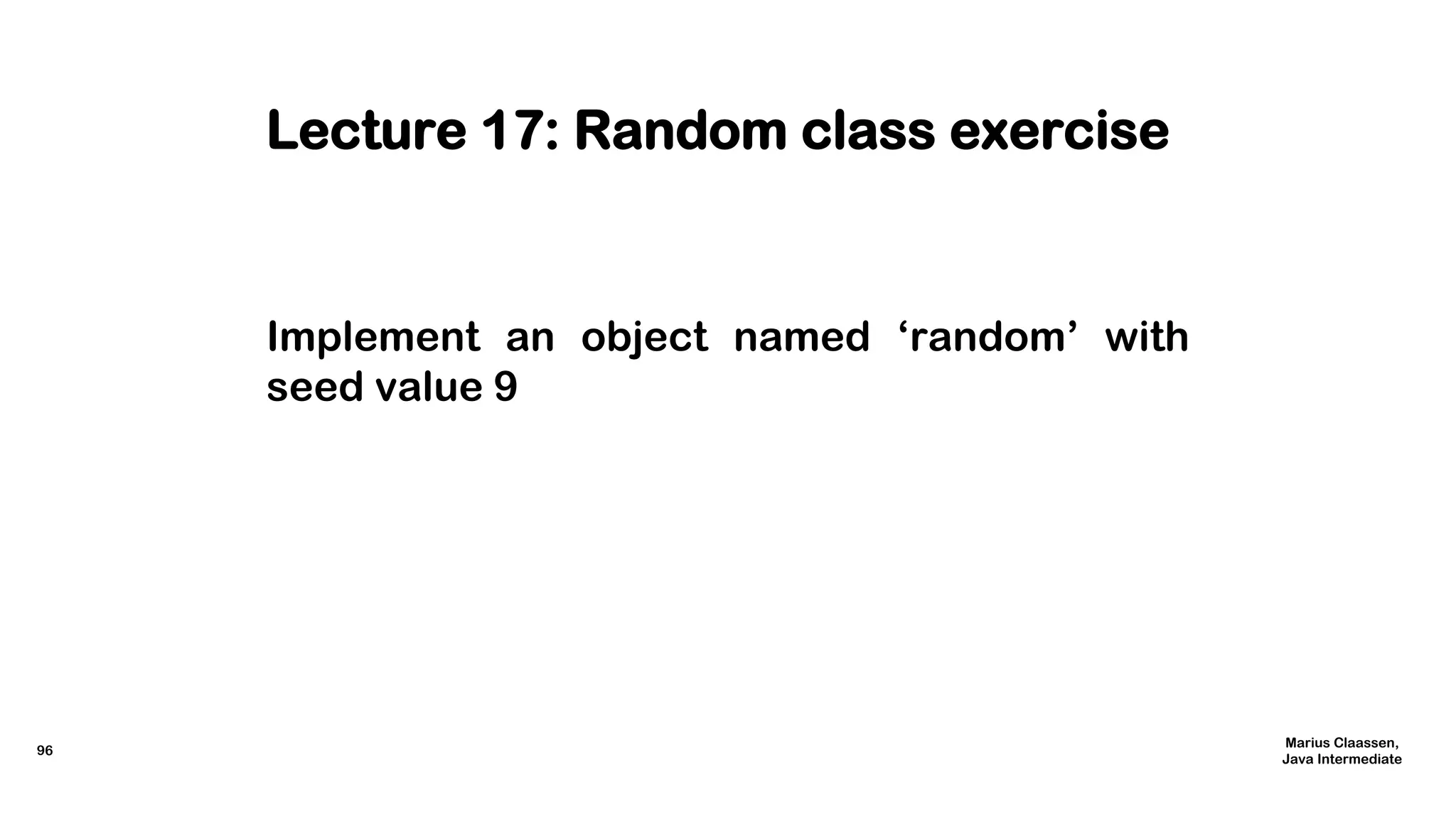
![Lecture 17: Random class exercise
public class Lecture18 {
public static void main(String[] args) {
// TODO: Implement an object named, ‘random’ with seed value 9
System.out.print(“Five random integers between 1 and 200: ”);
for (int i = 0; i < 5; i++) { System.out.print(random.nextInt(200) + “ ”); }
}
}
97
Marius Claassen,
Java Intermediate](https://image.slidesharecdn.com/javaforintermediateusers-170912102557/75/Java-for-intermediate-users-97-2048.jpg)
![Lecture 18: Random class solution
public class Lecture18 {
public static void main(String[] args) {
Random random = new Random(9);
System.out.print(“Five random integers between 1 and 200: ”);
for (int i = 0; i < 5; i++) { System.out.print(random.nextInt(200) + “ ”); }
}
}
// Five random integers between 1 and 200: 189 196 148 135 159
98
Marius Claassen,
Java Intermediate](https://image.slidesharecdn.com/javaforintermediateusers-170912102557/75/Java-for-intermediate-users-98-2048.jpg)
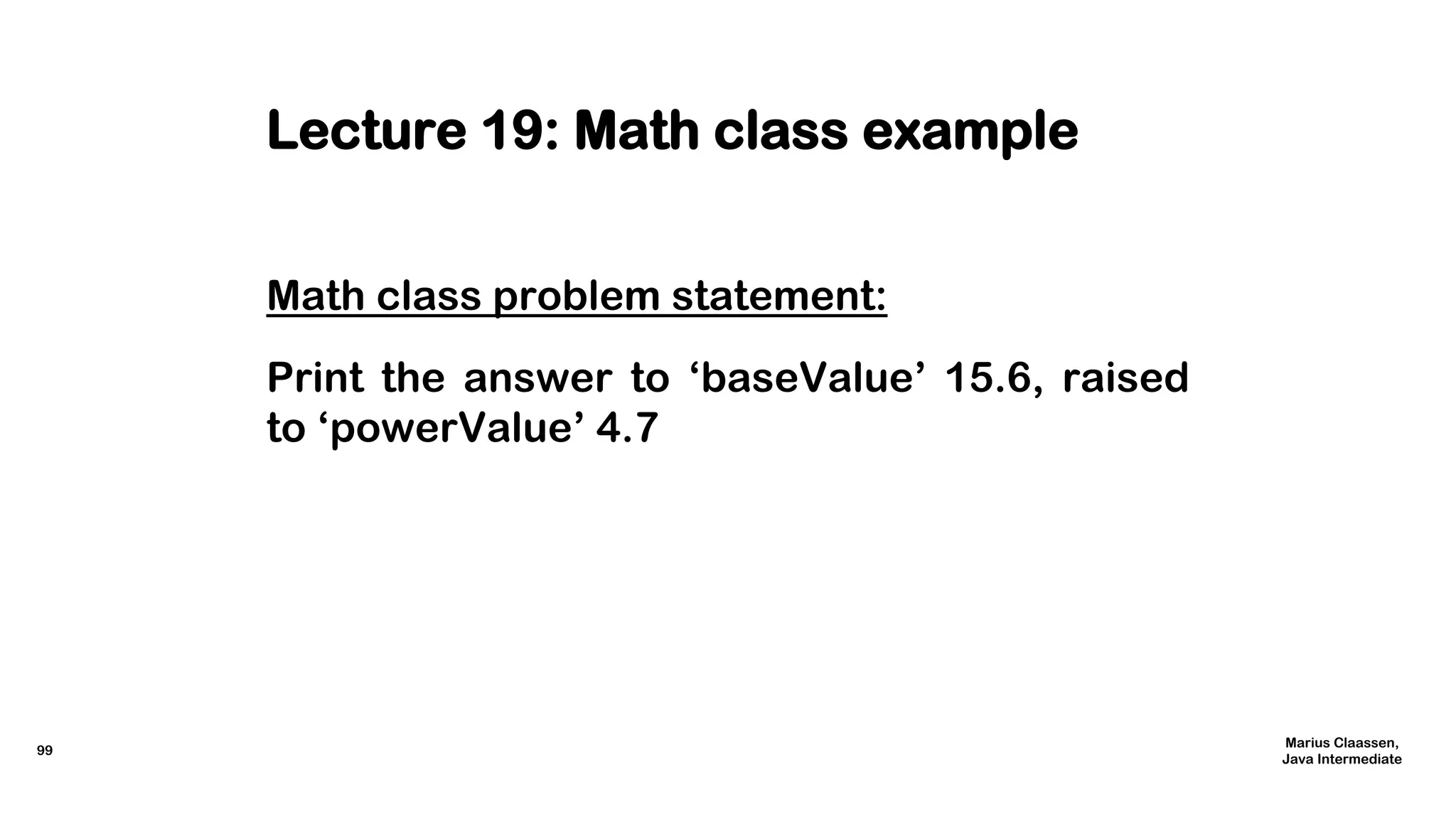
![Lecture 19: Math class example
public class Lecture19 {
public static void main(String[] args) {
double baseValue = 15.6;
double powerValue = 4.7;
System.out.printf(“15.6⁴˙⁷: %.3f” + Math.pow(baseValue, powerValue));
}
}
// 405215.092
100
Marius Claassen,
Java Intermediate](https://image.slidesharecdn.com/javaforintermediateusers-170912102557/75/Java-for-intermediate-users-100-2048.jpg)
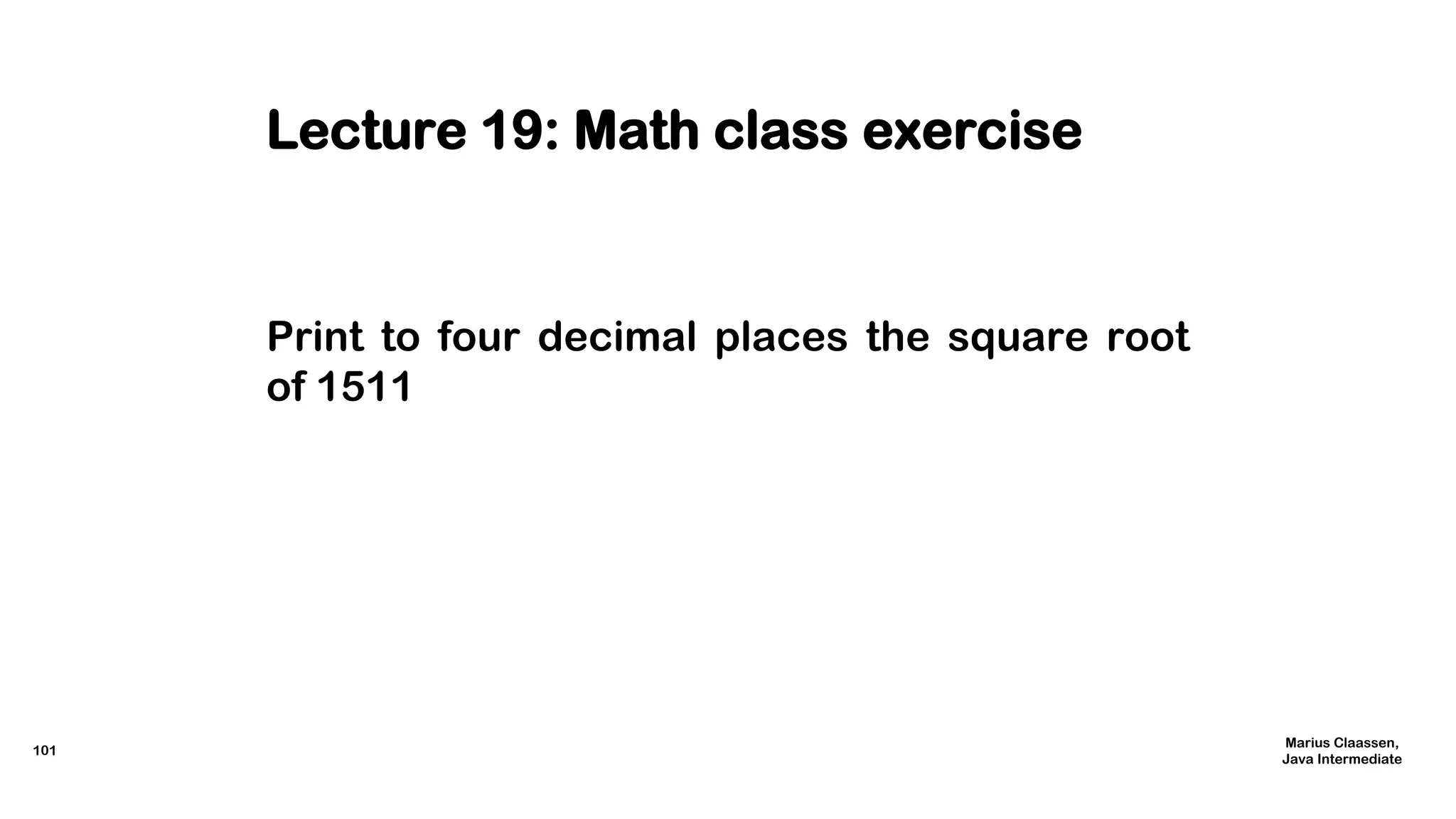
![Lecture 19: Math class exercise
public class Lecture20 {
public static void main(String[] args) {
double x = 1511;
// TODO: Print to 4 decimal places the square root of 1511
}
}
102
Marius Claassen,
Java Intermediate](https://image.slidesharecdn.com/javaforintermediateusers-170912102557/75/Java-for-intermediate-users-102-2048.jpg)
![Lecture 20: Math class solution
public class Lecture20 {
public static void main(String[] args) {
double x = 1511;
System.out.printf(“%.4f”, Math.sqrt(x));
}
}
// 38.8716
103
Marius Claassen,
Java Intermediate](https://image.slidesharecdn.com/javaforintermediateusers-170912102557/75/Java-for-intermediate-users-103-2048.jpg)
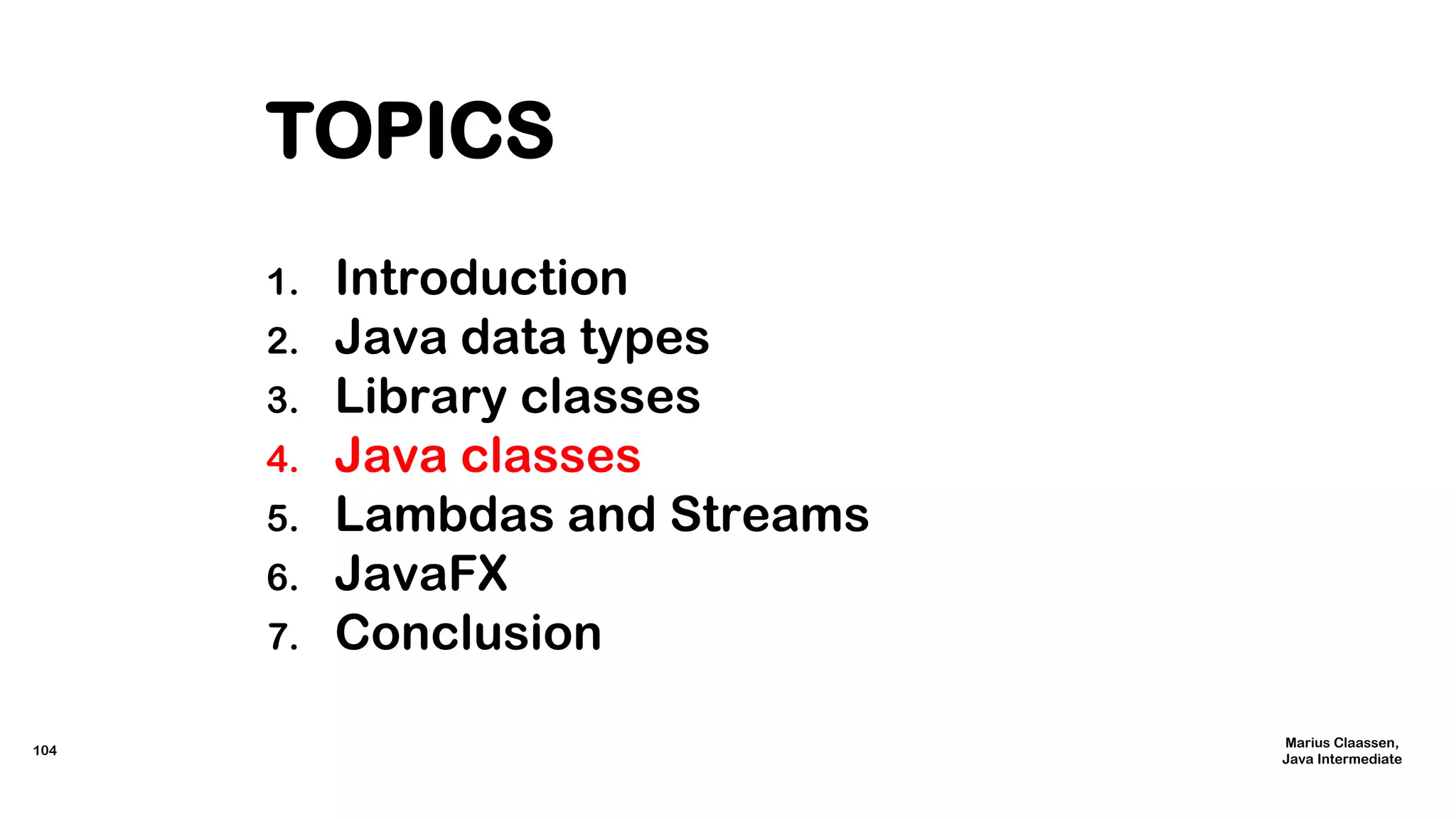
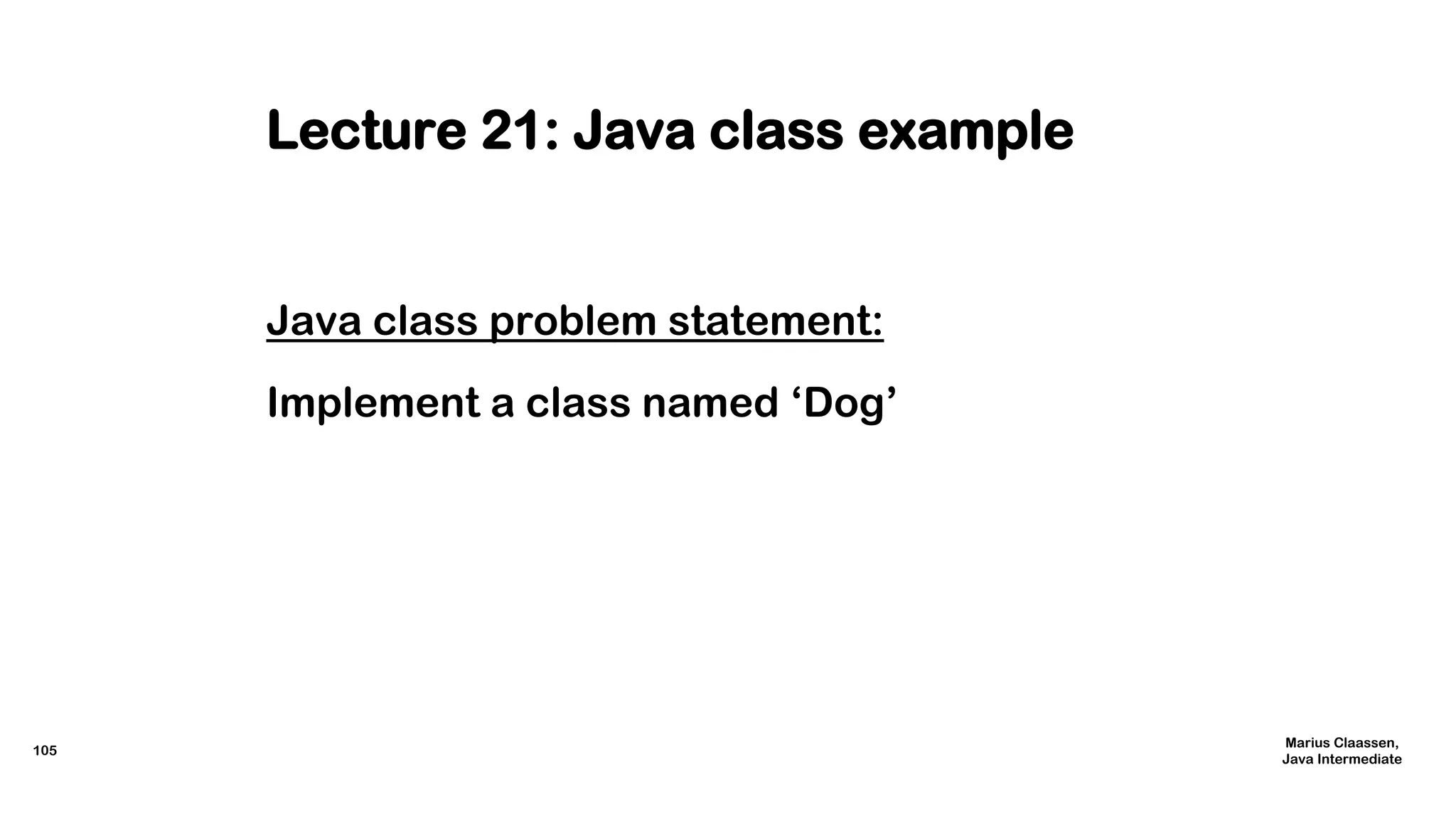
![Lecture 21: Java class example
public class Lecture21 {
public static void main(String[] args) {
Dog dog1 = new Dog();
dog1.getName();
}
}
// The dog’s name is ‘Faithful’.
106
Marius Claassen,
Java Intermediate](https://image.slidesharecdn.com/javaforintermediateusers-170912102557/75/Java-for-intermediate-users-106-2048.jpg)
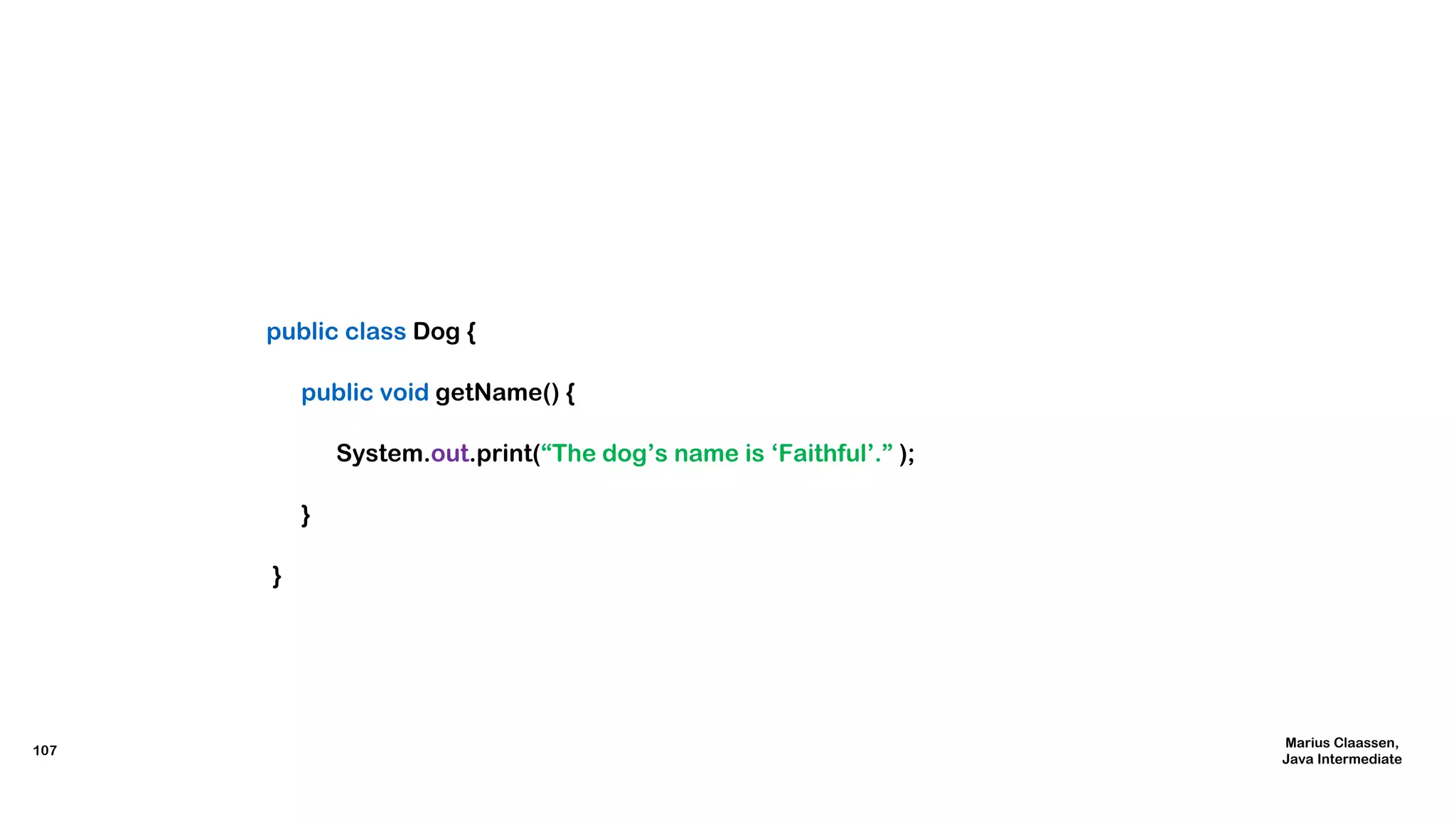
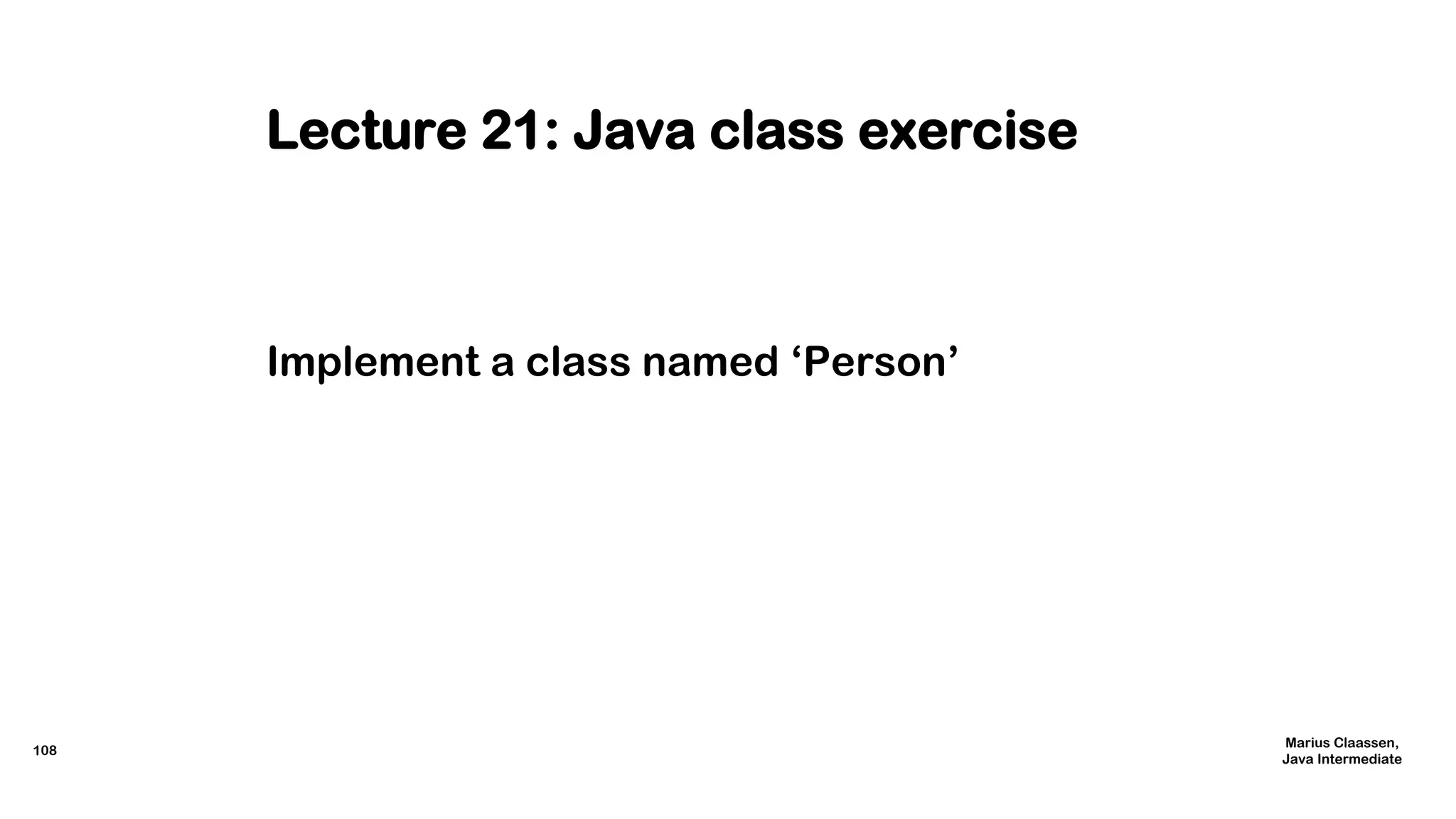
![Lecture 21: Java class exercise
public class Lecture22 {
public static void main(String[] args) {
Person person1 = new Person();
person1.saySomething();
}
}
109
Marius Claassen,
Java Intermediate](https://image.slidesharecdn.com/javaforintermediateusers-170912102557/75/Java-for-intermediate-users-109-2048.jpg)
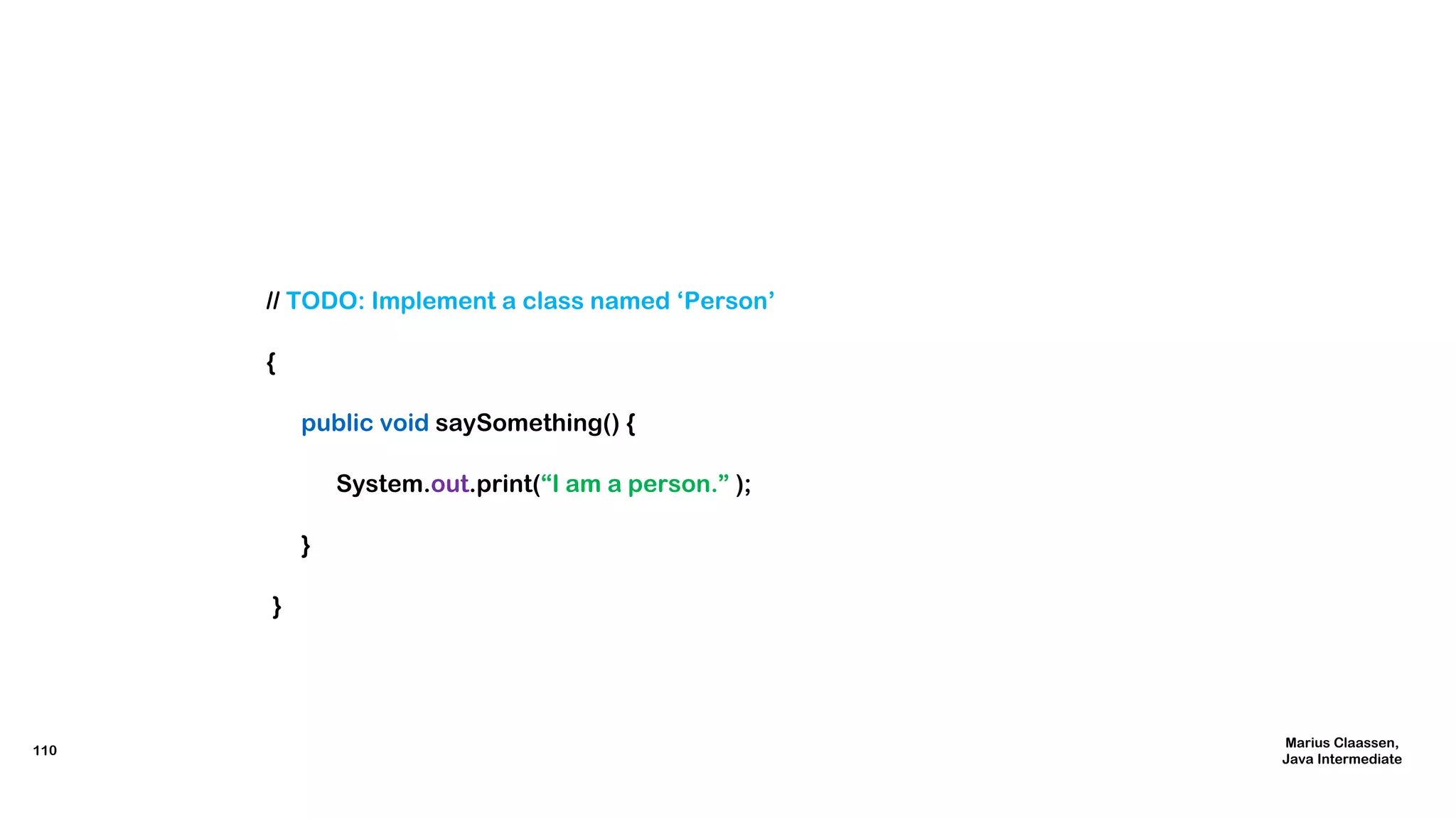
![Lecture 22: Java class solution
public class Lecture22 {
public static void main(String[] args) {
Person person1 = new Person();
person1.saySomething();
}
}
// I am a person.
111
Marius Claassen,
Java Intermediate](https://image.slidesharecdn.com/javaforintermediateusers-170912102557/75/Java-for-intermediate-users-111-2048.jpg)
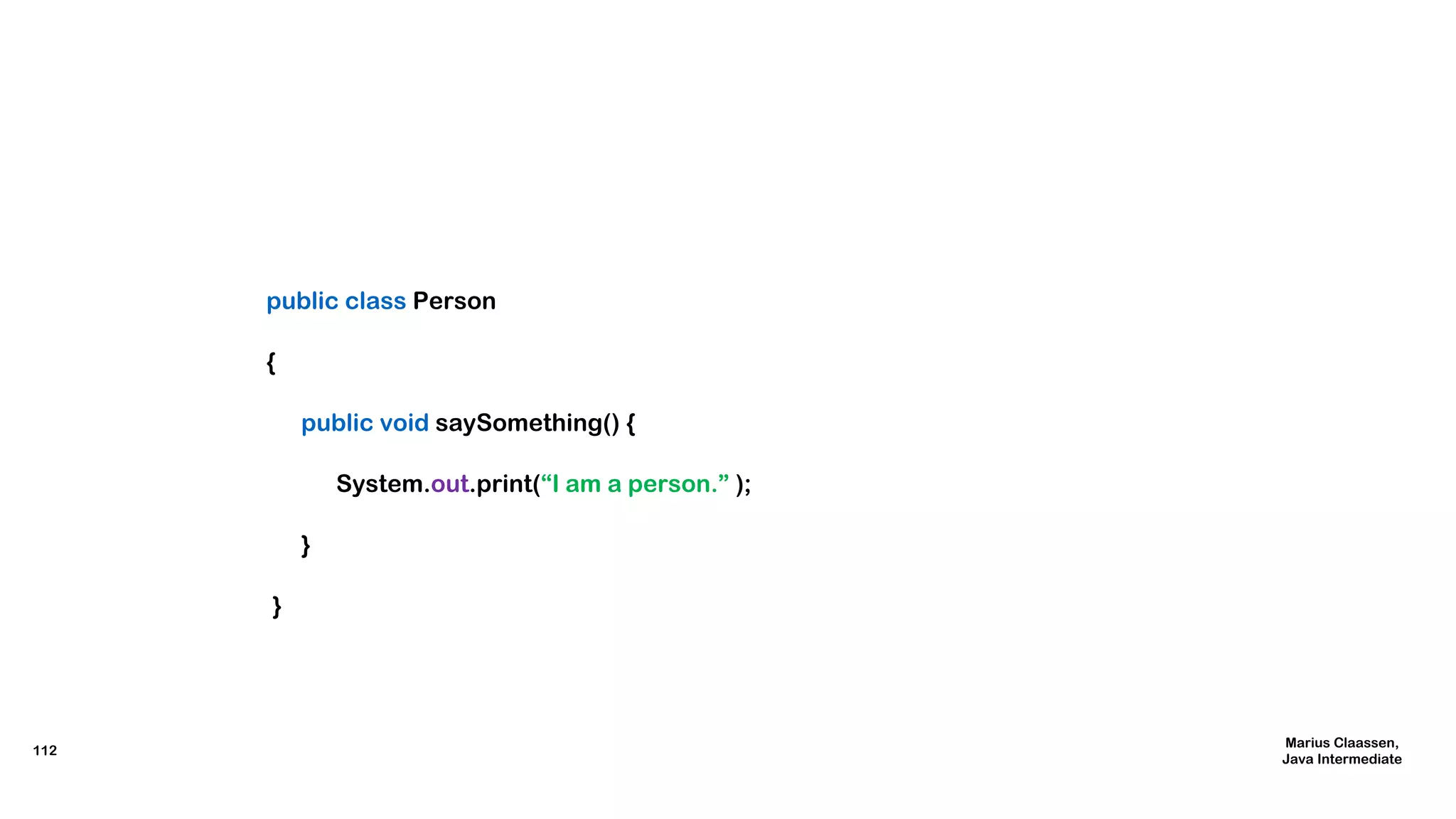
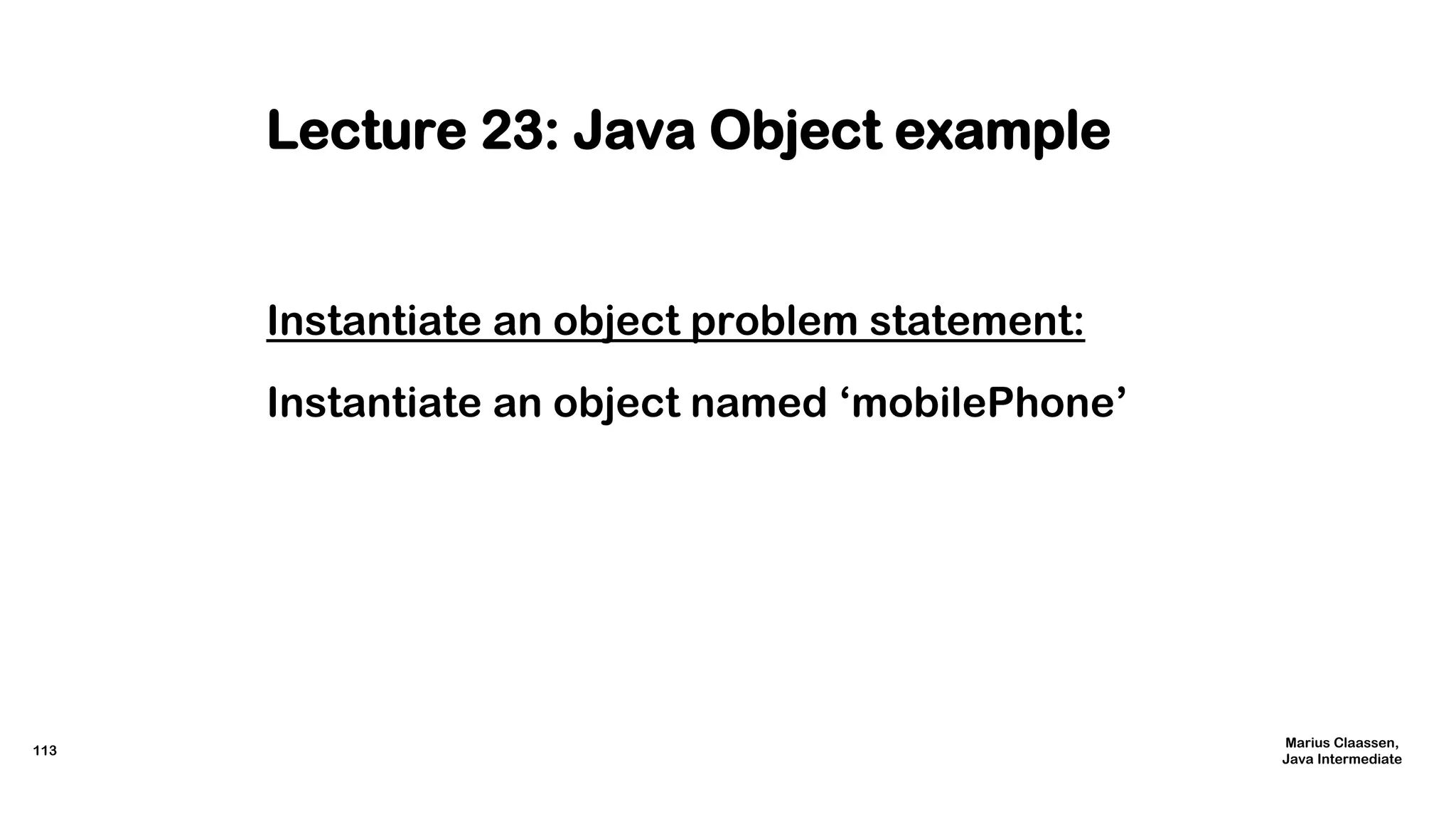
![Lecture 23: Java Object example
public class Lecture23 {
public static void main(String[] args) {
MobilePhone mobilePhone = new MobilePhone();
mobilePhone.getName();
}
}
// Samsung or iPhone
114
Marius Claassen,
Java Intermediate](https://image.slidesharecdn.com/javaforintermediateusers-170912102557/75/Java-for-intermediate-users-114-2048.jpg)
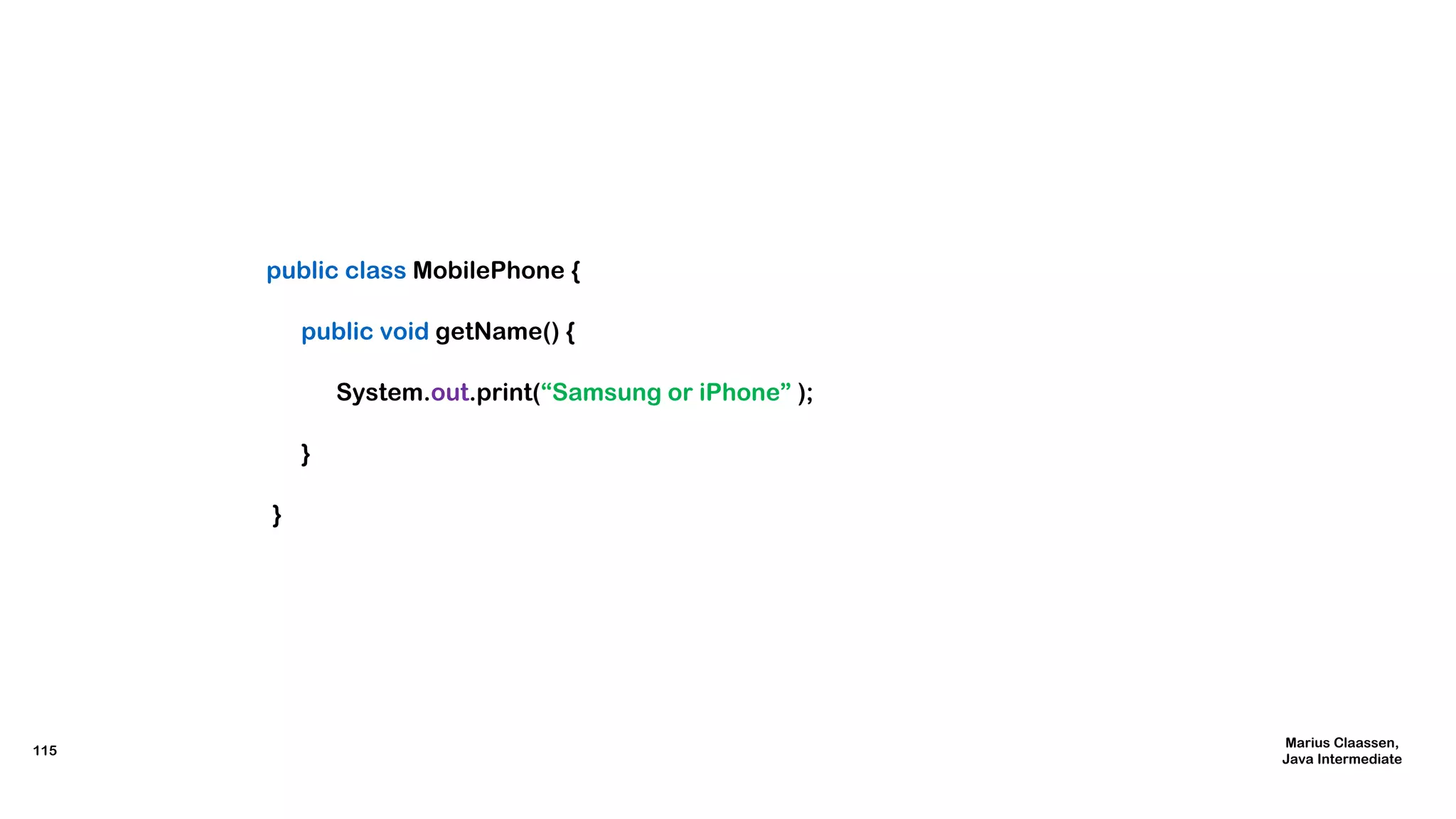
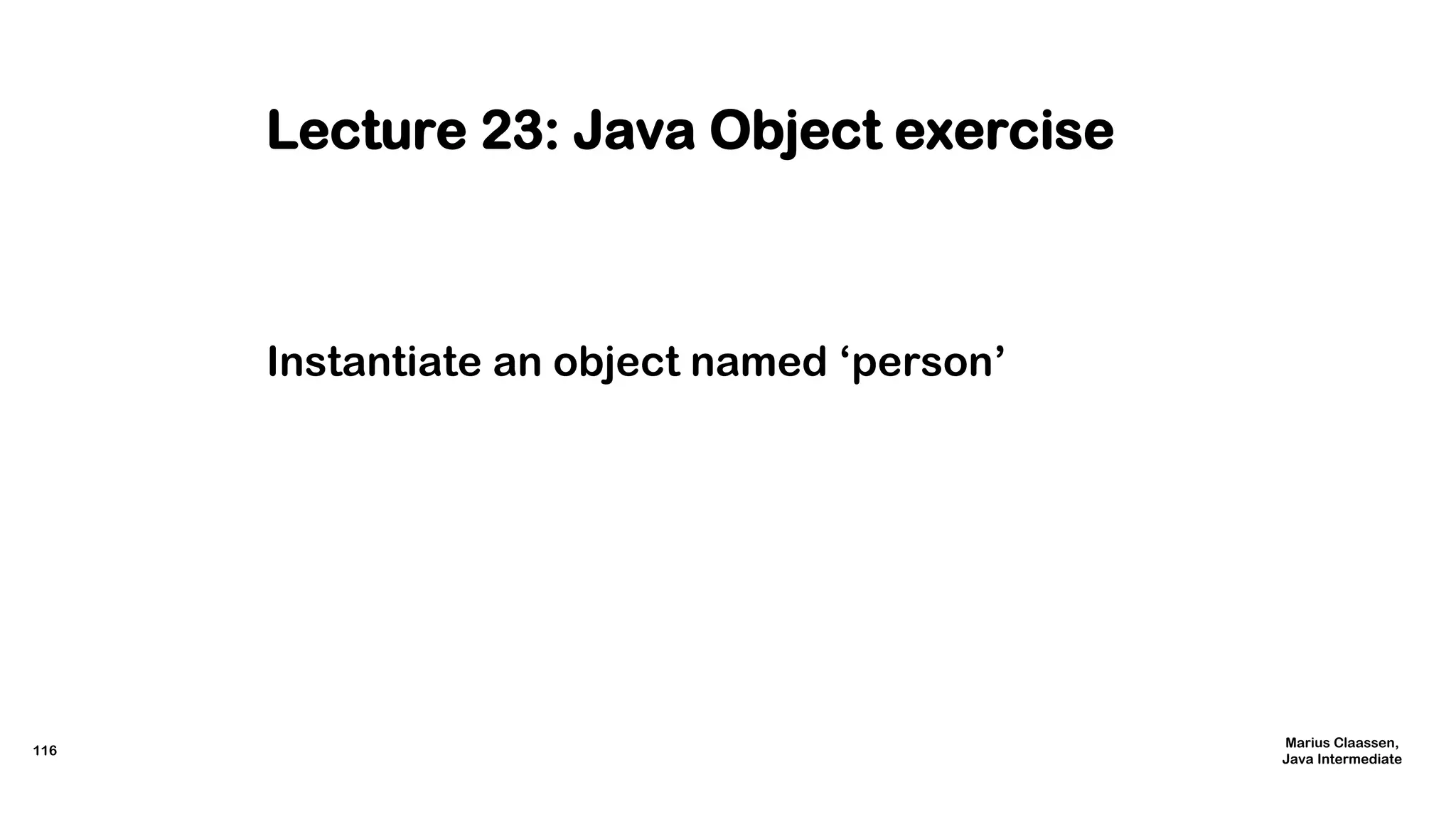
![Lecture 23: Java Object exercise
public class Lecture24 {
public static void main(String[] args) {
// TODO: Instantiate an object named ‘person’
person.speak();
}
}
117
Marius Claassen,
Java Intermediate](https://image.slidesharecdn.com/javaforintermediateusers-170912102557/75/Java-for-intermediate-users-117-2048.jpg)
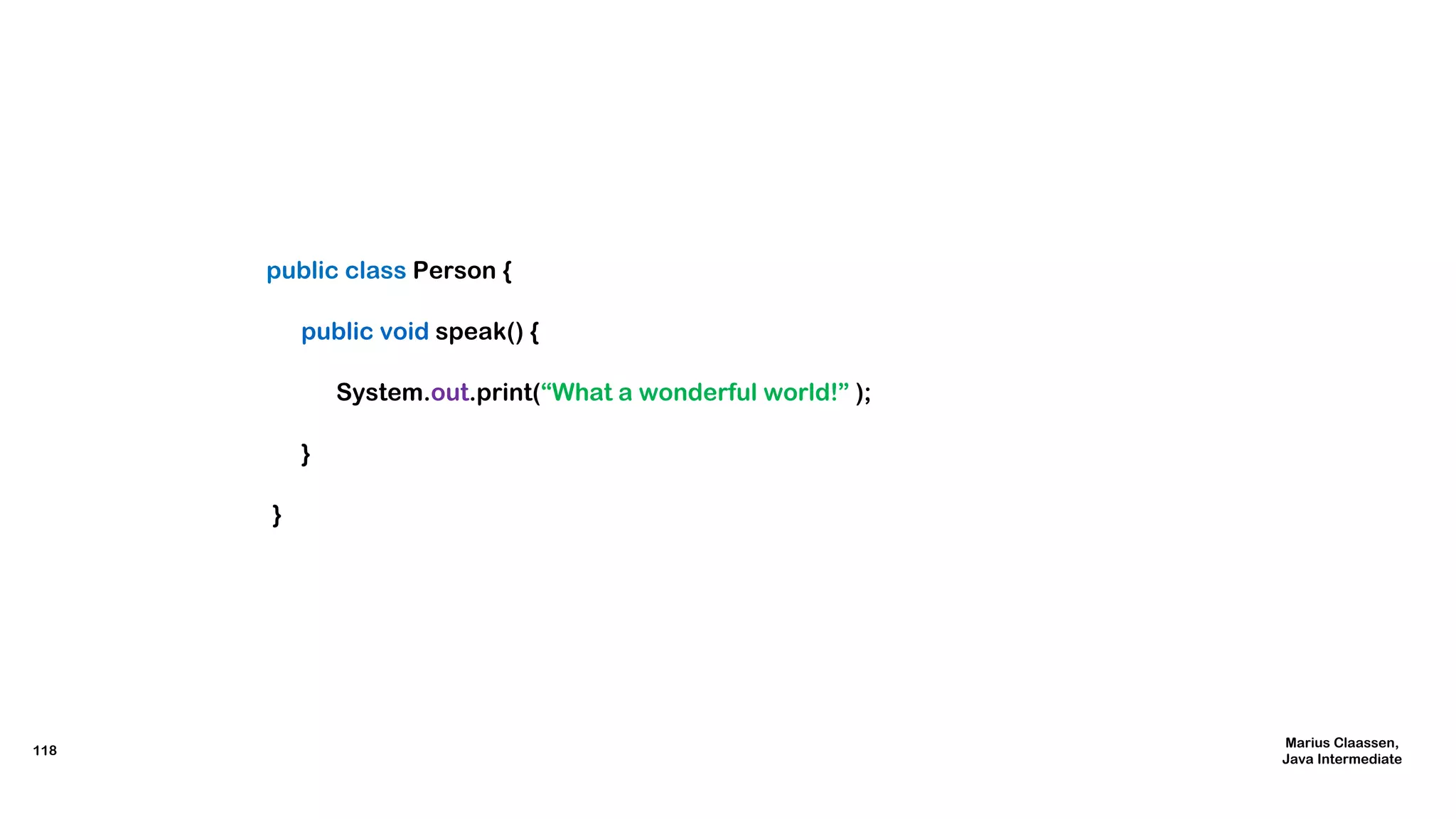
![Lecture 24: Java Object solution
public class Lecture24 {
public static void main(String[] args) {
Person person = new Person();
person.speak();
}
}
// What a wonderful world!
119
Marius Claassen,
Java Intermediate](https://image.slidesharecdn.com/javaforintermediateusers-170912102557/75/Java-for-intermediate-users-119-2048.jpg)
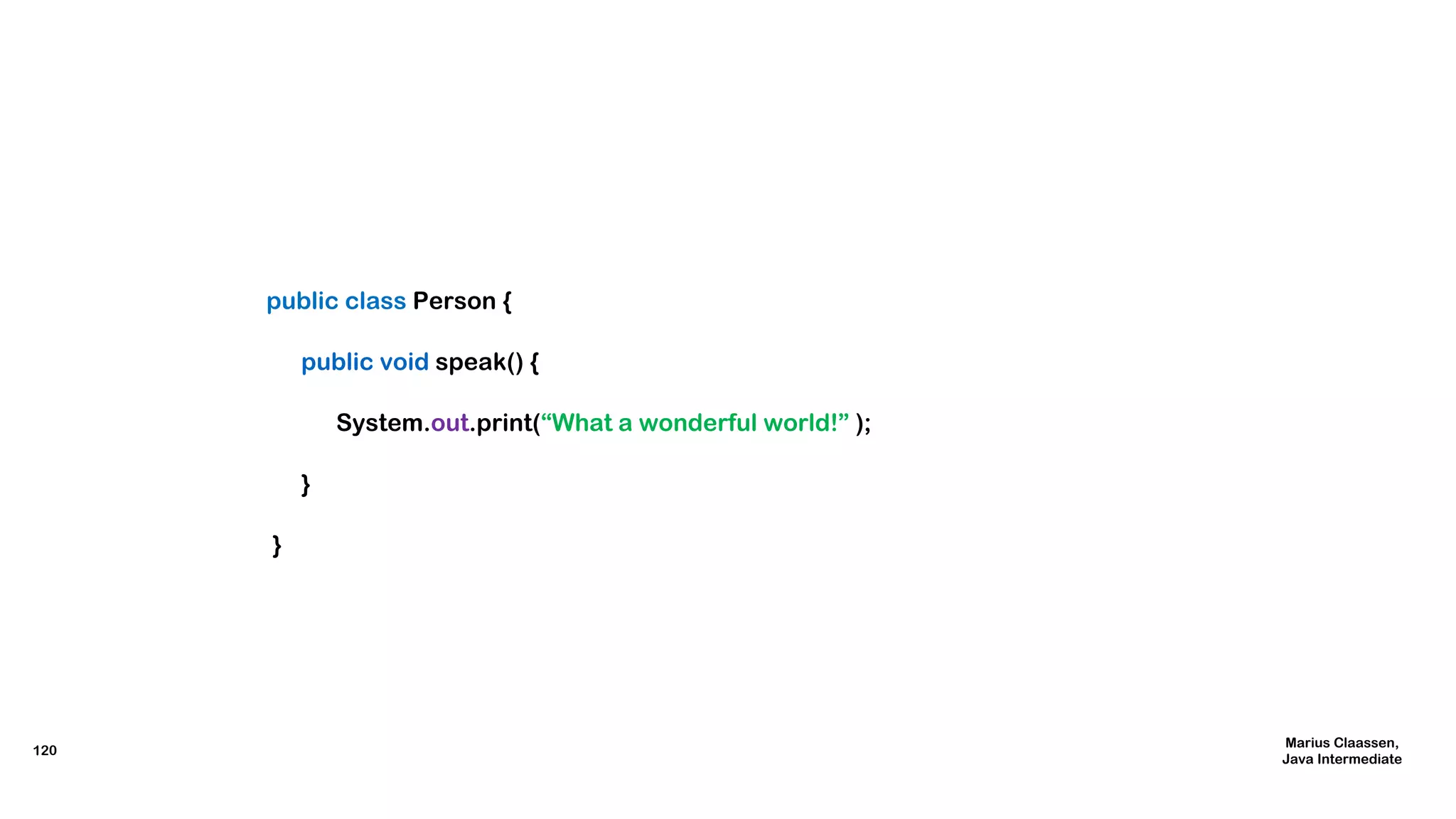
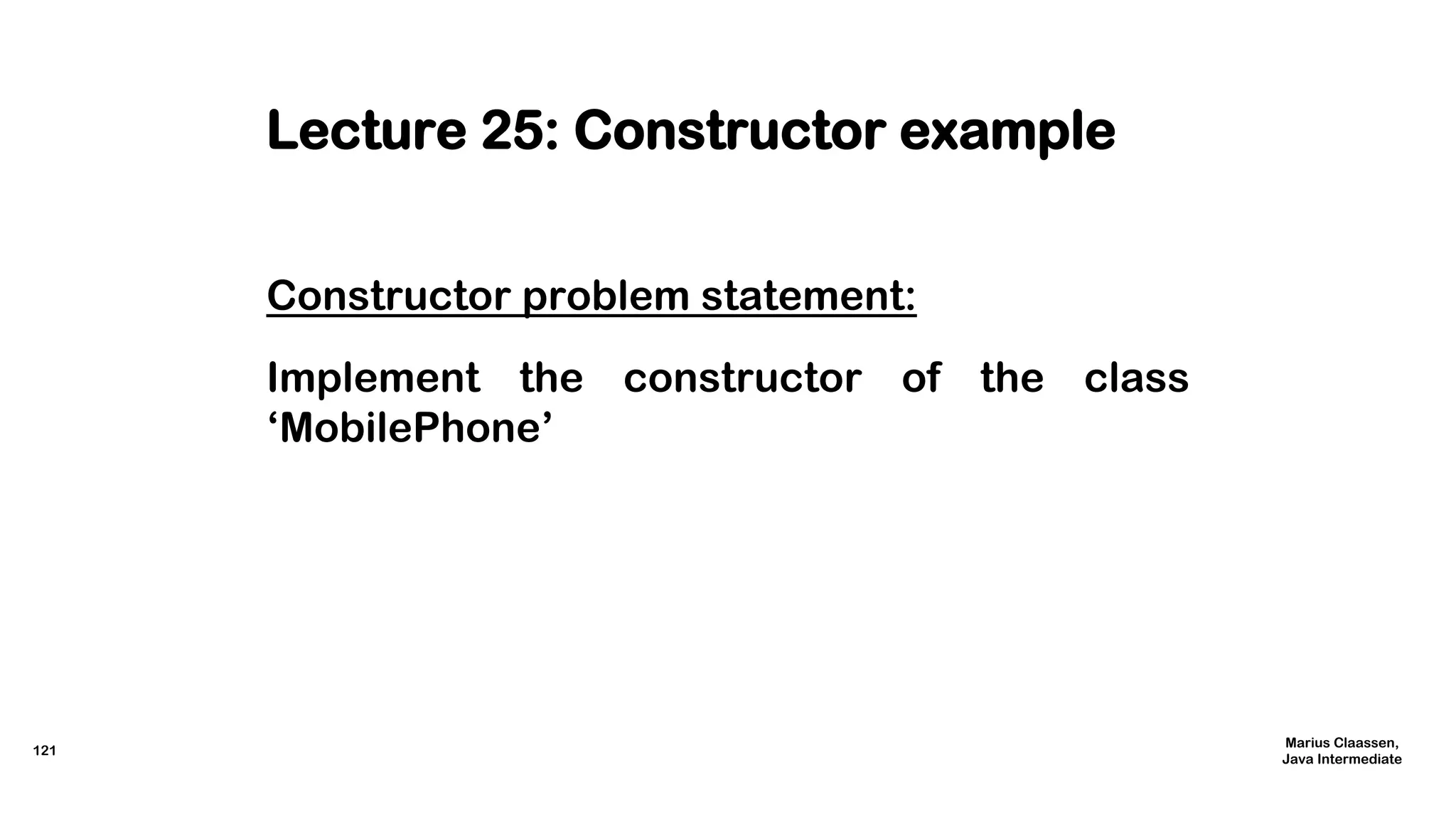
![Lecture 25: Constructor example
public class Lecture25 {
public static void main(String[] args) {
MobilePhone mobilePhone = new MobilePhone(“Samsung”, 1000);
}
}
// Name: Samsung
// Price: $1000.00
122
Marius Claassen,
Java Intermediate](https://image.slidesharecdn.com/javaforintermediateusers-170912102557/75/Java-for-intermediate-users-122-2048.jpg)
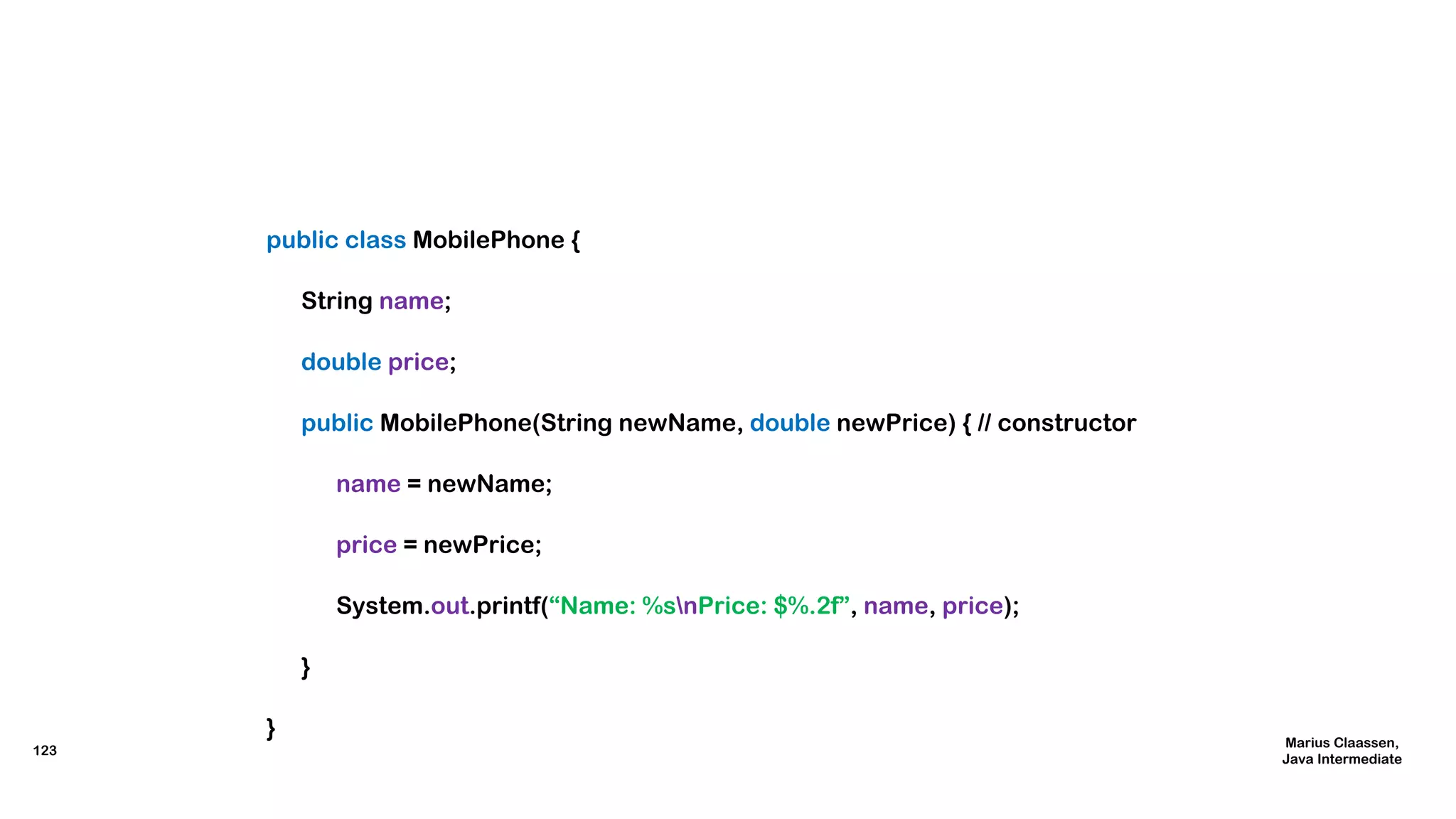
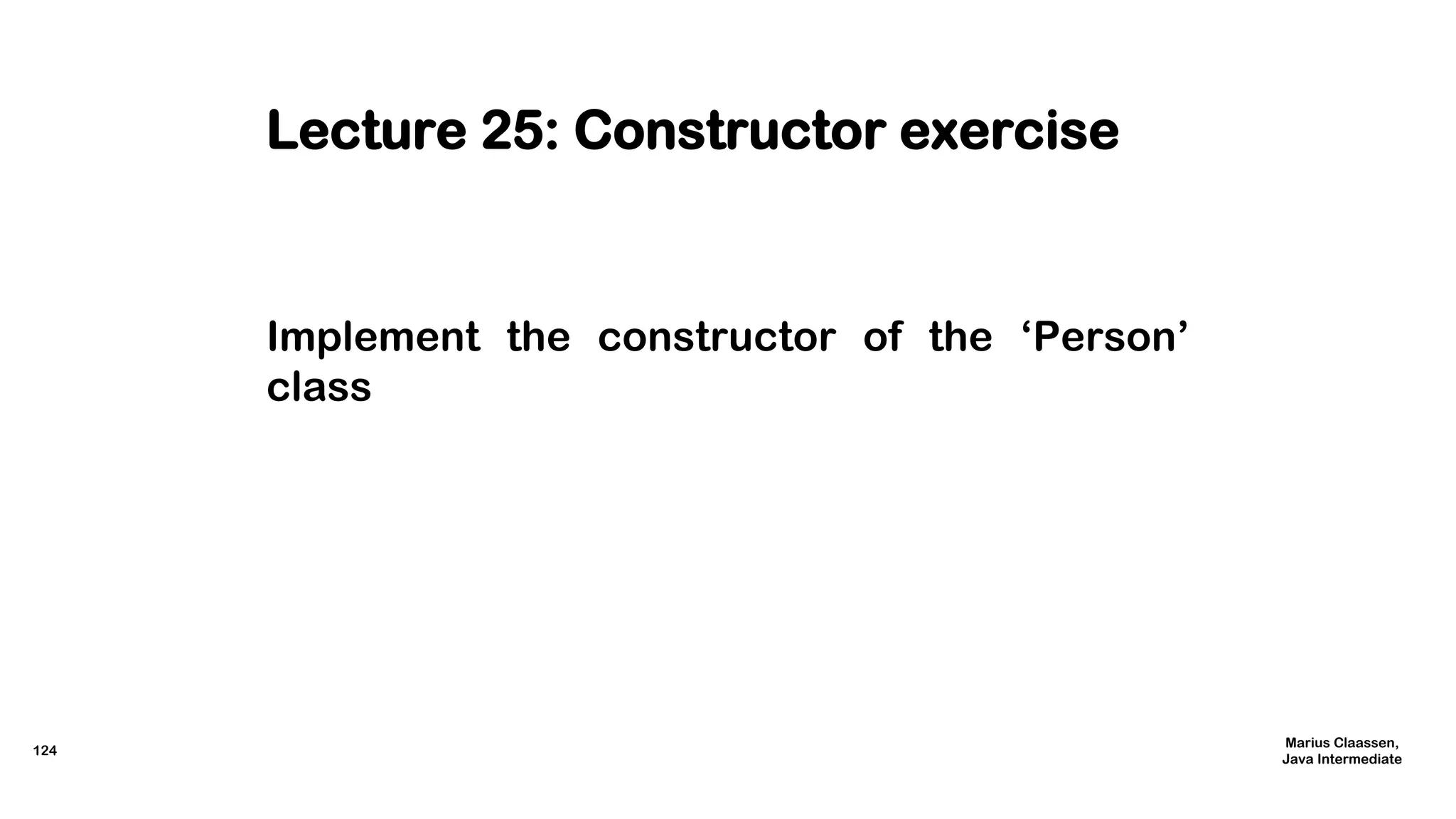
![Lecture 25: Constructor exercise
public class Lecture26 {
public static void main(String[] args) {
Person person = new Person(“Sarah”, 50);
}
}
125
Marius Claassen,
Java Intermediate](https://image.slidesharecdn.com/javaforintermediateusers-170912102557/75/Java-for-intermediate-users-125-2048.jpg)
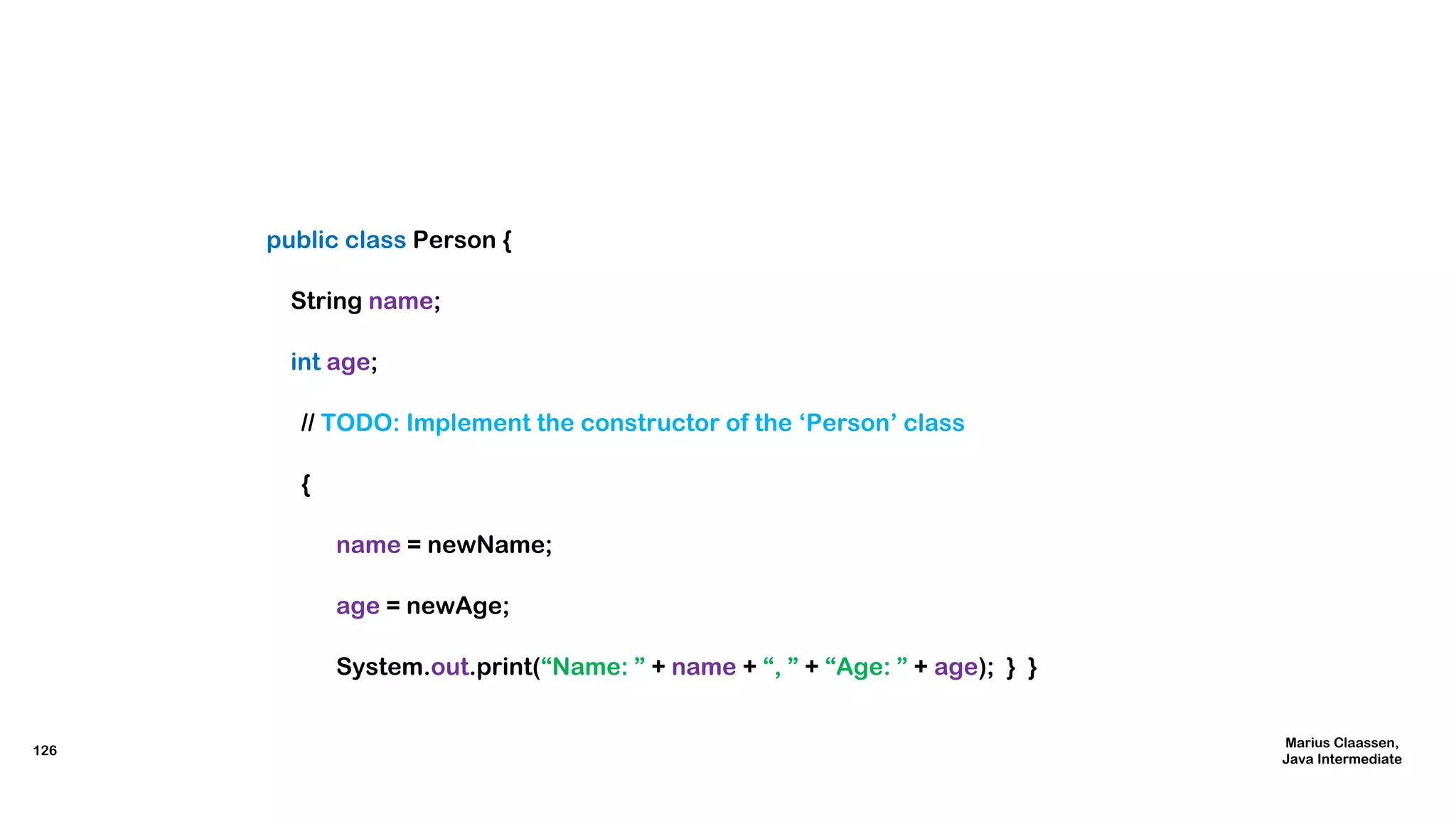
![Lecture 26: Constructor solution
public class Lecture26 {
public static void main(String[] args) {
Person person = new Person(“Sarah”, 50);
}
}
// Name: Sarah, Age: 50
127
Marius Claassen,
Java Intermediate](https://image.slidesharecdn.com/javaforintermediateusers-170912102557/75/Java-for-intermediate-users-127-2048.jpg)
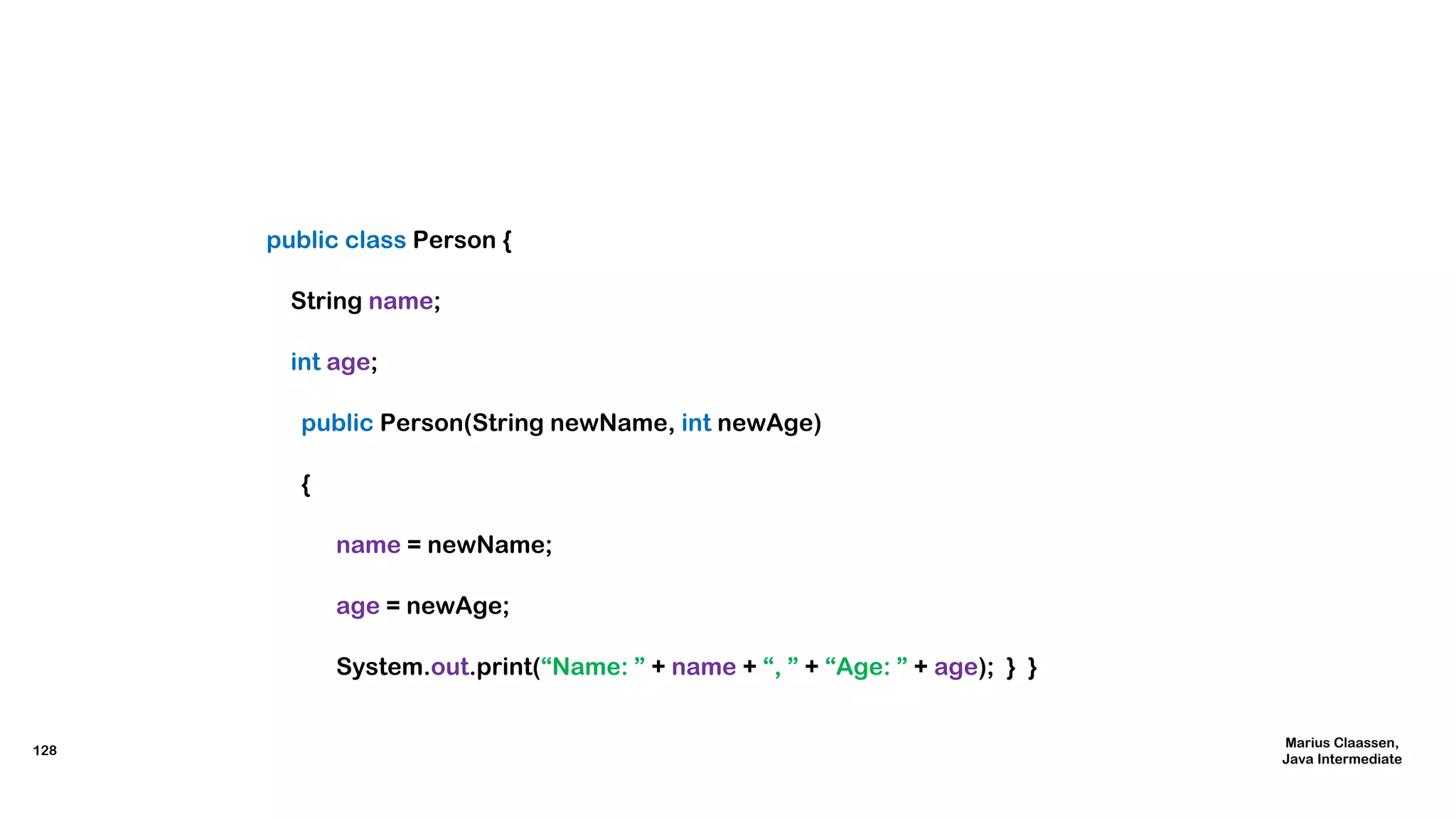
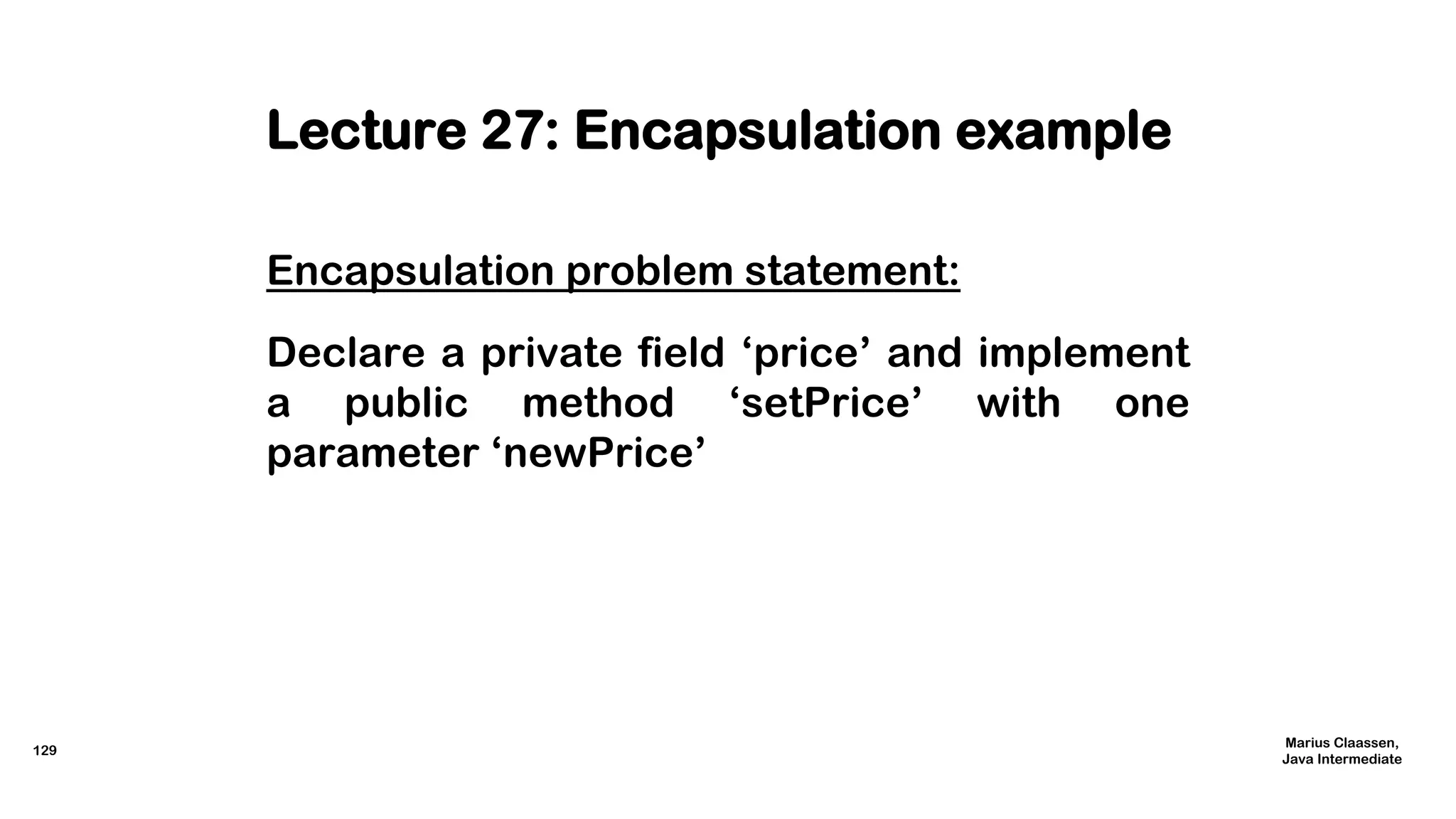
![Lecture 27: Encapsulation example
public class Lecture27 {
public static void main(String[] args) {
MobilePhone mobilePhone = new MobilePhone(300);
}
}
// Mobile phone price: $300.00
130
Marius Claassen,
Java Intermediate](https://image.slidesharecdn.com/javaforintermediateusers-170912102557/75/Java-for-intermediate-users-130-2048.jpg)
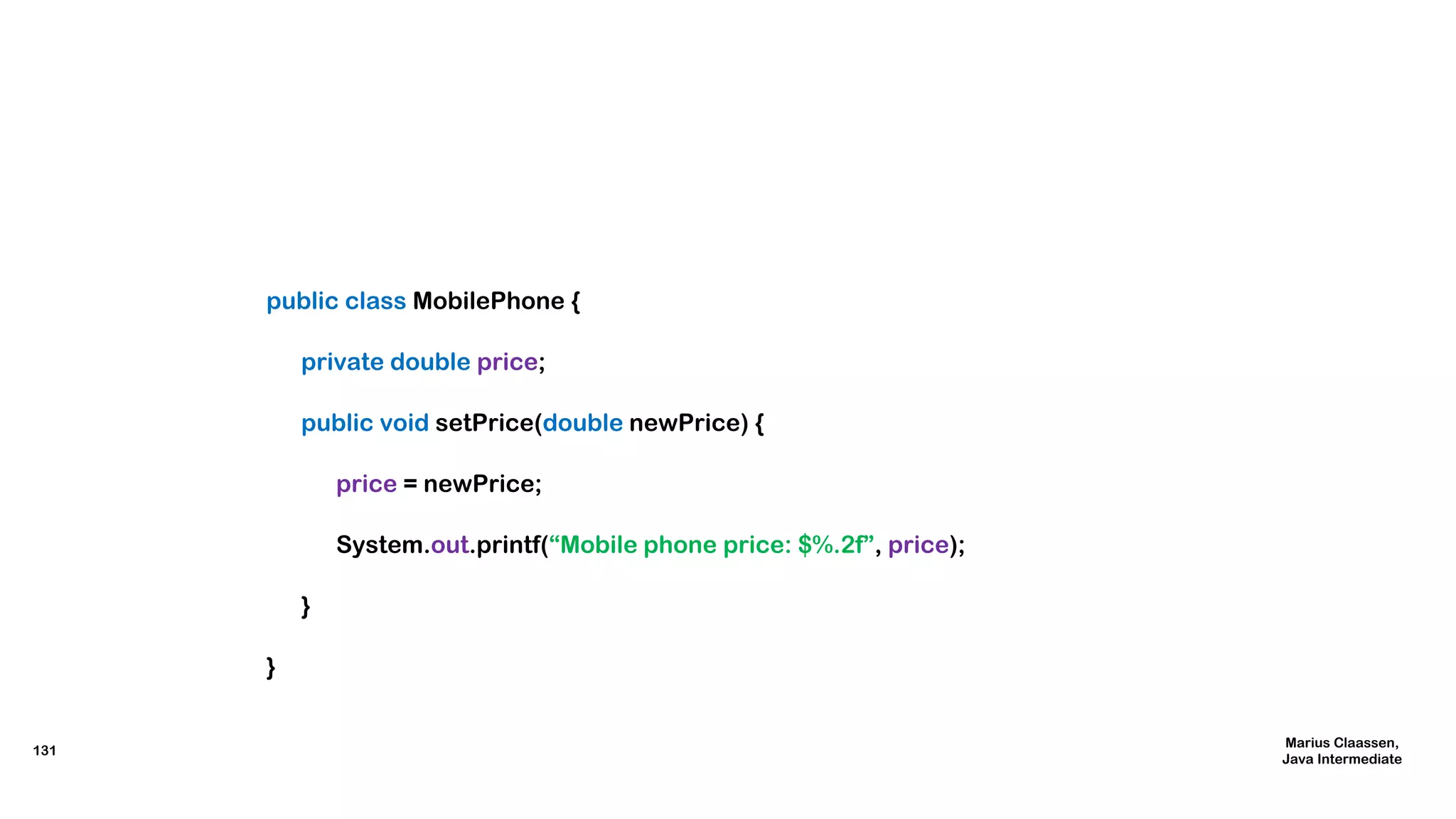
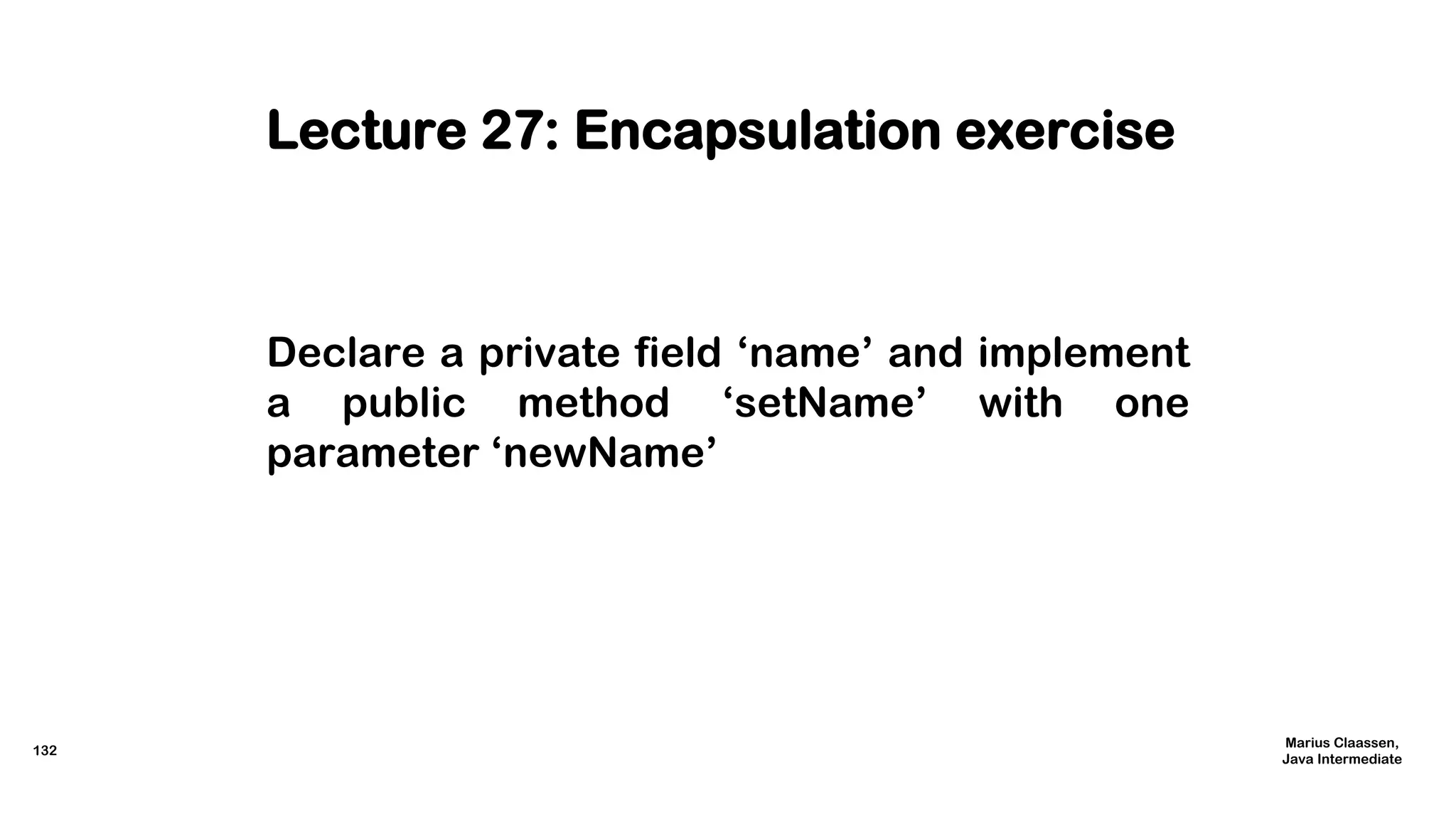
![Lecture 27: Encapsulation exercise
public class Lecture28 {
public static void main(String[] args) {
Person person = new Person();
person.setName(“David”);
}
}
133
Marius Claassen,
Java Intermediate](https://image.slidesharecdn.com/javaforintermediateusers-170912102557/75/Java-for-intermediate-users-133-2048.jpg)
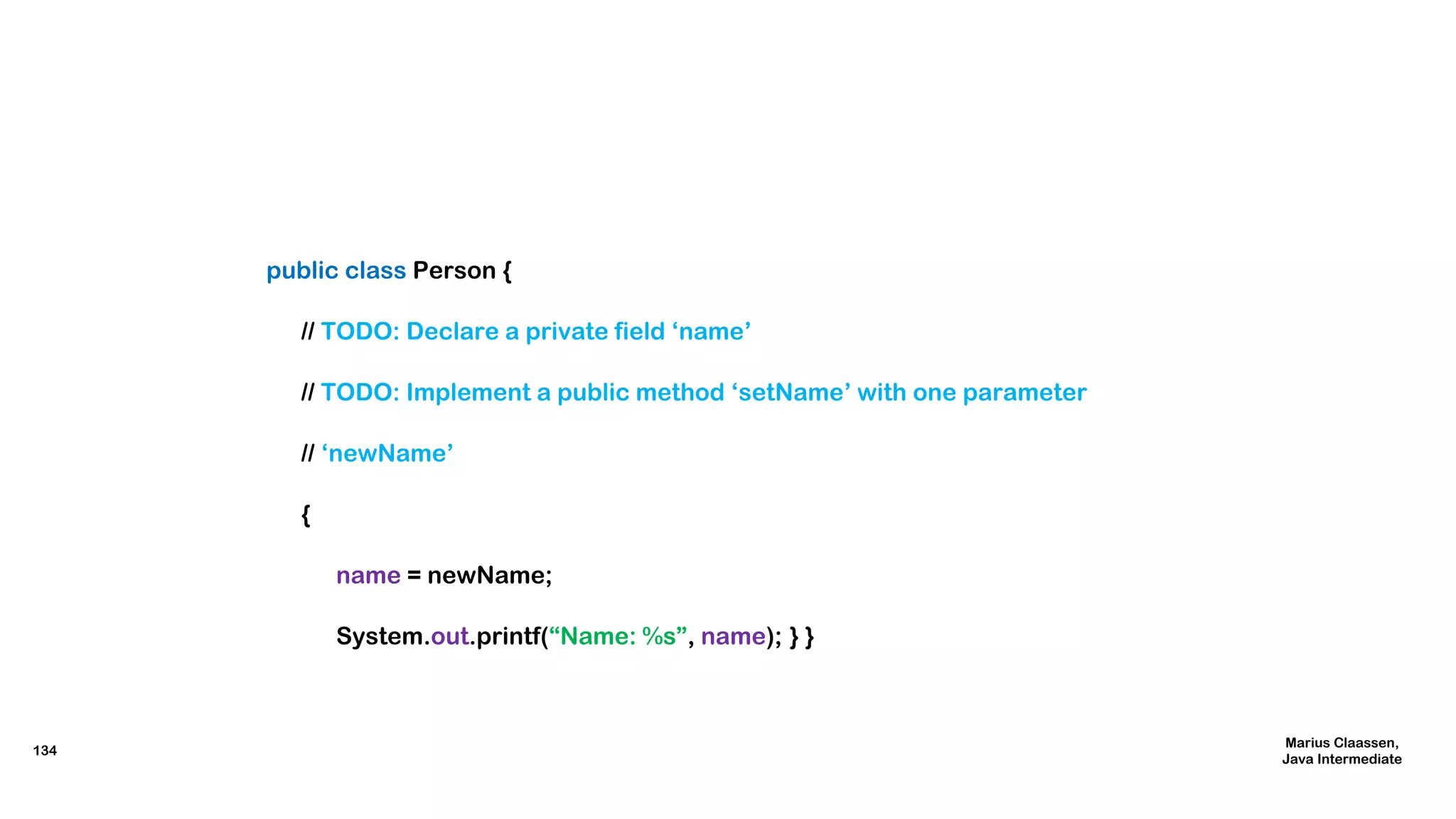
![Lecture 28: Encapsulation solution
public class Lecture28 {
public static void main(String[] args) {
Person person = new Person();
person.setName(“David”);
}
}
// Name: David
135
Marius Claassen,
Java Intermediate](https://image.slidesharecdn.com/javaforintermediateusers-170912102557/75/Java-for-intermediate-users-135-2048.jpg)
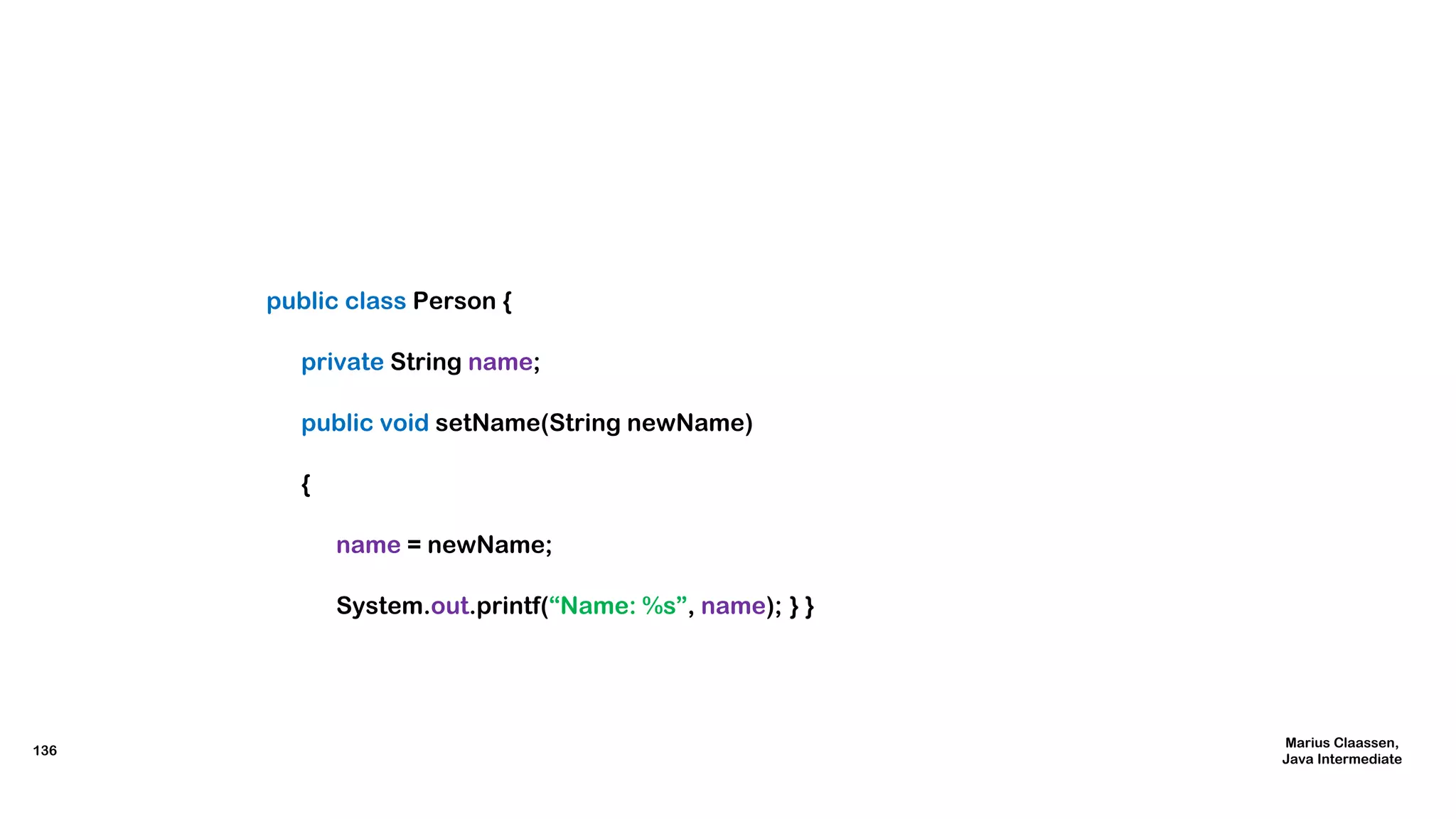
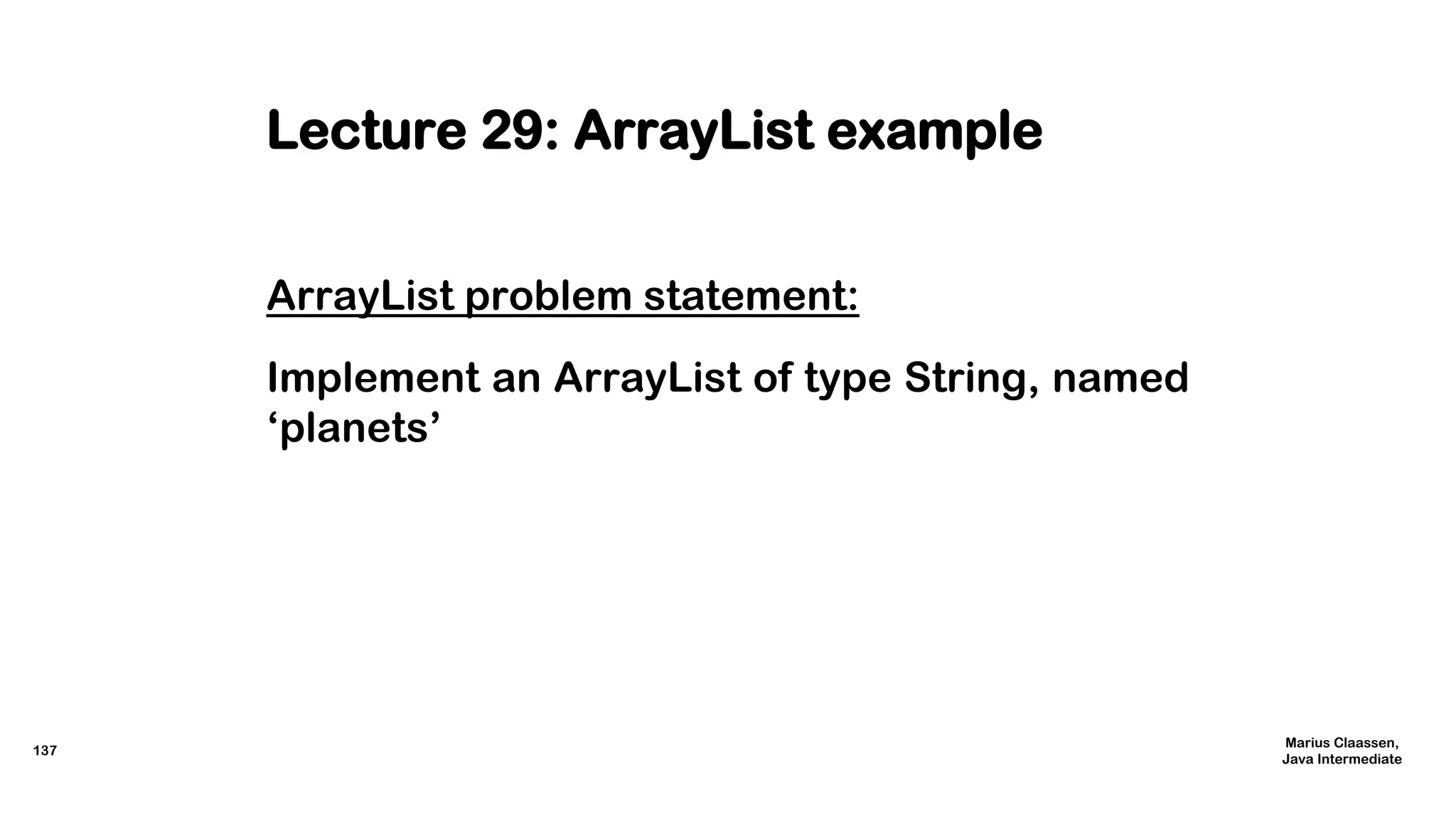
![Lecture 29: ArrayList example
public class Lecture29 {
public static void main(String[] args) {
ArrayList<String> planets = new ArrayList<>();
planets.add(“Mercury”);
planets.add(“Venus”);
planets.add(“Earth”);
planets.add(“Mars”);
for (String planet : planets) { System.out.print(planet + “ ”); } } }
// Mercury Venus Earth Mars
138
Marius Claassen,
Java Intermediate](https://image.slidesharecdn.com/javaforintermediateusers-170912102557/75/Java-for-intermediate-users-138-2048.jpg)
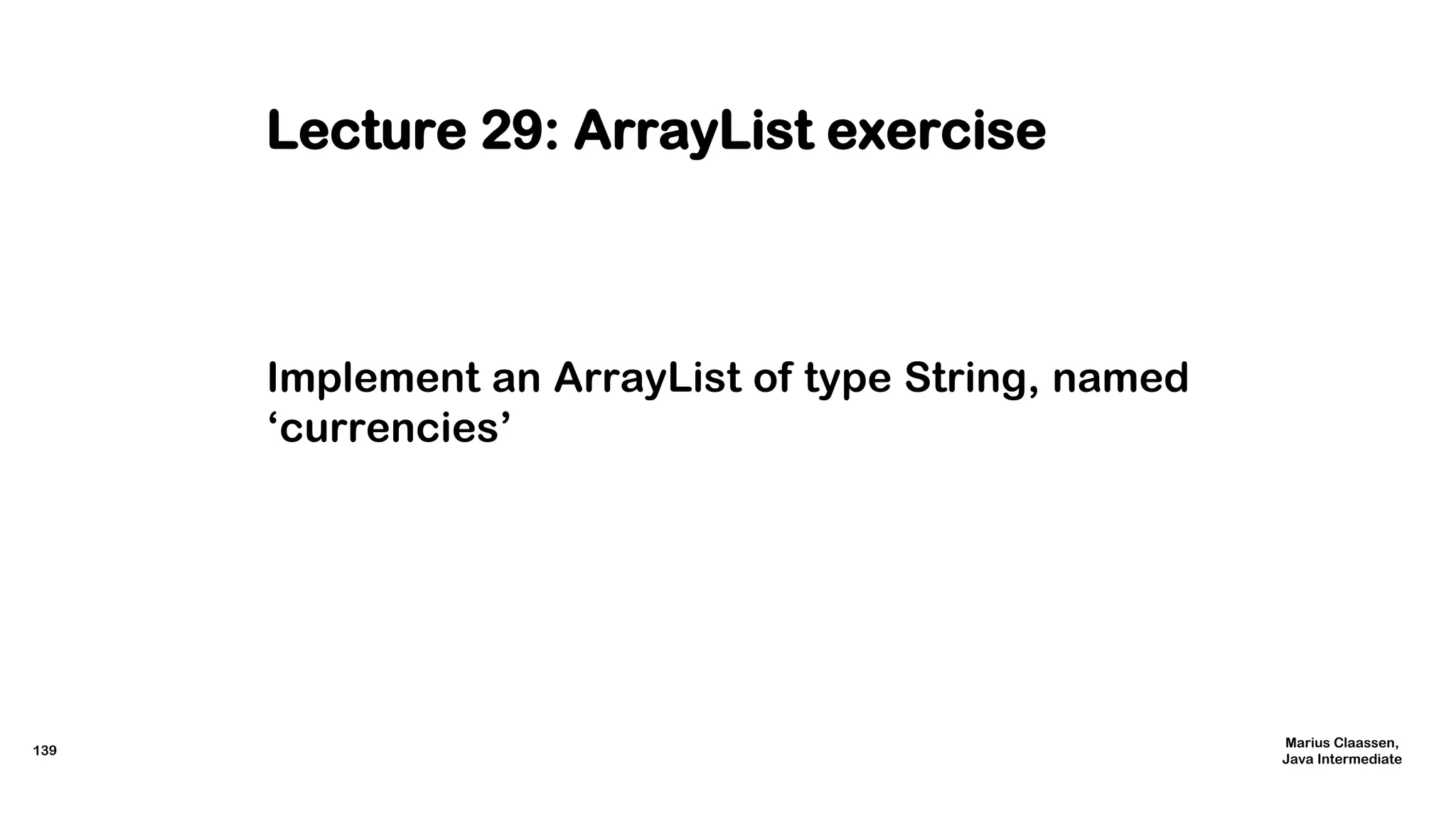
![Lecture 29: ArrayList exercise
public class Lecture30 {
public static void main(String[] args) {
// TODO: Implement an ArrayList of type String , named ‘currencies’
currencies.add(“US Dollar”);
currencies.add(“Indian Rupee”);
currencies.add(“Thai Baht”);
for (String currency : currencies) { System.out.print(currency + “ ”); } } }
140
Marius Claassen,
Java Intermediate](https://image.slidesharecdn.com/javaforintermediateusers-170912102557/75/Java-for-intermediate-users-140-2048.jpg)
![Lecture 30: ArrayList solution
public class Lecture30 {
public static void main(String[] args) {
ArrayList<String> currencies = new ArrayList<>();
currencies.add(“US Dollar”);
currencies.add(“Indian Rupee”);
currencies.add(“Thai Baht”);
for (String currency : currencies) { System.out.print(currency + “ ”); } } }
// US Dollar Indian Rupee Thai Baht
141
Marius Claassen,
Java Intermediate](https://image.slidesharecdn.com/javaforintermediateusers-170912102557/75/Java-for-intermediate-users-141-2048.jpg)
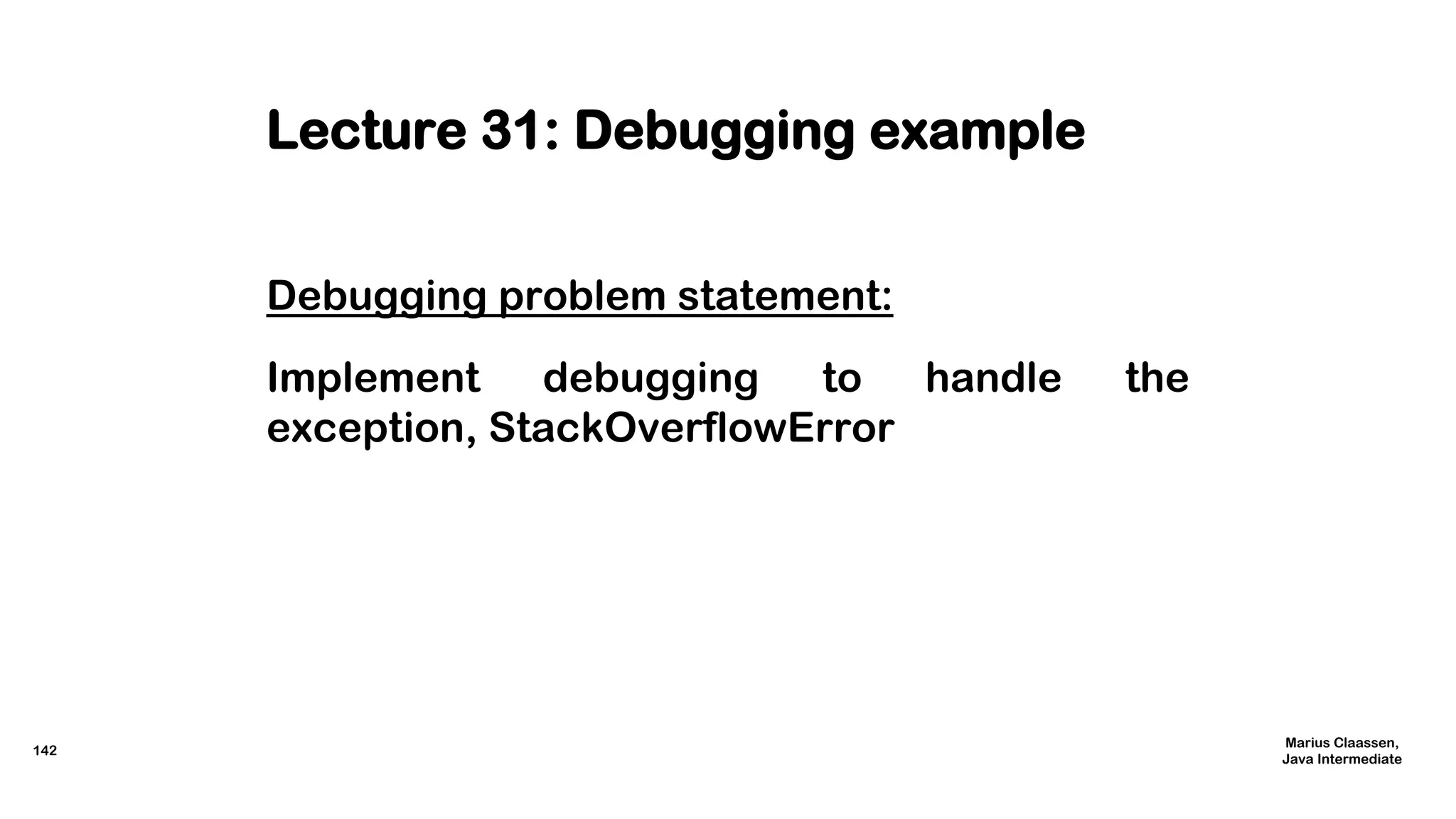
![Lecture 31: Debugging example
public class Lecture31 {
public static void main(String[] args) {
int y = 8;
System.out.print(“Fibonacci value at index ” + y + “: ” + getFibonacci(y));
}
143
Marius Claassen,
Java Intermediate](https://image.slidesharecdn.com/javaforintermediateusers-170912102557/75/Java-for-intermediate-users-143-2048.jpg)
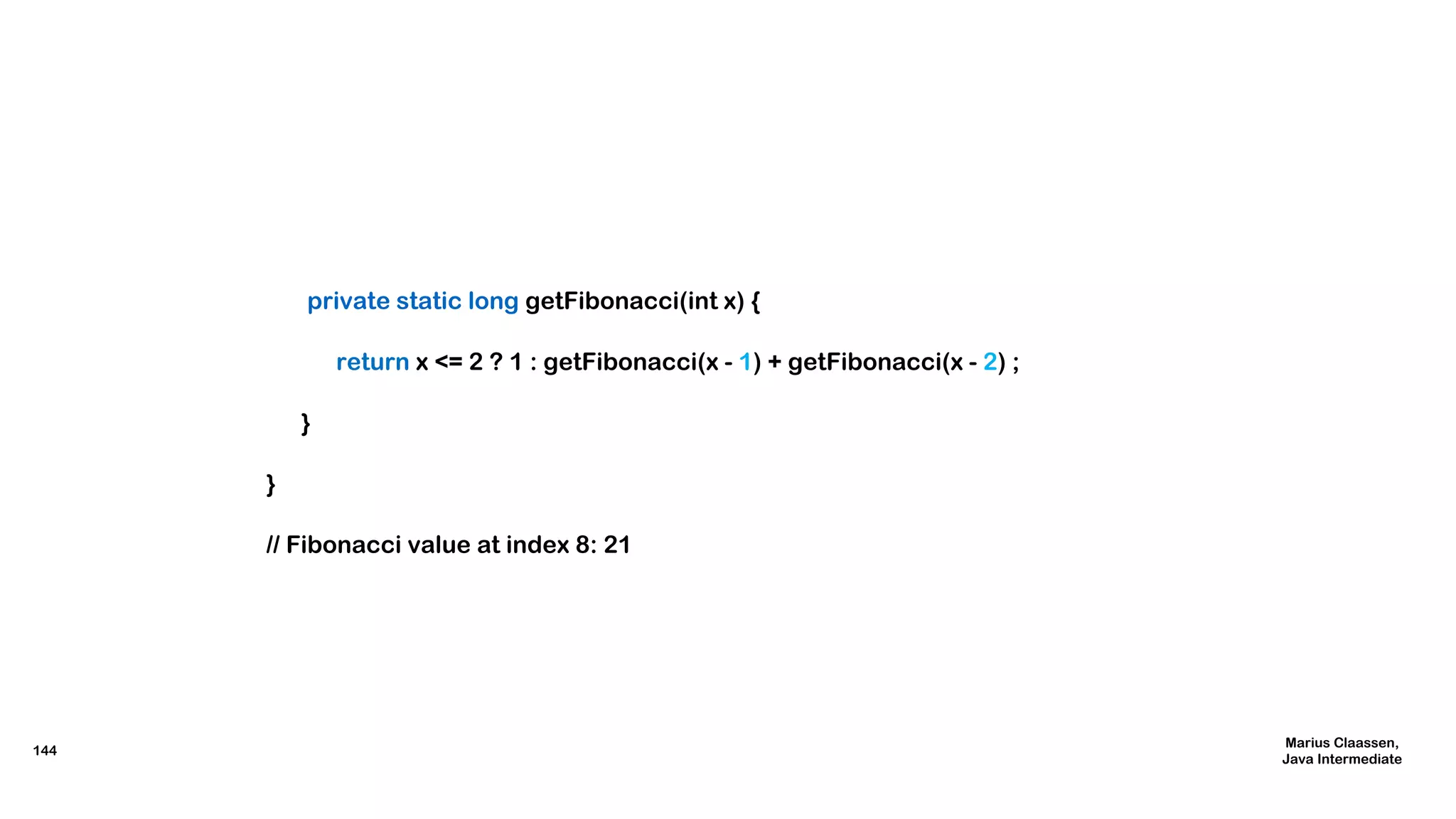
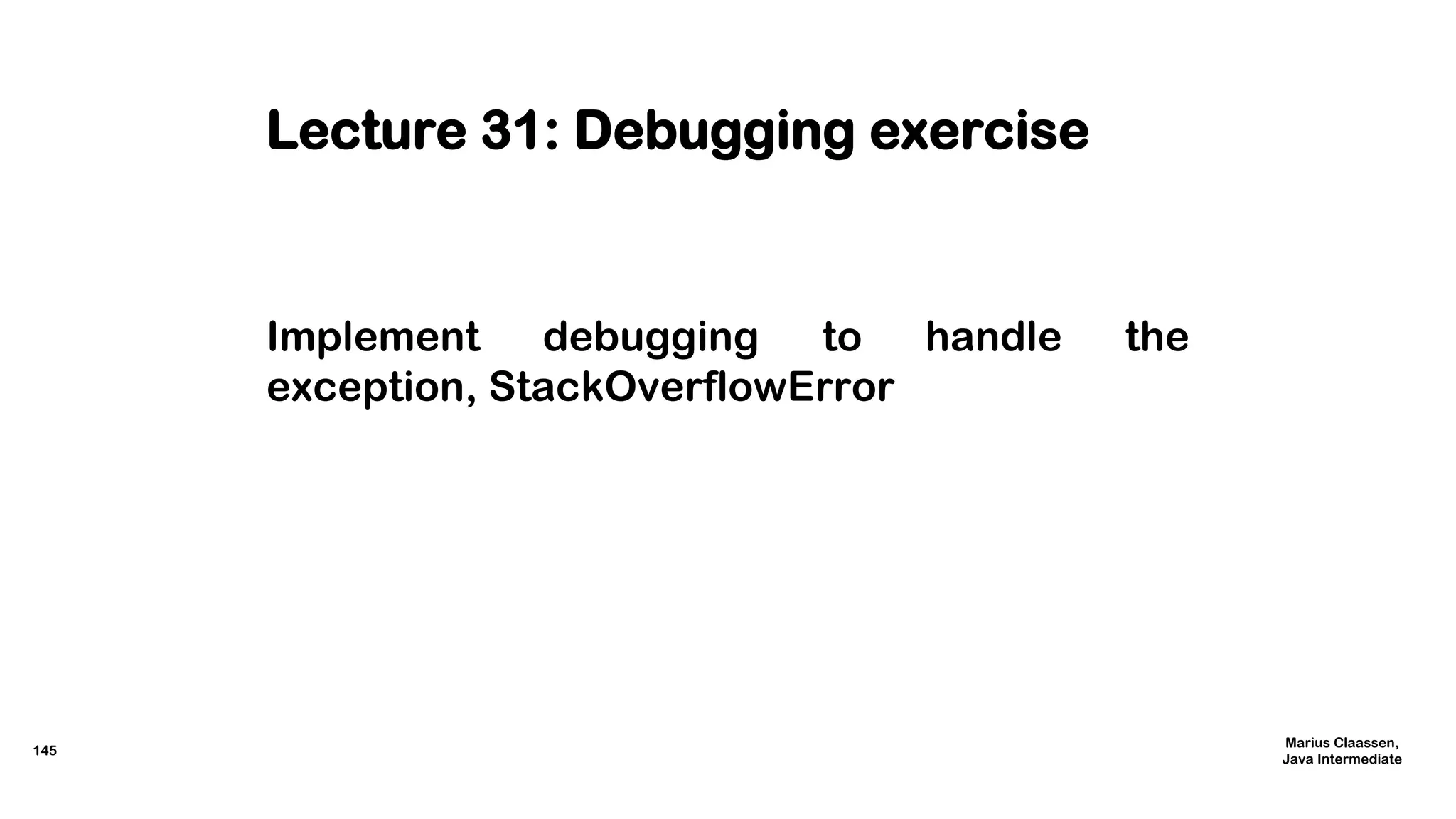
![Lecture 31: Debugging exercise
public class Lecture32 {
public static void main(String[] args) {
int y = 10;
System.out.print(“Fibonacci value at index ” + y + “: ” + getFibonacci(y));
}
146
Marius Claassen,
Java Intermediate](https://image.slidesharecdn.com/javaforintermediateusers-170912102557/75/Java-for-intermediate-users-146-2048.jpg)
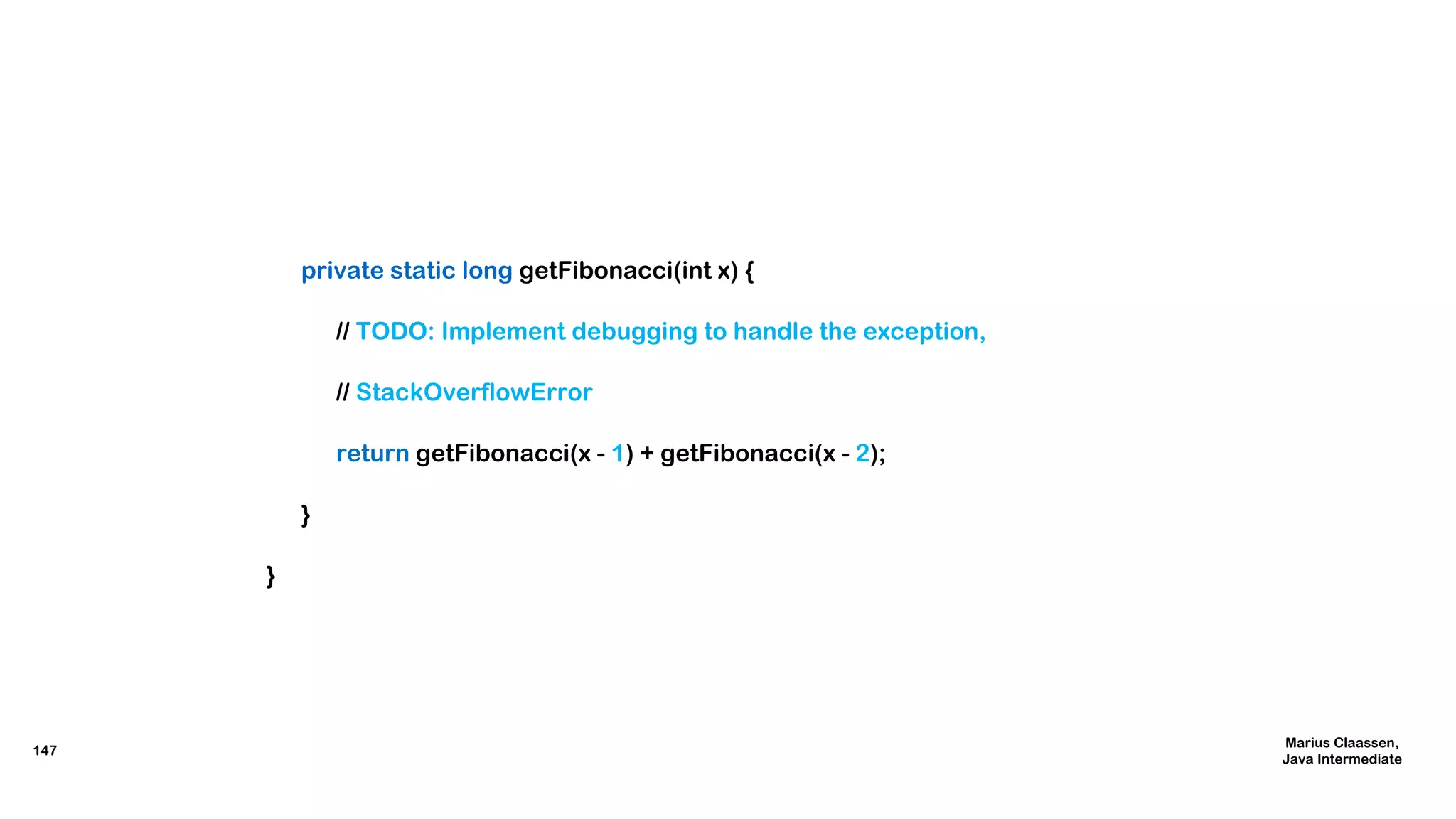
![Lecture 32: Debugging solution
public class Lecture32 {
public static void main(String[] args) {
int y = 10;
System.out.print(“Fibonacci value at index ” + y + “: ” + getFibonacci(y));
}
148
Marius Claassen,
Java Intermediate](https://image.slidesharecdn.com/javaforintermediateusers-170912102557/75/Java-for-intermediate-users-148-2048.jpg)
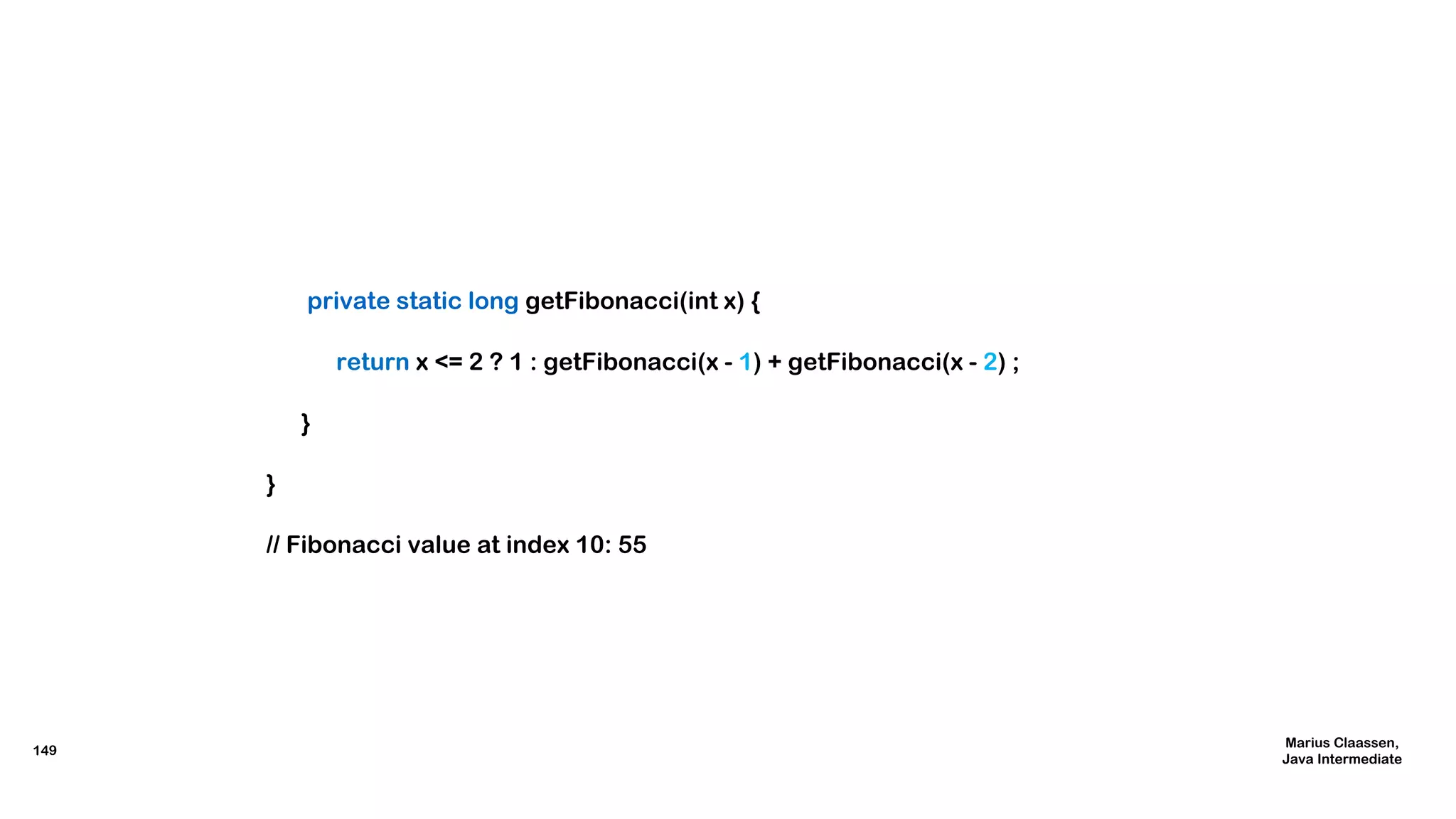
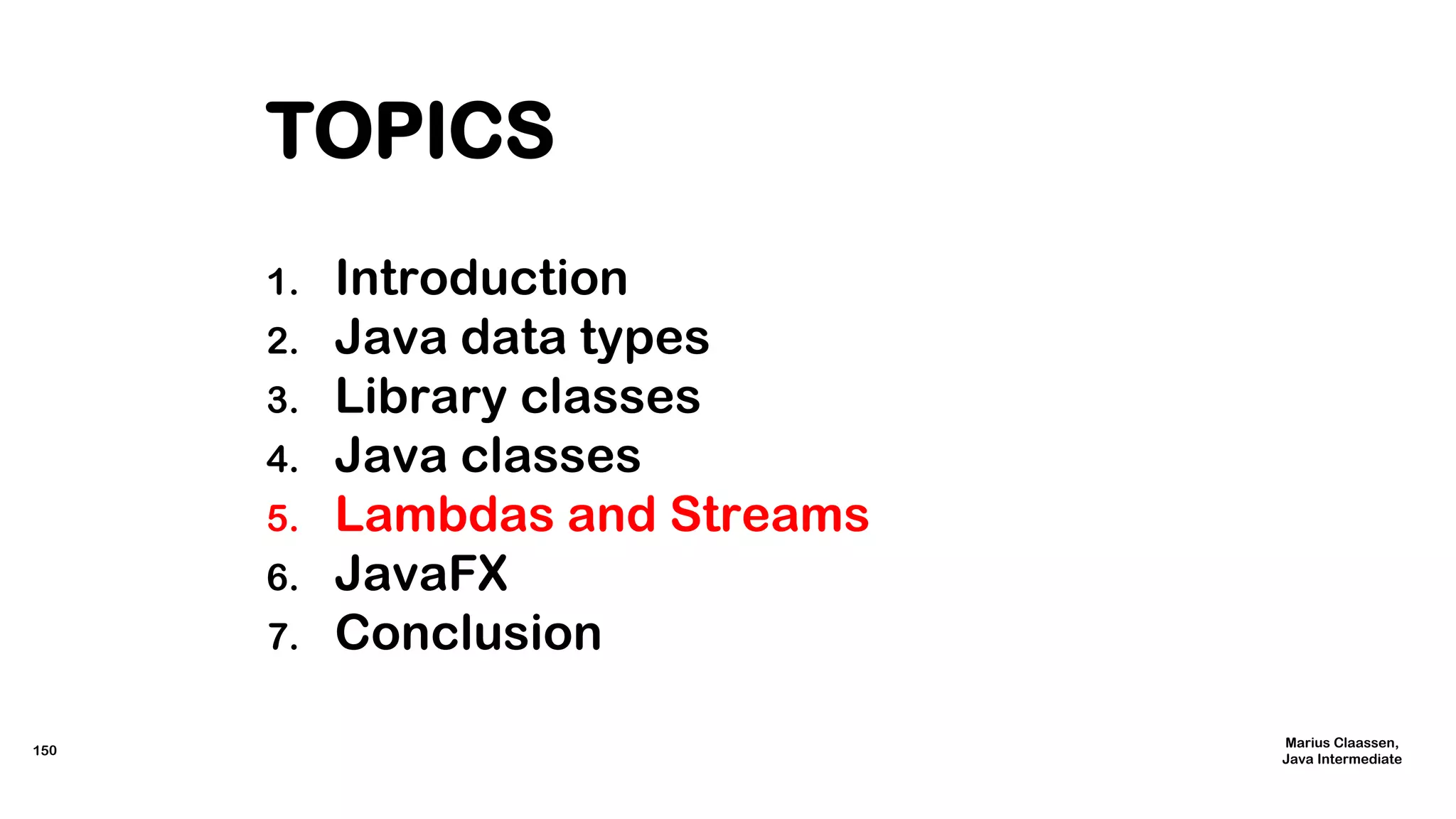
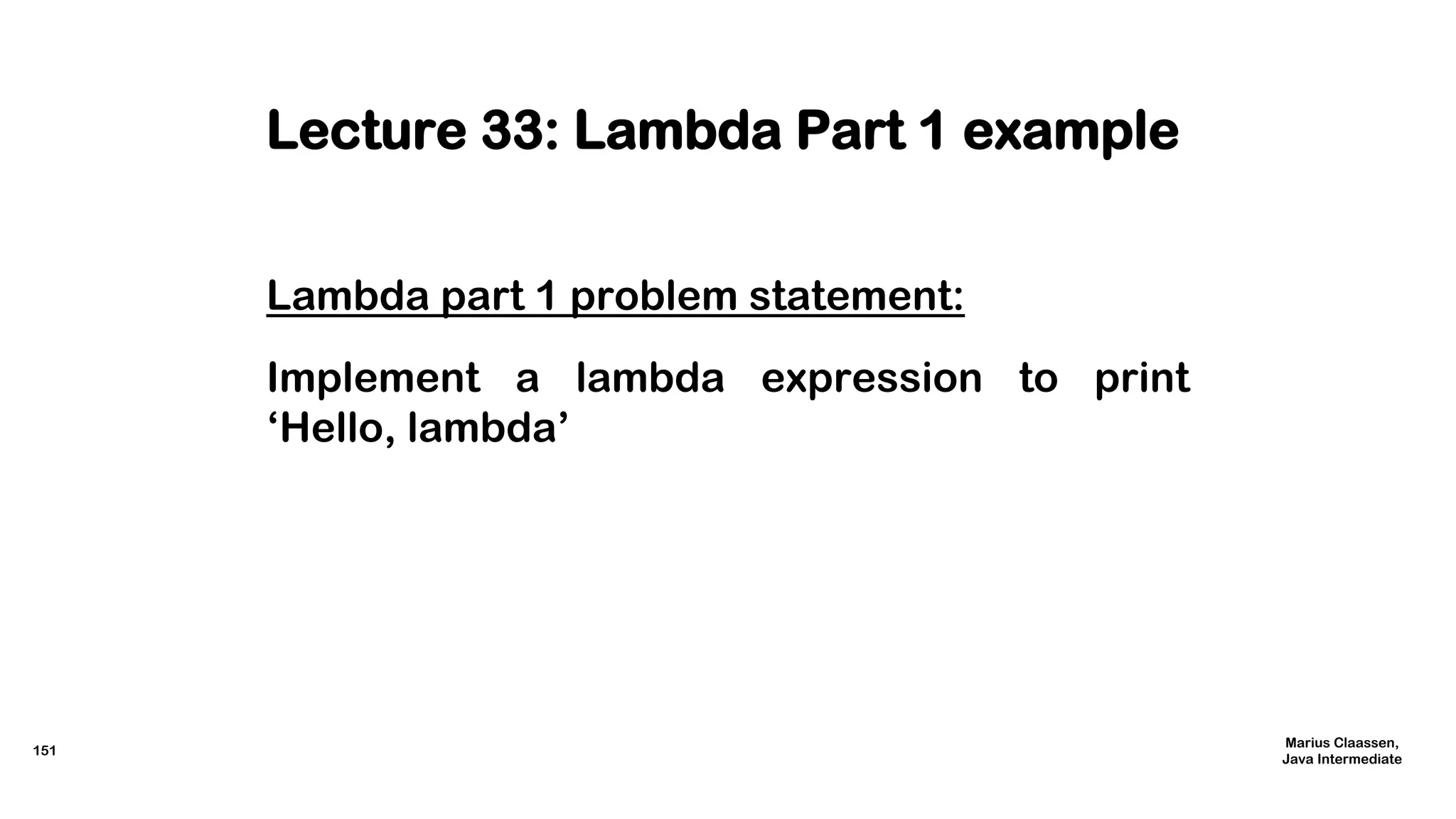
![Lecture 33: Lambda Part 1 example
public class Lecture33 {
public static void main(String[] args) {
Thread thread1 = new Thread( () -> System.out.print(“Hello, lambda”); )
thread1.run();
}
}
// Hello, lambda
152
Marius Claassen,
Java Intermediate](https://image.slidesharecdn.com/javaforintermediateusers-170912102557/75/Java-for-intermediate-users-152-2048.jpg)
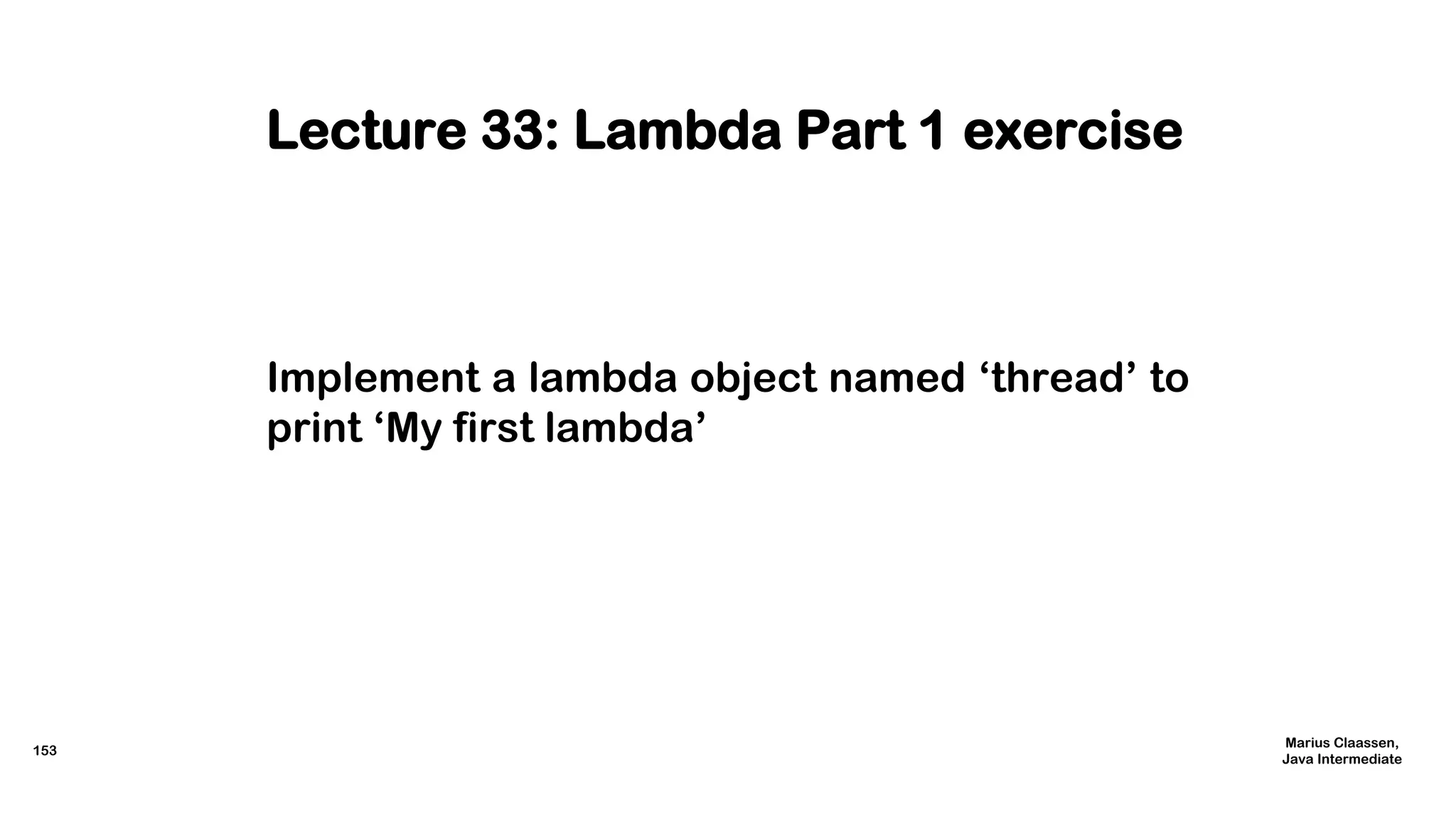
![Lecture 33: Lambda Part 1 exercise
public class Lecture34 {
public static void main(String[] args) {
// TODO: Implement a lambda object named ‘thread’ to print,
// ‘My first lambda’
thread.run();
}
}
154
Marius Claassen,
Java Intermediate](https://image.slidesharecdn.com/javaforintermediateusers-170912102557/75/Java-for-intermediate-users-154-2048.jpg)
![Lecture 34: Lambda Part 1 solution
public class Lecture34 {
public static void main(String[] args) {
Thread thread = new Thread( () -> System.out.print(“My first lambda”); )
thread.run();
}
}
// My first lambda
155
Marius Claassen,
Java Intermediate](https://image.slidesharecdn.com/javaforintermediateusers-170912102557/75/Java-for-intermediate-users-155-2048.jpg)
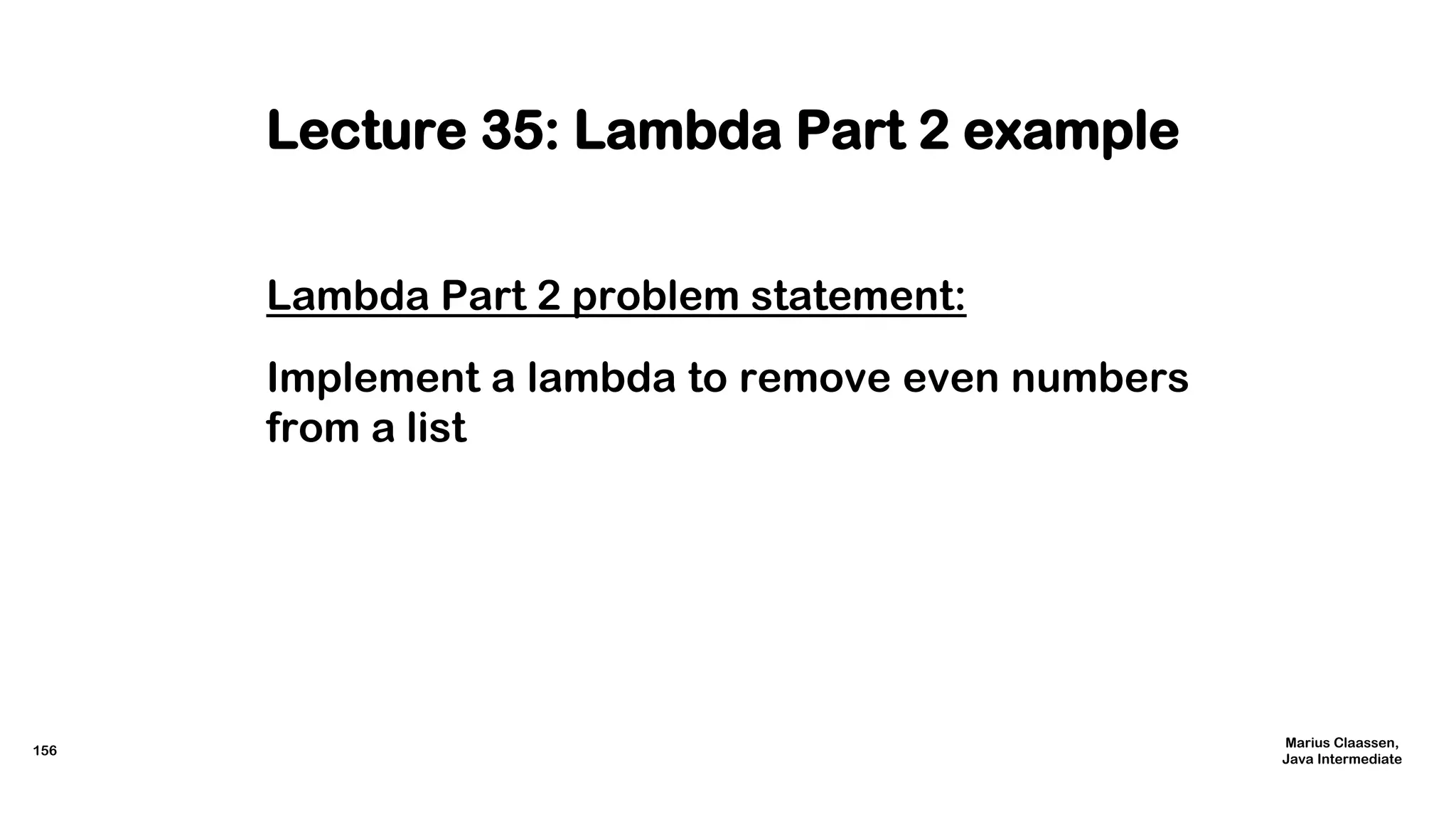
![Lecture 35: Lambda Part 2 example
import java.util.ArrayList; import java.util.Arrays;
public class Lecture35 {
public static void main(String[] args) {
ArrayList<Integer> values = new ArrayList<>(Arrays.asList(
1, 2, 3, 4, 5, 6, 7) );
values.removeIf(i -> i % 2 == 0);
values.forEach(i -> System.out.print(i + “ ”) ); } }
// 1 3 5 7
157
Marius Claassen,
Java Intermediate](https://image.slidesharecdn.com/javaforintermediateusers-170912102557/75/Java-for-intermediate-users-157-2048.jpg)
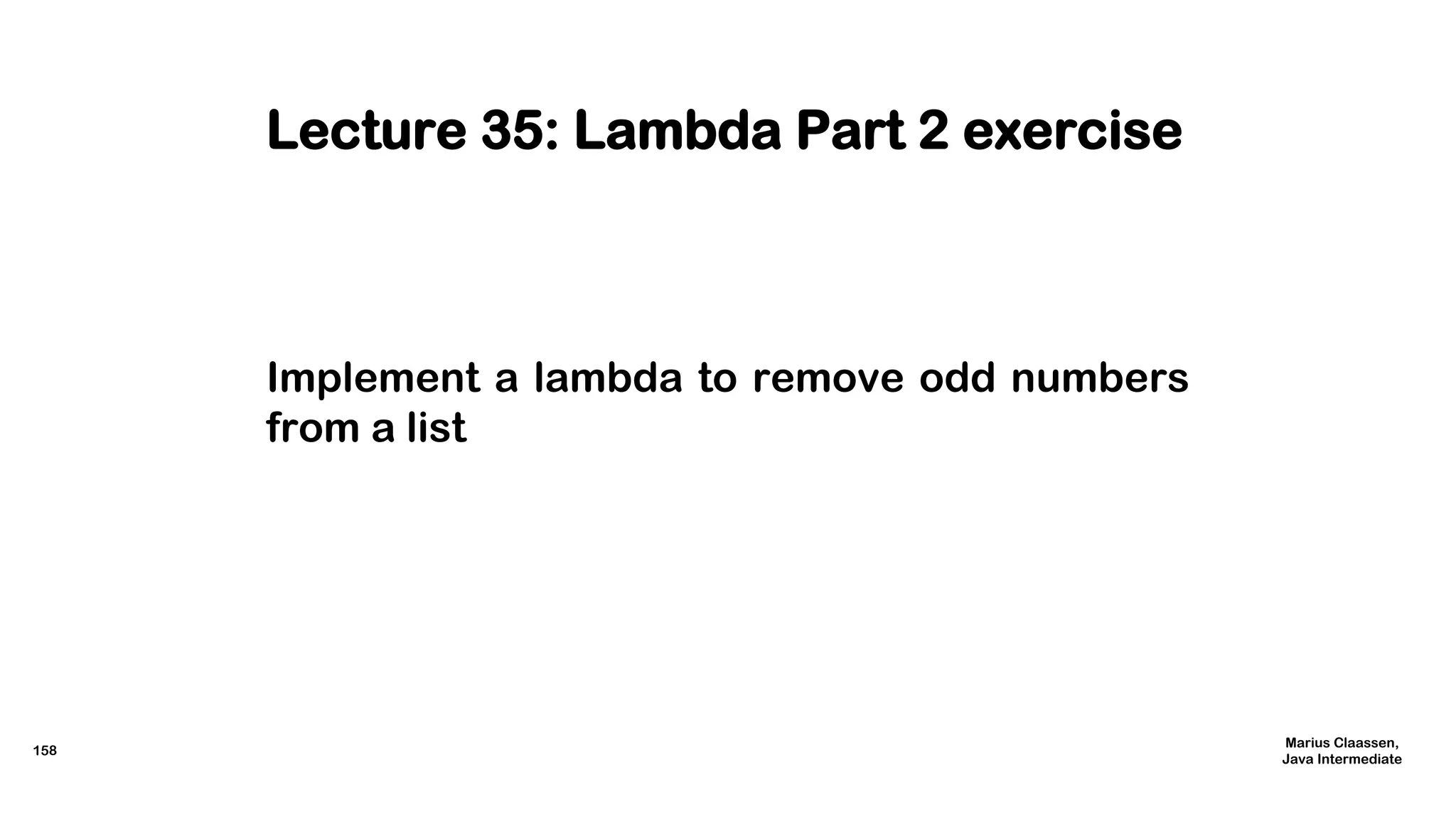
![Lecture 35: Lambda Part 2 exercise
import java.util.ArrayList; import java.util.Arrays;
public class Lecture36 {
public static void main(String[] args) {
ArrayList<Integer> numbers = new ArrayList<>(Arrays.asList(
5, 6, 7, 8, 9, 10) );
// TODO: Implement a lambda to remove odd numbers from a list
numbers.forEach(i -> System.out.print(i + “ ”) ); } }
159
Marius Claassen,
Java Intermediate](https://image.slidesharecdn.com/javaforintermediateusers-170912102557/75/Java-for-intermediate-users-159-2048.jpg)
![Lecture 36: Lambda Part 2 solution
import java.util.ArrayList; import java.util.Arrays;
public class Lecture36 {
public static void main(String[] args) {
ArrayList<Integer> numbers = new ArrayList<>(Arrays.asList(
5, 6, 7, 8, 9, 10) );
numbers.removeIf(i -> i % 2 != 0);
numbers.forEach(i -> System.out.print(i + “ ”) ); } }
// 6 8 10
160
Marius Claassen,
Java Intermediate](https://image.slidesharecdn.com/javaforintermediateusers-170912102557/75/Java-for-intermediate-users-160-2048.jpg)
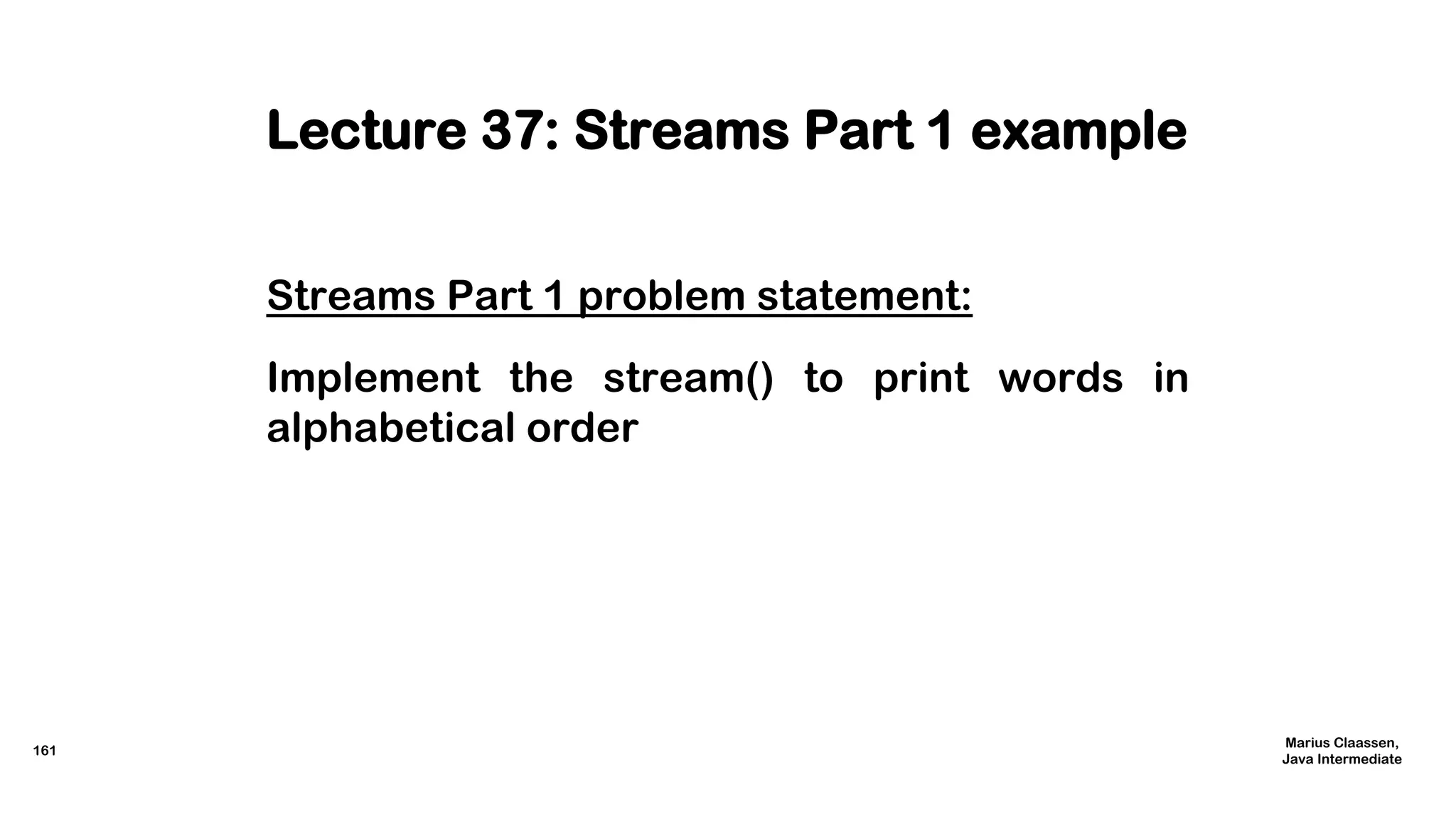
![Lecture 37: Streams Part 1 example
import java.util.ArrayList; import java.util.Arrays; import java.util.Comparator;
public class Lecture37 {
public static void main(String[] args) {
ArrayList<String> cities = new ArrayList<>(Arrays.asList(“Mumbai”,
“Karachi”, “Los Angeles”, “Nonthaburi City”, “Kolkata”, “New York”) );
cities.stream().sorted(Comparator.naturalOrder())
.forEach(s -> System.out.print(s + “ ”) ); } }
// Karachi Kolkata Los Angeles Mumbai New York Nonthaburi City
162
Marius Claassen,
Java Intermediate](https://image.slidesharecdn.com/javaforintermediateusers-170912102557/75/Java-for-intermediate-users-162-2048.jpg)
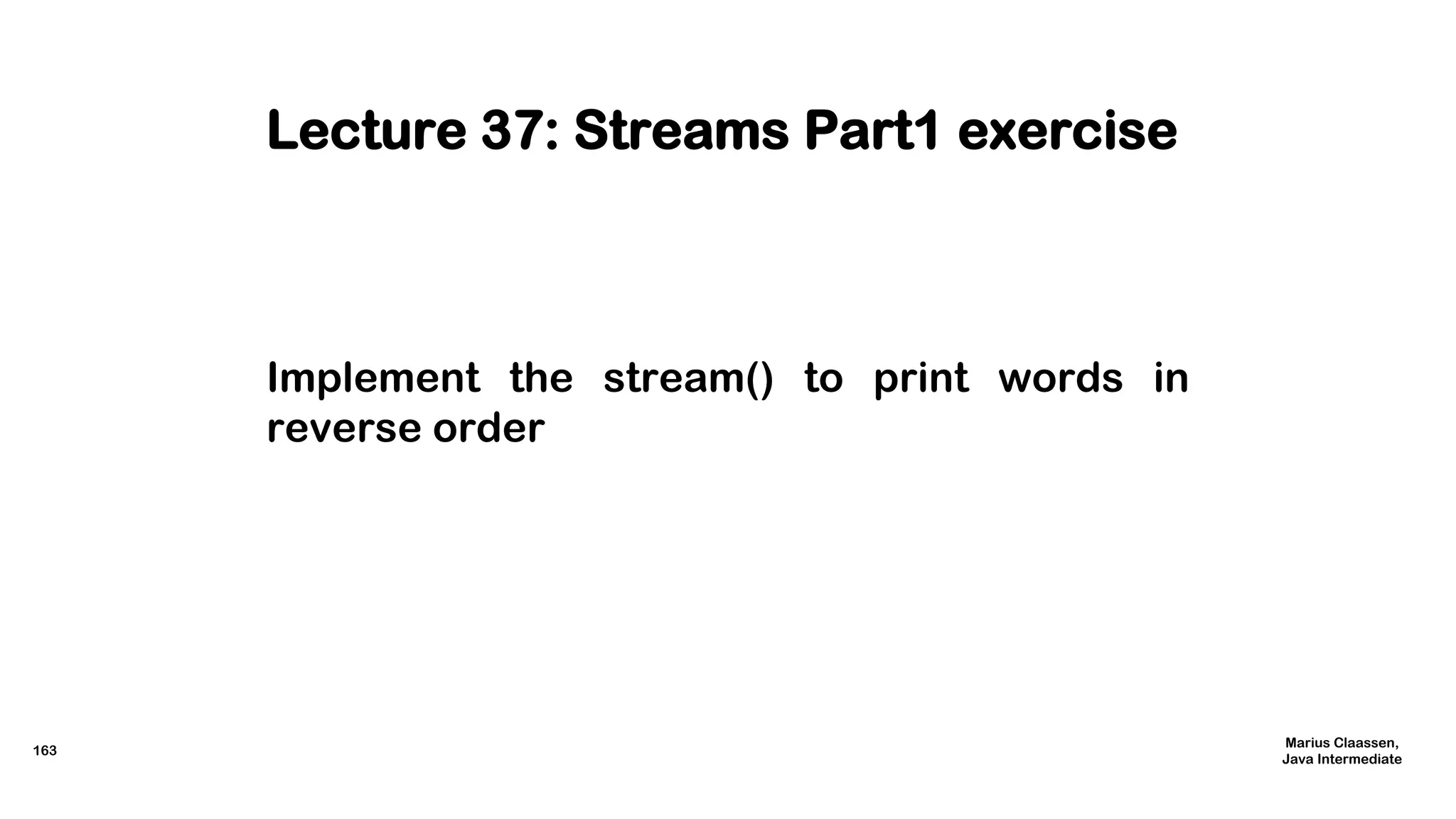
![Lecture 37: Streams Part1 exercise
import java.util.ArrayList; import java.util.Arrays; import java.util.Comparator;
public class Lecture38 {
public static void main(String[] args) {
ArrayList<String> capitalCities = new ArrayList<>(Arrays.asList(
“Delhi”, “Islamabad”, “Bangkok”, “Washington”, “Jakarta”) );
// TODO: Implement the stream()
// TODO: to print words
// TODO: in reverse order
} }
164
Marius Claassen,
Java Intermediate](https://image.slidesharecdn.com/javaforintermediateusers-170912102557/75/Java-for-intermediate-users-164-2048.jpg)
![Lecture 38: Streams Part 1 solution
import java.util.ArrayList; import java.util.Arrays; import java.util.Comparator;
public class Lecture38 {
public static void main(String[] args) {
ArrayList<String> capitalCities = new ArrayList<>(Arrays.asList(
“Delhi”, “Islamabad”, “Bangkok”, “Washington”, “Jakarta”) );
capitalCities.stream().sorted(Comparator.reverseOrder())
.forEach(s -> System.out.print(s + “ ”) ); } }
// Washington Jakarta Islamabad Delhi Bangkok
165
Marius Claassen,
Java Intermediate](https://image.slidesharecdn.com/javaforintermediateusers-170912102557/75/Java-for-intermediate-users-165-2048.jpg)
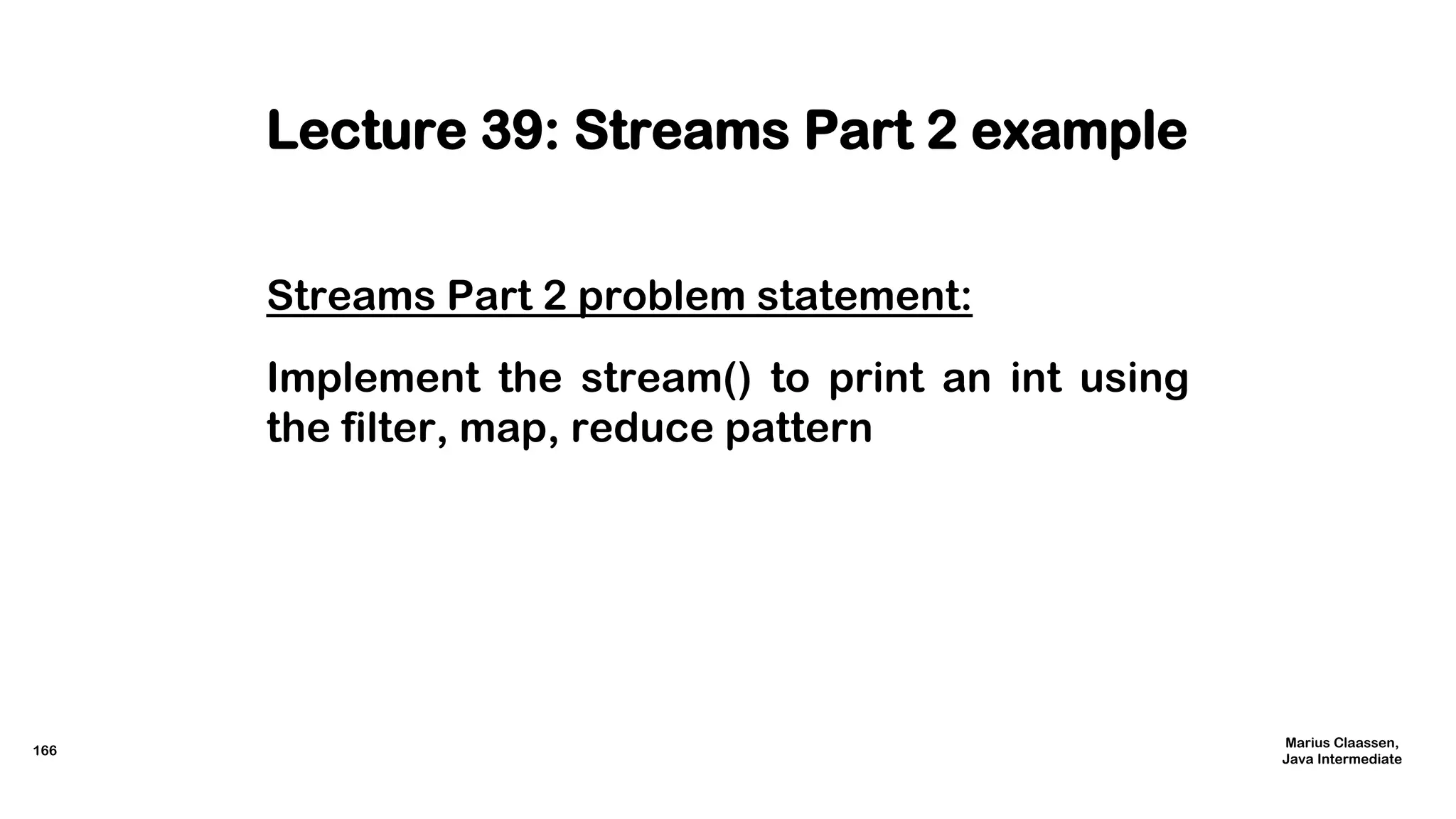
![Lecture 39: Streams Part 2 example
import java.util.ArrayList; import java.util.Arrays;
public class Lecture39 {
public static void main(String[] args) {
ArrayList<Integer> numbers = new ArrayList<>(Arrays.asList(
6, 7, 8, 9) );
int sum = numbers.stream().filter(i -> i < 8).map(e -> e * 3)
.reduce(0, (partAnswer, y) -> partAnswer + y);
System.out.print(sum); } }
// 39
167
Marius Claassen,
Java Intermediate](https://image.slidesharecdn.com/javaforintermediateusers-170912102557/75/Java-for-intermediate-users-167-2048.jpg)
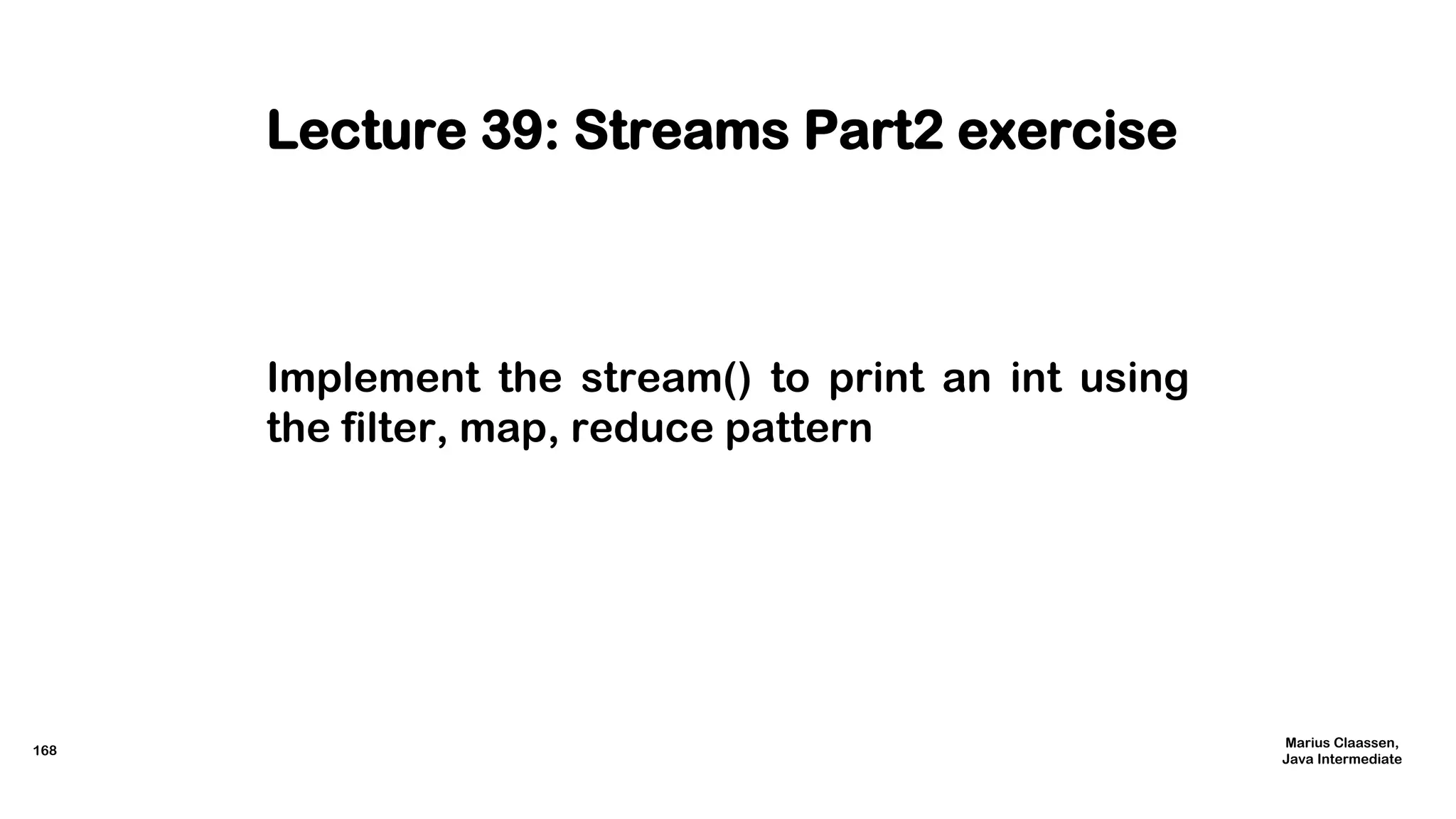
![Lecture 39: Streams Part2 exercise
import java.util.ArrayList; import java.util.Arrays;
public class Lecture40 {
public static void main(String[] args) {
ArrayList<Integer> values = new ArrayList<>(Arrays.asList(
1, 2, 3, 4, 5) );
// TODO: Square each value larger than 3 and get their sum
// TODO:
// TODO:
System.out.print(sum); } }
169
Marius Claassen,
Java Intermediate](https://image.slidesharecdn.com/javaforintermediateusers-170912102557/75/Java-for-intermediate-users-169-2048.jpg)
![Lecture 40: Streams Part 2 solution
import java.util.ArrayList; import java.util.Arrays;
public class Lecture40 {
public static void main(String[] args) {
ArrayList<Integer> values = new ArrayList<>(Arrays.asList(
1, 2, 3, 4, 5) );
int sum = values.stream().filter(i -> i > 3).map(e -> e * e)
.reduce(0, (partAnswer, y) -> partAnswer + y);
System.out.print(sum); } }
// 41
170
Marius Claassen,
Java Intermediate](https://image.slidesharecdn.com/javaforintermediateusers-170912102557/75/Java-for-intermediate-users-170-2048.jpg)
